As a creative marketing professional, you know how complicated and time-consuming creating and managing dozens of pieces of marketing content can be—especially when each one has custom details, brand design, and language standards, and often compliance requirements that must be implemented correctly. Making mistakes can hurt your client’s brand, not to mention your career.
Templates are your compass in a sea of chaos. Templating helps creative professionals maintain brand consistency and adhere to brand guidelines while reducing the time it takes to produce high-quality marketing content. Even better, smart templates empower you to automate parts of the creative process.
In this article, we’ll explore how templates can save you time and the role they play in creative automation. You’ll learn how to:
- Use templates to speed up common creative processes.
- Deploy creative automation to simplify complex workflows.
- Use smart template fields with your data.
What Is Creative Automation?
Content automation uses data and software to automate the creation, management, and distribution of marketing materials. This allows you to save time and resources while creating high-quality, professional-looking content that engages your audience.
Templates play a key role in creative automation. They allow you to create a document’s structure and design in advance before swapping in data, text, and design elements appropriate to each client, campaign, or location. For example, creative automation with templates makes it easy to create flyers customized for different locations or custom proposals with consistent branding.
Content automation with templates is a game changer for creatives looking to streamline workflows. Benefits include:
- Efficiency: Free your time and resources to focus on other important tasks.
- Consistency: Ensure that your content has consistent branding, messaging, and style.
- Accuracy: Minimize the risk of human error, ensuring that content is accurate and error-free.
- Collaboration: Make it easier for teams to work together, improving collaboration and communication.
- Flexibility: Quickly and easily make changes to your content, increasing flexibility and responsiveness.
Whether you’re working on brochures, presentations, or any other marketing materials, content automation is a powerful tool that can help you create effective content in less time.
Creative Automation With Templates
Let’s look at six ways templating and creative automation can increase your efficiency and productivity.
1. Branding and Content Design
Let’s say you’ve been asked to design a set of posters to promote a series of conferences. The design has to adhere to brand guidelines, but the brief asks you to create a unique graphic for each location with images of local landmarks.
Tackling the poster designs one at a time would be time-consuming, but with templates, you can easily mock up the base design using the brand’s colors, fonts, text styles, logo, and so on. Then, you can focus on designing the local graphics for each poster, creating posters based on the template, and dropping the unique element into each one.
Marq’s content design solution and templating system make this process straightforward. You can import existing InDesign files, images, and other brand assets. Then you can create a project, design the poster, and leave placeholders for custom images and text. From there, it’s straightforward to make and edit the posters for each location.
2. Collaborative Content Creation
Suppose you’ve also been asked to design a brochure to advertise the conferences. As with the posters, each brochure should include images and copy tailored to individual cities. You can’t design all the brochures and write all the copy yourself, so you decide to ask the designers and copywriters on your team for help.
However, the basic design has to comply with brand guidelines, and it has to be consistent—you can’t let your colleagues move logos around or modify the page layout.
Templates make collaboration within guidelines much easier. You make the design template with individual page templates and the client’s layouts, colors, and fonts. If you want, you can also lock these elements so they can’t be changed. Your colleagues are then free to get creative within the constraints you’ve provided.
3. Updating Multiple Documents
As often happens, the client might like the brochures, but have notes, such as: They’d like to include updated venue capacities in each one. That could be a real headache for you. However, if you set up your templates with custom smart fields, you can import the new data and have it automatically applied to all the brochures based on that template.
4. Content Standardization and Compliance
Creative professionals often find themselves working on projects with strict content guidelines and sometimes legal constraints. For example, certain types of content are legally required to include warnings and mandatory customer information.
Templates offer confidence that your team is working within the rules. Simply include the necessary content in your template, create a content-level lock, and no one working on the project can make unauthorized changes.
5. Data Automation
Let’s say your client asked you to create posters for their conferences and they sent a Google Sheets spreadsheet with a preliminary list of venues. Then the venue list changed during the planning process, so now you have to update a bunch of poster designs with new addresses. Anyone who has worked as a marketing designer is familiar with the laborious process of copying information from spreadsheets and pasting it into marketing content, and then doing it yet again when the information changes.
Data automation—a subset of creative automation—makes the process almost effortless. Instead of hardcoding conference venue addresses into each poster, a modern templating platform like Marq allows you to connect a data source, like your Google Sheet, and then autofill smart fields in your project from the sheet. The clever part is that when the information in the data source changes, the data in the smart fields updates automatically. No more copy and paste.
6. Calculation Automation
Smart fields are great, but we’ve yet to mention one of the best template features: formulas and functions. In addition to importing data sources, you can include spreadsheet-like formulas within text boxes, shapes, and table cells.
Formulas are incredibly flexible creative automation tools, but, to take a simple example, you could use them to automatically calculate the price of conference tickets in the brochures. Let’s say the base ticket prices for each location are listed in a Google Sheet, but attendees can pay extra for training sessions, VIP networking events, concierge services, and so on.
With the clever use of formulas, you could create a price matrix that automatically calculates conference package prices from the data the client supplies.
How Do I Make Brand Templates?
As you can see, creative automation with templates is exceptionally powerful. It has the potential to save you and your team a huge amount of time. All the features we’ve mentioned here, and many more, are available now on the Marq brand template platform. If you’d like to put Marq through its paces and see what we can do for you, schedule a demo with a templating expert today.
Collaboration is key for marketers and creative professionals. Whether it’s your internal team, contractors, or outside influencers you’re engaging with, a shared understanding of your brand ensures that everyone is on the same page. That’s why creating comprehensive branding guidelines with a clear brand style guide is so important for effective collaboration.
Brand guidelines are documents that define how your company should communicate with customers and partners. They hold significant value because they give members of your team—whether permanent employees or freelancers—a clear framework for designing content that reflects your brand values and aesthetic.
In this article, we’ll explore how brand guidelines enhance collaboration and productivity, and give you tips for creating successful guidelines. You’ll learn:
- How brand guidelines help businesses achieve brand consistency
- The role brand guidelines play in onboarding new creatives
- How to use brand guidelines to set boundaries for creatives
- Why brand guidelines should always be comprehensive and up to date
- How brand templates and creative automation work with your guidelines to increase productivity and reduce cost
What Is a Brand Guideline?
A brand guideline is a set of standards and rules used to maintain consistency across all elements of a company’s branding. It specifies the usage of colors, fonts, logo design, tone, voice, imagery styles, and other creative aspects that are associated with a brand. Having these guidelines in place ensures that the company maintains an image that is cohesive and recognizable within its industry.
A brand style guide act as a framework for creativity by providing boundaries for how the company should be represented. This allows teams to work within those parameters while still being able to express their own ideas effectively. Having clearly defined rules makes it easier for creative team members to understand what they can and can’t do when creating marketing materials.
Having well-defined brand style guide is essential for any organization looking to make an impact in today’s competitive market. It helps standardize messaging, visuals, and design, allowing creatives to express company values in a meaningful way without compromising consistency or clarity.
How Brand Guidelines Support Collaboration
When it comes to fostering collaboration, brand guidelines can be an invaluable aid in setting the creative parameters essential for cooperative and efficient teamwork.
Achieve Brand Consistency with a Diverse Creative Team
Guidelines provide clear language, rules, and imagery that all team members can easily reference when creating visuals and content. With everyone working in harmony, your brand benefits from greater efficiencies in communication and quicker production times on projects requiring input from multiple parties.
Quickly Onboard New Marketing Creative Hires
Comprehensive rules in your brand style guide ensure that new hires immediately understand what is expected of them. When developing brand-related campaigns or artwork, they can look to established style choices and techniques for guidance. Brand guidelines help experienced creatives hit the ground running, empowering team leaders to quickly and confidently scale their teams to meet workload demands.
Communicate Your Brand’s Unique Style to Freelancers
Clear guidelines foster clear communication between internal teams and external freelance creatives. They eliminate guesswork and provide creative freedom within the scope of what defines the company’s look and feel. Not only does that mean everyone involved with creating materials is aligned, but it also helps build trust between freelancers, internal teams, and clients.
Make Sure Your Team Isn’t Reinventing the Wheel
This guidance is meant to provide a framework on which creative teams can base their work. In doing so, they don’t have to start from scratch every time they launch a new project or campaign because the foundations are already in place. Instead of recreating established rules, brand guidelines allow your team to devote more time to creating unique content.
Set Boundaries for Influencer Marketing and Brand Collaboration
Modern marketing teams collaborate with organizations and individuals outside of the traditional employee or contractor relationship, including independent creators, influencers, affiliates, and other brand partners. These partnerships can help you achieve your branding and marketing objectives, but they need clear boundaries to guard against harmful misuse of brand assets and messaging. Brand guidelines communicate your brand’s requirements and boundaries, setting expectations that shape relationships with external collaborators.
The Digital Marketing Institute outlines an essential guide to influencer marketing that can help provide even more context. Identifying the types of influencers, you would work with, if any, can help clarify marketing activities moving forward.
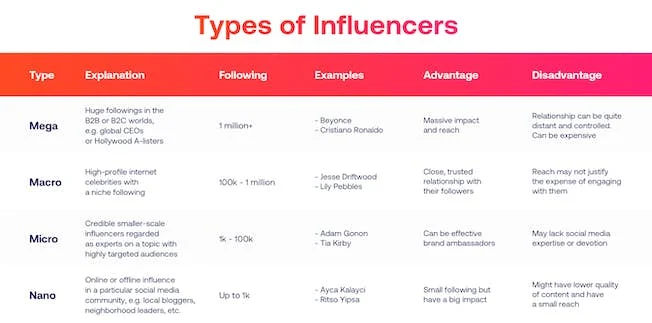
Building Brand Guidelines for Effective Collaboration
We’ve talked about why you should use a brand guide to cultivate collaboration, but not all are created equal. Poor-quality guidelines confuse, undermine, and mislead creative professionals. Plus, bad guidelines almost always result in expensive rework.
To learn more about what goes into creating effective brand guidelines, check out 12 examples of great brand guidelines and how to create a corporate identity design. To conclude this article, we’ll look at three tips to help you create brand guidelines that maximize your team’s productive potential.
Create Comprehensive Guidelines
If creative team members can’t find the information they need, they may not be able to proceed. Or they’ll devise a solution that may not conform to the brand’s identity, values, and standards. Either way, productivity takes a hit.
Creatives should ideally be able to refer to a brand’s guidelines whenever they have a question about brand values, visual styles, colors, logo use, and so on. Try to anticipate and include information to answer any questions that designers and marketers may have.
Keep Brand Guidelines Up to Date
It is essential to ensure that your brand style guide is up to date. Outdated guidelines can lead to a loss of unity and coherence among the many elements of a brand’s identity, from design language and visuals to messaging. Without an effective set of current brand guidelines in place, it can be difficult for teams to stay on message and create content with consistency across multiple channels.
Take Advantage of Brand Templates and Creative Automation Tools
Although brand guidelines are useful documents for creative teams and marketers, they do have limitations:
- They are static.
- The information they contain is not easily integrated into a diverse range of branded content.
- There is no straightforward way to automate content creation from brand guidelines.
Brand templates are significantly more powerful. With Marq’s brand templates, you can upload brand assets, including typography, color schemes, images, and logos, embedding brand standards into the content creation process. You can then design and create marketing assets from pre-made or custom templates.
Even better, brand templates allow you to automate content creation and include custom data in your content, whether it’s a sales proposal, spec sheet, presentation, brochure, e-book, flier, poster, or any other branded publication.
To learn more about how Marq brand templates can help your creative team collaborate on consistently branded marketing and sales content, schedule a 1:1 with our team.
When you’re taking the first steps to build your brand, it can feel like a whole world of possibilities is at your fingertips. At the same time, trying to carve out a unique identity and space for your company can feel overwhelming. Trying to maintain consistency within your brand identity, stylistic choices, and big-picture vision is a tough ask – especially when you’re working with a variety of different (and often siloed) departments.
This is where a brand style guide can help take the burden off weary CMOs and their teams. Once you know how to build a brand style guide, scaling up your content strategy becomes so much easier.
In this article, we’ll answer these questions and more:
- How do I make my own brand guidelines?
- What should a brand style guide include?
- What are the 7 essential elements of a brand style guide?
The sooner you learn how to build a brand style guide that fits your unique vision and voice, the sooner you can empower your teams to create great content – so let’s dive in!
What is a brand style guide?
Every brand style guide looks different, but they all have the same purpose: to help keep your branding consistent. It’s a master document that includes everything that makes your brand unique, from your visual and stylistic identity, to your company vision and mission statement.
Elements you can expect to find in one include your logo, font types, color palette, tone of voice, photography, and much more. What you choose to include in your brand style guide ultimately comes down to what kind of product or service you offer, and what kind of content you want to put out there.
Having a clear and easy-to-reference guide makes your brand more accessible, which means anyone in your company can create on-brand content. And the more consistent your branding is, the more recognizable you become to your audience, no matter where they might find you.
One question you might be wondering: What is the difference between a brand book and a style guide? We’re so glad you asked!
- The purpose of a brand book is to help people in your company stay aligned with your brand’s overall purpose. It’s all about drawing inspiration from the larger meaning behind your brand.
- A style guide, on the other hand, is more about maintaining a consistent visual and stylistic identity. It helps folks both inside and outside of your brand use your assets consistently and correctly.
These aren’t meant to be strict guidelines though – feel free to incorporate any elements into your brand style guide that feel right.
4 benefits of having a brand style guide
While it’s certainly possible to go about building a brand without a set style guide, we don’t recommend it. Why? Because without a style guide, you’re effectively putting a blindfold on your creative team. Without set standards and rules, you lose consistency and accountability.
Here are just a few key benefits a clear style guide can offer your team:
- Internal Consistency: A style guide keeps your brand identity consistent both internally and externally. No matter what team you’re working with, they’ll know your company’s look, feel, and language. A great style guide helps people learn the ins and outs of your brand quickly so every piece of content created fits together under one voice.
- Clarity: More clarity on content standards means less confusion on how decisions should be made. The clearer the instructions, the less time spent communicating back-and-forth, and more time creating content that stays true to your brand values.
- Customer Trust: People crave consistency in all aspects of their lives, and expect it from their favorite brands too. When you provide a consistent brand experience, you build trust, and that trust can lead to increased revenue. In fact, the State of Brand Consistency report by Marq found that consistent branding across all channels can increase revenue by 10% to 20%.
- Better content, faster: When teams know how to correctly size logos, what color palettes to use, and where to source assets, content can be published swiftly and smoothly. You can also go one step further by including customizable content templates (think social posts, photo assets, etc) within your style guide that can quickly be leveraged across your channels.
How to build a brand style guide
If that all sounds good, then it’s time to start crafting your very own brand style guide! To help you get started, we’ll go over 7 of the most essential elements you’ll want to include. While every style guide is different, these are elements every brand needs to successfully grow and scale content.
Establish your brand identity
The first thing you’ll want to include in your style guide is an overview of your brand identity. This is the glue that binds your brand and content together.
A great place to start is your brand’s mission and vision statements. These not only establish the ‘why’ behind your brand but can be a great asset to reference when it comes to design decisions.
Your brand identity also includes your logo. While creating a strong logo is another topic altogether, many successful logos have one thing in common: a unique color palette. Colors matter – they influence our subconscious and evoke emotion. Choosing the right hues for your logo can help people recognize it easily on any platform.
Define your brand’s voice and tone
If your brand was a person, how would they communicate? Would they lean heavy on the emojis and humor, or would they be more refined and elegant? Finding a clear tone of voice for your company ensures that everything your audience encounters – from customer service emails to social media posts – are consistently on-brand.
It’s important to make sure this voice is aligned with the type of relationship you want to have with your audience. For example, what age range are you trying to appeal to? Thinking about your target audience demographic can help you find a good fit. Brands with successful voices not only effectively communicate their purpose, but also help customers feel seen and heard.
Your brand style guide should not only include high-level recommendations on tone but should outline specific standards for proper spelling and grammar. Guidelines should answer questions like, “is slang acceptable?”, or “can contractions be used?”
Create guidelines for your logo
Great logos are adaptable. No matter the color, size, or medium, customers should still be able to recognize it. The key here is consistency in usage. We recommend including guidelines on how people should use your logo. For example, include rules on appropriate sizing and specs for different platforms like email and social media. What color palettes are appropriate? What are the guidelines for black-and-white usage? Ensuring questions like these are answered helps teams uphold the integrity of your brand’s logo, no matter where or how it’s used.
Build a unique color palette
Like we mentioned earlier, colors matter. Some colors may evoke peacefulness, while others may make you feel excited. Think about the kind of feelings you want your brand to spark, and choose colors that complement that. A successful color scheme helps convey your brand’s identity and messaging, and should be the bridge that connects all of your branding elements together.
When choosing colors, it’s also important to think about how they’ll work with other design elements like font and imagery. To make it easier to maintain consistency, try to pick hues from each color family. This will help your designers seamlessly reproduce logos and other branding assets across print and digital. Plus, varying your color combos gives design teams more flexibility without having to compromise on brand recognition.
Pick your typography
Typography is an often overlooked aspect of great brand design, and should always be included in a brand style guide. When you’re picking fonts, think about how your choice could influence user experience and consistency. You want your typography to be legible across various sizes and mediums (think digital screen vs print). Fonts should also blend harmoniously with other design elements. Just like logo and color choice, typography conveys subconscious messages about your brand.
Outlining rules on font usage within your brand style guidelines makes it easy for those messages to resonate loud and clear.
Outline imagery guidelines
They say a picture is worth a thousand words, and that’s especially true in branding. Great imagery and graphics help grab people’s attention and tell your brand story. Whether you’re using photography, illustrations, or other visual elements, maintaining consistency in style, theme, and color makes it easy for people to recognize your brand based on imagery alone.
Depending on the type of imagery you use, you might want to set sizing and usage parameters for different platforms or media types. That way, teams can tailor imagery to fit specific mediums while still maintaining consistency.
Set standards for online content
No matter where people encounter your brand, you want them to have a similar experience when they find you. Setting guidelines for online content gives your teams the opportunity to craft consistent, unified experiences across all channels.
For example, perhaps you’ve set standards on customer service responses, or templates you work off of for blog posts. Wherever you have a digital presence, consider creating guidelines for how your brand should appear and interact with customers.
At the end of the day, a brand style guide equips everyone in your organization with the tools they need to create content that hits the mark. And at Marq, we help you scale your brand by maximizing your content output. Schedule a demo with us today to see how we can help you create better content, and save time.
A brand is a funny thing. It’s not something you can hold in your hand, yet a brand is the bread and butter of an organization. Without a stable, consistent brand, your company growth will be severely stunted. Not so sure? Well, we’ve gathered some facts and statistics for you to check out. Prepare to be convinced.
Related: The impact of brand consistency [free webinar]
Let’s start by building a foundation—what is a brand, how does it relate to your consumer, and why you simply cannot ignore building a strong brand.
Brand basics
A brand is a personality that identifies a product, service or company, including a name, term, sign, symbol or design. A brand also represents the relationships between customers, staff, partners, investors, and so forth.
Boundless
A brand does not exist within a company or organization. A brand exists in the minds of your customers. A brand is the sum total of impressions a customer has, based on every interaction they have had with you, your company, and your products.
Lucidpress
Inconsistent branding doesn’t just impact your customers — it hurts employee morale too.
Lucidpress
Build brand loyalty on shared values with your consumers. It is not the number of interactions a buyer has with your brand, but the quality and relatability of the interaction.
Harvard Business Review
Successful branding yields benefits such as increased customer loyalty, an improved image, and a relatable identity.
TSL Marketing
45% of customers expect great design across marketing and sales collateral.
Lucidpress
The main benefit of branding tools, and reason to employ them, is to boost profits.
Forbes
The greatest negative impact of inconsistent brand usage is the creation of confusion in the market.
Lucidpress
Surprised yet? If not, just wait until you see what’s going on for B2B brands. In a B2B market, branding is especially crucial. If you are in the B2B realm, here are a few things you should keep in mind.
B2B branding statistics
B2B brands fare better with customers when they use emotive rather than rational marketing messages.
MarketingWeek
B2B marketers have consistently cited brand awareness as their top goal over the last five years.
CMI and MarketingProfs
89% of B2B marketers say brand awareness is the most important goal, followed by sales and lead generation.
Content Marketing Institution
The rise in content generation is inextricably linked to the shift in customer expectations.
Lucidpress
Building an audience is more valuable than direct sales for over 70% of brand managers.
OnBrand
B2B companies with brands that are perceived as strong generate a higher EBIT margin than others.
Forbes
77% of B2B marketing leaders say branding is critical to growth.
Adience
75% of B2B buyers want branded content that helps them research business ideas, but 93% of brands focus their content on marketing their own products and services.
MarketingCharts
91% of B2B marketers use content marketing to promote brand awareness.
Content Marketing Institute
69% of companies report that brand guidelines aren’t widely adopted or don’t exist at all.
Lucidpress
Surprising, right? Regardless of whether you’re a B2B or B2C brand, a small or large business, an emerging competitor or a long-standing organization, you must maintain your audience. Here are a few stats that show how to keep their attention.
Maintaining your audience statistics
On average, 5 to 7 brand impressions are necessary before someone will remember your brand.
Pam Moore
70% of survey constituents reported that consistent branding is crucial when communicating with existing customers.
Lucidpress
Brands that are consistently presented are 3 to 4 times more likely to experience brand visibility.
Lucidpress
The average revenue increase attributed to personalized content is 48%.
Lucidpress
Color increases brand recognition by up to 80%.
University of Loyola
64% of consumers cite shared values as the primary reason they have a relationship with a brand.
Harvard Business Review
50% of people follow 1 to 4 brands on social media, 26% follow 5 to 9 brands, 22% follow 10 or more brands, and 3% follow no brands.
BuzzStream
52% of consumers expect brands to know when the right moments are to communicate.
Cube
89% of business readers say that the brand a piece of content comes from is important, and 85% of marketers say the primary reason for creating content is to build the brand and positive perceptions of the company.
The Economist Group
72% of marketers think branded content is more effective than advertising in a magazine; 62% say it is more effective than advertising on TV; 69% say it is superior to both direct mail and public relations.
The Content Council
45% of consumers will unfollow a brand on social media if their platform is dominated by self-promotion.
BuzzStream
48% of consumers expect brands to know them and help them discover new products or services that fit their needs.
Cube
Mind-blowing? We hope so. Now you’ve got a few more reasons to boost your brand and start thinking seriously about brand asset management. With your newfound knowledge, you’re prepared to wow your customers more than ever. Good luck!
As a franchisor or franchisee, you understand how important marketing is for your business. However, with marketing happening on both sides of the franchise, there can a fair amount of confusion that results in marketing that cannibalizes itself.
Related: 4 keys to successful local marketing
There are many methods to handle franchise marketing. Sometimes, the franchisor and a corporate marketing team are wholly in charge. Other times, the franchisee takes on all marketing responsibilities. Most often, it’s a mix of the two.
It’s easy to see how this arrangement could cause confusion for your customers. But by coordinating your marketing efforts, your brand message will be strong and clear across all franchise locations.
Large-scale, national marketing campaigns
Here are some tips for coordinating large-scale marketing campaigns between the franchisor and franchisee.
Focus on the brand
In a franchise, the brand is often the selling point for customers. They know they can trust a certain brand and will support that franchise, no matter where they are. This is why it’s beneficial to focus on the overall brand image in your marketing efforts.
Provide a brand style guide
Franchisors can create a brand style guide for franchisees, to help them create on-brand materials and limit branding mistakes. It you aren’t sure how to create a brand style guide, take a look at this blog post for some killer examples.
Here at Lucidpress, we’re pretty obsessed with staying on-brand and empowering everyone (even franchise owners who have no design experience) to create visual content. If you’re curious how Lucidpress could streamline your franchise marketing, then check this out.
Communicate clearly & frequently
To maintain your brand image across multiple locations, communication is key. Set the precedent that there will be consistent communication regarding marketing efforts between the franchisor and franchise owners.
One area that’s often under-communicated is digital marketing strategy. The franchisor should coordinate website and social media creation with franchisees, so there aren’t multiple accounts that could confuse or misdirect customers.
Looking at these marketing strategies, the biggest factor is the brand. Build a strong brand identity that will give your franchises a good reputation, then give franchise owners the freedom to create their own marketing collateral using approved brand assets.
Small-scale, local marketing campaigns
Small-scale marketing strategies should focus on specific efforts in the local community. Franchises often have the good reputation of the larger brand, but localized marketing is what will win the community over and create a loyal fan-base.
By empowering franchisees to control their own marketing on a local level (and by giving them the tools to stay on-brand), individual franchise revenue will soar.
Here are more tips for localized, franchise-level marketing.
Find local sponsorships
Talk to local charities, sports teams or schools in the area to find opportunities to donate to a good cause and get some advertising. This is a great way to show community members that you’re invested in the area.
For example, when I was in high school, there was a Taco Time that always sponsored the school’s football and basketball teams. Their sponsorship included banners hanging up at the football field and inside the gym. They sold food at the concessions stand and had their logo printed on the game rosters. As you can imagine, my friends and I ate a lot of tacos.
This was a worthy investment for this franchisee, as it showed their support for the community and offered unique advertising opportunities. The owner of the Taco Time had a great relationship with the community and people loved going to his location.
Personalize your messages
When you’re advertising to a specific community, it’s important to personalize your messaging for your audience. Every community is different, and by catering to yours, customers will feel special and more inclined to support you.
A great example of marketing personalization is CrossFit gyms. Each gym (or “box,” in CrossFit lingo) has its own website and social media accounts that tailor their messages to the area where the gym is located. Whether it’s about the weather or events happening in the city, these gyms create a local identity for themselves that members can be part of.
Keep up-to-date
Encourage franchise owners to stay on top of trends and news as they create marketing for their franchises. Being in tune with the local news can help you spot opportunities and avoid embarrassing advertising mistakes.
Any time you post about current news or trends, make sure you do your research. An unfortunate example of this is DiGiorno. When the hashtags #whyistayed and #whyileft were trending on Twitter, DiGiorno tweeted “#whyistayed You had pizza.” The problem: these hashtags were dedicated to discussing and raising awareness of domestic abuse—an incredibly serious cause. Needless to say, many people were offended by the tweet and DiGiorno quickly apologized for its mistake.
Be where your audience is
This, of course, is one of the most important rules in marketing. No matter how clever and wonderful your marketing efforts are, if your audience doesn’t see them, then it’s a waste.
So, find out where your local audience is: Do they spend time on Facebook, Instagram or Twitter? Do they read the local newspaper? If so, that’s where you should be, too.
Be consistent with the brand
Much of the traction and business a franchise location enjoys comes from the brand name that it carries. To continue attracting and retaining that business, it’s important to stay true to the brand.
If the franchise brand is known for great customer service, then local managers have to make sure that customer service is a priority for them. Personalize each franchise to the local area, but stay true to the brand it represents. For example, maybe there’s a way to provide outstanding customer service that’s unique to your community.
A great example of this is Chick-fil-a. It’s a well-known fact that if you say “Thank you” to any Chick-fil-a employee, they will reply with “My pleasure.” Quality customer service is part of the Chick-fil-a brand, and customers can expect to receive the same level of customer service wherever they go. While each Chick-fil-a has its own concerted marketing efforts, they stay on-brand with their customer service.
Key takeaway
Marketing within a franchise can lead to miscommunication and overlap if the franchisor and franchisee do not coordinate their efforts. However, through communication and a good brand management system, your marketing efforts can complement one another and culminate in more success.
How can franchises maintain brand compliance across locations? Learn more in our free ebook, The complete guide to multi-location branding.
If you’re serious about upping your social media game, then brand consistency is key.
Many new businesses underestimate the amount of time and effort that goes into creating a social media presence that counts, and social media marketing is often seen as a cheap and cheerful way to spread the word about your business. While social media can be a fun and cost-effective marketing tool, it does eat up a lot of time. If you’re keen to invest that time in developing social feeds that make a difference to your business, you’ll need to have social media guidelines for keeping your brand consistent.
Related: How to drive traffic with social media
5 benefits to brand consistency on social media
Accomplishing brand consistency on social media isn’t easy, but it is achievable. Before we tackle how you can achieve it, let’s first consider why it matters.
It makes you memorable.
There are 500 million tweets sent every day, with 6,000 going out every second. When users see online content from a brand they can easily recognize, they’re more likely to remember them in the future, both online and offline.
It increases customer engagement and loyalty.
If customers remember and recognize a brand, they’ll feel much more comfortable interacting with them. Likewise, customers are more likely to stay loyal to brands who deliver a consistent message.
It helps you stand out from the crowd.
Having a brand that is easily recognized will help to set you apart from your competitors. There are 6 Facebook profiles created every second, resulting in around 500,000 new users every day. If you’re not consistent in branding your business across the various platforms you use, it can be easy to get lost in the crowd.
It gives you authority.
Branding that’s done well looks professional. It builds trust because it tells your audience that you know what you’re doing and you care about the details.
It makes you relatable.
Using social media to show the unique personality of your brand is an effective way of helping customers relate to you.
Tips for branding your social profiles consistently
To achieve visual brand consistency when setting up your social profiles, there are a few key things you’ll need to remember.
Names & handles
If you want your customers to be able to find you easily as they move from one platform to another, it’s important that your name and handle is the same wherever you are.
Colors & logos
Even before they read your name or bio, visitors will register your logo and the colors you’ve used. Make sure that these two things represent your brand in the right way. They should match your website and any other communications that go out to your customers.
Taglines
If your business has a tagline, display it prominently on your social profiles. Taglines are memorable, and using yours consistently will help your customers recognize you.
Still working on your brand basics? Read more: The 7 key elements of brand identity design
3 questions to ask before you start posting
Next, we’ll look at keeping your brand consistent when you post on social media—but before we do, here are a few important questions you’ll need to have the answers to.
Who is your audience?
The internet has 3.77 billion users and 2.78 billion of those are active social media users. To ensure your social media content is directed at the right sort of people for your business, you’ll need to understand a few things about your target audience. How do they identify themselves? What are their interests? What motivates them?
Who is the audience on each network?
Not everyone is on every social network, and if they are on two or more, it’s likely for different reasons. Consider what your target audience expects when they visit each social platform and how you can provide the content they’re looking for.
Social media management platform Hootsuite predicts growth in the following themes for 5 top social platforms:
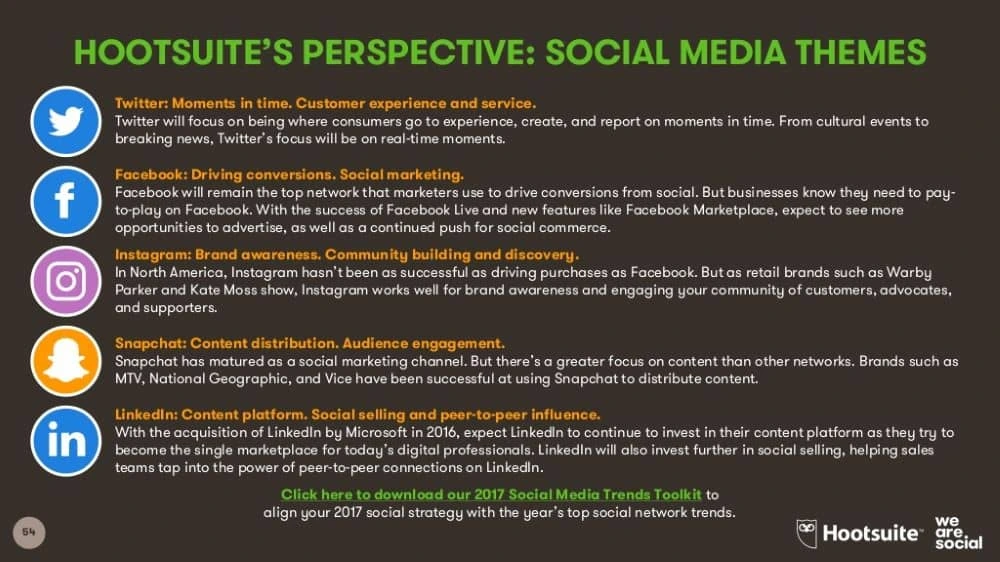
What language and tone will you use?
Deciding in advance whether you’ll use “we” or “I,” whether you’ll be funny or serious, and whether you’ll stick to perfect English or use slang and text-speak is an important move. There’s no wrong answer, it’s just about deciding what’s right for your audience. Once you know, make sure everyone in your business who posts is consistent.
Tips for social media posts with brand consistency
Once you’ve got answers to the questions above, you can start to think about when and how you’ll post and what you’ll share where.
Don’t just advertise.
The most successful brand accounts have a following because they offer something that their followers value. If you’re using social media just to promote and advertise, your audience will unfollow. What else will you offer: Promotions? Behind the scenes insight? Helpful information? Technical support? If you’re not sure where to start, check out the competition and see what works for them.
Post regularly and consistently.
Creating a social media account that stands unused can be harmful to your business. If a customer searches for you and sees that you haven’t posted for a while, they may assume that your business has closed.
Posting consistently can also help you develop a relationship with your audience and increase engagement. If they know when to expect a certain type of post from you that they appreciate, they’ll look out for it and may even begin to interact with you.
Consider your posting frequency per platform.
Posting regularly doesn’t have to mean posting all the time. It’s about quality over quantity. The frequency of your posts should depend on both the relevancy of your content and the platform you’re using. Do some research to find optimal times for posting based on platform and then set a schedule. There are free tools available online that will help you stick to it.
Curate content that fits.
Creating quality content for multiple social media platforms is a full-time job and, if your business is small, you simply might not have the resources. But you shouldn’t let that stop you from posting regularly. Sharing content from other people and businesses that echo your brand’s message is an effective way to keep the ball rolling while you’re working on other things.
Repurpose old content.
Likewise, there’s no reason why you shouldn’t repurpose old content. Share old posts that recent followers may have missed, or transform the content into something new. You could create an infographic from a long blog post, for example, or try breaking it up into smaller pieces and expanding on each one.
Don’t be repetitive.
While it’s important to post regularly, you should be aware of sounding repetitive. Don’t bombard your followers with the same message again and again, and be careful not to publish the exact same post across all your channels at the same time. Active social media users tend to jump from platform to platform within the space of minutes—if they’re seeing the exact same post from you wherever they go, they’ll start to feel overwhelmed by your content.
With that being said, if you’re running a big promotion or have an important announcement, you should certainly feature it across all of your social platforms. Instead of sending it out across multiple channels at one time, consider when the best times for posting on each channel are and stagger your message accordingly.
Link & cross-reference.
Don’t forget to link and cross-reference your social accounts. If you’re running a special promotion on Facebook, let your Twitter followers know. Likewise, if you have some content on Snapchat that you’re proud of, mention it on Instagram. Try only to do this when you have something your followers will appreciate—do it too much and you risk being repetitive.
Document your brand guidelines
There’s a lot to understand and remember, isn’t there?
If you’re committed to developing a social media presence that is both beneficial to and consistent with your brand, it’s worth considering documenting your brand guidelines.
Learn more about brand guidelines: 10 examples of great brand guidelines
Key takeaways
To achieve brand consistency on social media:
- Take care to ensure your profiles look similar and that they match your overall brand identity, including your website, newsletters and any other communications that go out to your customers.
- Make sure you know exactly who your posts are directed at and how you’ll communicate consistently with those people.
- Develop a social media content plan that outlines when and where you’ll post and how often. Work on ideas in advance and don’t be afraid to repurpose and curate, as long as you’re sticking with your overall brand message.
Ready to drive more brand awareness with social media? Grab a copy of our free eBook: How to adapt your brand to social media
When used correctly, Facebook advertising can be an incredibly effective tool to boost sales. But before you can expect people to whip out their credit cards and buy out your inventory, you need to establish brand affinity. In this post, we’ll go over just a few of the best ways you can maintain your current following and attract new customers.
Related: 5 ways to grow your email marketing list with Facebook
1. Create captivating, on-brand creative
One of the most important tasks of a successful Facebook advertising campaign is to create ads that will catch the eye of target consumers—which can be difficult to achieve since there’s so much competition on the platform. Using alluring images and bright colors in your ads is a good start, but be careful. If you have 20 advertisements that all use different styles and colors, it’s unlikely that new customers will gain any familiarity with your brand. Instead, stick with brand colors whenever possible and always include your logo in the ad. You should also use the same principal font that’s on your site, and never use more than two fonts in one ad.
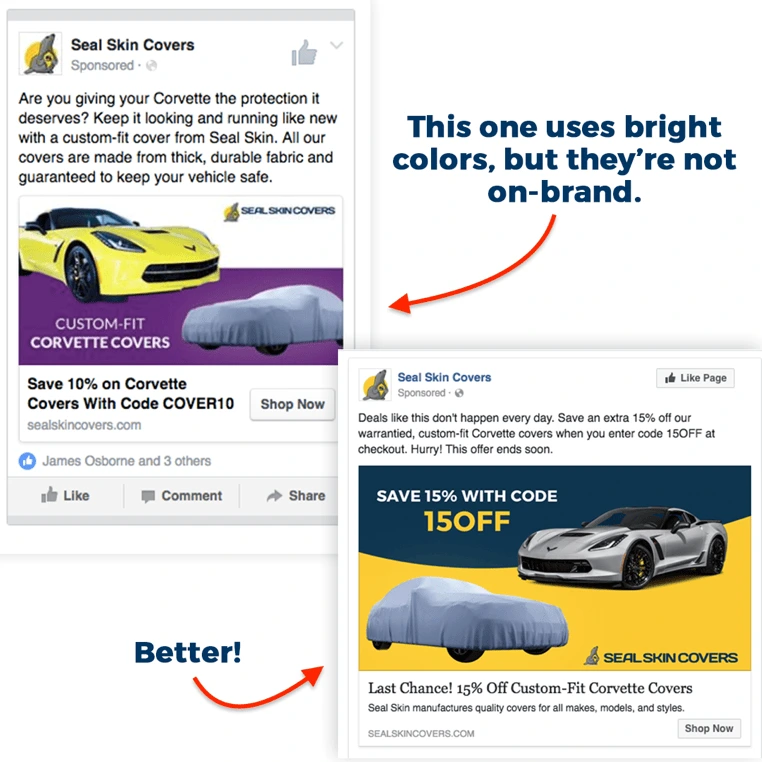
2. Use targeting filters and “Lookalike audiences” to find new fans
While remarketing campaigns are like shooting a fish in a barrel, finding new consumers who will have a genuine interest in your brand is a far more challenging task. Luckily, Facebook has a variety of unique targeting features that can help you refine your audience. Consider the demographics, behaviors and interests of your ideal customer and use that information to narrow your selection. For example, if you own a bridal shop and want to increase your wedding dress sales, you could target people who recently became engaged.
Facebook also has a unique feature called Lookalike audiences. With this tool, you can import a list of existing customers, and the platform’s algorithm will automatically identify new consumers who are likely to have an interest in your products or services. This can be an incredibly valuable tool for new brands looking to grow their fan base.
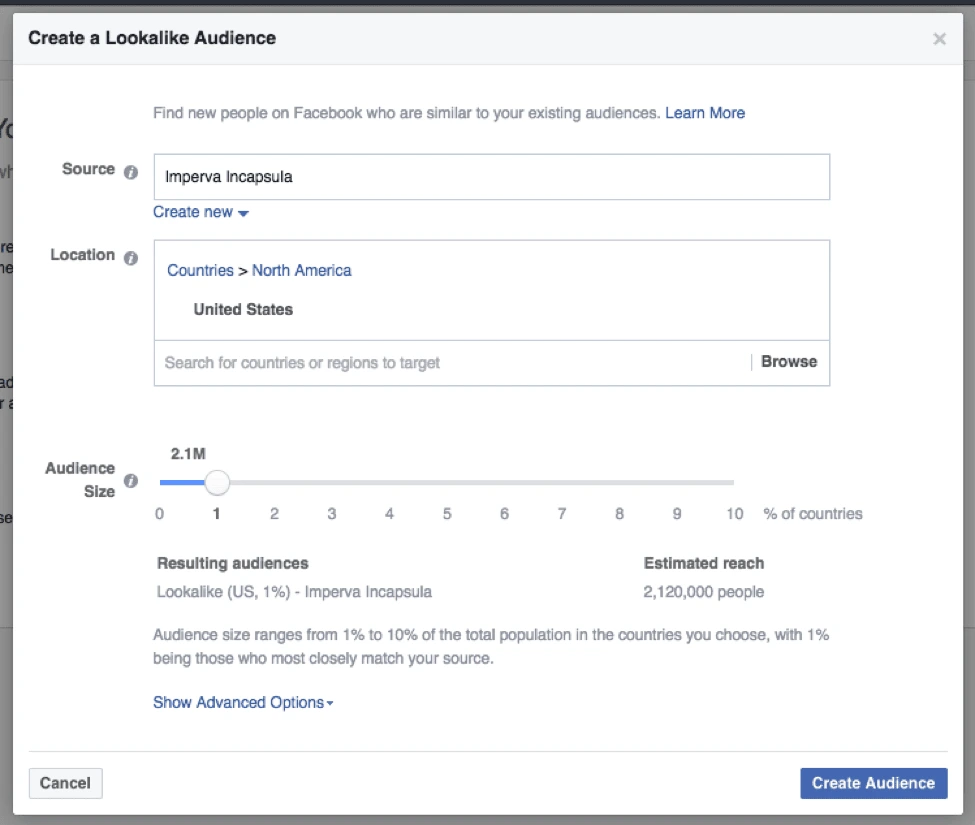
3. Establish a brand voice—and stick with it
To build strong brand affinity on Facebook, use ad copy that aligns with your unique brand voice. For example, if you own a mortgage firm and your brand voice is authoritative and professorial, then you don’t want to run ads that are filled with over-the-top puns and jokes. It’s also important to be consistent with your terminology. If your e-commerce company refers to buy-one-get-one-free sales as “BOGO,” this should be a consistent term in all your ads. If you have more than one person writing copy for your Facebook ads, create a style guide with tips and rules to follow.
When crafting your brand-consistent copy, be sure to write in a way that appeals to your target audience. Alongside the ad’s image or video, copy and headlines are important deciding factors in whether the consumer clicks your ad.
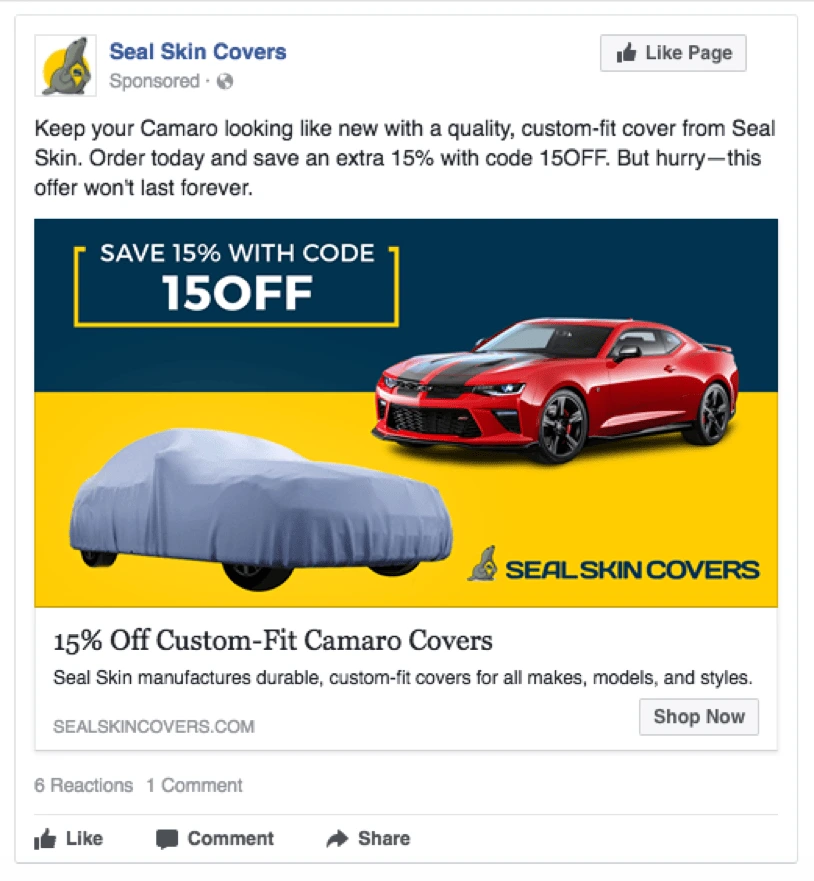
4. Advertise free content, too
Instead of focusing exclusively on advertisements that sell your products and services, promote free content that will spark an interest in your brand and help consumers see you as an industry authority. This is particularly wise when you’re marketing to new leads who’ve never heard of your company before. You want to offer some informative content that will warm up your leads—such as a free guide, video, blog post or infographic. Once the consumer has clicked through to your site, you can move them further down your marketing funnel by entering them into retargeting ads for other content offers or products.
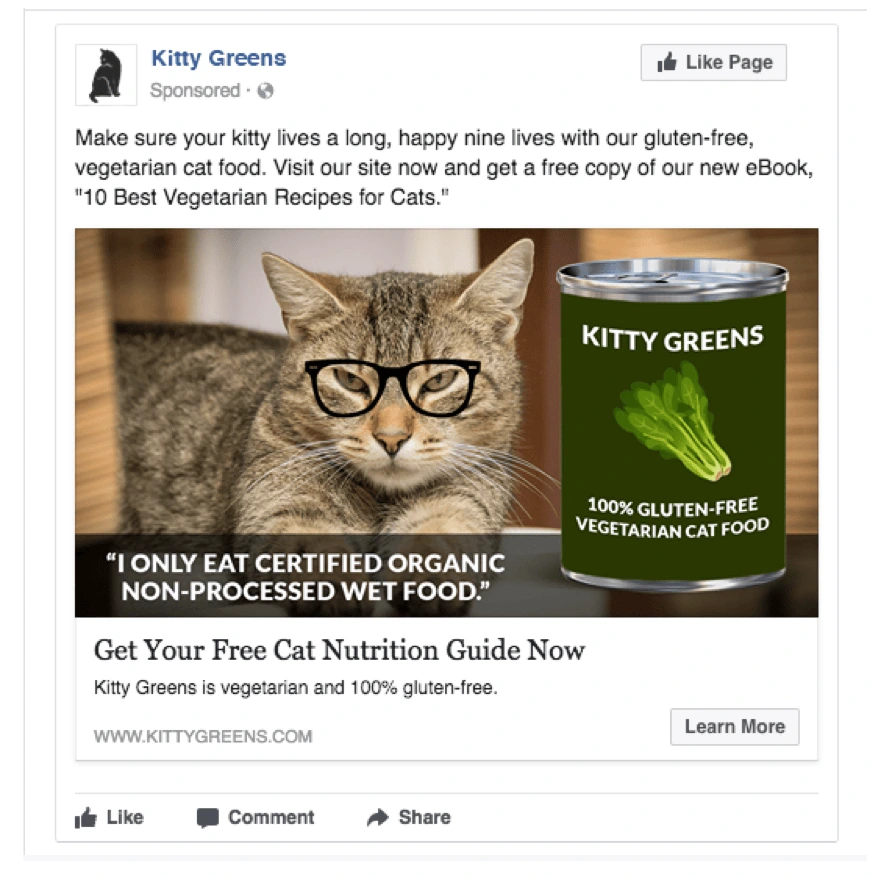
Ready to make a social splash? Create an updated Facebook cover.
Did you know that, every day, nearly 145 billion emails are exchanged? And what’s more mind-blowing is that 84% of these emails end up in a spam folder. To me, this makes it obvious that many people fail to understand how to send effective email messages.
You might think nobody even notices an email signature, but I’m here to tell you otherwise.
It’s more than just a decoration; an email signature communicates your identity to someone you want to build a professional relationship with but who might know nothing about you.
Related: Advertising do’s and don’ts for beginners
Let’s go over 7 do’s and don’ts that’ll help you send better emails to coworkers, customers and leads.
1. Do find a good layout (for mobile, too)
This is the first and most important step for creating an impressive email. A good email signature should be informative and neat.
What information to include will depend on the brand you’re promoting. Remember that everyone is a fan of simplicity, so keep all information to-the-point.
Everyone has smartphones these days, and the number of people opening emails with their phones is on the rise. Did you know that 48% of the emails delivered every day are opened on phones? That’s something to take note of.
Pay attention to the scale of your design. For smaller screens, you need to optimize the sizes of logos & images, and shorten any long website links & email addresses. If you’re going to use a wide logo, make sure to use a vertical template.
Use dividers to keep the signature organized and maintain a strong hierarchy. Full-bleed dividers will highlight your name and contact info—the most important info in your signature.
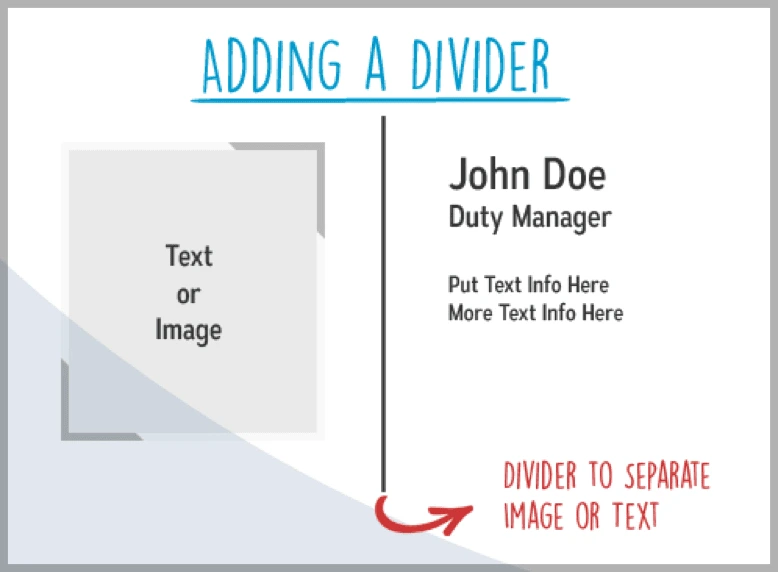
2. Don’t clutter with too much information
There is no point in using an email signature to share your autobiography. If you overstuff your signature with truckloads of links and information, it will be a turn-off for your potential clients. Plus, the chances of anyone opening the never-ending list of URLs are nil.
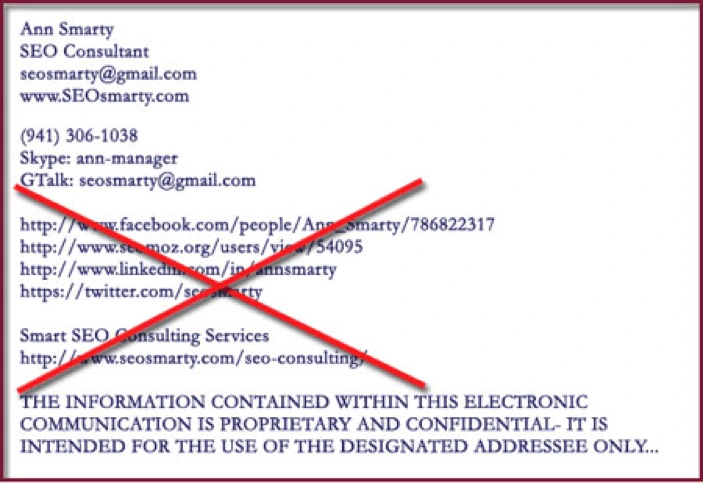
3. Do include blog & social media buttons
Digital marketing is all about making your presence felt on the web, and social media has leveled the playing ground for everyone. If you and your brand have no presence on social media, people are less likely to trust you. That’s modern psychology.
Adding Twitter, Facebook & LinkedIn to your signature will help you generate more traffic, and most importantly, your brand will get noticed.
Including your blogs, podcasts, and webinars in your signature is another clever marketing move. If you keep adding fresh content to your blog and hyperlink it in your emails, the recipients will get easy access to new content and will keep coming back for more.
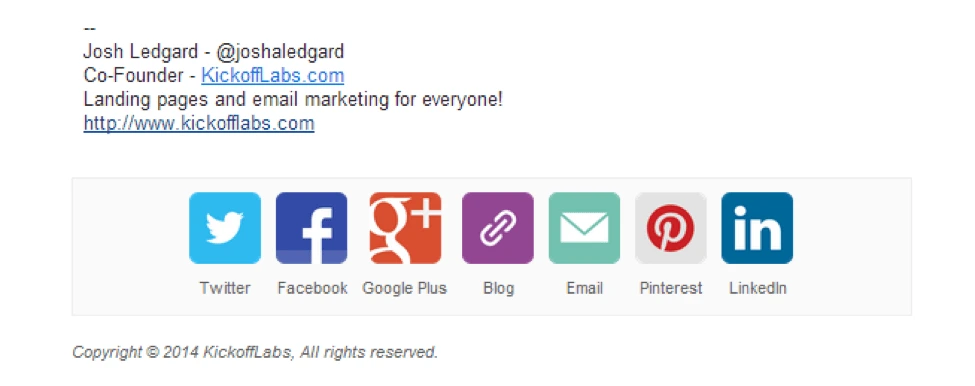
4. Don’t use multiple fonts & colors
Minimalism is in right now. Treat your email signature like a signature, not a medium to show off your graphic design skills.
To avoid making the design overly complicated, limit the number of colors and use just one type of font.
A pro tip is to take inspiration from the colors in your logo. This will help your audience recognize your brand more easily, as we know consistency is key.
Using the same font in both the email and the signature gives it a nice touch of consistency. Choose a font face and size that’s easy to read (e.g. Arial, Calibri, Tahoma, Verdana, Gill Sans, and a few others).
Using different fonts to highlight different texts makes your email signature look like an amateur school project. If you want to get a flexible typeface that can be customized according to your liking, the internet has a plethora of options for you.
5. Don’t use personal quotes
If you’re promoting a professional brand, you must leave the right impression on email recipients. The best way to do this is to only include information related to the brand. Using personal quotes, unless you are a well-recognized celebrity, would appear over-the-top and tacky.
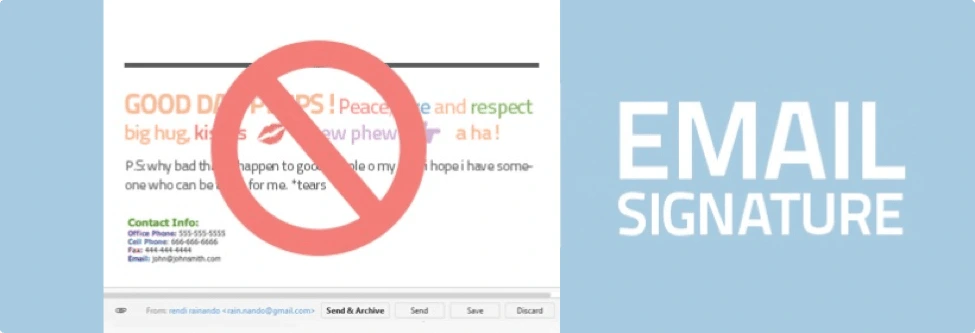
6. Don’t add long disclaimers
Including a long disclaimer in your email signature is a common mistake. Now, you might argue that it’s better to be safe than sorry. Well, I’m afraid I’ll have to pop that bubble. No legal advisor would ever tell you that email disclaimers hold any weight. Its function is strictly limited to annoying people.
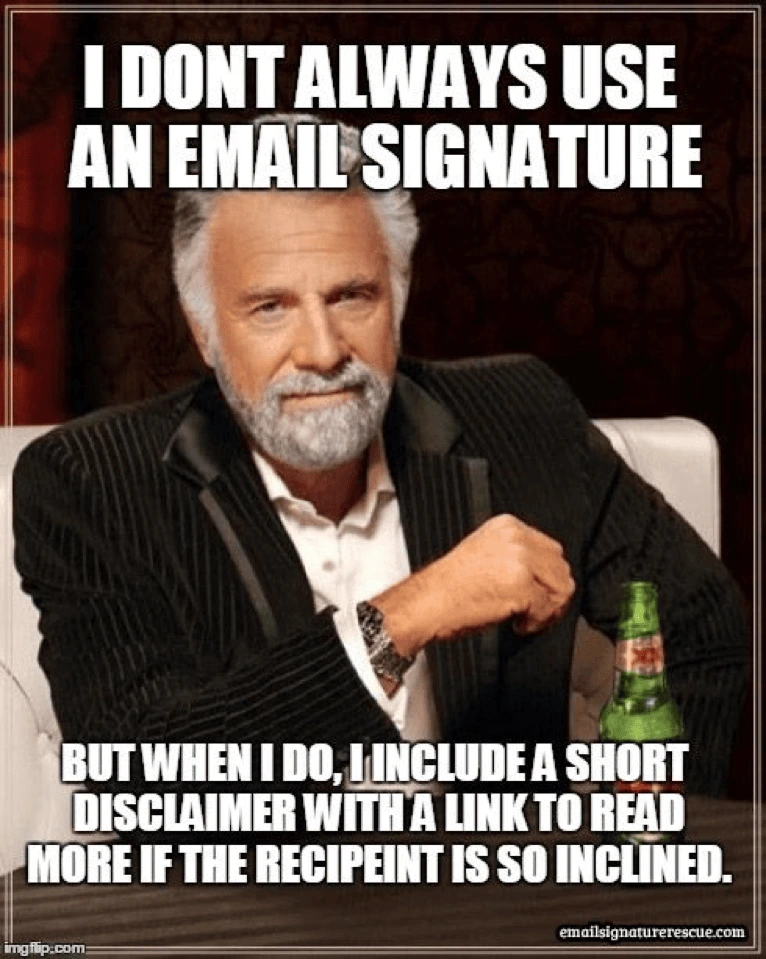
7. Do use a professional headshot
Using a headshot instead of a selfie is another tip for leaving a lasting impact. Try to look professional in the photo: dress formally, keep your hair well-groomed, look directly at the camera, and pose against a neutral background.
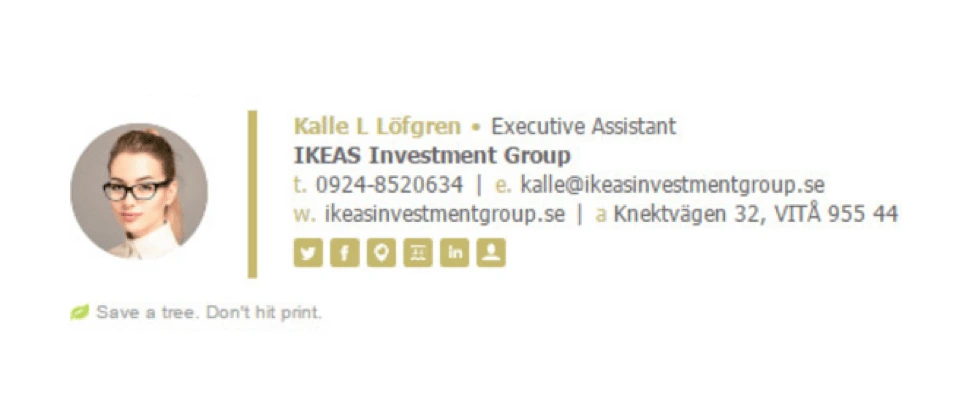
With these tips, you should feel prepared to create a strong email signature that communicates your brand as well as your own professionalism. Update your email signature and start leaving a better impression today.
When it comes to design in communications, there are generally two types of artwork: design driven by narrative or design driven by information and data. The former relies more on conveying meaning and subtle messages through nuanced design, whereas the other relies on turning potentially incredibly complex or technical data into something that is much easier to digest for the average person.
Related: 7 guidelines for managing client expectations
Given the nature of corporate design, it will normally be brands who are requesting this type of work. These can be big money clients, so it’s important to make sure that you’re giving your client what they need. With that said, here are some tips to make sure your corporate designs hit the mark.
Know the brand inside-out
Unless you’ve had the fortune of pulling together the branding guidelines yourself, chances are you’re going to be unfamiliar with the brand. You need to spend time getting to know its identity. If there isn’t a set of guidelines anywhere, there are generally two things you can do:
Speak with your contact at the company.
Whoever has commissioned you to do this design work will most likely be willing to talk with you for 20 minutes or so and answer any questions you might have.
Put yourself in the position of their audience.
Have a look at their social media channels, watch the videos they’ve released, read through their website, and make sure you jot down notes about what messages you are getting from these. Mention these to your contact at the brand and check to see if that’s the message they want to portray.
“Peruse their back catalogue of materials in your spare time. It will help you know where the company has been, which will help inform you where it should be going. There have been countless times when I thought I came up with a great idea only to find out that we already tried it ten years ago.”
Aperitif5Destruction, via Reddit
Have the confidence to say no
Remember that, in any client relationship, you are the designer. They aren’t just paying for your time to deliver a service; they are paying for your skills, your experience and your influence. If the client gets back with some suggested changes that don’t fit in with the brand, you need the confidence to explain why their idea might not fit their guidelines.
“[As designers] our job is to educate clients on why we make the decisions we do, based on precedent, legibility and/or function. If a client is telling us how to design, they’re probably not a client worth having.”
Jesse Reed, via FastCodeDesign
Know the difference between internal & external communication
I spoke with my friend Neil who works in-house for a global technology recruiter and asked for his advice. He made a great point about the importance of separating design for internal use and for external use, and considering separating flagship publications from the brand.
“What we’re saying is ‘this is a great piece of marketing that you’re going to want to read,’ a lot of great stats, a lot of great information, and it’s presented in a way where it looks different, but it’s still within the branding guidelines, and it’s still within the context of FRG Technology Consulting (formerly known as Pearson Frank). And that’s the same with all of the salary surveys; they look different visually, but the context of which they’re promoted, of which they’re delivered, is within the brand.”
Neil Robinson
Key takeaways
Great corporate design doesn’t have to be difficult. Know the brand better than anyone else, put yourself in the position of the audience, have the confidence to defend your design rationale, and know the difference between designing for internal communications versus external. Follow that advice, and you will be delighting clients with your designs.
Ready to design corporate documents? Create beautifully branded reports, business cards & more in a matter of minutes.
The internet has made brand management much more involved now that there are so many digital channels for customers to communicate through.
Customers now have the ability to voice their opinions—and they really want to be heard. In essence, brand management is about managing those conversations while nurturing a positive perception at the same time.
Related: Brand building 101—8 steps to building a brand that lasts
Consider this: 93% of customers read online reviews regularly, and nearly 80% of those customers are actually influenced by this online research.
Your online presence is a powerful weapon for your brand. Are you wielding it responsibly? Here are 4 tips for managing an online brand effectively.
1. Actively monitor your brand
You can’t participate in conversations that you don’t know are happening. It’s important to actively monitor what’s being said about you online, along with metrics that provide a broad overview of how your brand is doing.
Luckily, there are a lot of tools out there that will alert you when your brand is mentioned.
From setting up classic Google Alerts to more in-depth tools like BuzzSumo’s brand monitoring feature, there are plenty of ways to make sure you’re part of the conversation.
Additionally, keep a close eye on the first page of Google results when you type in your brand name.
The other critical piece of active monitoring is that you actually respond when your brand is mentioned, especially when it comes to negative criticism. Respond quickly and honestly, keeping in mind that it’s just as important to be authentically human as it is to maintain brand voice.
Keep track of your online analytics, both for your website and your social media pages. Together, this will give you fuller insight into how your content is performing and whether it’s truly resonating with your audience. Traffic, time on page, and bounce rate are all good indicators to keep an eye on. Be on the watch for any negative fluctuations or downward trends.
2. Continuously encourage customers to write reviews
As we know, customer reviews are hugely influential in shoppers’ buying decisions and for your brand overall. Remember, nearly 85% of people trust reviews as much as a personal recommendation.
Let your customers become your brand ambassadors by continuously seeking out more customer reviews.
Some brands—especially startups—are hesitant about asking for customer reviews because they’re afraid of criticism that could hurt their growth in its early stages.
By and large, if you offer a solid product or service and provide great customer service, negative reviews won’t be the norm. But, when you are met with negative feedback, do your best to welcome it. Though it may seem counter-intuitive, negative feedback can be the most valuable feedback you get—if you let it. It provides insight into areas of your business that need improvement. Again, responding quickly and honestly can do a lot to sway a customer back into your good graces.
Overall, the more reviews you have, the better. Unfortunately, 77% of customers think that reviews older than 3 months are no longer relevant. Gathering reviews has to be a continuous process on your part.
Don’t hesitate to ask customers for reviews; most will be happy to provide one when asked. But, you must be proactive and ask. One great way to do this is to set up an automated system that periodically emails your customers to ask for a review—for example, after they’ve made a purchase. This is a great way to earn reviews and increase positive perceptions of your brand.
3. Always address customer concerns on social media
A surprising number of businesses don’t address customer complaints on social media and elsewhere. This is a potentially deadly mistake, not only when it comes to addressing that individual customer but many potential customers who are watching these interactions online.
The risk of ignoring that customer? There’s a 27% chance they may never do business with you again.
The same survey linked above found that 88% of customers would be less likely to buy from a company who has unanswered complaints on social media.
Silence can be deadly for your brand, so respond quickly.
4. Brand consistency is key, even online
Your website and social media profiles are extensions of your brand—for some, they may represent the entire business. The importance of brand consistency transcends the physical world and extends to your online presence.
The brand is often a company’s biggest asset, and a lack of consistency will make your brand less memorable and less trustworthy.
Keep everyone on the same page with clear guidelines regarding design elements, fonts, colors, logos and so on, and make it easy to maintain brand compliance. Don’t forget, your brand is also communicated in the content your employees create. So, whether it’s through a brand style guide or through branded templates, empower everyone on your team to maintain consistency.
Your employees can be very powerful brand ambassadors, but they must have the support, tools and know-how to do it.
Key takeaway
Customer voices are becoming louder. This is a good thing.
At the same time, it’s vital for brands to manage their online presences effectively. Ignoring complaints or participating poorly in conversations is not a sustainable strategy. You must be a strong, active advocate for your brand—and give your customers and employees the power to become brand advocates as well.
Back in older days, your name, address and contact details at the top-right of your client correspondence constituted a letterhead. Today, letterheads have become a visual art, delivering a first impression of who you are, what you do, and why you do it.
Take a flight of fancy and imagine your letterhead as sort of a haiku for your brand. For instance, are you a fast-moving tech startup or a dependable financial services provider? Are you a freelance nature photographer, or do you sell vintage clothing online? Your letterhead should creatively reflect that brand identity.
Related: The 7 key elements of brand identity design
Today, letterhead is no longer just a printed heading on stationery; it’s the look and feel of the entire page. Sometimes letterheads are, as we’ll see, really “letterfooters”—and they’re just one element of your brand stationery, from business cards to envelopes.
3 keys to designing great letterhead
The keys to making a great letterhead are:
- A well-designed logo. In the examples below, you’ll notice how a strong logo makes each letterhead design compelling and unique.
- Solid brand framework. Your design should reflect who you are, not who your designer is. From colors to layout design, your brand personality should be evident in every element.
- Document consistency. Keep your marketing materials consistent. Your templates should be tamper-proof to prevent logo stretching, rogue fonts and clashing colors.
Before we present our visual smorgasbord of design ideas, let’s review some quick tips on how to preserve brand consistency while creating letterhead, and how Lucidpress can help you simplify the process.
Already know what you want and don’t want to be sidetracked by other designs? Dive in right here with Lucidpress’s free online letterhead maker.
14 creative examples that’ll change how you think about letterhead
Fill up that white space
If a stark white page feels too plain, adding a background image can provide some much-needed visual interest. Just make sure your design contains enough contrast so the text remains easy to read.

Source: Lucidpress
Color me beautiful
Color can breathe new life into most simple free templates you can download on the internet. And no, you don’t really need to worry about web-safe colors these days.

Source: Lucidpress
Zebra crossing
On a printing budget? You don’t need to go into the red (ha) with black-and-white designs. In Lucidpress, it’s easy to create layers with elements. In this example, the logo (top layer) would live on top of the background (bottom layer) so it’s easy to drag & drop your logo anywhere on the page.
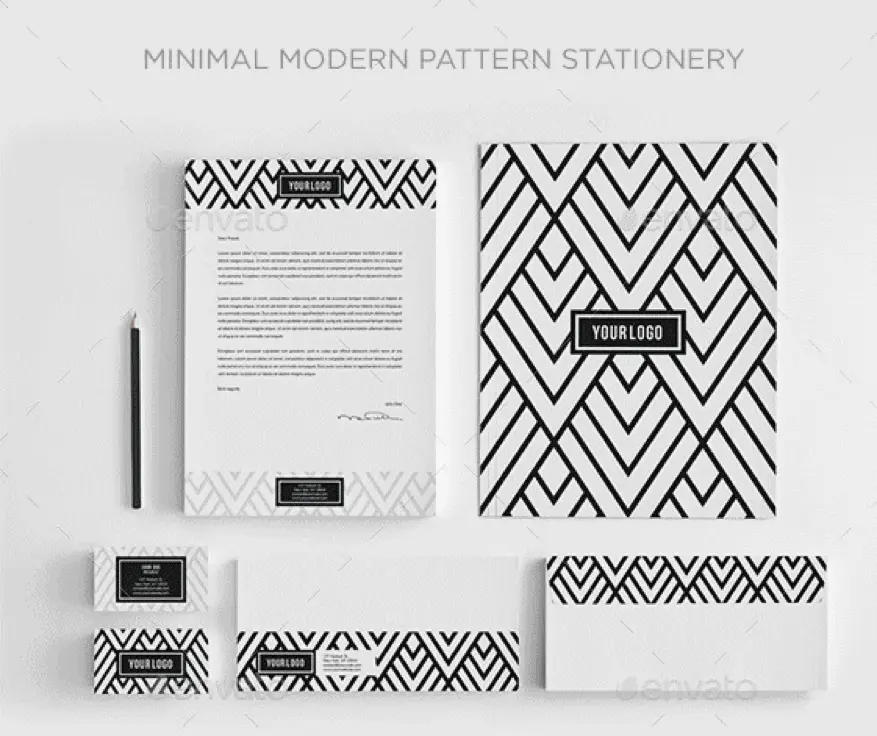
Source: Envato
Moving elements
The letterhead design police will not penalize you for moving the position of your contact details, or of anything else. It’s your party, so dance how you want to!
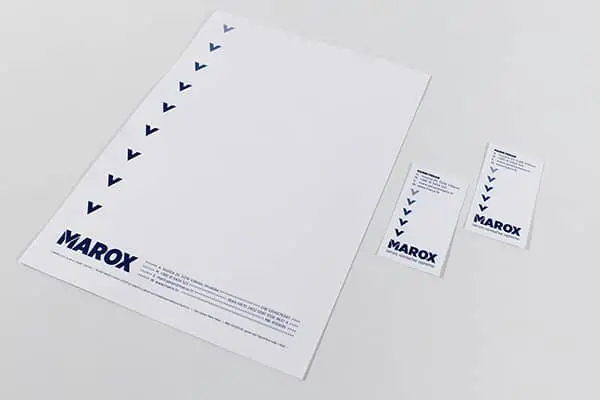
Source: CIPMANN
The spirit of the season
Why stick to the same letterhead all year ’round when you can get a little fun and festive around the holidays? Bring a smile to your recipients’ faces with a taste of the unexpected.

Source: Lucidpress
A picture says a thousand words
Don’t have a logo yet? All is not lost. Use free graphics and images to visually describe your products and services until you have a custom-made logo of your own.

Source: Vistaprint
Fortune 500
Be inspired by the greats of graphic design. Turns out you don’t have to be a big brand to look like one.

Source: YAGWYD
Turn branding on its head
The significance of lines and shapes in logo design make it both an art and a science. When done correctly, your brand can deliver surprising style while still being completely recognizable.

Source: Turnstyle
Stylish & eye-catching
Nearly 93% of people say a product’s visual components are the most influential factor in making their purchasing decisions. Use this to your advantage with a striking color palette and close attention to detail.

Source: Graphicsegg
A complete visual identity
When you design your logo, make sure it fits on all your marketing collateral, from brochures to business cards. Don’t be afraid to play around with your color palette to create a diverse and visually interesting library of templates.
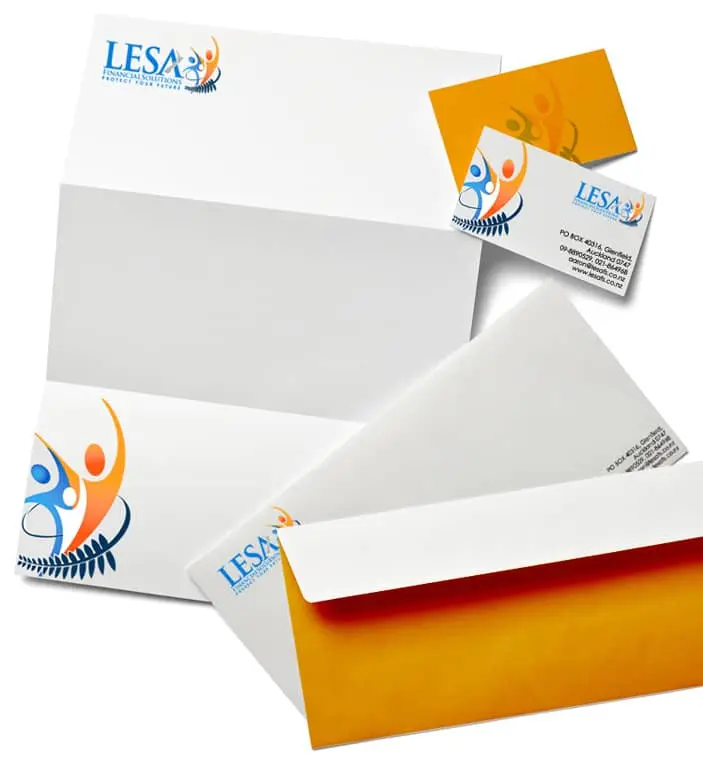
Source: Logo Design India
Contemporary & artistic
Beautiful photography can elevate your brand identity from sufficient to stunning. Why not splurge on a professional photo session to make your letterhead truly one-of-a-kind?

Source: Nonola
Modern & funky
Your imagery should use a theme, but it doesn’t always have to be precise—just recognizably your brand. Play around with how and where you place your design elements to create different templates.
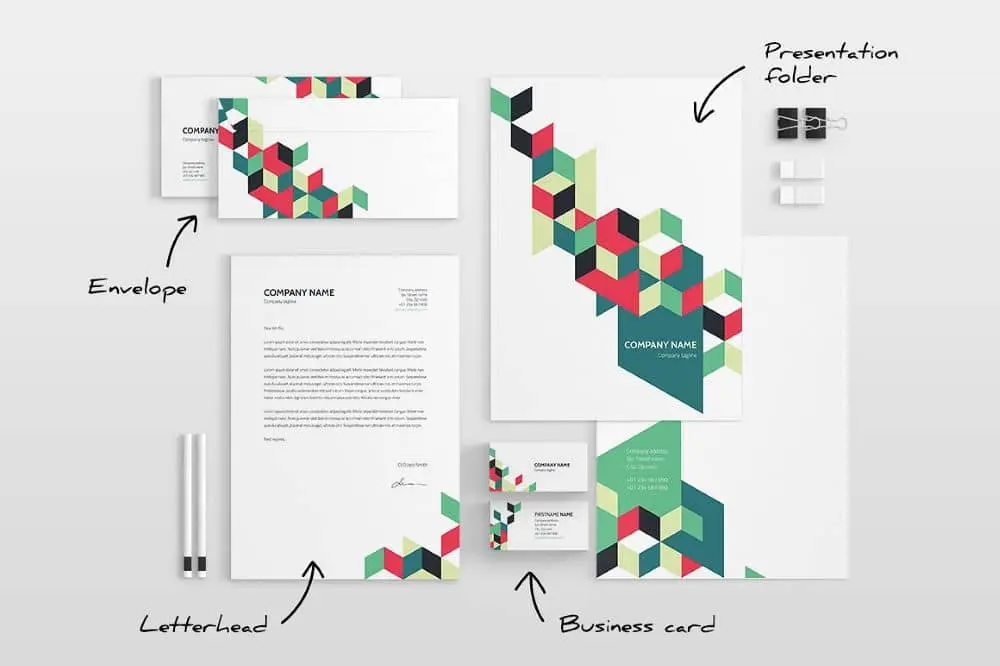
Source: ID Vision Studio
Keeping it simple
Letterhead doesn’t have to be fancy or ornate. If you find most designs too distracting, take it back to basics with a clean and simple letterhead like this one.
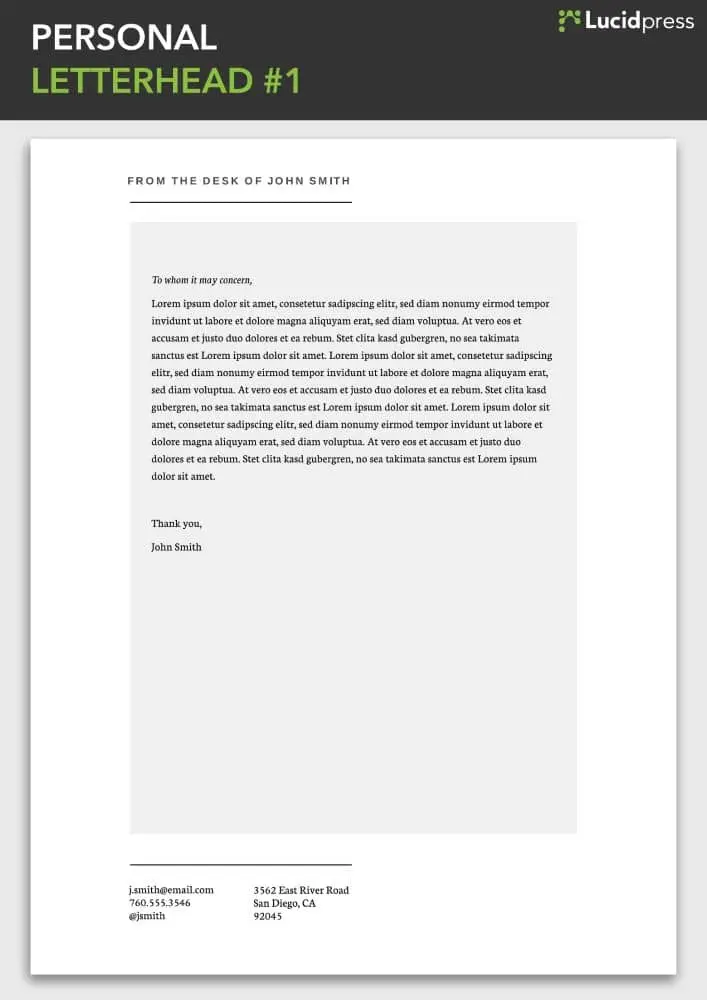
Source: Lucidpress
Small business savvy
This letterhead, unusually but effectively, includes important information about the business—including its opening hours. It’s a great way to remind local clients when and where to find you.

Source: Colorshop
Answering the 5 W’s
An effective letterhead serves as your calling card—both business communication and brand identity design rolled into one. Here are some questions you should consider before you start designing.
Who? Who are the targets of your correspondence—e.g. new clients, colleagues, investors—and what information needs to be included? (Read more on how to imagine your target audience here.)
What? On the internet, many brands omit contact details and opt to use contact forms instead. If you don’t want customers to phone you directly, it might be easier to include a website link or QR code to a contact form in your letterhead design. In Lucidpress, it’s easy to add links via shapes, images and text.
When? For what occasions will you use this stationery? For example, is it for sending out debt collection notices or to announce the winners of a competition? In the first instance, a bright, cheery letterhead could understandably get on customers’ nerves—the message will be clear that this is a standard form letter sent without a moment’s thought about who it’s going to and why. Additionally, how do you intend to distribute your correspondence: in digital, print or both? Lucidpress supports both RGB (ideal for digital) and CMYK (optimal for print) color profiles. This is key to making sure your brand colors appear consistent across the board.
Where? Two questions here: Where do you store your business collateral, and who is allowed to change it? Lucidpress uses advanced template locking so you have the flexibility of adapting your designs when necessary but limiting the privilege to admin users. You can also lock down important elements like logos, fonts & sizes. That way, you can give edit access to whoever needs it—like sales agents—safe in the knowledge that they can update the text without altering or ruining the brand assets.
Why? One of the first mistakes brands make while designing letterhead is including redundant information. Invariably, your stationery will be used for different purposes. For instance, it’s unnecessary to include your company’s address on internal memos. And if you have international clients, you may want to design a letterhead that accommodates more than one language—or even design letterheads for each one. Lucidpress supports the full gamut of branded collateral, from letterheads to business cards and brochures to newsletters. Simply clone your template and update it any way you like. For more ideas, the University of Waterloo provides some great examples of how to customize a letterhead for different uses.
Wrapping up
Follow these tips and, with a little inspiration, you should end up with a beautifully professional letterhead that represents your brand. Graphically challenged or on a deadline? If you’re really stuck, simply grab one of our professional, easy-to-use letterhead examples. Our designers have crafted these letterhead templates with care and expertise, so you don’t have to start from scratch. Just add your logo and text details, select your brand colors, and make any other edits you desire with intuitive drag-and-drop tools. It really is that easy to design a new letterhead that you’ll love!
Ready to bring your own letterhead project to life? Create your own design in Lucidpress, or start with one of these 7 free templates!
Sometimes, change is a good thing.
A fresh lick of paint can revive a dull living room, a new haircut can boost self-esteem, and a rejuvenated image can bring life back to an outdated brand.
The catch is that, unlike changing your hairstyle, a brand refresh isn’t something to do on a whim because you’re bored or haven’t had a chance to play with your design software in a while. Without a solid strategy, your renovation could turn into a DIY disaster.
Related: 10 best branding & corporate identity design examples
When you’re considering a brand refresh, start by asking a few honest questions:
- Why does the brand need a new image?
- How will a refresh help the business?
- What’s involved in a refresh, and what resources will you need?
Let’s take a look at a few reasons why a brand refresh might be the right choice for your company today.
Is my brand outdated? Separating the dynamite from the dinosaurs
Perhaps the most obvious reason to refresh a brand is that its image has simply outgrown its effectiveness. IBM is a great example of a brand that’s successfully evolved its image to match the changing nature of its product portfolio. By adapting its visual identity and voice throughout the decades, IBM has shown it can stand up against modern competitors.

This IBM logo offers a look back at the brand’s history
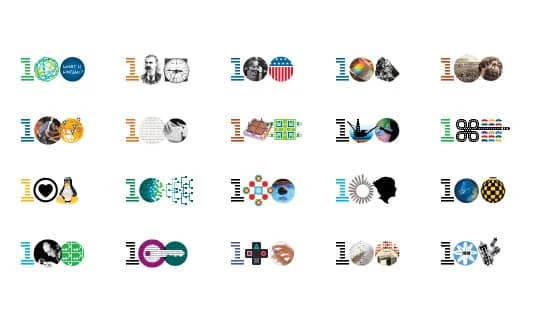
A selection of icons designed for IBM’s centennial
Many enterprises struggle to make changes because an old brand can gradually start to feel like an old pair of shoes-sturdy and comfortable. Unfortunately, you will need to make changes eventually if you want to be seen as an authority in your space, rather than a relic. Here are a few ways to check whether your brand is becoming outdated:
- Is your visual identity fresh and modern? Look at your logo, website, and any other visual media you use to connect with customers.
- When was your branding designed? If your logo is more than 20 years old, it’s probably time to revisit it.
- Is your brand getting the right results? Are you still marketing to the right audiences?
- Does your messaging and positioning accurately reflect your current value proposition and customer pain points?
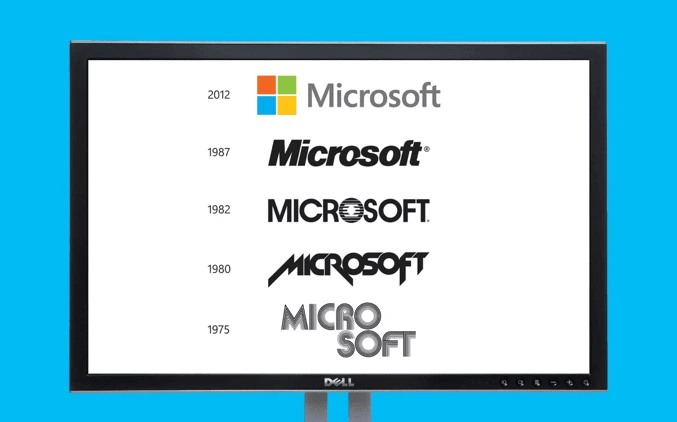
A timeline of Microsoft’s evolving logo design
Refreshing vs. rebranding
It’s easy to confuse a rebrand with a brand refresh, but ultimately, they serve two different purposes. A company rebrand is an extensive endeavor that involves completely removing the basic structure of the brand and starting over. A company typically only pursues this strategy if the current brand identity is confusing, contradictory or misrepresents the core of the company’s mission. A brand refresh, however, involves updating and building upon the brand structure that is already known and loved. Rather than a complete overhaul, it involves an update to visual elements, tweaks to messaging or changes to other differentiators.
5 practical reasons to refresh your brand
A brand is more than just a name and a logo. It’s also your company’s reputation, identity, and public perception. In many cases, companies recognize the need for change but want to preserve the brand’s positive aspects. With that thought in mind, here are 5 reasons you might consider updating the brand rather than undergoing a full rebrand.
1. You aren’t getting enough attention
A great brand doesn’t just generate an image for your company; it gives your customers a reason to sit up and take notice. There are plenty of ways to tell whether your audience has moved on from your message, and the first is that you’ve seen a steady decline in sales.
If people are just as happy with your products as they’ve always been, but you’re not gaining ground in the market, this could be a sign that your brand has lost its selling potential.
Remember, refreshing your brand doesn’t involve turning your identity upside down. Instead, it can be something as simple as redesigning your logo, unrolling a new slogan, or switching to a new color palette. It’s giving your audience something new to chew on while sticking to your brand’s core values. []
The power is completely in your hands.
2. You don’t stand out from the competition any more
Making an impact is hard in today’s saturated online marketplace—and copycats are running wild. Even if you have a great product or service, it won’t be enough if customers can’t distinguish your brand from the other players in your niche. You’ve got to stay ahead of the pack.
If your brand image is starting to feel like a copy-paste job, then you’re going to need new and unique ways to recapture your audience’s interest.
This can be a complex process because it means getting to the bottom of what your company stands for, what it can do today, and how it outshines your competitors. If you can find a way to differentiate yourself, you’ll find it much easier to drive brand awareness and loyalty.
3. Your company has changed
A founder’s initial vision and the company that grows out of it aren’t always one and the same. Sometimes, a brand is born with a particular product in mind—like Starbucks and its signature coffee. Then, as the business continues to grow, it’ll develop new products to better serve its audience.
Over the years, Starbucks has updated its product list to include everything from sandwiches to iced tea. These changes meant that the company had to reimagine the brand’s image based on what they could offer customers in a new marketplace.
As the business evolves, keep an eye on your brand and take note of any constraints that might make it difficult to branch out into new areas.
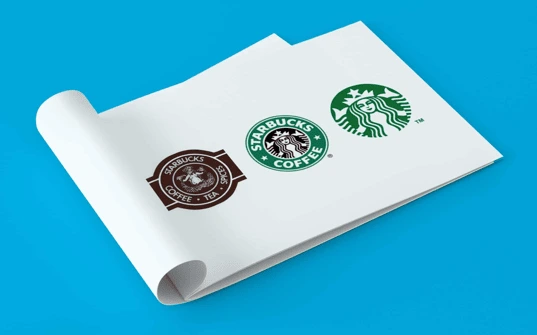
Starbucks has evolved to serve much more than coffee
4. Your message is inconsistent
For most companies, building a brand is about refining ideas and values into a voice and image that they can project to the world. As you can imagine, this is a complicated process that even the best of intentions can belie.
A brand refresh can help to realign your company’s values when they start to lose their way. After all, we know how valuable brand consistency is—not just to your customers’ experience, but also to your bottom line. If you want your brand to become a trusted name, then you’ve got to deliver the same, familiar experience whenever customers interact with you.
5. You want to attract new customers
When a brand is just getting started, it’s often easier to target a small, niche audience. However, as the brand grows, it’ll find opportunities to expand into different areas that offer new sources of revenue.
Sometimes, tapping into a new share of the market requires changing your voice or image so it’s more likely to appeal to a wider range of customers. A brand refresh can help you reimagine what the future looks like for the company.
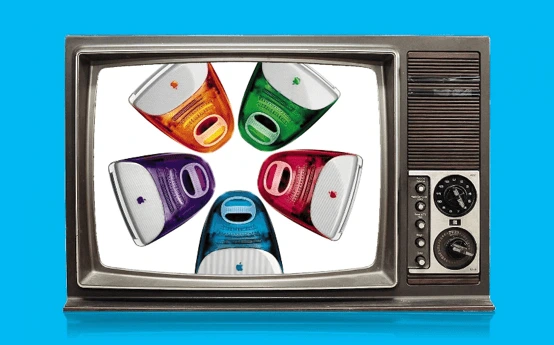
Apple excels at making its brand & products feel fresh. Remember these?
Is it time to refresh your brand?
Ultimately, the decision to refresh your brand can be a difficult one, but it’s worth thinking about when your current image isn’t delivering the results you need.
In severe cases, you might discover that the best way to bring your company back to life is a complete rebrand, where you go back to the drawing board and start fresh. While a rebrand is a more dramatic approach, a refresh allows companies to make tweaks over time that help their brand evolve with the market.
Considering a brand overhaul? Grab a free guide to conducting a rebrand
For brands, few objectives matter more than creating an impactful, positive impression. Because, if you can make a favorable first impression, it’s inevitable that good conversation — about your brand — will follow.
Now, keeping that conversation in your favor can be tricky. Ultimately, you want to maintain a consistent brand message and voice across all content. If the tone, voice, or visual experience is at all inconsistent, your target audience will likely become confused and you’ll lose their attention, thus impacting sales and customer retention. When your target audience doesn’t know who you are or what you do, it’s tough to expect them to remember or come back to you.
So what should you do to make sure your brand doesn’t take an unintended fork in the road? Well, here are a few strategies that make developing brand consistency easy for your sales organization.
Share a message that resonates
Want to stand out from the crowd? Start by zeroing in on your target audience with a message that speaks directly to what they want and what they need. Take customer feedback, pushback, pain points and reviews seriously — these are all goldmines for messaging information.
Communicate a clear brand message across the board with marketing (from print ads to social media) to sales (from initial pitch to closing time). Figure out who you want to reach with your message, then focus your energies on reaching that audience again and again.
Once you find a message that works, you ought to stick with it. Oftentimes, brands will tinker with a message too much and everything gets lost in translation, meaning the messaging loses focus and purpose.
Personalize the content experience
You want to highlight why your brand is uniquely positioned to solve the problem your prospective customer is experiencing. In other words, you want to give your customers good reasons to go with your brand over a competitor.
For instance, if your brand voice feels unique, you can progress up the sales food chain. If you don’t find ways to be unique, you get devoured by the latest trendy new thing. Alternatively, we’d recommend personalizing your customer’s content experience. Not only does this help you stand out in a crowd, but it showcases that you “see” your customers.
In your sales enablement content, be sure to focus on your strengths. A big mistake with branding is trying to do too much. It isn’t an effective strategy to be a jack-of-all-trades with all people. Your brand’s voice and content experience should be clear, compelling, unique and believable in each interaction with its target audience.
Offer influence and support outside of the buyer’s journey
Your brand voice is defined by how people see it. Influencing how people perceive your organization or your products is as important as getting consumers to buy from you — everything from demos to packaging impacts your brand’s overall perception.
Social media can be a powerful tool for crafting and shaping your relationships. Interacting with consumers and potential consumers can make it easier for you to create a conversation or gain quick insights about what you can do better. Social media channels are an incubator for ideas and will spur growth for your organization if used in the right way. They’re a great way to engage with customers and make your brand feel accessible.
Be prepared to enforce brand guidelines
If your marketing team is worth its snuff, it’s already created brand style and usage guidelines to ensure all messaging and visuals stay consistent. These guides cover how to use various brand assets in internal and external communications — including which fonts and colors to use, or the correct logos and slogans.
Guides like these not only help your organization’s marketing team, but they also serve as a useful reference for other employees, managers and departments — including sales — looking to create their own content. Ultimately, brand guides should align with your organization’s overall vision and mission. Brand consistency is much easier to achieve when grounded in the core principles that drive your organization.
So, always refer back to your brand guidelines and be prepared to enforce them when developing sales content and planning your outreach efforts. Customers will find you through more than one channel, which means multiple avenues exist to make an excellent first impression. Creating brand consistency across all of these channels is essential to ensure your brand stays memorable and top of mind.
Streamline branded content creation with Lucidpress
Lucidpress makes it a simple task to create a uniform brand identity and empower others in your sales org to create on-brand, professional-looking content. Plus, easy-to-use features like a drag-and-drop editor and advanced template locking take the learning curve out of designing.
So whether you’re publishing or updating a brochure, newsletter, one-pager, slide deck — or any other material your sales team needs — you can count on Lucidpress to ensure materials get to where they need to go, quickly.
Learn more about how to achieve consistent storytelling across your sales org in our free sales enablement workbook.
In real estate, it matters a lot what people think about your agency. We can all agree that, as businesses, we crave trust and loyalty from our customers. If these two traits are absent, success becomes much harder (if not impossible) to achieve.
Related: Real estate marketing guide & ideas
The consistency of your brand has a huge impact on what people think. If your real estate brand is constantly changing, people will see you as less honest and reliable. On the other hand, if your message is consistent and validates your brand promise, it’s easier to build trust with your audience and earn their loyalty.
So, where can you deliver this messaging? In real estate, there are several areas where you can achieve remarkable brand consistency. Here are five of them.
Property listings
Great property listings contain three elements: property data, description and photographs. Of these, the description accounts for the largest portion of the listing, so focus your efforts there. Write compelling descriptions complete with all the features and benefits anyone looking for that specific property would find valuable.
Each potential buyer has a particular set of expectations. If the description you write helps them evaluate the property against their expectations and make better decisions, that will set the foundation for a solid relationship with your real estate brand.
As you write, remember that brand assets like tone, voice, taglines & logos should always be consistent, and that your message should align with your brand’s goals as well as the needs of your target audience.
Neighborhood & home search
If you want to be the go-to real estate agency in your area, show your audience that you really know and understand the communities you serve.
Sometimes you’ll encounter potential home buyers who aren’t familiar with the area, and if you can become a dependable local resource for them, you’ll develop a trusting and loyal relationship.
Focus on what makes the neighborhood special and what homeowners usually consider when looking for a property. This could mean schools, hospitals, weather, culture, parks and local attractions. You could also request testimonials from people who live in the area and include them in your listings. Videos and photographs are great additions, too.
Responsive web design
Build consistency into how your website functions across all devices, from phones and tablets to computers. Regardless of how a person accesses your real estate website, the user experience should be cohesive and well-designed. If it’s not, your visitors could easily turn away.
Remember, your brand largely depends on how people view your business. If they can’t comfortably access your website on their tablet or mobile device, they will likely feel impatient and turn to your competition to get their needs met.
Without responsive design, visitors will wonder whether your real estate brand is old-fashioned, and they might assume you’re not up-to-date with new trends and technology. Instead, keep those visitors coming back by offering a consistent, excellent browsing experience tailored to their needs.
Pictures & video
We live in a visual culture. In real estate, this is supported by the fact that 83% of home buyers expect to view pictures of available properties, whether it’s through print marketing, a website or social media. []
Your brand stands to benefit if your visuals come across well and emphasize points of interest. Photos should always be high quality and leave a strong, positive impression. Spend a little time learning best practices for real estate photography before hiring a photographer or taking photos yourself.
Video has evolved with trends like personalization and technology like interactive videos, 360 videos, and VR videos that are more immersive for the viewer. For maximum visibility, you can share them across multiple channels: your website, online video platforms, and social media. For example, here’s a video we made with the help of a few real estate clients:
Social media profiles
There’s no doubt that a huge portion of realtors (91%, in fact) use social media—and so do your potential buyers. Your social media presence will inevitably have a significant impact on how your brand is perceived.
The logos, colors & visuals used on your social media profiles will affect how your audience perceives and remembers you. Tone and voice are important, too—conflicting messages will confuse customers and dilute your brand.
Of course, authenticity and humanity are also important to social media users. Make it your goal to give your brand a unique identity and personality that your followers can easily relate to. This will help you cultivate a loyal following and stand out from your competitors.
Key takeaway
Brand consistency is about getting your audience to trust you. The five areas covered here hold a great amount of power to keep your brand consistent. Each plays a special role in getting clients to call you, to pay attention to your message, and to look forward to working with you again.
Your brand matters. Learn how to protect and elevate your real estate brand in this branding essentials guidebook.
Brand management is one of the most important parts of marketing. It can take a long time and a lot of work to create a brand image that people like and trust, but in an instant, all that work can be completely undone. There are certain situations businesses have to deal with that, if not handled properly, can severely damage the brand’s image. Here are a few common situations and how you should respond.
Related: Why brand equity is important & how to measure it
Problem #1: Having poor customer support
If you look up any public polls or surveys that list companies with the worst ratings, one of the biggest reasons is due to poor customer support. If someone calls you with a problem they’re having with your brand’s products or service, you will make a bad situation worse by making it difficult for them to get help from you. []
Bad support is a good way of burning a bridge not just with that customer, but with their friends and family, too. After that, there’s more damage to worry about if they vocalize their discontent on social media.
To respond to this situation, you need to overhaul and clean up every line of communication between you and your customers:
- Make it easy for your customers to find your phone numbers and/or email addresses for support.
- Create a functional process flow to handle customers through your support channels.
- Make sure your customer support team adheres to that process.
The longer customers wait to get the help they want, the more annoyed they’ll be. They should be able to contact you quickly and easily. Most importantly, they should receive a useful response that resolves their problem. Auto-response emails and phone messages are simply not good enough in situations where your real customers are involved.
Problem #2: Failing to live up to your brand image
If you build your brand image around certain promises or guarantees for your customers, you had darn well better deliver on those promises and guarantees every single time. If you say you have the cheapest products, you’d better have the cheapest products. If you offer the quickest service, your service had better be very quick. If you have a satisfaction, money-back guarantee, then you need to take your customers’ dissatisfaction seriously and mitigate their concerns or issue a refund. Nothing can ruin a brand’s image like being inconsistent in living up to its own standards and promises.
If your company’s brand is starting to take a hit due to this, you need to take immediate steps. Get all hands on deck and start generating as much positive brand awareness as you can. The best way to do this is by delivering on the promises you make.
In the short term, that means doing what you can to raise your brand’s reputation, and in the long term, it might be shifting your brand’s image to something more realistic. For instance, if your business is not able to offer the cheapest products, change your marketing to start offering the friendliest service instead.
Problem #3: Getting negative attention from an employee
It is an unfortunate reality that how your employees behave, even when they’re off the clock, can reflect back on your brand. If they’re caught on the news, in a newspaper, or online behaving in an unethical manner—or even just in poor taste—your brand can get negative publicity from it. That’s why so many businesses include clauses in the employment contract regarding “off-duty conduct.”
From a brand image perspective, what should you do in this situation? First, be open and transparent to the public so they don’t think you’re covering anything up. Apologize to anyone affected by your employee’s actions, both publicly and in private. Second, look into how you are legally allowed to handle the employee based on that specific situation.
Finally, you need to be seen responding against the negative behavior in question. For example, if the employee went on a racist rant online, you can donate or form a partnership with an anti-racism organization and/or hold special seminars and training to improve tolerance in your company.
Problem #4: Offering a poor website experience
In today’s world, you cannot afford to have a bad website. The design can’t look old and dated; the navigation can’t be poorly structured so customers can’t find what they’re looking for; and the functionality can’t be compromised so they’re unable to perform important actions, such as completing a lead form on your site, completing an online purchase, or simply entering the buying cycle.
Even if your business is running smoothly otherwise, having a bad website that creates a poor user experience can really hurt your brand’s image. It can set a bad first impression if your users’ first interaction with your business is through a dysfunctional website.
The first thing you need to do is fix your website, of course. Upgrade the design or fix your theme and template, rearrange the navigation (site architecture) so it makes sense for your end-user, and fix any bugs or broken pages so that your visitors don’t get any site errors telling them your website pages cannot be found (404).
The next thing is investing in search engine optimization (SEO), then promoting the heck out of it. Create special promotions for the re-launch, start digital paid ad campaigns intended to drive new traffic to the new website, and retarget traffic from your old site back to the new site so they can see the difference.
Problem #5: Receiving a bad customer review
All of the above situations often lead to a customer leaving a bad review for your business online—on Yelp, Google, TripAdvisor, and other websites where customers review businesses. The worst thing you can do is ignore a bad review.
If reviews pile up and you don’t respond properly, your customers will assume you don’t care about them or their business, causing other people who look up your reviews to form a bad impression of your brand.
Make sure your business has an account on every major review website that your business gets reviewed on, and monitor them regularly.
When you see a bad review, take the information in the review and find out what happened before responding to it. Sometimes, the customer could be lying or omitting the truth, and you can point that out to tell your side of the story. Other times, your business legitimately failed the customer, but you can respond in a way that offers an apology and makes the situation right for them.
Want to know more about how to build your brand? Download our free ebook on how to build a brand in 2020.
Perception determines reality with branding. The impression you make with customers and potential customers ultimately influences the overall strength of your brand. That’s why even simple mistakes with brand consistency can create costly headaches.
Branding mistakes aren’t simply a concern affecting novice entrepreneurs taking their first steps into the marketplace. Businesses of all shapes and sizes can take missteps with their branding and lack a consistent voice or direction in their products and services.
Large companies can be especially vulnerable to the impact of brand inconsistency. It can lead to lost revenue and diminished customer loyalty. Those companies will end up yielding ground to more savvy competitors and often struggle to create a positive image and voice for their brand.
Here are 7 common brand consistency mistakes that large companies typically make. The good news is many of these mistakes are fixable or can be avoided.
1. Slow content creation
It’s no coincidence that new content seems to pop up on websites and social media channels at the speed of light. The digital age has revolutionized how we acquire information and put it right at our fingertips. Taking a slow and steady approach may win the race for the tortoise, but it doesn’t work with content creation.
If your brand is locked down to the point that it stifles new content creation, corporate marketing will turn into a bottleneck. Your brand will acquire a perception of being outdated and irrelevant within your industry. Timely and relevant content creation, on the other hand, will help put your company forward as a subject-matter expert and establishes it as a voice that customers can trust.
2. Wasted designer time
Do your designers work overtime making mundane updates to existing content, like a brochure or flyer? If that’s the case, they’re not properly utilizing their talents — and it could be limiting your company’s reach and costing you on the bottom line.
Burdening designers with too many small tasks causes the focus to slip from the bigger picture. Free them up to work on projects that incorporate their creative talents. Those creative juices flow when a designer isn’t handcuffed to simply doing brand housekeeping. Their minds are less cluttered and have room for dynamic ideas to emerge.
3. Off-brand content
Going rogue works when it comes to stealing Death Star plans. It doesn’t work with creating content. [] Brand guidelines need to be in place for a reason. If a department is creating rogue content that doesn’t follow established brand guidelines, it can spell disaster for your company in a hurry.
Establish your brand identity and create a branding guide that adheres to that vision. Educate individual employees and managers across all departments on these guidelines, so they understand how to communicate with your target audience without going off the rails. Permitting individuals or entire departments to tweak your brand to fit their whims will undermine the brand’s integrity. Offer them plenty of resources to help them keep content on target with your brand’s voice.
4. Outdated brand assets
Few things are more embarrassing than taking the time to update your company’s logo, slogan or other key brand assets… only to see the old assets show up in your company’s messaging. That’s the risk of not keeping everyone on the same page. It can make your brand appear indecisive, outdated or out of touch.
Each department and employee should have a working knowledge of which brand assets and templates are in current use. Store these things in a central, online place and make them easily accessible for all of your brand marketing efforts. Each brand asset should be reviewed periodically to ensure it remains uniform with the core brand messaging.
5. No brand champion
Creating a consistent brand voice starts at the top. Your CMO is like the pace car leading the rest of the pack to the starting line. It falls on their shoulders to be a brand champion. Without their voice leading the way, employees will not understand the importance of strong branding and your brand will end up veering off course.
An effective brand champion at the top can steer your marketing efforts in the right direction. They set the tone for what works and what doesn’t by establishing a core vision and identity. This makes it easier to identify a natural target audience then build branding efforts around appealing to that group.
6. Branding is over-complicated
Flashier isn’t always better. Some of the most iconic brand logos, like McDonald’s or Fed-Ex, are memorable because they use a simple and clean look that’s easily identifiable. Throwing more bells and whistles into the mix isn’t going to make you stand out from the crowd. If it does draw extra attention, it could be for the wrong reasons.
Avoid tossing in complicated graphics and color schemes that distract from your core message. Don’t clutter your brand. Keep it simple by using simple colors and symbols. This will give your brand a chance to communicate quality and authenticity and increase the possibility that it can stick with a person long after they are introduced to it. Using branded templates can make this an easier task to check off your company’s to-do list.
7. Not understanding your audience
Your brand will only stand out when it offers something fresh and unique. If your target audience can’t tell you apart from competitors in a meaningful way, what incentive do they have to embrace your brand, products or services? Failing to understand what makes them tick or what they want can lead to your brand’s death knell.
Make your brand timeless by building to your brand strengths. Avoid being too trendy. Embrace market research and communicate regularly with customers and potential customers alike. Resist the temptation to put your brand everywhere, and instead, focus on being sincere with what your brand does and how it can positively impact the lives of your target audience.
Want to know more about the power of brand consistency? Download our free 32-page report, chock full of stats & great insights.
At one point in time, a recognizable brand was all that was needed for a business to thrive. But now, that brand must be accompanied by trust because modern consumers are different than they were several decades ago. Today, there’s the internet and consumers can easily conduct research on a brand before they make a purchase.
In fact, they often do. Some stats suggest that 61% of consumers read reviews before they complete a purchase. They look for a reason to trust your brand before investing their hard-earned money in your product or service.
Related: 4 easy tips for effective online brand management
62% of Americans actually believe corruption is widespread in corporate America, so it’s safe to say that trust in corporations and big brands is lacking. Companies need to be careful so that they earn a trusted reputation. But there are also great opportunities to amplify what consumers are saying online to build trust for your brand.
Here’s some ways you can build brand trust online.
Provide valuable content
As the saying goes: content is king. Quality content can do a lot for a company, whether it’s on your website, blog or social media. It sets you up as an authoritative voice and, hopefully, a thought leader.
To write content that will benefit your brand, do some research to see what your competitors are doing. Then, create content that fills in the gaps they’ve left. Make your content more detailed, engaging and better in any way you can. This will prove you are the authority in the industry.
Keep in mind the 80/20 rule for your content creation: 80% of your content should be useful and non-promotional while the other 20% can talk about your product. This will engage consumers and prove to them that their wants and needs are a priority for you. Keep this in mind when posting to social media, writing a blog post or creating a video.
By providing reliable and insightful content, rather than a sales pitch, you’ll nurture a sense of trust in your brand.
Dove’s viral campaign “Dove Real Beauty Sketches” is an excellent example of this concept. Most of the video is about how women perceive themselves. The ad doesn’t mention Dove products, it simply finishes with the brand’s logo as a reminder of the company behind the message.

Source: Dove.com
IKEA is another example of a company creating useful content. The authentic Swedish brand added to its trusted reputation with its “Make Small Spaces Big” campaign, which provided tips and creative ideas to make better use of small spaces… information that is both valuable and relevant to its audience.
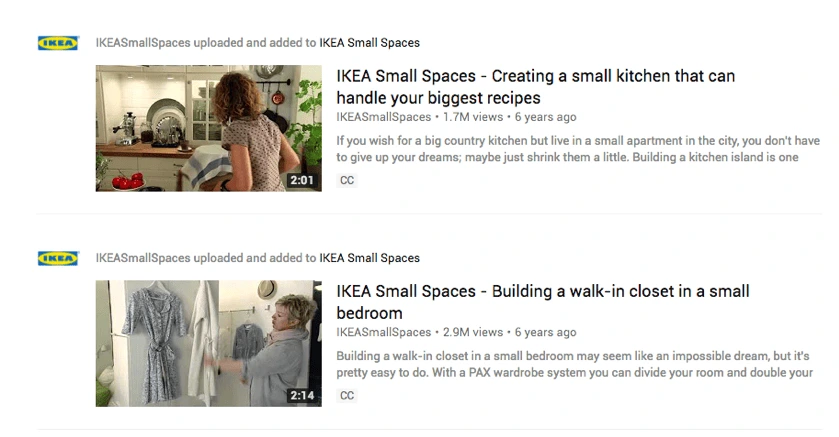
Engage customers in two-way communication
Consumers today like to be engaged and have relationships with brands. If you can do this, you’ll build trust. Social media is a way for modern companies to respond personally to individual consumers, and by doing so, these companies contribute to their own mouth-to-mouth marketing. One consumer impressed by a company’s communication can quickly go viral and generate positive press coverage.


Source: Twitter
To engage customers successfully, you need to interact with them on a regular basis. You must have a solid, active presence on social media. You need to monitor your pages for comments, questions or complaints and respond personally and appropriately. Be responsive and start conversations, and you’ll be able to build a positive relationship with consumers.
The IT networking company Cisco understands the importance of online engagement and offers its customers various avenues for interaction. In fact, the company claims it saved $200 million annually by moving its engagement efforts online. Cisco blogs, chats via Google+, has a full Facebook support page with more than 800,000 followers, uses LinkedIn and has even won awards for its customer support.
Building this rapport and being within reach of your customers is important to building a reputation as a trusted brand.
Host live video events
Whether you host a Q&A on Facebook Live, a demo on Periscope, or a webinar on your own website, live video events are a great way to build trust online. They require a lot of planning but can be very effective. There’s something about the unedited aspect that really motivates interest. Customers can engage and ask questions while they watch. And as it’s live, they know the answer they’re getting hasn’t been given a stamp of approval by the PR department, so it’s a great way to build trust with fans.
Keep your brand consistent
There’s nothing like going off-message to destroy a brand. From your logo and brand colors, to your tone and personality, you must be consistent in everything you do and say. [] A brand playbook can help you maintain the right voice, while brand management tools like Lucidpress can help your documents and content look consistent all the time, no matter how many people are on your marketing team. Consistency is also great for building brand awareness and recognition, as people will come to recognize your brand’s unique style.
Encourage user-generated content
Today, millennials in particular are using social media to discuss brands they like, and this can be important for companies looking to build trust. In one survey, 76% of millennial consumers said that content shared by average people is more trustworthy than what brands share. In another study, 92% of people said they trust the recommendations of other people, even ones they don’t know, over branded content.
User-generated content is a great opportunity for your business to show how real people are enjoying your products and build some serious brand trust.
Make sure to share these endorsements on social—Starbucks is constantly doing this. You can also actively highlight this content on your testimonials page, blog or, like Zappos, create a specific destination for this content.

Source: Twitter
Beyond your everyday customers, let other trusted sources advocate for you. You can highlight collaborations with other trusted brands, work with an influencer relevant to your industry, or share media coverage from reputable sources to build trust.
Share trustworthy links
Links are an important asset for any business as they connect your brand with the online world. Whatever link you’re sharing, make sure it leads to a reputable website. Refer to fact-driven sources in your blog posts, industry favorites for your curated content, and always use branded links on social media so followers have an indication of what it is they’re clicking on.
Branded links are made up of a custom domain name and a keyword in the slashtag. By associating your links with your brand, users know it won’t lead to spam or phishing sites and this increased trust can boost click-through rates by up to 39%.
Encourage user reviews
You should encourage your customers to provide reviews of your products or services online. Even a bad review can be used as an opportunity to testify to your company’s transparency and demonstrate your responsiveness and willingness to turn that negative customer experience into a positive one.
By encouraging reviews, your brand will show you care about what your customers think and are confident in the quality of what you’re selling. Often, before committing to a purchase, consumers will check how your company is rated on Facebook, Yelp and other review sites. If they can see at a glance that you’re close to a 5-star rating, they’ll be converted in seconds.
Make sure your brand acts responsibly
According to Forbes, millennials feel strongly about affecting change, and a lot of this is done online. They expect companies to be socially responsible, too, so if your brand is doing its part, make sure you let your audience know. Whether you’re reducing your carbon footprint, taking steps to ensure gender equality, or raising funds for a good cause, share the news online. This will build your image as a noble brand that can be trusted by its customers.
Key takeaway
Providing compelling content, interacting with customers, and maintaining brand consistency is essential to building a brand that people trust.
Today, your brand isn’t simply what you say it is, but rather a reflection of consumer trust in your product or service. You have the ability to develop that trust online and turn it into a powerful marketing tool for your business. It takes work and planning, getting involved and interacting, but it has the potential to cultivate lasting trust that will build brand loyalty and benefit your business into the future.
Want to know more about the power of brand consistency? Download our free 32-page report, chock full of stats & great insights.
Three years ago, Gartner predicted that 30% of our interactions with technology today would happen via conversations with smart machines—and mainstream adoption would be just around the corner.
Related: 10 digital trends that are transforming marketing in 2018
We can see the evidence of this change all around us, from Siri and Cortana to Alexa and Google Home. And while we haven’t reached mainstream adoption quite yet, marketers shouldn’t wait for the masses to catch up before grappling with the implications of voice search.
In particular, voice search represents a move from the abstract to the physical. Certain aspects of your brand—voice, tone, personality—will soon become real in ways they never have before. Just like mass marketing has shifted into digital marketing, we’re now seeing the dawn of conversational marketing with voice search. Here are five factors that show how voice search will impact your brand.
1. Copy that can be read aloud
As more people turn to smart machines to ask questions, brands should be prepared to respond in kind. Creatives will have to write copy that sounds good when read out loud—often in the form of answering a question. Offer the most important information first (remember the inverted pyramid?), and for goodness sakes, keep it brief and unambiguous.
For example, in an older blog post of ours, we discuss the definition of branding. If someone were to ask “What is branding?” today, our blog post would respond like this:
To begin to understand what a brand is, you must first understand that your brand does not exist in your marketing department, your public relations team, or your CEO’s office…
And as pretty as it looks on the page, no one is going to stick around to listen to that. Instead, our response should get straight to the point. Again, from the post:
A brand is the sum total of all the impressions a customer has, based on every interaction they have had with you, your company and your products.
If we wanted to optimize this content for voice search, we could restructure it intelligently by putting the important data first. Then, we have plenty of space for the kind of writing that’s meant to be read rather than spoken aloud.
Finally, keep in mind that voice search is more conversational than traditional search. The queries are longer, and they’re often localized (e.g. “What’s the weather like today?” or “When does The Copper Onion close tonight?”). Your responses should follow suit, mimicking how real people talk (including conversational phrases).
2. New advertising rules
With new advertising mediums come new advertising guidelines. This doesn’t just mean best practices, like we see with paid and organic digital search. We’ll also see big players in voice search (like Google) establishing new rules for brands who want in.
Remember this voice ad from Burger King last year? The commercial was designed to hijack your Google Home device by asking “What is the Whopper burger?” This request prompts devices to begin reading the Wikipedia entry for the Whopper—which, of course, Burger King had edited to their benefit.
The Whopper is a burger, consisting of a flame-grilled patty made with 100 percent beef with no preservatives or fillers, topped with sliced tomatoes, onions, lettuce, pickles, ketchup, and mayonnaise, served on a sesame-seed bun.
Oh, be quiet, already!

My feelings exactly.
Not only did this violate Wikipedia’s terms because it so clearly sounds like ad copy, it also left open the door to vandalism. People were quick to edit the Wikipedia entry to include phrases like “cancer-causing” and ingredients like “toenail clippings.” Not exactly what the fine folks at Burger King had in mind.
Even when the ad worked as intended, people were annoyed by the tactic—but online trolls had made it so, so much worse. It should come as no surprise that Google shut down the ad 3 hours later, and Burger King pulled it entirely.
Consumers aren’t used to advertising in voice search yet. Take care not to annoy them with lengthy descriptions or aggressive sales pitches—and follow the terms and guidelines of the services you use.
3. What does my brand sound like?
Today, Alexa always sounds like Alexa, but it’s not hard to imagine a future where voice search becomes highly customized. Brands will be able to choose their own vocal characteristics, which opens up a world of questions and considerations.
If your brand was a real person, what would they sound like? How would you determine:
- Gender
- Age
- Language or dialect
- Accent
- Conversational tone
- Conversational speed
- Personality

Source: Pexels
Some of these characteristics even raise ethical considerations—like gender, for example. According to OnBrand’s State of Branding report, 54% of marketers prefer a female voice assistant (while only 17% prefer a male). Nearly all the voice assistants we’re familiar with today default to female voices, which raises the question why.
“The simplest explanation is that people are conditioned to expect women, not men, to be in administrative roles—and that the makers of digital assistants are influenced by these social expectations,” says Adrienne Lafrance in an article for The Atlantic. Power structures influence our technology all the time, and it’s important for brands to consider these traits (and their impact) carefully.
In the mean time, it’s likely that female voices will continue to answer most consumers’ vocal commands. How can masculine brands compensate for this—punch up their language, perhaps?
4. Consistency matters
Voice search does not alter the impact of brand consistency, but it does present new channels to manage. Once you’ve decided what your brand sounds like, it’s important to convey that across all channels and communication. Voice and tone need to remain consistent for the brand to be distinct and recognizable.
After you’ve set the tone and refined your brand voice, go back and make sure it’s reflected everywhere:
- Voice-optimized content on webpages (especially Q&A format)
- Voice-optimized ad copy
- Product descriptions
- Social media posts (hashtags & emoji don’t always translate)
- Program dialog
- Chatbot dialog
Interesting note about chatbots: If your brand already has one, you might be ahead of the game. Because chatbots are designed to be conversational, they can help to inform your strategy for voice search. Look to them for guidance as you explore this brave new world!
5. First-mover advantages
And now, the good news. Because voice search has yet to reach mass adoption, there’s still plenty of time to move into the space before other brands catch up. It’s a rare opportunity to reap first-mover advantages without being one of the big, established brands.
“Given that many people are currently rather disappointed with their voice search interactions, the first brand to create a genuinely standout experience is going to garner a lot of excitement,” says Rob Curran in this article for Campaign. And like we’ve seen with other new mediums like augmented reality, it’s only a matter of time before someone does. Could it be you?
Key takeaway
Equal parts scary and exciting, the adoption of voice search represents enormous opportunity for savvy marketers. With it, you can deliver a digital brand experience that’s more personal and human-like than ever before—and hopefully, one that’s consistent with your brand messaging. Drive the conversation and address these factors now to enjoy the benefits while we head into the next decade.
Want to know more about the power of brand consistency? Download our free 32-page report, chock full of stats & great insights.
Bonus: Voice search infographic
Want to share these insights with your followers? We’ve adapted the main points of this article into a sharable infographic perfect for Facebook, Twitter, LinkedIn and Pinterest.
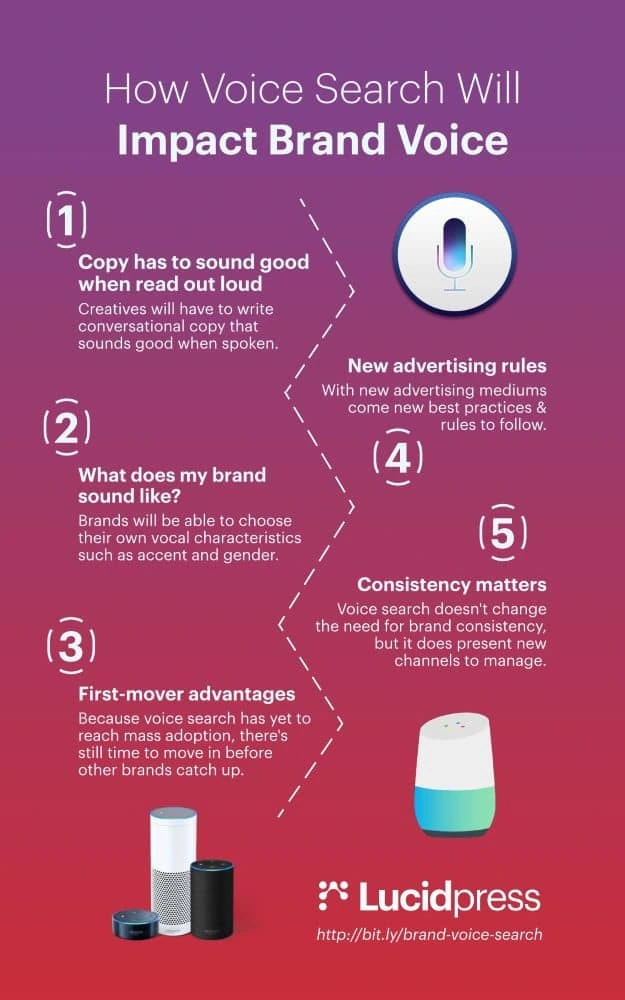
Protecting your brand—not only how it looks but also how it’s perceived—is essential.
Your brand is everything that makes up how your customers see you, and if you’re not presenting a consistent message across the board, you run the risk of confusing, alienating or even frustrating your customers. On top of that, you’re missing out on the opportunity to establish your brand and grow recognition, authority and trust.
If you’re operating in a multi-location company with staff working in various departments, establishing a process to ensure brand compliance is key.
Related: 10 examples of great brand guidelines
Where once a central marketing team might have created and controlled all marketing output, we’re now working in a much more democratic and fast-paced world. Branding, content and communications can’t just sit with one team anymore; it’s become a multi-player, multi-platform game that almost everyone in your company is involved in.
So when artistic license, so to speak, is given far and wide, how do you ensure consistency across the board—especially when it comes to multi-location branding?
How to ensure brand compliance
For many companies, frequent barriers to brand compliance include:
- Overworked designers with too many requests and slow workflows
- Wasted time for designers when things move too quickly or changes aren’t communicated
- Content that isn’t on-brand (usually arising from the need for a quick turnaround by a rogue team or individual)
- Outdated brand assets where the latest versions haven’t been made available, aren’t centrally stored, or don’t exist
- No brand manager who’s enforcing the guidelines and implementing smarter processes
- Over-complicated branding that’s difficult to follow
Luckily, with a growing list of new approaches to these old problems, the future of your brand looks bright.
Ramp up your brand compliance efforts by employing these two fail-safe strategies.
Create and implement brand compliance guidelines
With the creation of effective and detailed brand compliance guidelines, you’re dramatically improving your company’s chances of consistency.
Our report on the importance of brand consistency revealed that companies are twice as likely to see a consistent presentation of their brand when formal brand guidelines are in place and enforced.
A typical set of brand guidelines will cover:
- Logo variations & dimensions, plus details on when and how to use them
- Brand colors for both digital & print
- Brand fonts, sizes & suggested uses
- Tone of voice & brand messaging
The goal with your brand guidelines isn’t to limit the creativity of your marketers and designers, but to give them a set of guidelines to work within. There should still be plenty of opportunity for them to come up with new and exciting ideas that comply.
When it comes to enforcing brand guidelines, you’ll do a whole lot better if you can take away the challenges your people face.
As an absolute minimum, make sure the guidelines are easy to follow and centrally stored so that everyone—including partners—can access them without hassle.
The next step is to support all your people (not just your designers) by providing the resources they need to comply. With clear guidelines and easy processes, you’re leaving little room for error.
Create shared resources & customizable content templates
This strategy—known as distributed marketing management—is becoming an increasingly popular option for growing organizations who take brand compliance seriously.
Rather than relying on an overworked design team to churn out request after request (often with a lengthy turnaround time), customizable templates put some of the responsibility back with the individual or local team.
A modern brand management system such as Marq will empower local marketers and salespeople to create their own content and campaigns that still adhere to brand guidelines.
With the introduction of innovative software like Marq, you’ll get the following benefits:
- Shared access to a single platform with permission controls
- A central resource bank where only the latest versions are available
- Access from anywhere with cloud-based storage
- Lockable templates, so edits can be made without compromising branding
- Intuitive software that’s easy for everyone
- Simple multi-channel distribution across print & digital
With a system like this in place, you’re giving your people the power to act quickly and take advantage of local opportunities without compromising brand compliance.
Further, by opening this process up to your partners and affiliates, you see even more rewards. When you can give them access to brand guidelines and templates that are locked down, they’ll have more independence when it comes to collaborating and cross-promoting. All without putting extra pressure on your marketing team.
Sounds like a dream, doesn’t it?
Key takeaway
Total brand compliance is achievable, but it takes forward-planning, smart software and well-thought-out processes. To give your brand the best chance of success, create and enforce formal brand guidelines and implement a central system for sharing on-brand resources and customizable templates.
Instead of trying (and failing) to do everything for your people, give them the guidance and tools they need to do things for themselves.
In 2014, Marketing Sherpa published a report on customer acquisition costs (CAC) in e-commerce. According to this report, the median CAC is somewhere between $12 to $25. These costs add a lot of overhead to your business. If you’re a low-margin business, like most e-commerce stores, high customer acquisition costs can sink you fast.
Related: 8 killer email marketing tools for e-commerce
One way to bring CAC down is by building a bigger brand for your business. Branded e-commerce stores attract a lot of loyal customers. Such customers tend to shop several times throughout the year and are instrumental in improving profitability.
Let’s take a look at some strategies that can help e-commerce businesses establish themselves as a brand.
Establish stringent brand guidelines
The first step in the brand-building process is to establish stringent brand guidelines. These guidelines must include parameters like the “tone of voice” used in your messaging, logos, color palettes, fonts, photography style, and so on. Basically, it should cover anything used in your marketing materials.
To establish better brand equity, it’s important to accomplish two specific objectives. First, invest in building a style guide that will set you apart from the competition. This includes picking unique fonts and colors that aren’t common in your industry. You could also invest in creating unique image filters that will give your photos a distinct identity. Second, follow these guidelines across all your marketing channels: social media, website, TV, print and any other form of marketing.
A good example of this is Frooti, an India-based fruit juice brand. Although it’s not strictly an e-commerce brand, you can see that all their visuals adhere to a brand philosophy that includes flat design and a limited color palette.
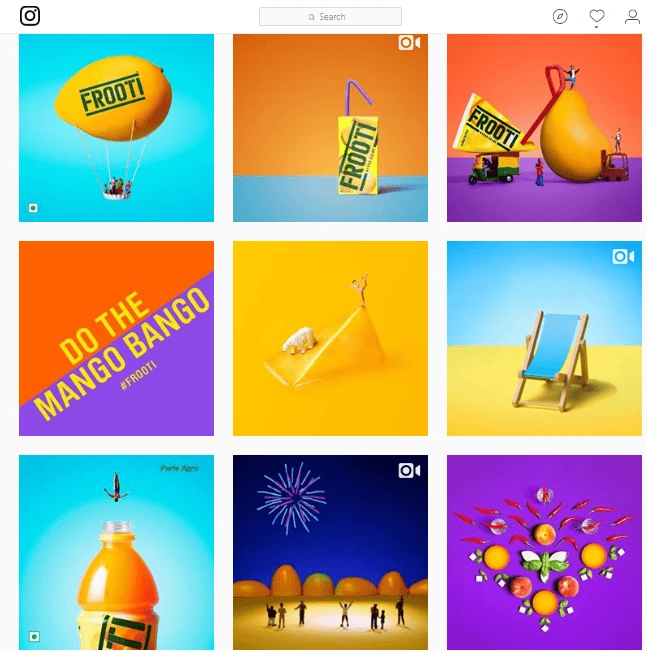
Source: Instagram
The reason this works is because your target audience tends to associate these visuals with your brand. This contributes to better recall and builds loyalty over time.
Pro tip: Lucidpress has a template-locking system that can help you adhere to brand guidelines consistently. Read more about it here.
Find your competitive advantage
There are many factors that contribute to an e-commerce sale. One of the most powerful ways to establish a brand is by identifying one factor where the rest of your competition sucks and mastering it. For instance, if you’re in a niche where the leading sellers take at least a couple days to ship, you might invest in overnight shipping. Alternatively, if all your major competitors charge for shipping, you could choose to offer free shipping.
This is exactly what Zappos did to establish themselves as the online shoe seller of choice. CEO Tony Hsieh realized early on that customers tend to have unique tastes for shoes, and in order to succeed, they’d have to make the return process ridiculously simple. The company provided its customers with prepaid return shipping labels that they could print for free returns. In doing so, Zappos outdid all competitors and established the most well-known brand in online shoe commerce.
The reason this works is because doing something better than others gets noticed by customers who then associate your brand with it. [] In addition to bringing word-of-mouth publicity, this strategy also gets your customers to return for future purchases. While such strategies can cost a lot of money, they also help to establish a brand name and improve customer loyalty.
Know your customers’ values
Learning your customers’ values means building a relationship with them that goes deeper than just producer/consumer. When people recognize and trust your brand, it’s because they see their own values reflected in it.
One of the easiest ways to learn about your customers’ values is simply to ask them. You could do some informal research on social media (or your blog) by covering certain topics and testing the engagement. Or, you could be even more scientific by conducting surveys and focus groups to learn more about the audience you’re pursuing.
After you’ve done this research, look back at your company. What do you already do that’s aligned with the values of your customers? These are the messages that will ring out the loudest.
When you can back up what you say with what you do, people will trust you and be drawn to your brand. [ ] Begin by looking for the values you already share with your target audience, then find ways to embody the others.
Know your brand story
For as much as things have changed in the world, people still love a good story. Whether it’s the story of a hero, an underdog, or simply the shared challenges and pleasures of the human experience, a good story moves people’s hearts and minds.
Every brand out there has a story—every one. The challenge is to share that story in a way that’s authentic and relatable. It might take some time to discover the best way to communicate your story to your target audience.
Start by zeroing in on your company’s purpose, or more specifically, the problem you solve. Let’s consider an example.
Say you manage an e-commerce brand that sells eco-friendly furniture and clothing. What’s your story? In short, you provide people with comfort and security in an environmentally friendly way.
But there’s something larger going on: climate change and the movement to address it. Your role in this global story is to meet people’s basic needs at a significantly lower cost to the environment. Your brand creates better harmony between humans and the earth, and people who care about the planet will want to help your cause.
In this example, your story represents and exemplifies your brand’s values. Positioning your brand as an environmental activist, or as a lover and defender of nature, will help you connect with your target audience. This powerful brand image comes from digging into the story, bringing to light what it really is.
L.L. Bean is a good real-life example of this. It started with a man designing his own pair of boots to make it easier and more enjoyable to walk around outside. But the larger story is about humanity’s love of nature. Through this narrative lens, you can easily recognize L.L. Bean’s brand. This is no coincidence.
Of course, your history might not be as deep as L.L. Bean’s, but it’s still meaningful. Take some time to find the best way to communicate your story, and it will clarify and reinforce your brand in the eyes of your customers.
Investigate influencer marketing
When it comes to ecommerce branding, customer trust is heavily influenced by the testimonials and referrals your business receives. Influencer marketing is one of the most effective ways to impact trust. This strategy involves hiring niche influencers (that is, social media users with thousands of followers in your industry) to spread the word about your brand.
Success with this marketing strategy relies on how targeted your influencers are. It’s a good idea to start small and reach out to influencers who have small audiences of less than 10,000—such influencers cost less and have a highly targeted audience.
Measure the impact of such a campaign and use the lessons to deploy larger campaigns. While partnering with large influencers outright might seem like a good idea to scale fast, these influencers appeal to multiple demographics and are thus not as targeted. The conversion rate from such campaigns tends to be lower.
The reason influencer marketing works is that prospective buyers tend to associate the credibility of the influencer with the brand they endorse. This makes it a much quicker way to establish a brand presence than growing your followers organically.
Pay attention to content authority
A typical customer goes through several stages of research before they land in your store for a purchase. Your store could miss on some real branding opportunities by not investing in content that the prospective buyer uses for research.
So, why is this important? First, it helps establish your brand as an authority in the industry. Customers trust authority sites which they return to for future product research. A comprehensive directory of articles could potentially make your website their “go-to” source.
It also provides your brand the opportunity to shape readers’ opinions and nudge them towards products in your store. Additionally, a comprehensive content directory helps your business rank better in Google searches, which reinforces your brand authority.
One of the best ways to do this is called the pair-up strategy. Essentially, marketers are advised to create a comprehensive content page that’s mapped to each of their product pages. Prospective buyers land on this central page during their research phase and are nudged toward the product pages through the content.
Key takeaway
Building a brand for your e-commerce business is an investment, but it’s one with dividends. By enforcing brand guidelines, finding your competitive advantage, and influencing buyers with great content, you’ll lower customer acquisition costs and develop an impressive reputation for your brand in the process.
Where to go next? Learn more about building & managing an online brand in our free eBook: How to build your brand in 2020
Think of some of the most iconic brands all time. What comes to mind? Nike? Apple? Disney?
Most likely you think about a logo, a slogan, or a general aesthetic that is unique to the brand. Whether sleek, futuristic or full of princesses, you should be able to conjure up some visual.
Related: How to maintain brand consistency in a sales organization
Why do these brands leave such a strong impression? Because they have been able to craft a consistent, creative message that sticks with you.
Any company will benefit from brand consistency in all touchpoints along the funnel. But before we talk about how they benefit, let’s break down what this really means.
What are the touchpoints?
According to Salesforce, consumers interact with 6 to 8 touchpoints just to get to sales in the funnel. That’s a lot of times to touch one brand before you commit to a conversation. And that’s only the top of the funnel.
As someone is transitioning from an unknown prospect to a customer (and an advocate), these are some of the touchpoints they encounter.
- Before purchase: website, blog, emails, social media, paid ads, public relations, sponsorships, event booths
- During purchase: website (again), local branches, delivery methods, e-commerce cart
- After purchase: customer support, knowledge base, customer surveys
- Bonus funnel: job postings, candidate communications
As you put effort into each of these touchpoints, you want your audience to connect the dots. This saves you time, effort and money down the road.
What do we mean by creative consistency?
The Oxford English Dictionary defines consistency as “the quality of achieving a level of performance which does not vary greatly over time.”
In a creative sense, that’s assuring your logos, design elements, messaging, tone and imagery stay the same from one touchpoint to the next.
This is often achieved by first implementing a brand style guide and templates across teams, then maintaining open lines of communication and support with other teams creating touchpoints.
Creative consistency means a level of work with your brand over time which does not vary greatly, such that people will recognize your brand from one interaction to the next.
Why is this important?
Creating a consistent brand image from one touchpoint to the next is important to for both psychological and economic reasons within your organization. It can help your company achieve the following results.
1. Makes your brand easily recognizable
Humans are hard-wired to look for patterns. Since the beginning of time, we’ve looked for patterns as a way to survive. We’ve used them to speed up our information processing, as well as look for dangers in our environment.
Creating a consistent brand helps people easily recognize and place your brand over time. It also helps people be more comfortable interacting with your brand along different touchpoints because they know what to expect.
2. Builds trust across channels
Have you ever gotten an email that just doesn’t look right because it’s different than what you expected? If so, it’s entirely possible that was a dangerous phishing email—and hopefully, you deleted it. Remember our reliance on recognizing patterns to survive? The same goes for building trust.
Since humans are hard-wired to look for patterns, we’re also wired to be suspicious of anything that deviates from the norm. Keeping your logos, colors and messaging consistent helps people see that they can trust your brand.
This goes double for any communications from your support and services teams. Since people reach out to those teams when they’re vulnerable and need help, creating a pattern of trust gives them reason to be comfortable working and sharing with your team.
3. Sets expectations with users
Have you ever clicked an ad for an article, only to find out the article was not what you expected to read? It doesn’t feel good for the user. How do you know you won’t be disappointed again the next time you click? Users want their expectations met as they click from one touchpoint to the next.
As users progress through your brand’s touchpoints, they’ll start to recognize each one as part of a larger picture. Everything you create will be part of that story. Creating consistency across everything from ad copy to messages from sales reps will reinforce the customer’s expectations as they move from one phase to the next in your sales process.
4. Lays a good foundation for content
Before you build a solid marketing plan, you have to start with a few building blocks—create some personas, map your customer journeys, inventory your assets and resources. Imagine how hard it would be to produce creative brand content when you’re missing those pieces.
To build an effective campaign, you have to know what imagery and messaging resonate, and what your audience expects to see. Do you have a quirky mascot, tagline or hashtag that you can build on? Then you can iterate on that concept’s success to tell a better story.
5. Promotes effective storytelling
One-off, single-channel interactions are out. Omni-channel, multi-touch processes are in. This is why we use techniques like ad re-targeting and marketing automation. As a marketer, you must connect the dots from one channel to another.
Consistency across these marketing touchpoints builds a story over time. They may not see the pieces all at once, but they will feel their cumulative effects. You’re more likely to respond to retargeting ads when the brand is one you recognize and trust.
6. Links everything together to create a single brand experience
Think of how much money you spend to acquire a single customer. Almost always, that acquisition is not done as a single event, but done over the course of multiple touches. Each of those touches costs money to create (either in dollars or in time). To maximize that investment, potential customers should feel these touchpoints form a single experience.
Don’t try to reinvent the wheel with every project or campaign. While we should always be improving and building better campaigns than the last, it helps to start with a consistent design, template or ad, rather than continuously spending time or bandwidth to re-design it.
Key takeaway
Building touchpoints with creative consistency leads to an effective, cohesive, trustworthy brand, and the more time your company can spend on the same page working towards that vision, the better.
Want to know more about the impact of brand consistency? Download our free 32-page report, chock full of stats & great insights.
Every business owners’ hope is that their business will grow. Whether it’s a small, medium or large business, there’s always room for growth. It’s an exciting process, but it might be short-lived if you’re unable to manage your brand consistently.
Related: Brand consistency—the competitive advantage and how to achieve it
As you add more people to your team and start producing more content (such as landing pages, social media posts and ads), how do you keep everyone on the same page? How do you maintain brand consistency to keep your brand’s message clear and strong?
Here are five tips on how to do just that.
1. Create a brand style guide
With more employees and less time to look over every piece of content, it’s difficult to catch off-brand materials before they go out.
Create a brand style guide that shows employees how to use your branding properly. This will help your employees create on-brand content that shares a consistent look and feel.
Your brand is more than just the logo and colors that you use, so naturally, your brand style guide will cover more ground than that. Here’s a list of useful sections to include.
Mission
What does your company do? Lay the foundation for your style guide by first addressing your company’s goals and what you hope to accomplish in the future.
If you haven’t written a mission statement or want to spice yours up, here are some powerful examples.
- Patagonia: “Build the best product, cause no unnecessary harm, use business to inspire and implement solutions to the environmental crisis.”
- Walmart: “Saving people money so they can live better.”
- Wendy’s: “To deliver superior quality products and services for our customers and communities through leadership, innovation and partnerships.”
Target audience
Discuss who your target audience is. What’s most important to them, and why do they use your product? This will help your employees better understand who they’re talking to and why it’s important to communicate with your audience in a consistent way.
Values
When someone reads through your brand style guide, they should be able to relate to your brand and anticipate how your brand will respond in certain situations. This is why it’s important to have a section dedicated to the values of the company.
What values must come first in your company? By including these, your employees will know how to communicate with your customers.
Brand personality
Your brand personality comprises the characteristics you use to describe it. If your brand was a person, what would they be like? Professional, witty, funny?
If you’re struggling to think of characteristics that describe your company, survey your customers and ask them what personality traits they feel your brand has.
This helps bring your brand to life and give better depth to your brand’s voice, tone, messaging, and even its visual elements.
Visual elements
This section is where you put all the specifics regarding your logo, colors, typography and imagery. Provide as much direction with these elements as possible. For example, show each version of your company’s logo and describe how it should be used, where it should be located, when to use certain colors, etc.
For more help in setting up your brand style guide, check out our post on great examples of brand guidelines. You can also look at this 99designs blog post that goes into more detail about brand guidelines.
2. Pay attention to messaging & tone
Communicating with customers is often achieved through writing. Text appears on your advertisements, in your product, in blog posts and on your website—just to name a few examples.
Imagine how confusing it would be if you had a friend who always spoke with a Midwestern accent, but then one day, they showed up talking like a Californian surfer or a seasoned New Yorker? All of these accents are great, but you’d be pretty confused about what was going on with your friend. Could you even trust them anymore?
This is why consistent messaging is important for your customers. If the writing on your website uses a formal tone, but they receive emails from you that sound like a casual conversation, they’ll be wary—and rightfully so.
While creating your brand style guide, focus on describing your company’s tone and provide writing examples that fit your company’s voice.
When you read what other employees have written, give specific feedback about what is on-brand and what is not. Over time, they’ll learn which words, phrases and punctuation are appropriate for the brand.
3. Regularly train your team
Now that you have a brand guide for your employees, show them how to use it. If you don’t, your brand style guide will likely end up being ignored. If you can get your employees excited about your brand, they’ll be inspired to represent it well by following your style guide.
The opposite is also true. If you fail to get your employees onboard with your branding efforts, they may reject these new “restrictions.” This will promote more inconsistency and upset employees.
Keeping your brand consistent is a team effort that requires everyone to be onboard. Prepare an engaging presentation to introduce the brand style guide and strategy. Listen to their feedback, but make sure everyone understands the importance of consistency.
There might be a need for additional training for employees who are more involved in branding efforts such as writers, designers, marketers, customer service reps and managers. Once these employees are ready to build up your brand, ask them to share the same training with new employees as they onboard.
Keep an eye on the enthusiasm surrounding your brand. As it fades, you’ll have to recalibrate with reminders and additional training. It’s important for employees to know that you will champion the brand over the long term.
Key takeaway
When you focus on building a brand, the most important thing is to commit to it. No matter how well thought-out your brand is or how clever your messaging is, if it’s inconsistent, consumers will lose trust in you.
Create your brand guidelines, train your employees, find the right messaging and stick to it. The best companies in the world have championed their brands for decades. This consistency is part of their success—they’ve become familiar, beloved names for millions of customers. Lay the foundation for your brand today, so it can reap the benefits for years to come.
Want to know more about the impact of brand consistency? Download our free 32-page report, chock full of stats & great insights.
Customer loyalty separates historically successful brands from the rest. Why do people consistently drink Coca-Cola or wear Nike sneakers? The answer is a simple one: Those brands have earned trust from their customers. Their products are of high quality, and their brand messaging has remained consistent, making it easy to cultivate brand integrity with customers.
Building integrity through your brand requires following the correct blueprint. You can’t build an entire house by following instructions on how to assemble a new sofa. In the same vein, building and maintaining brand integrity starts by using strategies that help you stay on-message and foster loyalty and recognition.
If you’re looking for the right blueprint, consider following these five guidelines to build and maintain your company’s brand integrity.
1. Choose the right products
One misstep can create a long-lasting negative impression for a brand. IHOP drove this lesson home when the company changed its name and logo to IHOB to announce new burger offerings on its menu. Customers and critics alike lampooned the decision, stating that the company had strayed from its breakfast roots. IHOP reverted to its old name and logo, and it claimed the move was only a temporary promotional stunt. Even if that’s true, it didn’t undo the negative publicity the brand endured.
The lesson here is simple: Choose the right products to maintain consistency in your brand message. Trying to go “off the menu” to deliver what you think is a better product could confuse customers, employees, vendors and other parties. Products should always feel cohesive and congruent with your overall brand identity. That consistency lays the foundation for brand trust.
2. Make customers your top priority
Customer engagement forms the backbone of any successful business. Your company gains strength by offering high-quality products and reliable services to its customers time and time again. It’s the cornerstone for building relationships of trust with those customers.
Dropping the ball can be a disaster. Customers notice when your company makes mistakes, such as producing inferior products or offering poor customer service. Such slip-ups can convince them to leave, which ultimately hurts your brand reputation and negatively impacts your bottom line.
One of the best things your business can do is to fulfill what your brand promises by putting your customers first. Start by
- Identifying their needs.
- Create solutions tailored to meet their needs.
- Keep communication open by hiring a dedicated customer support team and maintaining an active presence on social media.
Because when your business is approachable, customers are more likely to trust your brand to find solutions for their problems as they arise.
3. Be honest
Chances are, when you see an infomercial pop up on TV, you quickly change the channel. Why is that such a common reaction? The simple answer is that no one likes feeling manipulated.
Infomercials have a lousy reputation partly because the products featured are often long on promises and short on results. From cookware guaranteed to never wear out to miracle cures for a host of ailments, these products are often too good to be true. No customers enjoy feeling misled, and the brands associated with “As Seen on TV,” products often suffer the results of negative perception.
Your business should be wary of falling into the same trap. Always be truthful in advertising and other forms of communication with customers — respect their intelligence. Be honest about what your products and services can do, and play to their natural strengths.
Fostering integrity with your brand starts with honesty. If a customer can’t trust your brand messaging, how can you expect them to trust your business?
4. Employ realistic marketing strategies
Reckless marketing campaigns give the wrong impression about your brand to customers and employees alike. It’s tempting to kick the hype machine into overdrive whenever you roll out a new product or service. But bigger isn’t always better. If your marketing veers into uncharted territory by making promises your business can’t keep, the road back to restoring brand integrity can be long and treacherous.
How do you feel when a product works as advertised? It’s amazing! You want to give that same feeling to your customers and employees. Give them a reason to feel excited, of course, but make sure you’re still coloring within the lines. Focus on the real benefits and results of your products, rather than allowing your creative energy to devise claims that aren’t achievable.
5. Maintain a consistent moral code
Doing the right thing for the right reasons is not an antiquated virtue. Businesses who play dirty often end up looking dirty in the eyes of the customers they want to attract.
Understanding which values your customers cherish is essential. Take enough time to learn what those values meanwhile you’re conducting market research. Then, take it a step further and weave those values into the fabric of your brand.
If your brand has core values that define your company’s culture, stick to those values. Doing so fosters an authentic and favorable brand image. Betraying those values can do more to undermine your brand’s integrity than just about anything else. The last thing you need to do in a crowded marketplace gives customers and employees a reason to turn away and march into the arms of a competitor.
Key takeaway
Building and maintaining brand integrity is a long-term strategy for success, but the results are well worth the investment. By choosing the right products, putting customers first, making promises your brand can keep, and sticking to your company’s values, you build a long-lasting brand that customers and employees are proud to support.
Want to know more about how to build your brand? Download our free ebook on how to build a brand in 2020.
Do you want to learn how you can make your company stand out from the crowd?
Or how to position your company so a prospect sees you as the only viable option when choosing between you and a competitor?
And finally, do you want to learn some little-known tricks that some of the biggest companies in the world use to turn people into loyal fans?
You’re in the right place.
Related: The 7 key elements of corporate and brand identity design
By the end of this article, you’ll understand what digital branding is, why it’s important, and how you can adapt the methods big brands like Nike & Apple use to sell more products.
You’ll see concrete examples of how to plant in your prospects’ minds the brand image you want them to perceive.
Whether you want your company to be seen as the best, the cheapest, the fastest or the best customer experience, these actionable techniques will help you.
But before getting into the strategy, let’s cover the basics.
What is branding?

How would you describe this shape? It’s called a swoosh. But, you know what’s really interesting?
Most people don’t know what a swoosh is. And most people don’t know why Nike adopted it as a logo or what this shape is supposed to convey.
Still, we’re willing to pay more for a T-shirt with this shape on it than for a plain T-shirt made with the same cotton.
Nike isn’t the only example, of course. Take Mercedes or BMW—or any other well-known brand. Do you know what their logo means? Their history? Why they’re better than their rivals?
If you’re a huge fan, maybe. But, most people don’t.
Still, we have preferences. When it’s time to open our pockets, we eventually choose one over the other. How and why do we choose one over the other if we don’t know that much about either?
The answer might seem a little obvious: because they made us feel something.
When you buy a Mercedes, you aren’t just buying a car. You’re buying status. When people see you driving it, you feel accomplished, educated, wealthy and so on.
When you buy a fresh pair of Nike Jordans, you feel empowered like a great athlete, you feel like you’re going for it, and you almost feel like a star.
Why do we feel that way? Because that’s how brands are telling us to feel.
Branding is not what people know about your company, products or service. It’s not a static set of characteristics to remember about you. It’s not your content marketing, social media or creative advertising.
Branding is everything you do to make people feel a certain way.
This leads us to our next question.
Why is digital branding so important?
Why should you put a lot of effort into making people feel a certain way about your brand?
Imagine you go into a sports store to buy a T-shirt. You have three brands sitting in front of you: Nike, Adidas and a generic brand. All the same color. All the same fabric.
You don’t care about the material since they’re all made of basically the same fabric. They look the same. They feel the same. The only difference is the logo and the price.
But in a matter of seconds, you make a decision. You decide intuitively that brand A is better than brand B. And that’s why branding is important.
Branding is a promise that buying a product from brand A will give you more benefits than buying a product from brand B.
Now, how do you plant the perception in people’s minds that your brand is better than your competition?
This leads us to our next section.
Essential digital brand management tips
Branding shares similar principles whether it’s happening online or offline. Your goal is to make people feel a certain way about you, no matter what channel you’re using.
Since everything is shifting towards the digital world, below you’ll find mainly digital brand management tips that will help you build your online identity and stand out from the crowd.
1. Find your core values. What do you stand for?
If you want to build a strong, lasting brand, you need a strong, lasting strategy. Any powerful branding strategy starts with the company’s core values.
Here’s Apple’s mission statement from 2017:
“Apple designs Macs, the best personal computers in the world, along with OS X, iLife, iWork and professional software. Apple leads the digital music revolution with its iPods and iTunes online store. Apple has reinvented the mobile phone with its revolutionary iPhone and App Store, and is defining the future of mobile media and computing devices with iPad.”
Words like “the best,” “leads,” “revolution” and “reinvented” clearly tell you that creativity, innovation and being different are things Apple cares deeply about. And we’ll see in a minute how they express that.
But first, let’s return to a previous example: Nike. What does Nike stand for?
It isn’t about the shoes. It’s about great athletes, striving and going for it. It’s about being the best version of yourself. Or, to put it in their words:

“Our mission is what drives us to do everything possible to expand human potential. We do that by creating groundbreaking sport innovations, by making our products more sustainably, by building a creative and diverse global team and by making a positive impact in communities where we live and work.”
Considering these two examples for reference, how do you want to be perceived by people?
- Are you the best?
- The fastest?
- The cheapest?
- The most luxurious?
- The most reliable?
At Lucidpress, our mission is to make creating beautiful, on-brand content quick and easy for everyone. We believe each brand has a story, and our graphic design software exists to make it easy for brands to tell their stories visually. You can see how this mission influenced our homepage design:
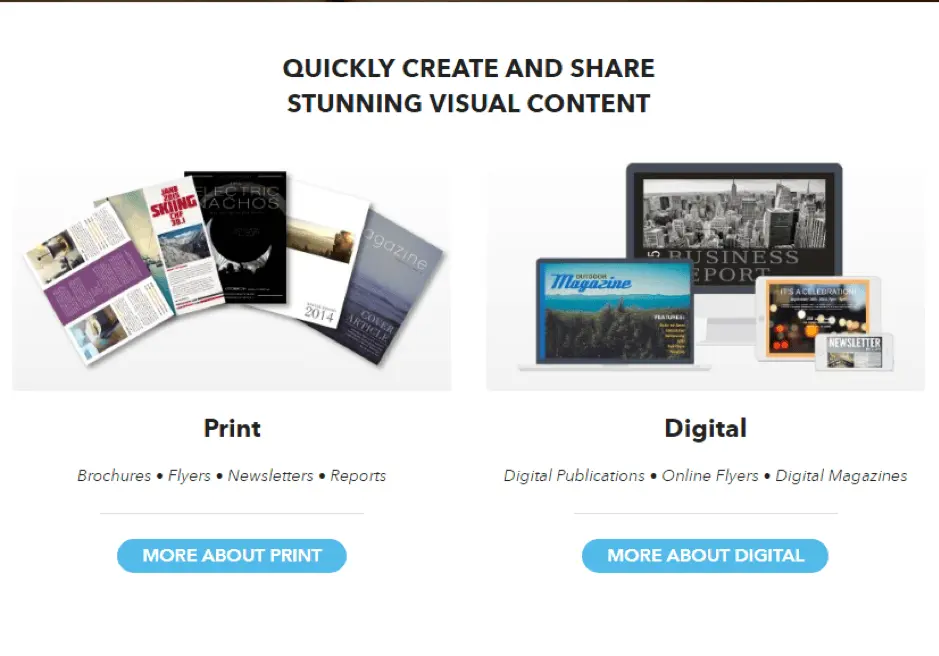
2. Express those values consistently in everything you do
If you want people to feel about you in the way you decided, you have to keep representing those values in everything that you do.
Let me give you some examples to show what I mean.
We mentioned earlier that Apple stands for creativity, innovation, and being different, right? Here’s how they express it, even in the small details.
Not that many years ago, there were only black headphones. That was the norm.
When Apple released the iPod, they had a problem. The device lived in people’s pockets, so no one could tell you were listening to an iPod just by the sight of your black headphones.
What did Apple do?

They designed white headphones.
As psychologists and business experts have noted since the iPod’s release, the decision to make its earbuds white sent Apple’s reputation as an uber-cool company into the stratosphere.
That’s an offline branding example. Here’s how they deal with digital branding on their website.
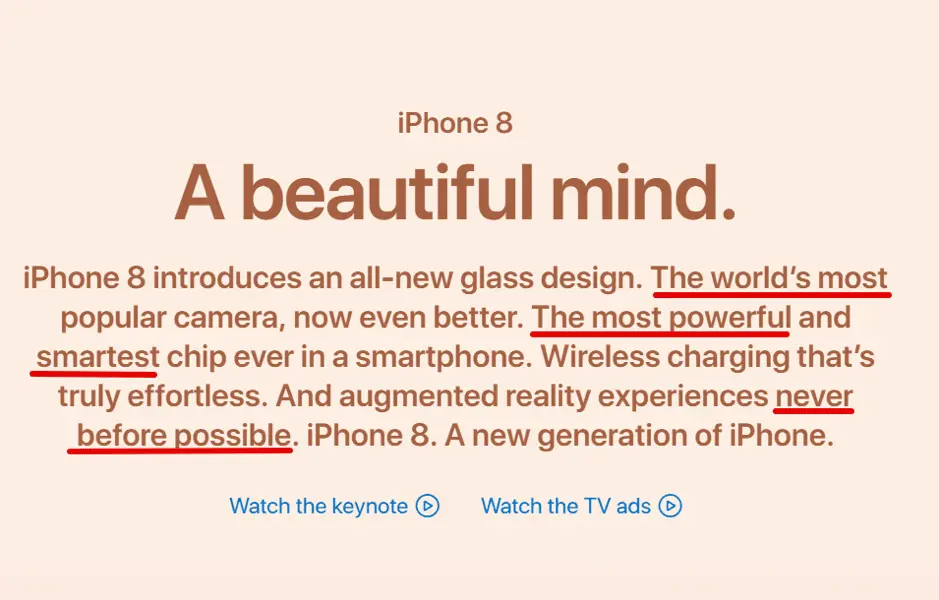
- “A beautiful mind.” —> creativity
- “The world’s most popular camera” —> excellence, the best
- “The most powerful and smartest chip ever in a smartphone.” —> excellence, the best
- “And augmented reality experiences never before possible” —> innovation
In every aspect of its communication, Apple keeps repeating its core values.
Even if it’s not explicitly stated, they suggest them to you, which is often more powerful than just saying it.
Let’s return to Nike. As stated earlier, they don’t just sell shoes. They celebrate great athletes, and they want to expand human potential.
If you look at their digital branding, you rarely see pictures or videos showing off their shoes. Instead, you see athletes and performers being the best version of themselves, exemplifying one of Nike’s core values.
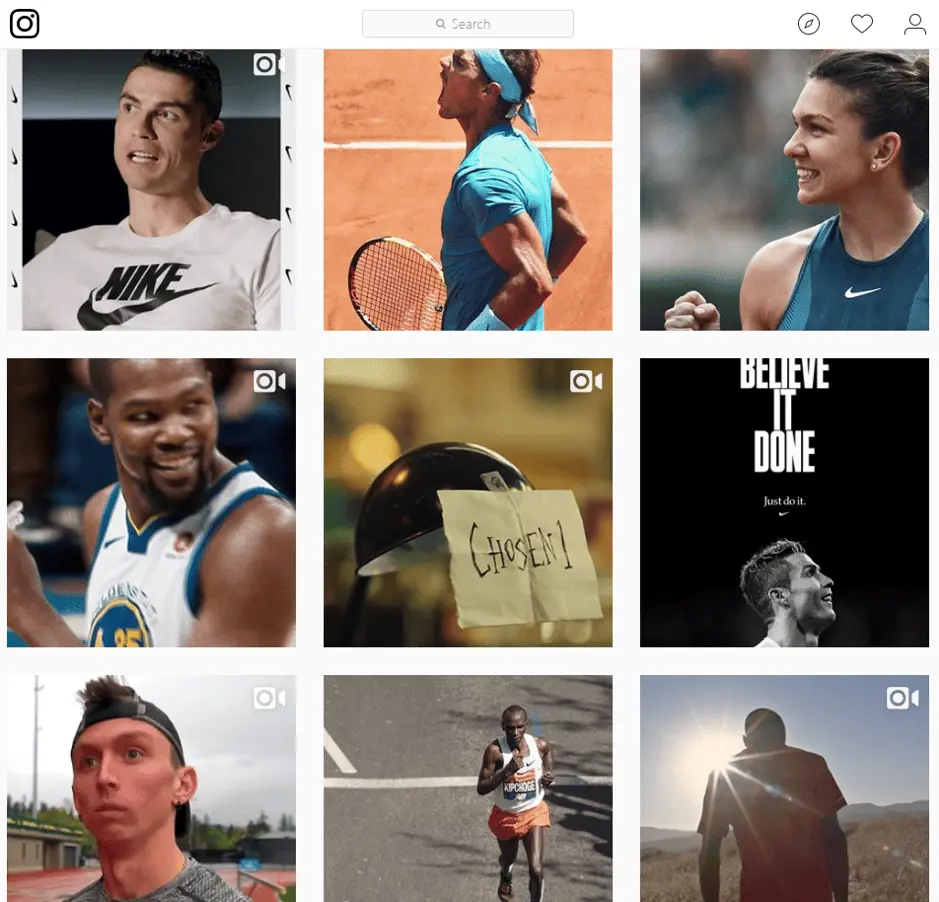
3. Keep your style & communication consistent
If you want people to recognize your brand instantly, then keep your style consistent across all channels, including digital branding and offline branding.
What do I mean by style?
It’s the fonts you use. The colors. The tone of voice. The choice of words. Your logo. Everything that defines what your brand is. This area of branding is also known as brand identity design.
Here’s a digital branding example from Carlsberg. If you take a look at this post, you’ll see that they’ve repeated part of their value proposition: probably the best beer in the world.

For more, head over to their Instagram profile. Almost every post uses green, and they use their value proposition innovatively to describe experiences related to enjoying a beer.

Or on this real-world banner where they don’t even show the bottle, but you can instantly recognize it’s about Carlsberg.
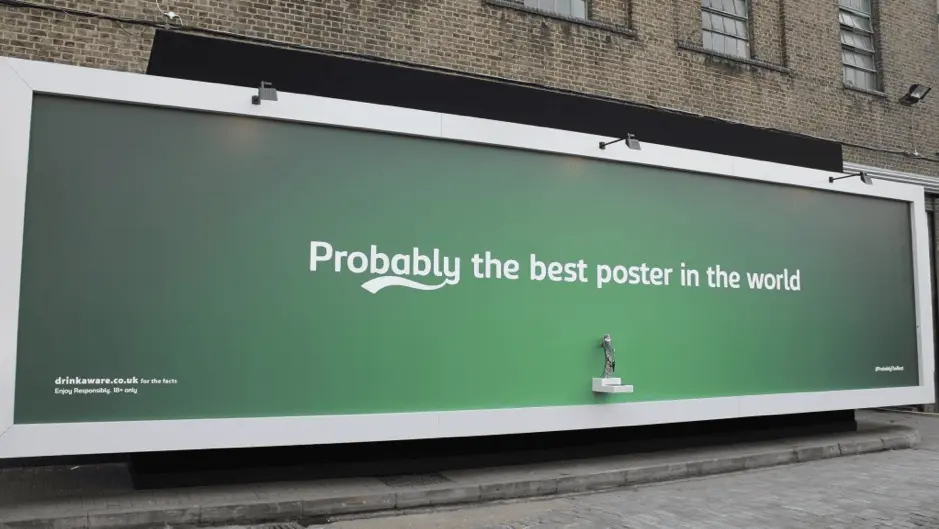
This consistency builds recognition and trust, because the brand has become a familiar personality people can relate to.
4. Make it easy for people to understand
Find a way to concisely tell customers who you are. And I’m not referring just to the tagline here, but to your communications as a whole.
Don’t try to play clever word games that become too complicated. Don’t try to use big words and phrases that have no real meaning.
Your message should be closely associated with your brand’s values, and you should condense it into one or two sentences.
This part of the brand building process goes beyond your logo and tagline to define:
- who you are
- what you offer
- why people should care
To summarize, your definition should be instantly understandable while simultaneously striking an emotional chord. Make it resonant.
Think about it this way: You don’t have half an hour to explain to your customer what your company does. In most situations, especially if we’re talking about digital branding, you barely have half a minute.
Carlsberg is probably (see what I did there) one of the best examples of a clear value proposition.
But as I mentioned earlier, it doesn’t have to be about the tagline. Effective digital branding can be done in the details, like your website’s headline, the signature of your email or a short description on your business card.
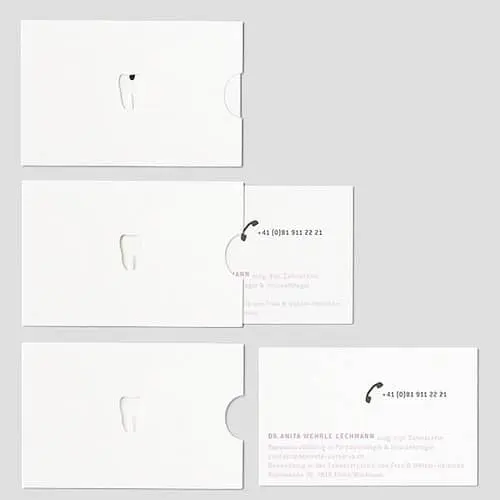
Okay, so we’ve reviewed a few crucial digital branding tips. But, how do you make sure your brand stays consistent throughout all your marketing channels?
What if you go through a rebrand? What if your marketing team goes through some personnel changes? How do you make sure your brand maintains its style and core values?
Fortunately, we’ve got some tips here, too.
5. Establish brand guidelines with a clear identity
To make sure everyone is on the same page, you need to have documented brand guidelines that anyone in the company can find and use.
It’s a document that contains all the rules for composition, design, and general look-and-feel of all a brand’s collateral.
For ideas and inspiration, here are a few great brand guideline examples.
Medium
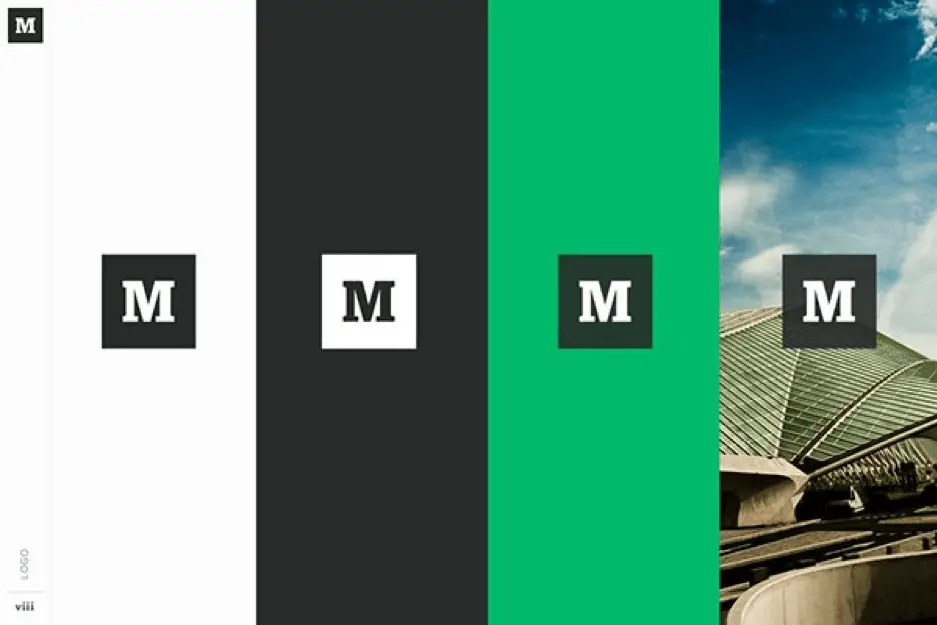
See the full brand guide here.
Skype
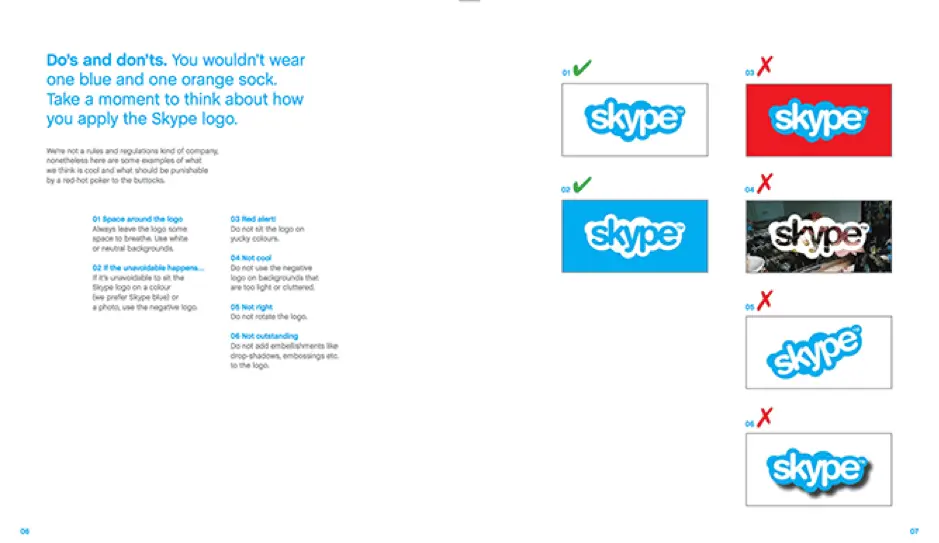
See the full brand guide here.
Scrimshaw Coffee
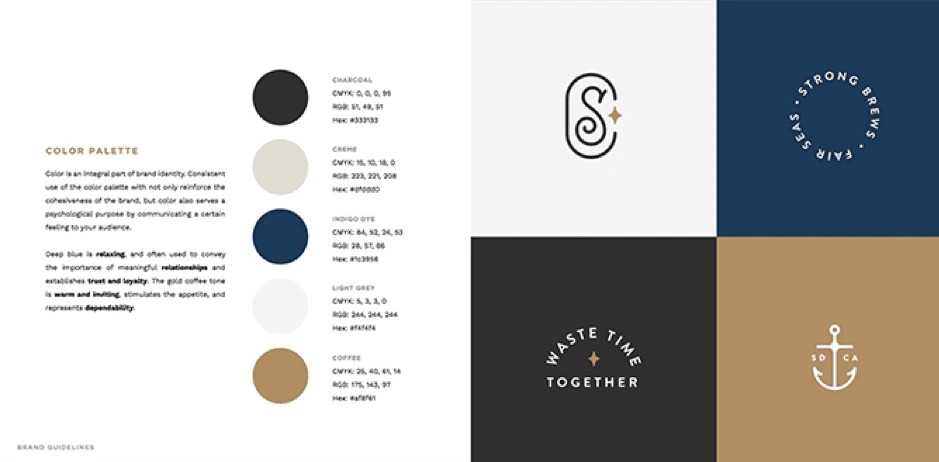
See the full brand guide here.
If you want a few more great examples, check out our post: 10 best corporate identity design examples
And if you’re ready to create your own brand guidelines, we’ve got a handy template to help you get started: Brand style guide template
Speaking of templates, let’s move onto our next point.
6. Invest in templates which reflect your brand’s aesthetic
Ok, so you have the guidelines. But, what if a new person joins the team and hasn’t managed to get a solid grasp of them yet?
One easy way to minimize errors is to invest in a designer who can create “best practice” templates that are in line with your brand’s ethos and aesthetic.
This ensures no one in your company has to take matters into their own hands, because they can draw on templates that reflect your brand every time they create a new document.
If you’re using Lucidpress, you can customize templates to easily create stunning content without having to start from scratch every time. And because of its innovative Brand Assets feature, you can make sure everyone is using the latest version of your branding elements. Fonts, colors and logos are all pre-loaded and ready to go.
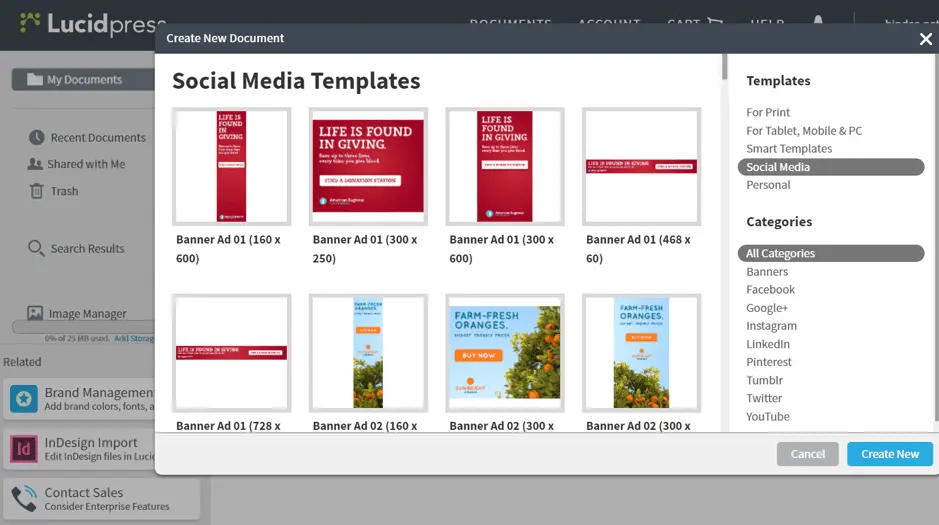
7. Make sure you update your brand messaging & visuals everywhere
At this point, you have (or will have) a brand manual and a handful of templates that are in line with your brand aesthetic.
But, what if you go through a rebranding? What if your designer has to make a small change to your logo—how do you ensure your team uses the right version?
There are two ways to avoid this.
The hard way: You create a spreadsheet where you keep track of every edit you’ve ever made. Of course, you realize how tedious this can be—not to mention this method isn’t foolproof.
The easy way: You can use brand management software to make things much easier, and you can be 100% sure there are no errors.
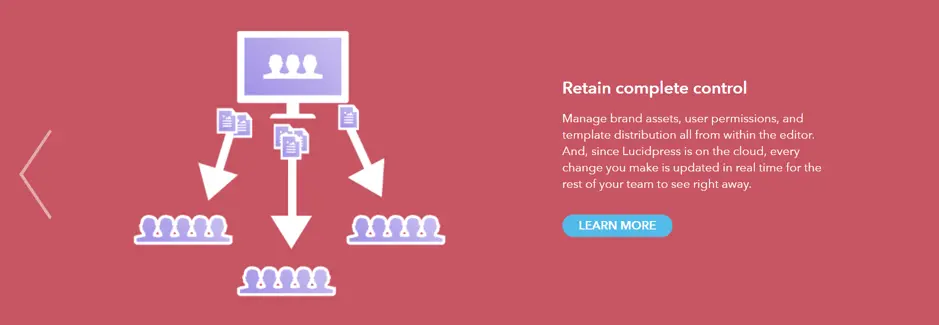
Of course, we’re biased here, but with Lucidpress, your team has access to all brand assets in one place. Beyond that, you can lock down branded elements in your templates that should never be changed.
Lucidpress also offers real-time collaboration, which makes it easy for anyone on the team to work together and make sure your brand stays consistent throughout every channel.
Key takeaways
There are two main things I would like you to remember from this article.
1. Consistency is key to building a strong brand.
A strong, lasting brand takes years to be developed. Just look at the big brands out there. There’s no such thing as an overnight success. That’s why consistency is key.
2. Start with your company’s core values.
Before starting any brand marketing, make sure you clearly define your company’s brand identity. Your values, who you want to be, how you want people to perceive your company.
Because if it’s not very clear for you, don’t expect it to be clear to customers—no matter how often you’re communicating with them.
When you know exactly what you want to communicate, you’ll easily find ways to convey that message, and your audience will notice.
Want to know more about the impact of brand consistency? Download our free 32-page report, chock full of stats & great insights.
It’s something you’ve been told to do for years, as far back as your high school English classes: Define your voice. Voice is sometimes talked about as some ineffable je ne sais quoi. It’s something that’s felt more than defined.
Related: Branding? Follow this template for creating a brand platform
But in reality, voice—the elements of personality that make a brand or person so distinctly themselves—can and should be defined. In fact, according to the Nielsen Norman Group, voice can have a huge impact on how much consumers trust or care about a brand. And that matters, because customers are far more likely to spend money with a reliable brand than an unreliable one.
What is brand voice?
Brand voice specifically refers to the content your business publishes online, in print, and anywhere else. It’s made up of the words you use and how you choose to use them—in other words, it’s the voice with which your business speaks.
Not sure what your brand’s personality is or should be? Here are five tips to help you define and sustain your brand’s voice.
1. Spend time putting words to your brand voice
While this step might look simple on the surface, it’s something a lot of companies overlook. If you want your brand’s voice to be consistent and scalable for growth, you have to clearly document it.
Begin with a voice tool as a starting point, or simply play through a few improv-style scenarios, feeling out how you and other stakeholders would expect the brand to respond in a given situation. As you launch new products, would your brand message contain more excitement or confidence? When customers write in for support, is it more important for your staff to be appeasing or authoritative? Which main values or interests do you want your messaging to regularly drive home?
Carefully document the responses, then identify any patterns or trends. Narrow down your list to a core set of descriptors (between three and five). From there, you can construct statements highlighting what your brand identity is and isn’t. By establishing and documenting the foundation of your company’s voice, you have a point of reference for any future communication or branding.
MailChimp’s voice and tone guidelines are a great point of reference for how to do this. The description is fairly brief, but each word gets a lot of work done.
2. Create consistency in every bit of content and copy
A truly effective voice requires consistency across all messaging. No piece of copy, content or communication should stray from that core persona, or you risk hurting how consistent your brand is perceived. And given that consistency can provide a 23% revenue increase over brands that lack it, inconsistency is one mistake you really can’t afford to make.
Take Cards Against Humanity. Every piece of writing in its games and on its website bursts with snarky sarcasm. The company has even set up training to ensure that support staff can meet customer needs without losing the signature sass that has come to define the brand’s voice.
If you want to follow this model, share the brand guidelines you established in the point above so all staff members know what is and isn’t allowed. Set up QA processes to make sure that everything aligns, from your social voice to your customer support voice. Specific tone can differ to suit different situations, but the central voice that defines your brand should remain constant across all communications and posts.
3. Raise your brand’s voice through proper channels
Everyone has that one extended relative—a grandma or a great aunt—who uses Facebook in a way that’s just a little bit off. And that’s exactly what you want to avoid. Because in a lot of ways, where you share your message matters almost as much as what you’re sharing.
The reason for this is twofold: First, it makes good financial sense to put brand resources and time where they will have the most impact. Second, and maybe more importantly, the platforms you use can impact how your brand’s voice is perceived. A teen-focused brand posting primarily on LinkedIn will confuse a lot of people; the platform lends itself to more formal business voices. Forcing a casual, slangy brand into that mold could be a recipe for failure.
Influencer marketing and advertising deserve attention here, too. If your strategy involves partnering with influencers or celebrities to sell a product—and there are plenty of good reasons to go this route—pay careful attention to how and where they share their messages. You can’t demand that an influencer change their persona to advertise your product without defeating the point of influencer marketing. Instead, spend some time listening to and watching the people you want to partner with to find someone who naturally matches your brand’s voice.
For a great example, look to underwear brand TomboyX. The brand works hard to speak to the LGBTQ+ community in a voice that feels human, confident and aware. TomboyX found an ideal voice pairing in Cameron Esposito, with an influencer-esque ad that plays during Esposito’s podcast, QUEERY. The ad, which involves Esposito giving a positive review of her own experience with the brand’s product, sounds genuine and real, perfectly harmonizing with TomboyX’s voice.
4. Walk the talk
As we’ve discussed, content and copy are huge parts of brand voice definition—but that’s not where consistency ends. For a voice to feel honest and genuine, it has to be backed up by other brand elements, including visuals and products.
A lot of beauty and fashion brands have pivoted to include more “natural” messaging in recent years. “Organic,” “pure,” “unretouched” and similar terms have gone beyond slogans and now feel baked into brand personas. But, how many brands succeed when it comes to backing up those words with concrete action, both in terms of visual advertising and product offerings? Not many.
That’s part of what made American Eagle’s recent #AerieREAL campaign so refreshing: The brand translated its voice and values into its ad campaign photography. For many consumers, this was the first fashion campaign they’d seen that included models with disabilities—real bodies wearing the product they were advertising.
If you really want to sell your brand voice, you have to back it up. Otherwise, even the strongest voice will start to ring hollow.
5. Don’t be afraid to—consciously—grow and adapt
Finally, adjust your voice as your brand grows.
That’s not a call to revamp everything at the drop of a hat—constant rebranding won’t do much to help encourage company recognition or loyalty. But an occasional and purposeful shift to respond to a growing market or changing attitude can and should be encouraged.
A particularly relevant example of voice evolution is Soylent. It started out as a niche, DIY-focused product with a voice that spoke primarily to busy engineers and developers who cared more about the function than the form of what they were eating. The creator himself said that even the brand name was designed for “encouraging further discussion and thought,” solidifying the brand’s methodical, analytical voice.
However, as the product picked up new followers and expanded into new markets, that voice changed. It holds on to some of its original directness but now brings friendlier reassurance to the table. What once read as intentional austerity now feels more palatable.
Since the change, Soylent has seen more commercial success, moving into markets on Amazon and college campuses. It’s unlikely that it would have seen that level of success without some voice adjustment to better speak to its newer, larger audience.
Key takeaway
There’s no denying that it can feel daunting to establish your brand’s voice in a world that already seems saturated with a lot of noise. But, it’s not all about volume. Use the tips above to build a voice that resonates with your audience, and reap the benefits of better brand recognition and a better bottom line.
Competition for customers is fiercer than ever, but a well-planned franchise marketing strategy can make you stand out from the crowd.
However, strategy is quite a complex subject. Can it be condensed into a simple article?
If you ask us, we say yes. We’ve distilled the most important steps a marketing strategy should contain. You’ll see in the examples below that even major brands follow the principles explained in this article.
Related: 4 best franchise softwares to boost your brand
Whether you’re a franchisor, a franchisee or a marketer, this is a great practical resource for you because every principle here is backed with concrete examples to inspire you.
Ready? Let’s dive right in.
Segment your audience if you want to maximize your results
You already know that you can have the best product on the planet, the most persuasive sales message, or the most creative ad ever—but if you deliver it to the wrong person, it will never work, right?
This applies whether you’re a franchisor looking for franchise buyers or a franchisee who wants to attract more people to your business.
So, if you want to make the most of your marketing efforts, your marketing plans have to start with your core audience in mind.
Below, you can find a few essential questions to ask yourself (or even better, your existing customers) to find out who’s most likely to buy from you.
Questions to ask yourself & your team:
- What are your product/service’s best features, and how does each translate into a benefit for the consumer?
- What’s special about your product/service in comparison to your competition? Are you unique, cheaper, quicker, better value, safer? The most trusted, the first, the oldest, the most tested?
- What could be your customer’s main objections?
- Which topics are your customers interested in? Who influences your ideal client (books, publications, media, influencers, etc.)?
- Where can you catch your ideal customer’s attention? Phone, email, social media, TV?
- What is your ideal buyer’s income?
Questions to ask your existing customers:
- Why did you choose us and not a competitor? Is there anything that pushed you in favor of us?
- How did you find our website or location?
- How would you feel if you could no longer use us? What would you miss?
- What’s one thing you don’t like about a competitor, or that we could improve to better meet your needs?
- What would you likely use as an alternative if we were no longer available?
- Have you recommended us to anyone? Why or why not?
Prioritize channels
One of the biggest mistakes entrepreneurs make is trying to be on every platform out there.
Trying to tackle every channel available can be a great strategy if:
- You have the resources to do this (time + money + knowledge).
- Your audience is on every platform.
The first point is pretty clear. Few companies have the resources to go that broad with their marketing efforts. Second, often times, our audience isn’t everywhere.
For example, if your target audience is between 18 to 25 years old, you might be better off going for Instagram than Facebook.
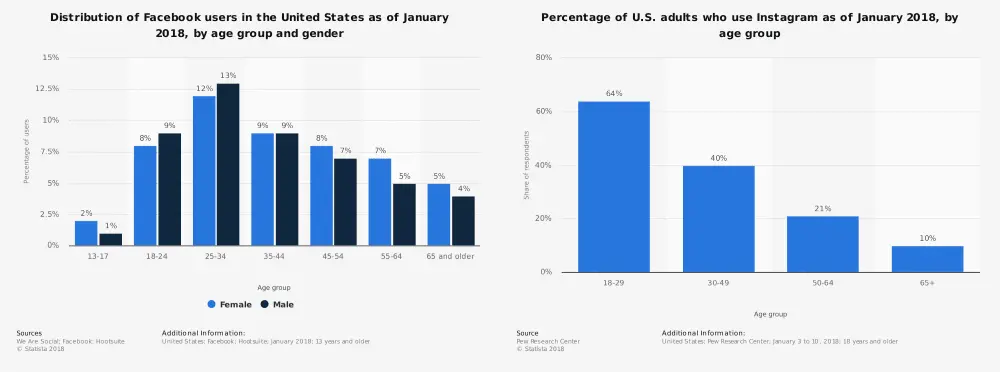
Source: Statista
Or, if you want to use Twitter as one of your main marketing channels in Europe, you might reconsider because Twitter hasn’t penetrated Europe as much.
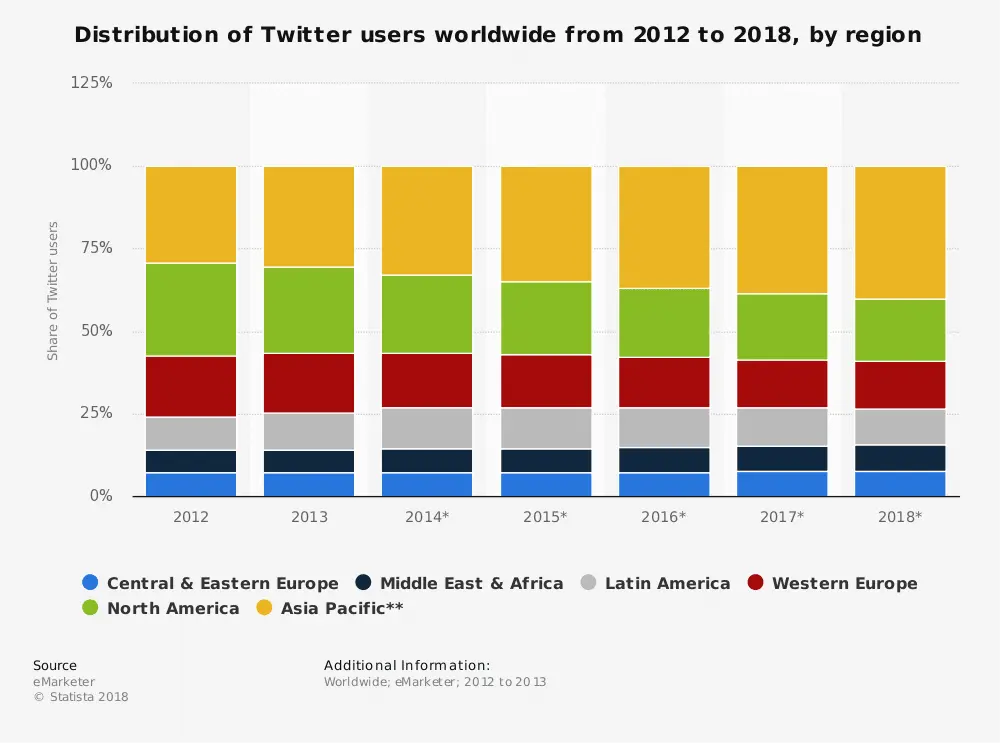
There are a lot of effective channels available. How do you prioritize them?
Here’s a simple, tested system borrowed from growth hacking marketing you can use. This is the same marketing concept used by startups like Facebook, Twitter, LinkedIn & Airbnb:
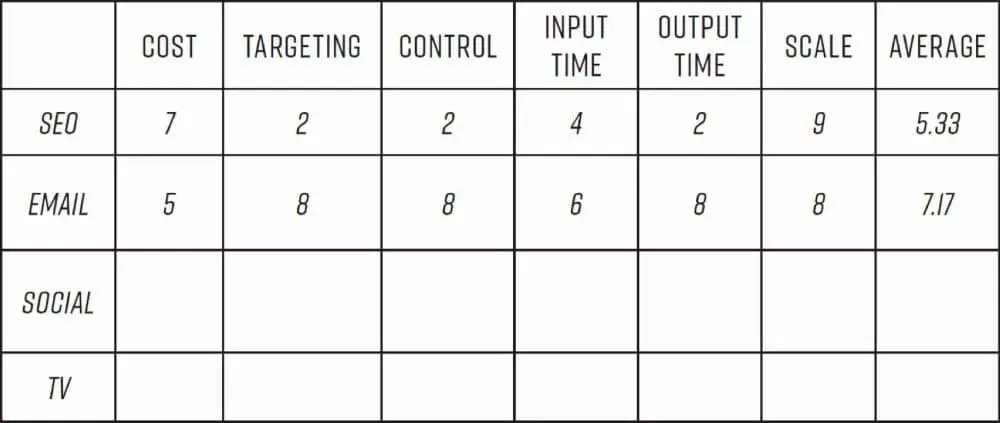
Source: GrowthHackers
Cost — how much you expect to spend on that particular channel (check cost statistics beforehand).
Targeting — how easy it is to reach your intended audience and how specific you can be. Does your chosen platform/channel have local advertising capabilities, for example?
Control — how much control you have once you go live. Can you stop it easily or adjust if it’s not going well? For example, it’s much harder to change a billboard than a Facebook ad.
Input time — how much time it will take to launch the experiment. Filming a television ad, for example, has a much longer input time than setting up a promoted tweet.
Output time — how long it will take to get results once it’s live. For example, search engine optimization (SEO) could be a great channel for your franchise marketing, but it has a much longer output time than pay-per-click does.
Scale — how large an audience you can reach with the experiment. Television offers much larger scale than advertising on a niche blog does.
Make sure you maintain consistent branding
Different channels require different creative.
Twitter is more text-based because people use it for news and articles.
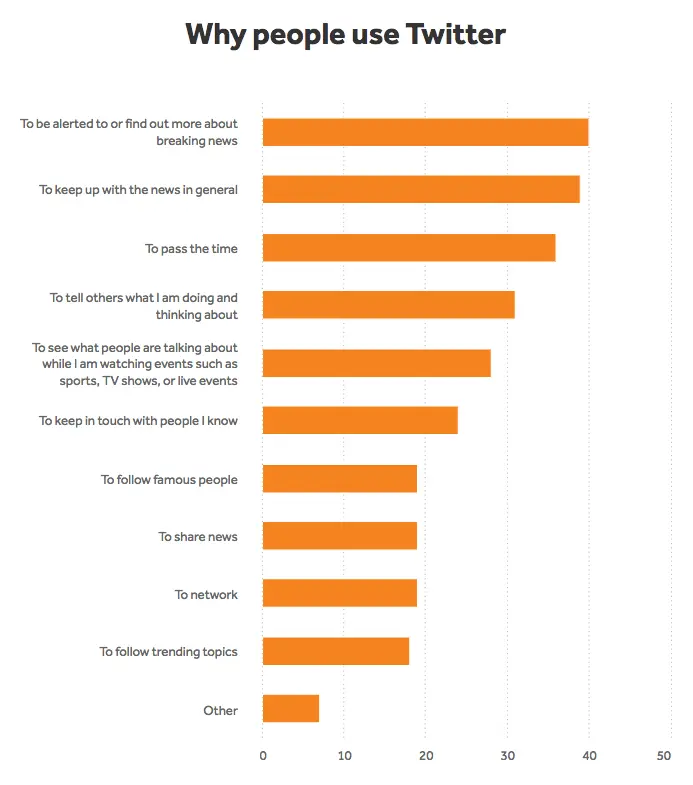
Source: Buffer
Instagram is a more visual platform and requires high-resolution photos.
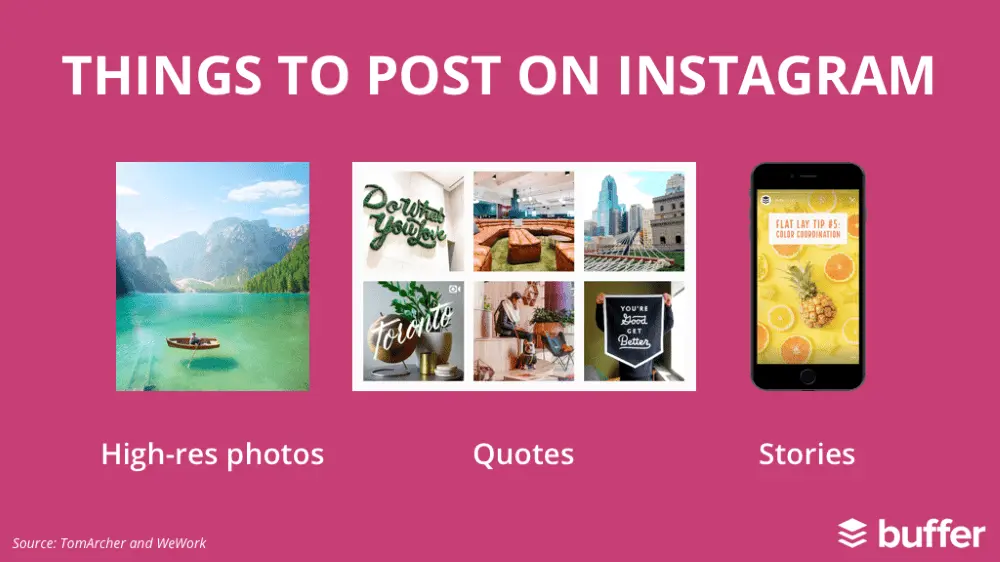
Source: Buffer
On Facebook, a recent BuzzSumo analysis found that videos have higher average engagement than images and links.
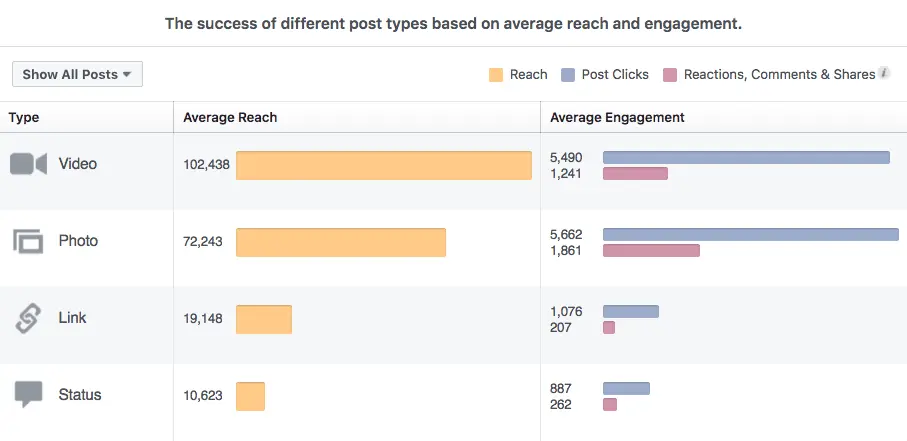
Source: Buffer
Therefore, no matter if you are a franchisor or a franchisee, you have to make sure you:
- Maintain consistent branding across all your franchises (as a franchisor).
- Maintain consistent branding across all your channels (as a franchisee).
What does this congruent brand identity actually mean? Below, you’ll find some real examples.
Communicate your value proposition in the same way across all channels—offline, online, TV, radio, direct mail or anything else. []
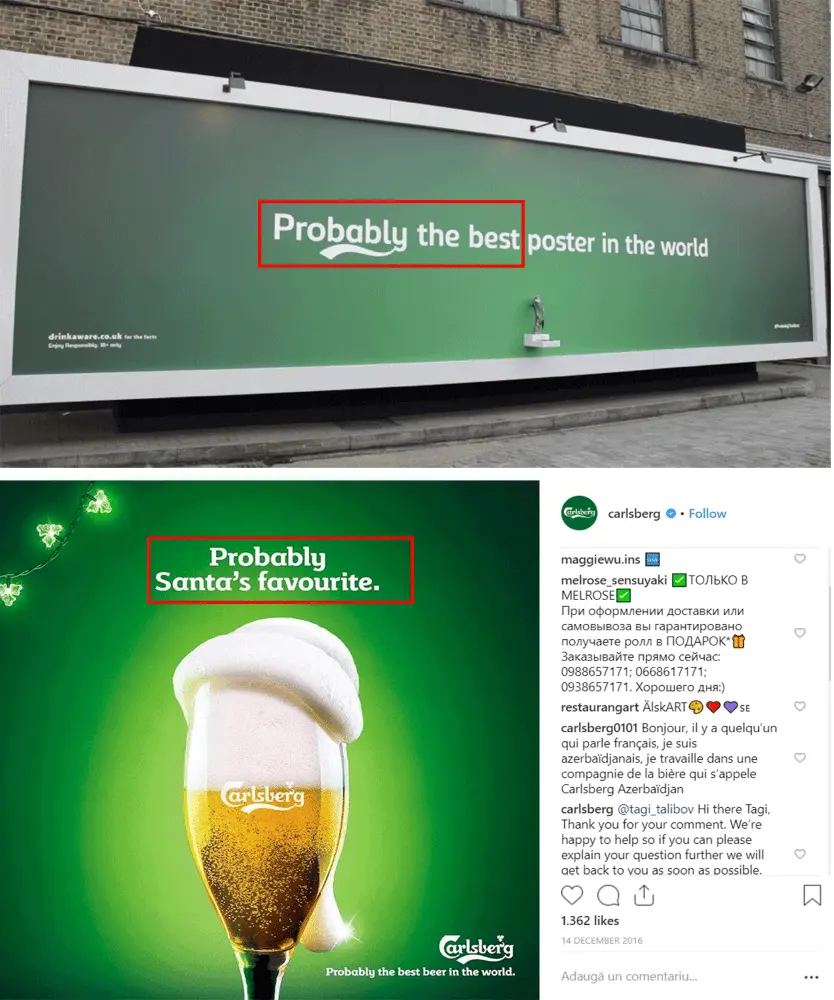
Your design (colors, logos, fonts, tone) has to be the same whether someone sees an ad on Facebook or landed on your website from a Google ad.
One of the best examples here is Coca-Cola.
As you can see, the color red is always present in one way or another. They also use the same fonts and design elements.
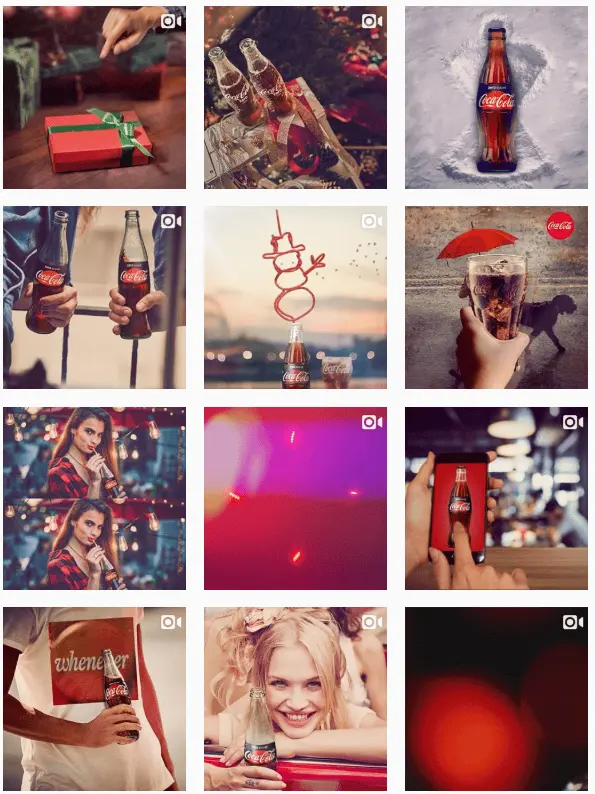
Another important element to a congruent brand identity is tone of voice.
If we continue our Coca-Cola example, we can see that almost all their posts express happiness, joy, fun, or the feeling of enjoying a great moment with friends.
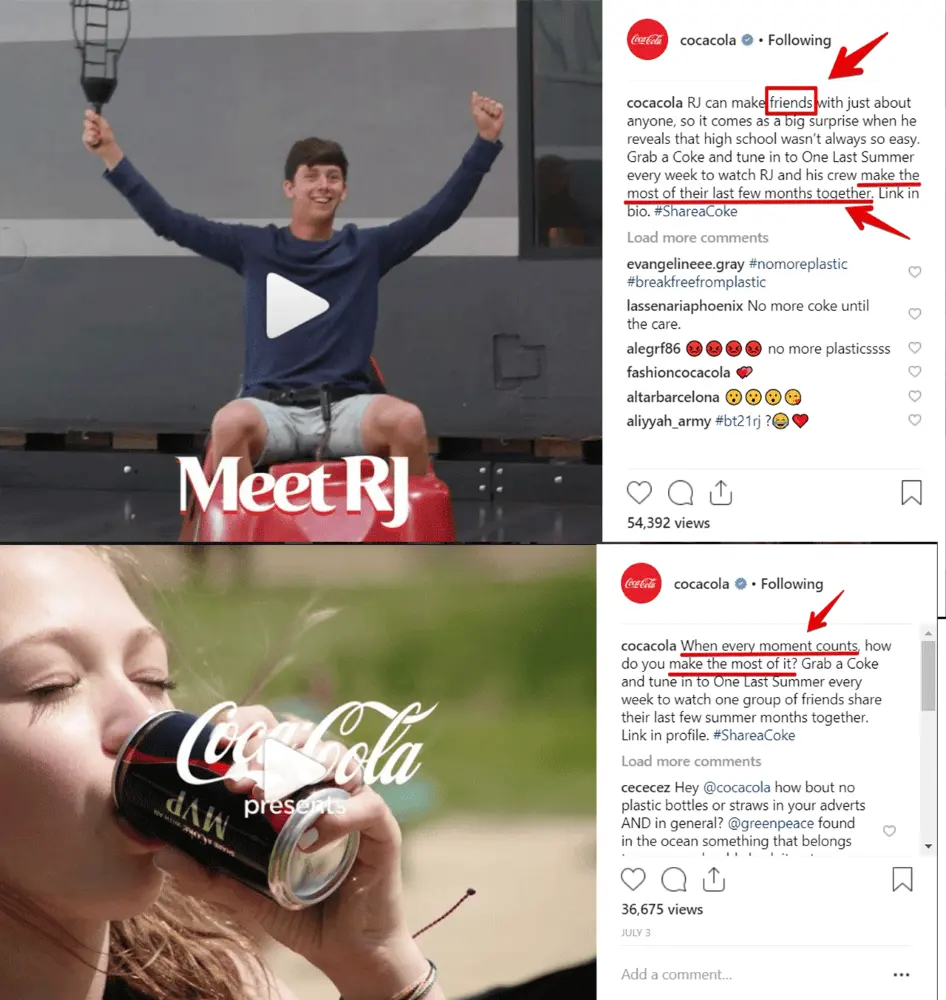
If we take another example, Charmin, you can see that whether they communicate offline or online, they maintain a playful tone.
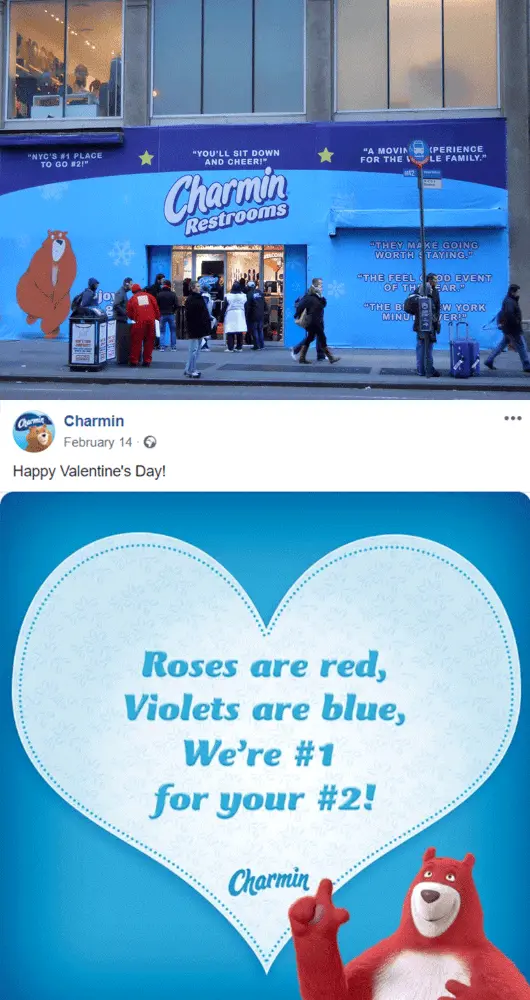
How can you make sure your franchise brand stays consistent?
First, you’ll have to create a brand manual which includes details about your tone of voice, preferred professional terms, and general code of conduct. Every business should have one, no matter their stage in the journey to perfect branding.
(We’ve handpicked some of the best brand guideline examples for you.)
Then, in order to minimize errors, you can create “best practice” templates that are in line with your brand’s ethos and aesthetic.
This ensures no one in your company has to take matters into their own hands, because they can draw on templates that reflect your brand every time they create a new document.
If you’re using Marq, you can create & customize templates to easily create stunning content without having to start from scratch every time. And because of its innovative Brand Assets feature, you can make sure everyone is using the latest version of your branding elements. Fonts, colors and logos are all pre-loaded and ready to go.
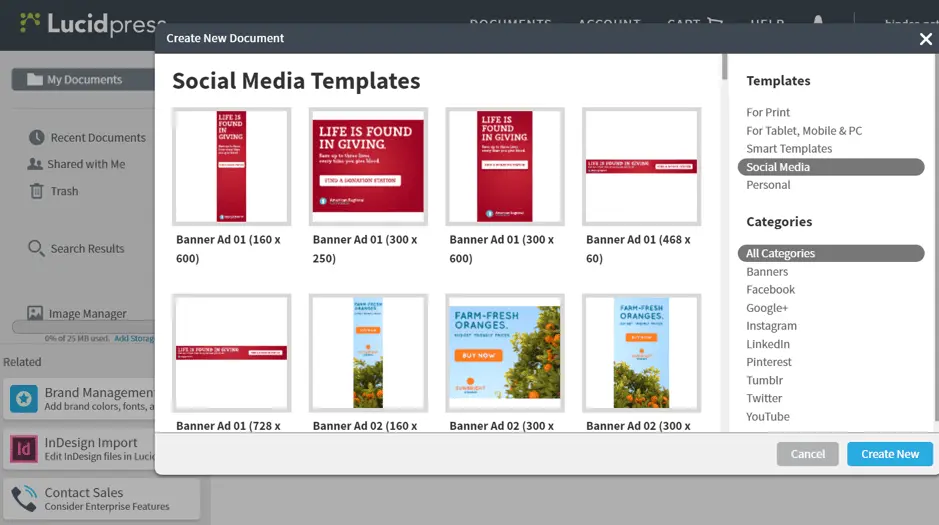
How can franchises maintain brand compliance across locations? Learn more in our free ebook, The complete guide to multi-location branding.

Before starting your efforts, make sure you can measure them
There’s an old adage that says half of the money invested in marketing is wasted. The problem is you don’t know which half.
Well, thanks to digital analytics, you can track your results so in-depth that you’d be amazed at how much leverage you have… if you measure the right things.
Here are just a couple of examples. Let’s say your marketing team developed two or three video messages for a certain audience, but you don’t know which one to choose.
It’s super easy. On Facebook, for example, you can check how much of your video was actually watched by a particular group.

If you compare it to television advertising, for example, you don’t get this level of accurate data. You can’t know whether a person left the room when the commercial started.
But, Facebook isn’t the only tool that allows you to track the results of your franchise advertising efforts.
If you run email marketing campaigns, you can see how many people opened your email and clicked on the offer inside.
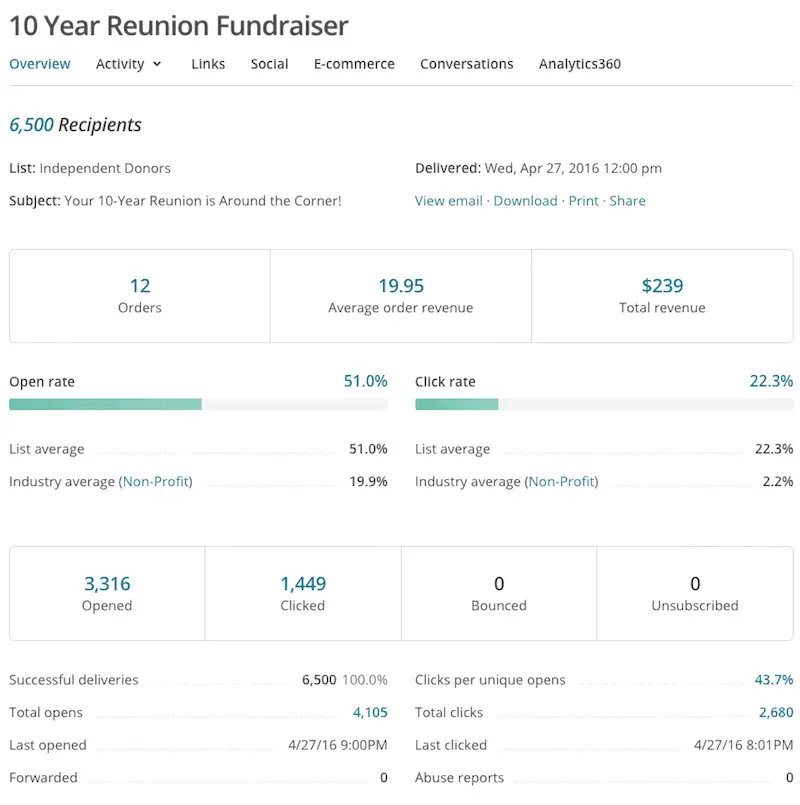
Source: MailChimp
If you run any other digital marketing campaigns, you can check Google Analytics to see how much time people spend on your website, which campaign brought in the best results, where the most traffic comes from, and much more.
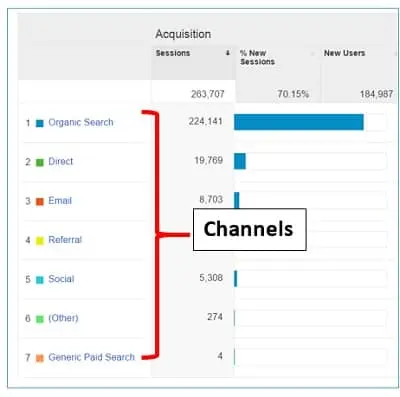
Source: Optimize Smart
Or, maybe you just bought a pizza franchise and you’re using local Google Ads. You can track how many times people called versus how much money you’ve invested and see if there’s a positive return on investment.
Ultimately, analytics don’t have to be limited to the online world. If you’re using offline marketing tactics like flyers or coupons, you can use codes to measure whether your campaign was a success.

Always keep an eye on trends
Marketing is first and foremost a battle for attention. If you don’t have people’s attention, you can’t communicate with them. If you can’t communicate, you can’t sell.
In the 50s, attention was on the newspapers, then on TV and radio.
Today, our attention is on social media. Messaging apps like Facebook Messenger are becoming more powerful.
Influencer marketing is growing, because they have people’s attention and they’ve already earned their trust.
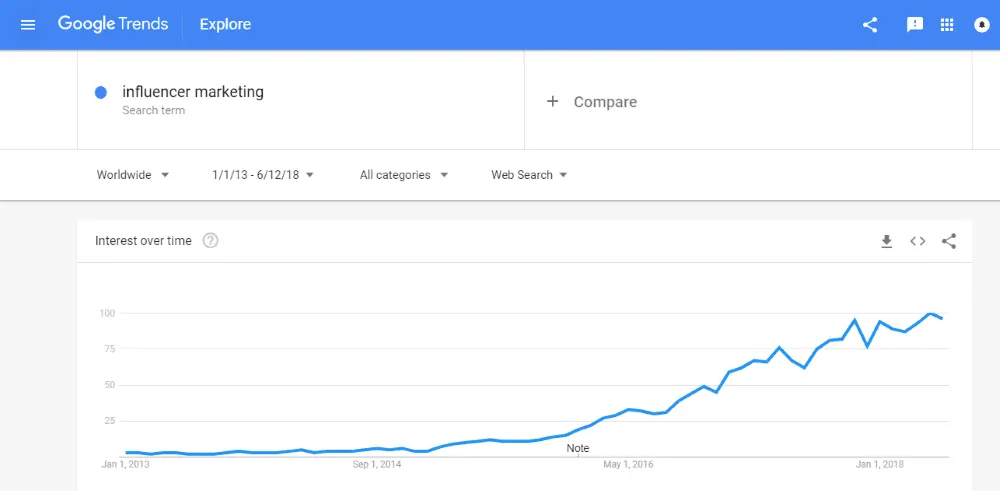
Source: Google Trends
What’s next? Voice search & marketing will have a huge impact on consumer behavior. More than 35 million Americans used a voice-activated assistant at least once a month in 2017, according to eMarketer.
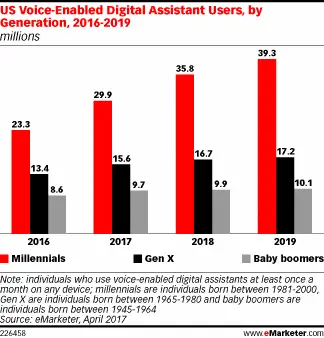
Coordinate local & national franchise marketing
There are many methods to handle franchise marketing. Sometimes, the franchisor and a corporate marketing team are wholly in charge. Other times, the franchisee takes on all marketing responsibilities. Most often, it’s a mix of the two.
It’s easy to see how this arrangement could cause confusion for your customers. But by coordinating your marketing efforts, your brand message will be strong and clear across all franchise locations.
Large-scale, national marketing campaigns
Here are some tips for coordinating large-scale marketing campaigns between the franchisor and franchisee.
Focus on the brand
In a franchise, the brand is often the selling point for customers. They know they can trust a certain brand and will support that franchise, no matter where they are. This is why it’s beneficial to focus on the overall brand image in your marketing efforts.
Provide a brand style guide
Franchisors can create a brand style guide for franchisees, to help them create on-brand materials and limit branding mistakes. It you aren’t sure how to create a brand style guide, take a look at this blog post for some killer examples.
Here at Marq, we’re pretty obsessed with staying on-brand and empowering everyone (even franchise owners who have no design experience) to create visual content. If you’re curious how Marq could streamline your franchise marketing, then check this out.
Communicate clearly & frequently
To maintain your brand image across multiple locations, communication is key. Set the precedent that there will be consistent communication regarding marketing efforts between the franchisor and franchise owners.
One area that’s often under-communicated is digital marketing strategy. The franchisor should coordinate website and social media creation with franchisees, so there aren’t multiple accounts that could confuse or misdirect customers.
Looking at these marketing strategies, the biggest factor is the brand. Build a strong brand identity that will give your franchises a good reputation, then give franchise owners the freedom to create their own marketing collateral using approved brand assets.
Small-scale, local marketing campaigns
Small-scale marketing strategies should focus on specific efforts in the local community. Franchises often have the good reputation of the larger brand, but localized marketing is what will win the community over and create a loyal fan-base.
By empowering franchisees to control their own marketing on a local level (and by giving them the tools to stay on-brand), individual franchise revenue will soar.
Here are more tips for localized, franchise-level marketing.
Find local sponsorships
Talk to local charities, sports teams or schools in the area to find opportunities to donate to a good cause and get some advertising. This is a great way to show community members that you’re invested in the area.
For example, when I was in high school, there was a Taco Time that always sponsored the school’s football and basketball teams. Their sponsorship included banners hanging up at the football field and inside the gym. They sold food at the concessions stand and had their logo printed on the game rosters. As you can imagine, my friends and I ate a lot of tacos.
This was a worthy investment for this franchisee, as it showed their support for the community and offered unique advertising opportunities. The owner of the Taco Time had a great relationship with the community and people loved going to his location.
Personalize your messages
When you’re advertising to a specific community, it’s important to personalize your messaging for your audience. Every community is different, and by catering to yours, customers will feel special and more inclined to support you.
A great example of marketing personalization is CrossFit gyms. Each gym (or “box,” in CrossFit lingo) has its own website and social media accounts that tailor their messages to the area where the gym is located. Whether it’s about the weather or events happening in the city, these gyms create a local identity for themselves that members can be part of.
Keep up-to-date
Encourage franchise owners to stay on top of trends and news as they create marketing for their franchises. Being in tune with the local news can help you spot opportunities and avoid embarrassing advertising mistakes.
Any time you post about current news or trends, make sure you do your research. An unfortunate example of this is DiGiorno. When the hashtags #whyistayed and #whyileft were trending on Twitter, DiGiorno tweeted “#whyistayed You had pizza.” The problem: these hashtags were dedicated to discussing and raising awareness of domestic abuse—an incredibly serious cause. Needless to say, many people were offended by the tweet and DiGiorno quickly apologized for its mistake.
Be where your audience is
This, of course, is one of the most important rules in marketing. No matter how clever and wonderful your marketing efforts are, if your audience doesn’t see them, then it’s a waste.
So, find out where your local audience is: Do they spend time on Facebook, Instagram or Twitter? Do they read the local newspaper? If so, that’s where you should be, too.
Be consistent with the brand
Much of the traction and business a franchise location enjoys comes from the brand name that it carries. To continue attracting and retaining that business, it’s important to stay true to the brand.
If the franchise brand is known for great customer service, then local managers have to make sure that customer service is a priority for them. Personalize each franchise to the local area, but stay true to the brand it represents. For example, maybe there’s a way to provide outstanding customer service that’s unique to your community.
A great example of this is Chick-fil-a. It’s a well-known fact that if you say “Thank you” to any Chick-fil-a employee, they will reply with “My pleasure.” Quality customer service is part of the Chick-fil-a brand, and customers can expect to receive the same level of customer service wherever they go. While each Chick-fil-a has its own concerted marketing efforts, they stay on-brand with their customer service.
Key takeaway
Marketing within a franchise can lead to miscommunication and overlap if the franchisor and franchisee do not coordinate their efforts. However, through communication and a good brand management system, your marketing efforts can complement one another and culminate in more success.
Before you start your franchise marketing strategy…
Everything starts with your ideal client in mind. From there, you decide which channels would bring you the best results, depending on your budget.
Next, you have to make sure your brand identity stays consistent across all channels—from your value proposition to your design elements.
Then, make sure you keep an eye on the latest trends in order to leverage first-mover advantages. This strategy will give your franchise business the best chance at standing out and finding success with your preferred customers.
Maintain brand consistency with Marq, the brand management platform for franchises. It’s perfect for franchise brands of any size.
Taking your brand global is an exciting prospect but also a significant challenge. Establishing and growing your brand in your own country is challenging enough, but expanding it into other parts of the world will present hurdles different from any you’ve experienced before.
Related: The brand manager’s guide to brand extension
One of the principal challenges is maintaining consistency as the brand spreads into other cultures and regions. Being consistent, though, is key to success. That’s not to say you should ignore the differences between customers in different markets—you need to meet customer needs while still keeping your brand consistent, which is easier said than done.
Maintaining a strong brand while going global requires substantial research and planning, as well as careful monitoring. Here are 6 branding tips to remember when you’re going global.
1. Establish brand guidelines
Before attempting to expand a brand globally, the company should have well-established, consistent brand guidelines. It needs to distribute these guidelines to everyone who will represent the brand in any way and ensure adherence.
What should be included in brand guidelines? They cover the overall definition of the brand, visual style and content style. That’s not to say all of these elements need to be included in the same document, but they should all be well-defined. The guideline should define the brand’s values, mission and vision statement and include a description of the key messages you want to send, as well as the brand’s personality.
These guidelines should include rules for using the company’s logos, colors, fonts and any other visual elements. They should also describe its preferred voice and tone, any words that should be used and any to be avoided. The use of these guidelines must be enforced throughout the company to keep the brand consistent. This will be of immense value, since research shows that consistent brands expect to earn 23% more revenue annually than inconsistent brands.
2. Emphasize your values
Your brand guidelines should include a description of company values, but they should be emphasized through every aspect of the global expansion. This strategy consists of both customer-facing and internal elements and will help the brand maintain its essence, even if the details of how the company operates are different in new markets.
Making sure everyone in the company understands its values is crucial to consistency. Brand values can serve as a guidepost when trying to determine whether something is on brand or not. While representations of the brands should still be subject to review, understanding brand values can help keep ideas on track in the early stages.
3. Be aware of culture & language differences
Before expanding into a new region, a company should take time to research any aspects of culture or language that may affect how their brand is perceived. The business should also conduct a legal assessment to avoid inadvertently breaking any rules or regulations.
If your company is seeking to form partnerships and make business acquaintances overseas, it’s important to have a thorough understanding of the country’s business culture. For example, in Singapore, it’s important to talk about any successes as a team effort. The interests of the group as a whole are generally put ahead of individual interests there—something you’d want to keep in mind if you were trying to create a mutually beneficial partnership.
When translating a brand into another language and culture, miscommunications are easily possible.
If a company doesn’t take sufficient precautions, it risks making a faux pas that could damage the brand. KFC fell victim to this issue when it expanded into China in the 80s. The company translated its slogan “finger-lickin’ good” to “eat your fingers off.” While KFC eventually recovered from the mistake, this slogan did not send the right message.
4. Keep it customer-focused
While you need to maintain brand consistency, you also need to ensure that you communicate your brand in a way that will resonate with the new customers you’re attempting to reach. You may need to make small adjustments to better appeal to customers in different regions, as well.
Determining what you can change to appeal to a new set of customers and what you can’t alter without sacrificing brand consistency is critical.
KFC provides us another example—but this time, in a positive way. In the 70s, KFC created a campaign in Japan called “Kentucky for Christmas” that encouraged Japanese customers to go to KFC on the holiday.
The campaign was a huge success because it capitalized on the fact that there weren’t many established Christmas traditions in the country. KFC still catered to one of the traditions that did exist in Japan, however, by including a special cake in its Christmas meal bundles.
5. Optimize your approval process
Companies should have an established approval process in place before expanding globally. This process helps employees to easily submit materials and enables company leadership to ensure brand consistency.
A complicated process can lead to off-brand materials slipping through the cracks. Once they do, these misbranded materials can spread, because people who see them will assume they’re acceptable.
Using a brand templating platform like Lucidpress can streamline the approval process, which encourages employees to get quick approval of their materials and move their projects forward.
6. Promote consistent internal communications
To orchestrate a global brand expansion, a company needs a strong internal communications system to ensure that all offices, departments and employees are on the same page.
You need a reliable communications system to inform everyone in the company of updates to branding guidelines, information about new products, details about new promotional products and more. Internal disconnect creates a risk of brand inconsistency.
Businesses should create an internal communications plan that includes information about communication objectives, target audiences, available channels and more. They must then monitor their progress to ensure that their internal communications are effective.
Also, everyone within a company who needs access to logos and other brand materials should have access to them. Using a cloud-based system like Lucidpress (through which employees can download logos from anywhere at any time) can resolve this issue seamlessly.
Key takeaway
Expanding a brand globally is, of course, no small feat. A global brand has many moving parts that all face different challenges based on their location. Despite these differences, the branding must be consistent throughout the entire company.
Achieving this kind of cohesiveness requires a well-defined brand and open communication about what the brand is to everyone in the company. That information and meaning can then be communicated effectively to customers across the globe.
Want to know more about the power of brand consistency? Download our free 32-page report, chock full of stats & great insights.
At the onset of building a business, branding might not seem like the first thing to conceptualize. Establishing the foundations of your brand by creating a brand book could be a tedious process, but its long-term benefits are well worth the effort.
Related: Branding? Follow this template for creating a brand platform
To help you get started, let’s review what a brand book is, what it does, why you should take the time to build one, and how to best go about it.
What is a brand book?
A brand book can also be called a brand bible, a brand style guide or a brand guide, among other similar terms. Essentially, it’s the document that sets distinct guidelines for maintaining brand identity across all aspects of the business.
From designers to marketers to sales teams, a brand book helps align different departments in communicating consistent messaging.
Some of the things included in a brand book are:
- logos
- color palette
- typography
- design system
- imagery
- tone of voice
Why do you need one?
One of the biggest benefits of having a brand book is that it gives the business a framework of consistency and cohesion. This consistency and cohesive messaging serve as great tools for defining your company’s personality—which, when committed to over a period of time, breeds trust. Strong, consistent brands are valuable; we know from our research that consistent brands expect to earn 23% more revenue annually.
When your audience sees that there is consistency in color scheme, tone of voice, and logo usage across all platforms, it delivers a level of professionalism that tells your customers you’re a brand they can trust.
Pros of having a brand book
As pointed out by Mayven, having a detailed brand book establishes the voice and personality of a company, governing virtually every aspect of company communication. From in-house communications to marketing messaging, having a well-made brand book ensures everyone is on the same page, consistently delivering a unified message that’s always on-brand.
Cons of not having a brand book
On the flip side, the inconsistency that easily creeps up when you don’t take the time to create a brand book can confuse and, eventually, alienate your customers.
Imagine a coworker who’s always well put-together: perfectly ironed shirt, neat haircut, clean shoes. Now imagine if, out of nowhere, that same person came to work with unkempt hair, ripped jeans and a neck tattoo. You’ll inevitably feel uncomfortable because it’s just not something you’re used to from that person. Chances are, you’ll be wondering if everything was okay with that coworker or if there’s some inner turmoil going on.
Essentially, the same instinct applies to brands and the way they present themselves to their audiences. You don’t want to confuse your audience with mixed messages.
How to create a brand book: Setting up the brand
Before you create a brand book that guides all aspects of the business, you need to envision what you want the brand to be. This means understanding four key components: the brand’s mission, its vision (which includes core values), target audience and brand persona.
Mission
When you’re crafting your brand mission statement, don’t fall into the trap of stringing together buzzwords that merely result in empty concepts and vague statements. As noted by Branding Strategy Insider, settling for a mission statement of that ilk does little to guide the company or employees toward having and maintaining a competitive edge. On top of that, it doesn’t provide motivation or a daily mission to make each workday matter.
Instead of vague concepts, your mission statement should clearly establish:
- your company’s purpose
- its reason for existing
- the difference it strives to make in the world
Establishing these does a number of things for your business: it immediately helps employees figure out whether they fit what the company wants to be, it creates strong brand differentiation from competition, and it inspires consumer passion and engagement.
Vision
As noted by Goalcast, a strong vision statement will serve as a guiding force for all of your business decisions. It’s a virtual compass that points the company towards where it wants to be and what it wants to become.
To help craft your vision statement, you can ask questions like:
- How big do you want your company to get?
- Do you plan to branch out with products and services not currently offered?
- What kind of legacy do you want your business to leave behind?
Paired together, your mission and vision statements serve as important start and stop points—tools that will guide you as you make strategic business decisions that refine your brand.
Brand persona
Establishing a brand personality is a key element in setting the tone for your brand messaging across all communication channels. Mixed messages make it harder for customers to connect and identify with your brand.
One age-old practice is thinking about what kind of person your brand would be. Do you want your brand to be straightforward and to-the-point? Or would you rather it be playful and witty?
There’s also the old is/is not exercise. This involves listing three to five adjectives that your brand is and three to five adjectives that it is not.
Whatever collection of traits you decide to incorporate into your brand persona, it’s best to turn those into a statement that guides your overall messaging.
Lucidpress—a brand templating platform—uses this:
Lucidpress is the intuitive brand templating platform that empowers anyone to easily create on-brand materials.
In this statement, you can see a number of descriptive branding words:
- intuitive
- empowering
- easily
- on-brand
These traits drive our messaging and many other branding decisions, from how our software should feel to who would benefit from using our platform. Speaking of which…
Target audience
Just as you need to understand your brand, it’s likewise important to understand your target market. What types of people do you want using your products? Which ones do you want to visit your website, consume your content or subscribe to your emails?
To identify your audience, you need to have a solid understanding of what their needs, wants and values are—and how you factor into all of those.
The process of identifying and understanding your target market allows you to narrow down your audience focus. Your messages are always tailored to your audience, and it gives you a clear picture of what you need to be for a specific group of people.
How to create a brand book: Visual guidelines
Logo usage
Coming up with a distinct, identifiable logo is one thing. Ensuring that it remains optimized in different environments is another. This part of your brand book should include all approved versions of your logo and how it will be used in different platforms, from placement to acceptable alterations.
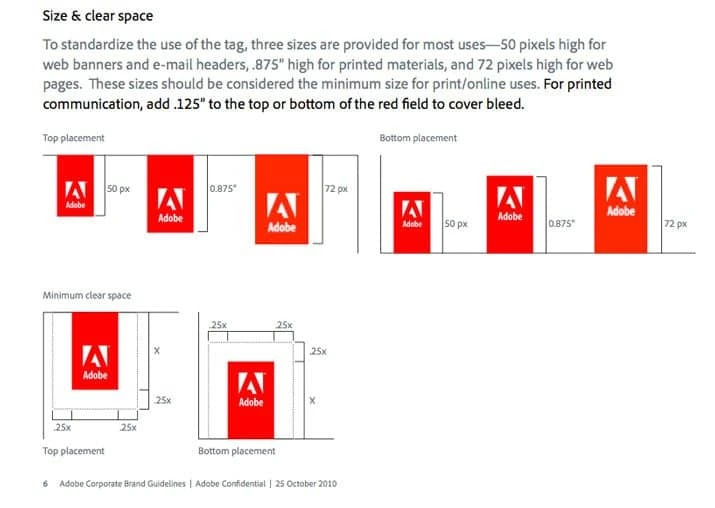
Source: Design Shack
As you can see with Adobe’s brand guidelines, it’s very clear how the logo should be used, including its placement, size and white space.
Color palette
Your brand’s color palette is another element that gives your business a consistent look and feel. Most brands choose four or fewer main colors that don’t stray too far from the hues of their logo. As you can see with Heineken’s color palette, they picked one light color for backgrounds, a darker color for text, a neutral hue, and one that gives design elements a bit of pop.
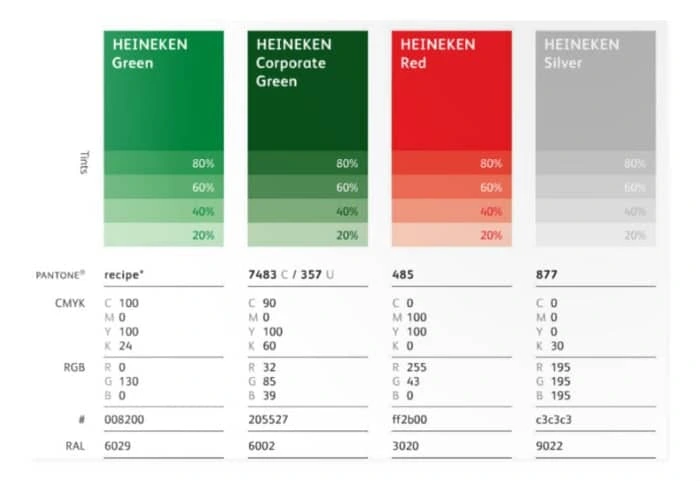
Source: 99designs
And just as it is with your logo, you need to outline how and when each color should be used (Which ones are for text and design elements? Which are for the logo, and which are for backgrounds?). Mayven also points out that you should define the following:
- color names
- color values (CMYK for print, RGB & HEX codes for digital, and PANTONE name & number)
- primary, secondary & alternate colors
Typography
Similarly, there should be a defined font style for both print & digital applications. In your brand book, typography should cover how and when certain fonts are used, which typefaces are acceptable, as well as guidelines for additional styling, size, and use of color.
As pointed out by Mayven, most brands use one or two primary typefaces, a complementary typeface, and substitute typefaces.
Tone of voice
As with all the other elements on this list, your tone of voice needs to be consistent across all communication channels—email, social media, press releases, blog posts, ads, etc. Your voice should be aligned with your brand’s persona, mission, vision, values and target audience.
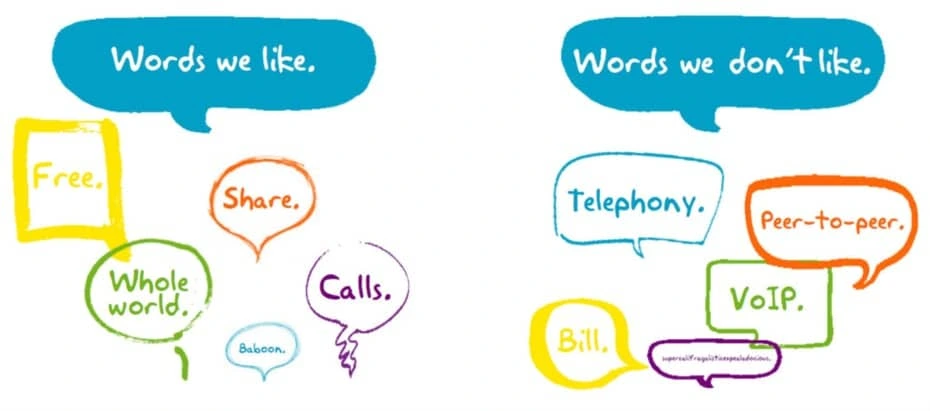
Source: 99designs
You can start by identifying words you like and don’t like to be associated with. Then, decide what type of language fits your brand persona and your target audience. Go back to your list of adjectives describing your brand personality to come up with language that is on-brand.
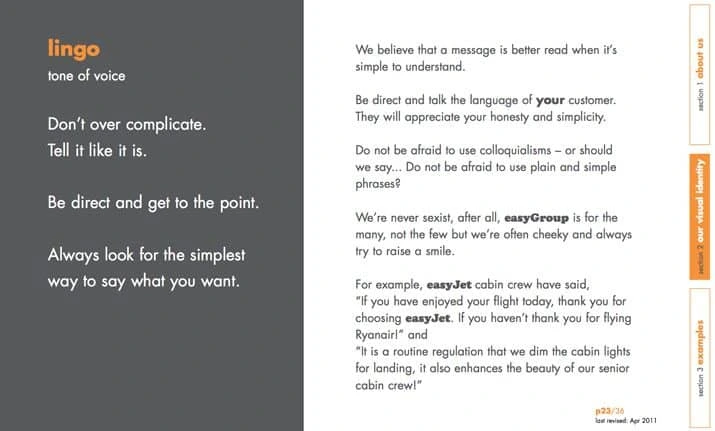
Source: Design Shack
Imagery
Apart from indicating whether you’ll be using photos, illustrations and other types of graphics (as well as when and how you’ll be using them), your brand book should also detail how images will be edited, which colors to place them with, and any other design elements related to image use.
Collect inspiration from successful brands, particularly those that have similar brand messaging as yours. You can also create a mood board with images that convey the feelings you want people to get when they interact with your brand.
Key takeaway
A thoughtfully crafted brand book will bring your business consistency, alignment and cohesion. To avoid confusion, your brand book needs to be detailed, covering all possible bases to ensure everyone’s on the same page. It will give every employee in the company a concrete framework to work with, while still giving them the freedom to do what they do best.
Running a business, in any capacity, takes hard work and perseverance. Specifically, though, for a franchise, there’s a whole different set of unique challenges for both franchisors and franchisees.
The primary challenge comes down to providing a consistent experience. It’s simple: A franchise must provide a consistent brand experience across each of its locations.
Related: Franchise development—what you need to know
What’s not so simple is ensuring that every part of operations is being done the same way. How can you ensure that brand messaging and logos are easily accessible and up-to-date, or that the service is as good as it should be at every single one of your locations?
This article should provide you with a start on how to achieve brand consistency in your franchise.
Make sure franchisees know the importance of reputation management
Let’s first discuss your online brand image. This directly affects how customers feel about your brand.
A positive reputation is something that’s hard to get back once it’s ruined. There are a variety of different platforms in which customers can communicate with other customers about your brand including Yelp, Google, and other forms of social media.
Chris Conner, president of Franchise Marketing Systems, advises, “Right from the initial training with the franchisee, the franchisor should be educating and informing franchisees how brand management and reputation management are important and part of their operational responsibilities in running the franchised business.”
Conner adds: “Once a franchisee is operating and running day-to-day, the franchisor should have regularly scheduled calls with franchisees where reputation management is part of that discussion and addressed in each interaction.”
“Franchisors who are able to grow their networks effectively typically have incredibly strong and consistent mechanisms in place to monitor, respond and execute brand management responsibilities,” he concludes.
Maintain digital consistency
In order to maintain consistency where franchisees communicate with customers online, you need a clear-cut digital marketing plan. The plan should include guidelines for how franchisees communicate via social media, blogs, emails and webpages. Make sure you provide franchisees with easy access to logos, font style, imagery & photos, brand tone and language.
Social media is an integral part of our daily lives. Each location should have a separate Facebook and Yelp page so customers can visit locations and leave reviews. Whether each location needs a separate Twitter, Snapchat, LinkedIn, Google+ or Instagram account is truly dependent on the brand.
Create a detailed social media policy answering questions like: What type of content should be posted—and what should not be posted? How should complaints and negative reviews be dealt with? You can streamline social media with a process to approve anything that goes out, create templates, or offer pre-approved content. That way, you don’t have to micromanage content for too many locations.
Let your franchisees know what your brand is
Franchisors need to feel confident about the brand before communicating what that brand is to franchisees. This encompasses everything from company-wide goals to how everyday operations are run.
Ask yourself the following questions, and once you’re confident in your responses, make sure your franchisees know it, too.
What is the brand?
Your brand includes the characteristics of your company that make it relatable to people. For example, popular sandwich franchise Subway is a casual, no-frills restaurant where customers can expect consistent, fast service with fresh ingredients.
What is the company’s mission? What are its values and goals?
Subway strives to serve fresh, delicious sandwiches that are made-to-order right in front of the customer. The team at Subway lists out three core values and principles on their website.
- “Always provide exceptional service to your valued guests.”
- “Provide the highest quality menu items at a price everyone can afford and enjoy.”
- “Keep operating costs low and ensure you have great systems in place and never stop improving.”
What story do you want to tell?
Subway offers healthy sandwiches at convenient locations around the world. Subway shows their customers that they have nutritional & community responsibility by “building stronger societies,” according to the company.
Who is buying your product or service? How do you market to them?
Today, it’s easier to understand who your customers are and what they’re looking for. According to customer identity company Signal, personalization is an important part of marketing for brands. When it comes to franchises, that means being able to speak to people in different markets on a personal level. For example, franchises can offer personalized online communication experiences (e.g. paid advertising, personalized emails, etc.).
Don’t forget the details
It might be obvious, but staying consistent in a franchise is about every little detail.
Gary Findley, CEO at Restoration1 and established franchise sales expert, writes that consistency is the most important factor when it comes to business success.
He writes, “Balancing brand uniformity while respecting franchisee independence and regulating brand messages while effectively targeting local communities are two of the struggles that often arise.”
To help achieve this balance, there needs to be a consistent aesthetic, product & experience at each location.
- Aesthetics. From the color of paint on the wall to the uniform staff is wearing, there should be consistency to how a business looks and feels. If you walk into a Subway in the state of New York, chances are it’s going to look the same as in Colorado, Washington and anywhere else.
- Product. If people are seeking one of your locations, it’s because they crave that same product they know and love. People don’t go to Subway because they want a local sandwich. They go to Subway because they crave the taste they’re familiar with.
- Experience. Just as customers want the same product or service they can find at all of your locations, the same is true for the experience. Experience encompasses everything—the music playing in the background, the seating, how to place an order or make a purchase, and the behavior of the employees. Employees have to be trained consistently on daily operations, including how to interact with customers, how involved they are, and how to handle complaints. For example, if a few locations are taking too long to prepare food—and your brand is known for speed—that will be a problem for your customers.
- Marketing. Each franchise needs to be consistent with how they market and who they market to. Determining which types of marketing campaigns & advertising techniques work best for your brand is the first step in implementing consistent franchise marketing. This includes having specific brand guidelines for your franchise and what you want your franchise to look like.
Strengthen franchisor / franchisee communication
Determining how each franchisee should operate and what brand consistency looks like is only half the battle. The real challenge comes in longevity: making it last. To build long-lasting marketing and operations, use the following process.
- Set clear expectations. Whenever a new franchisee opens a location, hold a thorough training where franchisees gain an understanding of your expectations. Outline everything in a manual to reinforce the goals. This includes everything from hiring procedures to aesthetics.
- Illustrate why this is important. Don’t just leave instructions on how to do things, but be sure franchisees understand the reasoning behind it. Staying consistent is going to create customer loyalty, brand recognition, and ultimately, a more successful business. Explaining the benefits will encourage everyone to stay on target.
- Communicate regularly. Plan to talk as much as necessary to succeed. Offer positive feedback when you see a franchisee doing things right, and of course, provide constructive criticism and encouragement when things need to get back on track.
Key takeaway
It can be difficult for a franchisor to maintain consistency across marketing and operations within a franchise… while also targeting local customers in different communities. Don’t give up on making your franchise marketing consistent.
For the best results, make sure franchisees know the importance of reputation management. Stay consistent with messaging across digital platforms, educate franchisees about your brand, pay attention to the details, and keep the lines of communication open.
Give your new franchisees a head start with our free ebook: The franchise owner’s field guide to success
Attracting a steady stream of new customers is one thing, but building customer loyalty is integral to a brand’s long-term success. And it begins with making a good first impression.
Think about it: when looking up a brand online, what do you remember about the ones that stand out? More than likely, it’s their logo or their overall style—like meeting a person wearing a great suit. When you run across that brand again, that image can stick with you—more so if you keep on seeing it in different places. This is a brand’s visual identity, and it’s what you want potential customers to remember.
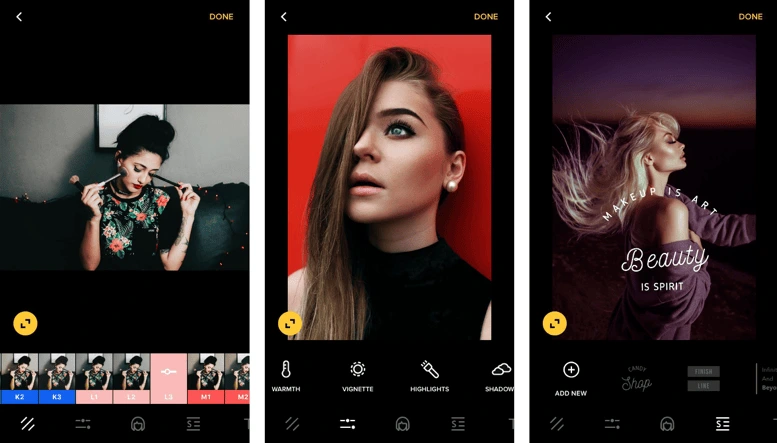
Related: 6 Instagram post ideas to boost sales
Having a memorable visual identity is important for social media, now a standard tool in the digital marketer’s arsenal. Instagram in particular is a powerhouse for using visual content to promote products and services, with Instagram stats showing 71% of U.S. businesses have an Instagram profile (25 million business profiles total). Standing out and earning engagement and followers depends on how well-defined your visual identity is. Here’s how to do it.
1. Know your brand inside and out
Before you create a visual identity, you need an actual identity first. Know the key aspects of your brand you want to communicate to your audience, then translate them into a visual medium. []
Essentials for this step are copies (in writing!) of your brand’s mission, vision and values. These should be easily accessible on both your official website and any internal marketing documents. When you have them, answer the following questions to figure out what you’ll need to base your visuals on.
- Why was my brand made?
- What does my brand value the most?
- What words would I use to describe my brand?
- What does my brand offer in terms of products, service and experience that others do not?
- What kind of people do I want my customers to be?
Using your answers to the questions above, you can isolate a set of keywords closely associated with your brand.
2. Create a set of branding guidelines for social media
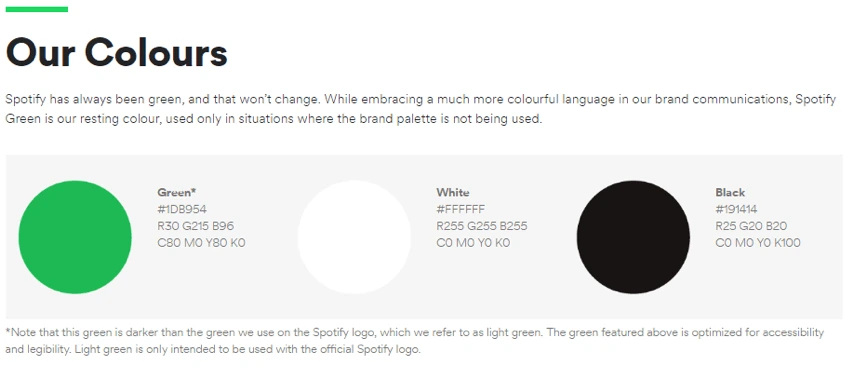
Source: Spotify
Do not underestimate the logistical power of good documentation. Brand guidelines enforce consistency in your branding, graphic design and marketing—keeping everything together so that everyone is on the same page when it comes to how to visually present your brand.
While it does take time and effort to create, having all these details in one place saves more time in the long run. It’s also a mark of professionalism: no having to go back and forth, emailing each other files and instructions every time you design something new.
Looking at some great branding examples, here’s what to include in your brand guidelines:
- The theme of your brand
- The feel and philosophy of your company
- Relevant taglines
- Font styles & typefaces to use
- Acceptable ways to use your brand logo, including its size & placement
- Color palette to use when associating with the brand
- Guidelines on composing imagery
3. Make social media post templates
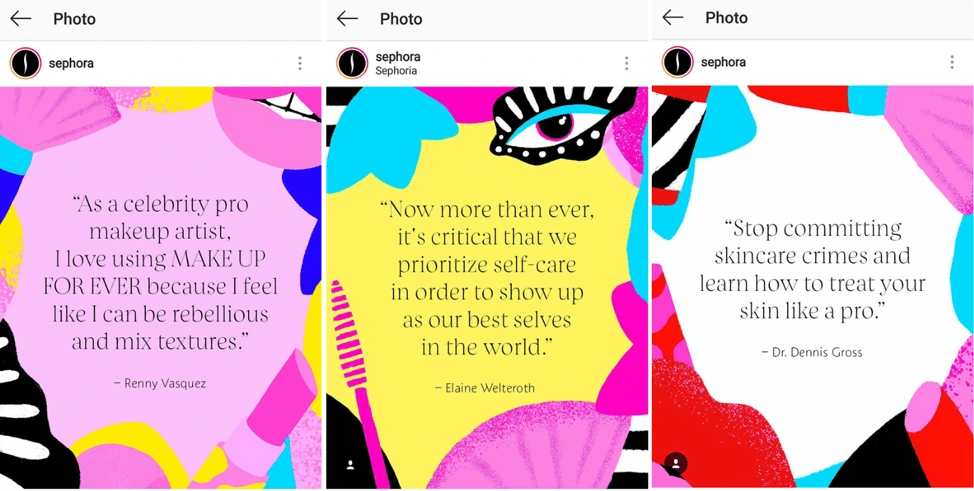
Source: Sephora
If you want to be remembered for a certain color or type of imagery, or if you want your logo to be visible on the feed and not just in your profile photo, turn to Instagram post templates. Some examples are backgrounds for text posts or borders to place around photos. They might include your logo, brand name or slogan and should be used when appropriate—not all the time, but just enough to be noticed.
You can use these templates when you share some of your favorite quotes to Instagram, which can make an otherwise plain text post look interesting. You can also place template borders on user-generated content that you’d like to share on your profile—especially useful if you’re running an Instagram giveaway or photo contest using a particular hashtag that can be incorporated into the template.
Remember to mix it up once in a while as well. While you want it to be memorable through retention, you don’t want it becoming stale. Try mixing it up every month or two and changing it according to season or campaign.
4. Have a consistent photo-editing style
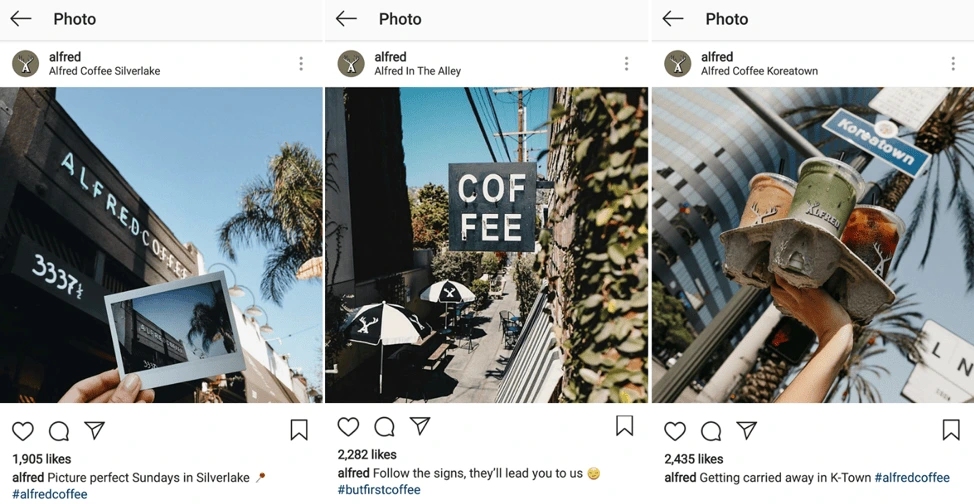
Source: Alfred
Once you’ve identified the feel of your brand and the colors you associate it with, fold that into the way you edit photos. Color has long been known to be a powerful force in marketing, and by post-processing images before you post them online, you can influence what they convey.
Use a similar editing style with your pictures so they all communicate your message—and slowly, users will connect that feeling to your brand. Away from your computer and need something quick? For extensive editing on the go, download a reliable photo application like Instasize to your mobile phone.
5. Do social media right
Last but definitely not least, make the effort to use Instagram right.
What does this mean? No matter the amount of content you share, and no matter how elaborate your photo editing is for each image, your efforts won’t matter if you don’t make use of the rest of the platform. Instagram has boomed—and so has its features.
One of the biggest don’ts of Instagram right now is to post strictly to the feed only. Instagram also has Stories and IGTV, the former of which can be an informal way to connect with your customers, while the latter gives space for long-form videos that followers would otherwise miss.
Of course, don’t let all your efforts towards keeping your visual identity end with social media. After all, using Instagram is just one step in the marketing funnel. Creative consistency builds trust, showcases reliability and improves customer perception—especially in visual branding. Keep your branding consistent across touchpoints before, during and after purchase, and you’ll be crafting a brand story customers won’t forget any time soon.
Want to know more about the power of brand consistency? Download our free 32-page report, chock full of stats & great insights.
The more appealing a proposal is, the more likely you’ll be to win the job. Seems simple enough, doesn’t it?
But, creating proposals that are professional, detailed, attractive and on-brand isn’t easy. Especially when you’re trying to do it quickly.
Related: How to create engaging assets for your sales team
The good news is that proposal management software can help you speed up and improve the process.
In this post, we’re going to look at 5 tools that can help you, as well as explore the benefits and key features of proposal software.
The benefits of proposal management software
Central location
Store everything in one central, cloud-based location and access it from anywhere you get online. Assign access to multiple team members as necessary and collaborate in real time.
Act quickly
With templates and automation, creating proposals is much faster. Generate pitches, proposals and presentations quickly and simply, and make the most of opportunities as they happen.
Streamline the entire process
When you can create, collaborate on, approve and distribute your proposals in one neat system, it removes the need for complicated processes that use multiple pieces of software.
Notable features of proposal management software
Searching for proposal management software can be overwhelming. There are so many options on the market, each with varying features.
To help you make the right choice, consider the 4 elements below and decide which would be most beneficial for your situation.
1. Branded templates & pre-filled forms
Proposal creation takes time, but with ready-made templates and automation that allows you to pre-fill forms, the sales process will move much faster.
Even the most basic proposal automation software should carry this feature, but it’s the extras—like being able to brand and fully customize the templates—that will give you that professional edge.
2. Mobile-ready
If your sales team spends a lot of time in the field, proposal generator software that works on mobile devices could quickly put you ahead.
When a sales rep can input key information while on the road, at a meeting or on-site, a professional proposal can be turned around in days rather than weeks.
Also, being able to give on-the-spot estimates straight from a handheld device means the conversation can progress more quickly. If this is important to you, you might want to consider software that can integrate with or replace your CPQ (computer pricing quote software).
3. Customer relationship management
From the minute an RFP starts to form, a CRM process should be initiated for tracking purposes. The better your sales team is at nurturing leads and following up after proposals have been sent, the higher your chances of success.
Proposal automation software that comes with CRM features will empower your sales team to make the most of every opportunity.
4. Smart reporting
Where time and money are being put into drawing up proposals, the return on investment should be measured. The better you get at analyzing the data, the more refinements you’ll be able to make to your sales process.
Some proposal automation software will come with built-in reporting tools, though this could just as easily be managed with a spreadsheet. Software might offer an expanse of reports, but it needs to be easy to learn. If it’s overly complicated, it won’t be as effective as it could be.
5 proposal automation & management tools
To find the right proposal generation software for you, you’ll need to weigh up your requirements against the features on offer.
Consider the 4 elements we’ve listed above as well as any other functionality you’re looking for. Do any of the following proposal management tools seem to offer the ideal solution?
1. Bidsketch

Bidsketch allows you to make customized proposals using saved sections that can be combined to build a full document.
Features include:
- Templates & reusable content
- Optional fees (for upselling additional services)
- Client landing pages
- Automation & workflows
- Electronic signatures
- Analytics
2. Nusii

Proposal management software Nusii lets you personalize templates and track the proposal process.
Features include:
- Proposal notifications
- Unique branding, domain & email
- Reusable content
- Reporting
3. RFPIO

Compared with the proposal management tools we’ve looked at so far, RFPIO is more advanced. It’s likely to be a better fit for larger organizations with a lot of activity.
Features include:
- Import & export data
- Answer library
- Intake forms
- Project management
- Collaboration & commenting
- Recommendation engine
- Integrations
4. PandaDoc

PandaDoc handles proposals, quotes and contracts. It also integrates with popular CRMs like HubSpot and Salesforce.
Features include:
- Templates
- Content library
- Brand customization
- Electronic signatures
- Pricing tables
- Collaboration & commenting
5. Lucidpress

Lucidpress is a brand templating platform for businesses that want to align sales & marketing and manage brand consistency, while also empowering their people to customize materials quickly.
Its features include:
- Fully customizable proposal templates
- The ability to lock elements within a template (e.g. fonts, colors, logos)
- Smart fields for pre-filling data like names & contact details
- Automatic data population
- A central storage location
- Real-time collaboration
- Instant digital sharing
- In-app printing & mailing
Using Lucidpress to create on-brand proposals
Of course, we have a favorite. With Lucidpress, it’s easy to create quick proposals that are on-brand.
Put another way, Lucidpress is a design platform with brand management capabilities. It’s a tool for designing sales & marketing materials, with plenty of additional features that make brand consistency achievable.
The benefits of Lucidpress include:
- One central storage system that’s cloud-based, meaning it can be accessed from anywhere.
- An intuitive design tool where templates can be created from scratch or imported from InDesign.
- Templates where key elements (such as logos, brandmarks & crucial text) are locked in.
- Document automation, to save time on tedious tasks like importing data or filling out frequently used information.
- Customization options that allow team members to personalize templates as needed.
- Easy distribution via instant online sharing or an in-app printing & shipping service.
How to create proposals in Lucidpress
To give Lucidpress a try for creating and automating proposal generation, follow the short guide below.
1. Design the template
Build a template from scratch (or import from InDesign) using the intuitive drag-and-drop design tool. Customize it completely to mirror other assets and keep your proposals on brand.
(Not sure where to start? Check out our library of proposal templates for inspiration.)
2. Add smart fields
Reduce admin time with smart fields in Lucidpress. Use them to auto-populate your proposal template with things like names, email addresses and contact details.
When a sales representative begins to customize your template, it’ll auto-fill with their details.
3. Lock brand elements
Before you make your template available to others, though, you should lock in the crucial elements.
Fix logos, brand names, and essential elements in place to maintain control over the brand and the way the document is structured.
4. Empower your team to customize
Next, make the template available to colleagues. Give them access to the central document store in Lucidpress.
Teach them how to customize the template so they can generate professional, on-brand proposals in minutes.
5. Distribute to potential clients
Use Lucidpress to share proposals instantly online, or to order & deliver printed versions. It offers a number of digital and print-ready file formats, so you can share documents with anyone anywhere.
Key takeaways
The primary benefits of proposal automation software include:
- central storage
- a streamlined process
- the ability to work faster
There are hundreds of proposal automation tools on the market. Before you invest, you need to understand which features are most important to you.
Lucidpress can help you protect your brand and align sales & marketing content. With lockable proposal templates that are stored centrally and easily customized by sales reps, you can streamline and speed up your proposal process.
When it comes to reaching your customers, one channel simply doesn’t cut it anymore. Consumers are researching brands through search, mobile, email, social media, in-store and a lot more, so it’s necessary for you to build an omnichannel marketing strategy that engages them across all platforms.
What is omnichannel marketing?
Omnichannel marketing is an extension of multichannel marketing. While multichannel marketing focuses on distributing content across various print and digital channels, omnichannel marketing focuses on creating a cohesive experience as a visitor moves from one channel to the next.
Benefits of omnichannel marketing
Not convinced? Here are more reasons to incorporate omnichannel marketing, both online and off, in your marketing plan.
1. Repetition reinforces your brand message
Imagine this:
A consumer sees an ad for your product on Facebook. She clicks it to visit your site but doesn’t make a purchase. She signs up for your emails while she’s there and clicks to follow your brand on Instagram.
In a few days, she gets an email inviting her to save 20% if she signs up for your text messages, so she does. Once she gets that offer via text, she makes her first purchase.
As you can see, the path to a sale isn’t always a straight line. If it had been, this person would have made a purchase at the first point of contact when she saw your ad. But, it took a few different messages on multiple channels to convince her to buy from you.
Being where your customers are online means you drive your marketing message home.
2. Creative consistency is key
You can’t simply plaster your message across a dozen marketing channels; you also have to be consistent in what you communicate. That means your brand logo and tone of voice need to be the same everywhere so that consumers recognize your brand and can let that message seep in.
There is one caveat: You don’t want to give identical offers or promotions on all marketing channels—it dilutes their effectiveness. You need to give people a reason to sign up for your emails, subscribe to text messages and follow you on social media, so make each offer exclusive to that channel.
3. All channels should lead back to your website
If you worry about confusing people with so many marketing channels, keep in mind your end goal: driving traffic back to your website so you can make a sale if you sell online. Your social media updates should include a link to the product that you’re promoting. Your emails should contain one link and one call-to-action each so that customers know exactly what you want them to do. Online ads should link back to your site.
The great thing about omnichannel marketing is that it’s so easily tracked, both online and off. You can look at your website analytics to see which channels sent traffic to your site and step up your investment on those channels or pull back from ones that aren’t getting results.
Offline, you can measure redemption of text message offers or coupons you post on coupon sites by using unique offer codes that you track through your point-of-sale system.
When you know what’s driving traffic and sales, you can tweak your marketing plan to give even better results with channels and types of offers that are appealing to your customers.
4. It’s great for new businesses
Omnichannel marketing isn’t just for well-established retail brands with giant marketing budgets. If you’re a new business, spreading the love across marketing channels can establish a foothold for your brand identity.
You may even get to know your customers better as you pay attention to how they respond to your messages on different marketing channels. Let’s say you start using Instagram to market your product, which is geared toward baby boomers. You might quickly learn that not many boomers use Instagram, and branded content targeting this demographic on Facebook gets you much better engagement.
5. You can reach different customer segments
You may market to different types of customers, who more than likely have different habits when it comes to interacting with brands online. The more channels you use to reach these disparate groups, the more successful you will be.
You can reach Gen Z through mobile and Gen X through social media at the same time. You can help boomers find you with print or online ads. You can appeal to moms, teens and outdoor types… all through slightly different marketing strategies that don’t exclude the others.
The more granular you are in marketing directly to a slice of a customer segment, the more successful you will be, because they feel like you are speaking directly to them with your message.
6. You get instant results
A few years ago, when print coupons were more popular, it would take you months to know whether a coupon campaign was successful or not. The same went for print advertising or TV spots.
But now, digital marketing has revolutionized the way we launch, modify and analyze marketing campaigns. You can see the results of your efforts in real time. If, after a few days, your social media ad isn’t moving the needle, you can easily modify the copy or the offer to see if you can improve results.
Mobile coupons are great for instant analysis, too. Your mobile marketing dashboard will inform you how many redemptions a given offer has had. You can use that data to decide whether you want to offer something similar in the future or test out a different offer.
The instantaneous benefit applies to connecting with customers in real time, too. If someone has a question about your brand, they can ask it on your Facebook page’s Messenger. You (or your handy chatbot) can answer the question immediately, delighting the customer with your prompt response.
7. You can build loyalty
One of the best ways to boost your business is by creating a loyalty program that encourages customers to shop with you more to earn points they can use on free products or get personalized discounts.
Omnichannel marketing works well with loyalty programs: Shoppers can sign up in seconds at the point-of-sale using their mobile wallet, get offers via push notifications or email, and check their balance online or on their phones.
Key takeaway
Marketing has certainly changed over the years. The key is rolling with those changes and diversifying where you try to connect with your audience. With so many wonderful channels to do so, you can customize your approach to maximize results.
Want to learn more about the power of consistent brand marketing? Download our free 32-page report, chock full of stats & great insights.
Starting a real estate business is an exciting step in any real estate agent’s career. However rewarding running your own real estate business may be, though, it’s not without its difficulties. Starting your new small business on the right foot will offer you a solid foundation to build upon and put you ahead of the game.
Related: Guide to an effective real estate listing marketing strategy
In this article, we’ll provide vital tips on how to expertly start your real estate business and set yourself up for success.
1. Complete requirements to become an agent
If you’re not already an active real estate agent, you will have to meet some requirements to become one. Start by following the qualifications to obtain a real estate license in your state. Your local real estate bureau will be able to provide you the information you will need. Also bear in mind, you may be required to work for a brokerage the first few years after obtaining your license. If you want to use the term REALTOR®, you will also need to join the National Association of Realtors. Members of NAR enjoy many benefits including access to their MLS and content and trainings relevant to the real estate industry.
2. Lay out your personal goals
Your new venture offers the perfect opportunity to reevaluate what you want from your real estate career. Perhaps you’re starting this new real estate company so that you can set your own hours or take time off at your discretion. Maybe you’re aiming to retire by 60 or pay for a family vacation each year. Defining your desires will help you stay focused and motivated as you work to expand your real estate business.

Source: Pikwizard
3. Determine your business objectives & values
Now is the time to set your business aspirations and define the ethos of your brand. Creating a business plan will double your chances of success. What are your financial goals, and what steps will you take to accomplish them? What are your values? What sets you apart from your competitors? Document these important cornerstones of your real estate business and use them to guide you in your future decision-making. Once you have these core decisions made, start creating visual identity for your real estate business. Create a logo, select brand colors and choose a font.

Source: Pikwizard
4. Find the right team
Starting a real estate business is rarely, if ever, a completely independent task. Even if you’re a solo operator, you may choose to enlist a marketer to increase your exposure, or a financial advisor to ensure your hard-earned money is invested wisely. Maybe you’re going into business with other real estate agents or have decided to hire an assistant for extra help around the office. Whatever your circumstances, ensure that the people you surround yourself with share your vision and will work hard to see it through. Visit this blog post for a more in-depth look at real estate recruiting.

Source: Pikwizard
5. Implement a comprehensive marketing strategy
A solid marketing strategy will spread the word about your new business and capture the attention of prospective clients. Keep your branding consistent across all marketing channels, and use messaging to communicate your brand values.
Consider using marketing automation software to bolster your efforts. After all, “67% of marketing leaders currently use a marketing automation platform” and “80% of marketers using automation software generate more leads.”

Source: Pikwizard
A thorough guide to marketing your real estate business can be found here, but here are some essential components to keep in mind.
- Create a website. In today’s digital age, it’s absolutely essential that your real estate business have a strong online presence—and this begins with a website. Your website will be used to introduce yourself and your business, post current listings, share client testimonials, provide contact details, direct visitors to your social media profiles and host your blog. It’s important that your website is professional and user-friendly, so work with a web designer if necessary.
- Social media. Social media is one of the greatest tools an agent has in their arsenal. Using outlets such as Facebook, Instagram, Twitter and LinkedIn will give you a direct link to prospective clients and the greater real estate community. Be sure to post engaging content regularly and keep your posts true to your brand. While it may be tempting to post a stream of real estate listings, provide other informational content as well such as information about the company you work in or advice for purchasing real estate for the first time. This post offers an in-depth guide of social media in real estate.
- Blogging. Having a blog is a great way to attract more visitors to your website and establish yourself as a thought leader in the field. Your blog posts will also give you interesting content to share across social media. The topics you choose to blog about should be relevant to potential real estate buyers and specific to your location when possible. Blogging frequently and using SEO-friendly titles & keywords will increase your exposure and result in more leads. In fact, a recent study showed that “companies that published 16+ blog posts per month got about 4.5 times more leads than companies that published zero to four monthly posts.” Learn more about content marketing in real estate.
- Paid advertising. Consider investing in paid advertising in order to target your prospects wisely. Google and Facebook ads are especially effective and there are options to suit every budget. On average, businesses make $2 in revenue for every $1 they spend on Google Ads.
- Email marketing. Now is the time to start building an email database and sending regular updates to your list. It’s been proven that “77% of people prefer to get permission-based promotional messages via email (versus direct mail, text, phone or social media),” making email one of your most valuable marketing tools. Learn more about real estate email marketing and grab a free template.
- Build your offline collateral. While online collateral is essential, so are your offline offerings. This includes things like business cards, stationery, brochures, flyers and signs. These are especially important for realtors, because they will be seen repeatedly by clients and prospective clients. As always, your branding should remain consistent across every outlet. It’s critical that you maintain a professional image at all times, and a brand templating platform can help you accomplish this.
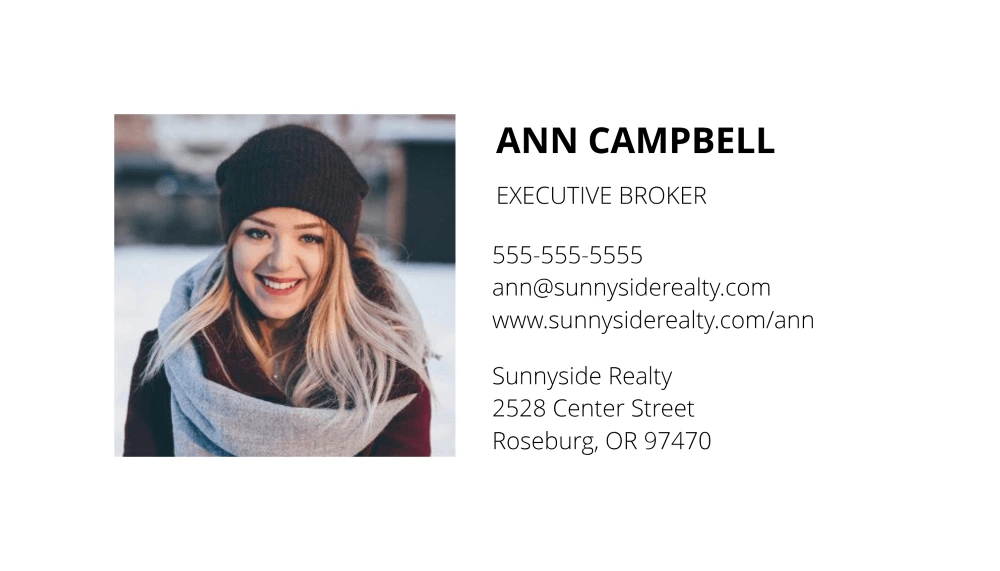
Source: Lucidpress
6. Host a launch event
Hosting a launch event for your new real estate business is an excellent way to introduce yourself to the community. According to Bizzabo, “Most (41%) marketers believe that events are the single-most effective marketing channel over digital advertising, email marketing and content marketing.”
A well-crafted event will create buzz around your real estate brand, allow you to reach a wider audience, and start your business off with a bang. Be sure to publicize your event across social media and ask your friends & family to help spread the word. Invite relevant business owners, influencers and news outlets.
An event also provides the perfect opportunity to meet and get to know your prospects. Real estate is a personal business, and connecting with potential leads face-to-face will set you apart from the competition.

Source: Design Wizard
These tips will help launch your real estate business successfully and allow your new venture to flourish. Start your business on the right foot by following our advice, and turn to Lucidpress for all your custom marketing materials. We wish you the best of luck on your new & exciting journey.
Your brand matters. Learn how to protect and elevate your real estate brand in this branding essentials guidebook.
Brand management isn’t for the fainthearted. Even companies with well-documented brand-building strategies struggle to keep up with an ever-evolving list of marketing channels used to communicate with clients.
One of the core strengths of Lucidpress is that our platform helps you build a cohesive brand across your entire organization. Admins create templates and lock down the important brand elements. Users can customize templates but can’t change any elements locked into place to maintain brand unity.
Related: How to ensure brand compliance
The digital files marketing teams create with Lucidpress (or any other graphic design software) are commonly called marketing assets. The term immediately brings to mind the many software packages commonly referred to as digital asset management (DAM) or media asset management (MAM) systems.
Today we’re going to take a closer look at these systems and how they relate to brand management, including the benefits of keeping tabs on all that marketing content.
What DAM is and why it matters
Digital asset management is the process of organizing and making digital files available across an organization, managing them, and tracking their usage.
The term is often confused with marketing asset management, but digital asset management can cover files from other departments as well. Even though accounting may have ownership of a specific file — like a vendor setup form — managers from other departments might need to access the form or provide it to other parties.
Unlike the office environment of 20 years ago, paper is no longer the way people primarily communicate. Digital asset management is the online equivalent of an office filing cabinet.
Why does it matter?
DAM often involves a cross-functional team assembled from different departments including IT, marketing and operations.
When looking at DAM software options, most emphasize file management and organization for marketing departments. However, files can be shared across an entire organization, within single departments, or even with outside vendors & contractors.
Keeping content in order was originally handled by the marketing department. But as enterprise IT needs grew, so did the need for technical specialists to step in and help with DAM.
Very large companies often hire digital asset managers to handle this task for the entire company. Digital asset management is also gaining ground in the MarTech community.
There are some drawbacks to traditional DAM systems, including version control and poor customer experience. Since these systems run the gamut from very simple tools to complex custom builds, we’ve created a buyer’s guide to help you understand how these systems work.
Because Lucidpress is a branding platform, we take brand protection and file management very seriously. Our software can serve as a very simple DAM or integrate with more complex solutions, depending on the size and needs of a particular business.
Digital asset management (DAM) vs. marketing/media asset management (MAM)
We’ve touched on the fact that digital asset management and media/marketing asset management are different.
If you try to search for a DAM system that only handles files from accounting, you probably won’t find one. This is because, in most enterprise companies, the marketing (and sales) department produces the largest amount of digital assets.
That being said, the definition of digital asset management as a business practice differs tremendously from the definition of DAM software.
Additionally, marketing asset management and media asset management are often used interchangeably, even though they have different meanings.
Let’s clear up the confusion here with a few definitions:
- Digital asset management: the business practice of organizing and making digital files available across an organization, managing them, and tracking their usage.
- Digital asset management software: systems used primarily to organize branding materials, including logos, fonts, photos and documents.
- Marketing asset management: the business practice of creating and managing a library of branded materials including logos, photos, sales collateral, audio and video assets.
- Media asset management software: systems used primarily to organize audio & video branding materials, such as radio spots, commercials and videos for social media.
Understand the difference now? It can be confusing when you spot all of these in the wild, but these definitions are something you can refer back to if needed.
Marketing asset management use cases
According to CampaignDrive, there are four generic use cases for marketing asset management that are typically handled by DAM software:
- Content creation. This is where Lucidpress excels and most DAMs fall short. Some DAMs assist with content creation, but marketing content usually requires graphic design or other programs built for professional creation.
- Version control. Most DAMs are focused on content storage, which means you only have access to the current version of any particular file. However, some do allow you to view file history, publish to the final channel and focus on version control.
- Print & offline marketing. Although companies often operate with a digital-first mentality, certain industries like e-commerce and local business services often need to invest in print marketing as well. DAMs really shine here, as print designers can pull logos, previously printed pieces, and other brand elements as needed.
- Local marketing. Enterprise companies with local branches (such as franchises and restaurants) have a greater need for customization & control, as marketing teams in the field might not always have or use correctly branded assets. A few DAM systems support “distributed DAM” or local marketing automation (LMA) to help with this.
Types of files typically included in marketing asset management
Your marketing department often handles many different file types, depending on the channels and campaigns it manages. Given how many there are, it’d be impractical to list every file type supported by a particular DAM or MAM system.
Instead, let’s paint this with a broad brush. Generally speaking, MAM systems are mostly used for audio & video file management. DAM systems are mostly used for file types that aren’t as large or complex, like documents & graphics.
That’s not to say you can’t use a DAM system to store videos. But, a MAM system is better built to support them, from the interface to search capabilities to storage capacity. It might seem like a small distinction now, but those factors become more important as your library grows.
Marketing asset management ROI: Who benefits from marketing asset management?
For enterprise companies, the marketing department directly benefits from having a formal system in place. It saves time for designers who are looking for branded templates and the latest version of your logo and other marketing materials. Brand managers save time, too, because final quality checks will be faster and easier.
Another practical benefit: Properly organized files with good version control will save you money & embarrassment by preventing incorrectly branded print & digital ad campaigns.
Another benefit of marketing asset management is that it improves the relationship with IT. Many art departments and in-house creative studios already work side-by-side with dedicated IT employees, and having a formal system to manage files can help both sides stay on the same page.
Overloaded servers, multiple versions of the same file, and other problems create real headaches for companies trying to manage computer networks and hard drive space. Marketing asset management helps alleviate that, especially if the company has a dedicated digital asset manager.
Employee productivity is another benefit of marketing asset management, since creatives spend less time looking for files and more time fulfilling creative requests.
Key takeaway
Marketing asset management is a fairly new concept, but it’s already distinguishing itself from digital asset management in a few key ways. Understanding whether your brand would benefit from DAM, MAM, or a combination of both will make it easier to build the right system for your business.
Learn more about digital asset management in our comprehensive buyer’s guide.
Our world has become a digital one. You see its digital fingerprints in virtually every aspect of 21st-century life. We stream movies & shows on smartphones, store photos & documents in the cloud, and create apps to cover a wide spectrum of activities. These digital assets are everywhere.
Related: What is marketing asset management?
For a company, a digital asset creates or augments its brand identity. Understanding the role that a digital asset plays in your success is crucial when you’re managing or marketing a brand.
Identifying a digital asset
What is a digital asset in simple terms? At a basic level, a digital asset is content that’s stored digitally and holds value to the company who uses it.
This creates a broad spectrum of items that can be considered a digital asset. Photos, videos, images, slideshows, graphics, PDFs, spreadsheets, audio files, and even plain text documents all fall under the digital asset umbrella. For example, an .SVG file of your brand logo is a digital asset. So is the template for company letterhead. Advances in technology mean that what is considered a digital asset is always evolving.
For your company, digital assets are going to include everything related to your brand messaging, products offered, and services rendered. If you have digital content that is uniquely identifiable and provides value to your company, it’s considered a digital asset.
Benefits of a digital asset
Companies count on digital assets to serve a couple of distinct purposes. Such assets help build brand awareness. They can also influence a consumer’s purchasing behavior. When used effectively, digital assets can help brands do a better job of engaging consumers and earning their business by offering personalized, relevant content that fits their needs.
Think about it. Would you sell baby clothes & toys to a single person without any children? No. You would target parents with your products. Tailoring digital assets to fit the needs of your target audience sets successful brands apart from brands that fail.
What makes digital content so important? The rise of social media has put a premium on visual content. When you check out platforms like Instagram, Facebook, Twitter and Pinterest, you’ll notice a flood of visual posts featuring photos, short videos and GIFs designed to draw attention. These assets help brands connect with an audience via multiple channels and form the foundation of your brand identity.
How should you manage digital assets?
Making a good first impression and a lasting impression are both equally important in business. You want to manage digital files properly so you can always put your best foot forward in marketing and in communications, with vendors and customers alike.
Before the digital age, managing brand assets meant keeping file cabinets stuffed with all sorts of materials around the office. It could easily get cumbersome and hard to track. Today, digital asset management (DAM) software takes the place of the file cabinet. It makes it easier to store, edit, share and protect your content. Employees can play an active, collaborative role in modifying and sharing documents, images and other digital media while remaining true to your company’s brand voice.
DAM software exists for the purpose of making all digital assets identifiable, searchable and discoverable. It incorporates metadata into the process, which is data — such as keywords or phrases — used to describe a particular digital asset. This makes it easier for your company to build a consistent and strong brand voice across all marketing channels.
Take a holistic approach to digital assets
As a solitary tool, DAM software will not be completely effective in keeping your brand voice loud, strong and memorable. Think of it in terms of owning a car. Getting an occasional oil change isn’t the only thing you do to keep the engine running. You need to fill up other fluids, replace air filters, and do diagnostic checks to extend the life of your car.
Managing digital assets operates on a similar principle. You need to incorporate DAM software into a larger toolbox you use to create and share content. DAM software can be fully integrated to aid other functions such as web content management or digital advertising platforms. It can also be specialized to focus on a narrower channel like media production or brand management.
DAM software does come up short in key areas. It has no version control, no enforced brand guidelines, and no locked templates. The end result is chaos in systems where there should be order in building & maintaining a strong brand voice.
Lucidpress can pick up where DAM software leaves off. It lets you design templates with the latest logos, colors & other assets that align with your brand. You can update brand assets seamlessly and finally get old logos out of circulation. With our brand templating platform, you can create everything from newsletters to social media ads through cloud-based software and a user-friendly interface that promotes real-time collaboration.
Learn more about digital asset management in our comprehensive buyer’s guide.
Your brand is one of your company’s most powerful assets. It encapsulates everything you want people to know about the business—what you value, what you stand for, and what you’re trying to do.
Related: 6 important branding tips to keep in mind when going global
Which is why brand extension can be such a stressful process. Using the strength of your brand to enter a new market gives you a headstart that new companies can’t match.
Understanding how to extend your brand is crucial for engaging markets. Before you launch a new product or adopt a new strategy, you’ll need to think about a few things.
Before we get into those things, though, let’s agree on a brand extension definition.
What is brand extension?
Brand extension is the use of an existing brand name and logo on a new product. The original brand identity is called the parent brand, and the new products are called spin-offs. Companies use this strategy to capitalize on the brand equity of their existing brand to launch new products and enter new markets.
Let’s look at Apple. For 25 years, the company built personal computers. And they were good at it. That’s what they were known for—powerful, attractive computers that were easy to use.
And then they entered an entirely new industry: personal music devices. The iPod was an immediate and immense success. We’ll talk about how Apple pulled this off in a bit. First, let’s talk about why it was a good idea.
Why brand extension is so powerful
Apple had built a very strong brand over 25 years of making personal computers. Why would they risk diluting that brand by entering a new industry? The stakes are high, and the chance of failure keeps many business owners from even considering a big move like this one.
But Apple knew that building on their brand would be immeasurably valuable if they did it right.
Companies spend years and millions of dollars solidifying their brand. Marketing campaigns, social media interactions, advertising, public relations, and product development all contribute to a brand’s strength.
Why? Because consumers recognize and value brands. People are more likely to buy products from brands they know, whether they feel explicit brand loyalty or not.
This type of brand recognition means that the presence of a strong parent brand—like Apple—can significantly boost the sales of new products. Introducing a completely new product is hard. It’s much easier when that product is backed by a recognizable brand.
But sometimes his type of thinking can get companies into trouble.
Where brand extension goes wrong
Not every brand extension builds on a strong brand to create huge sales. Let’s look at an entertaining brand extension failure: Zippo Fragrances.
Zippo is a very strong brand in the world of cigarette lighters. Their name, design, and even the sound of the product is very distinctive. If you see a Zippo, you know it. Can you name another brand of non-disposable lighter? Probably not.
This is a strong brand. Zippo wanted to use their brand equity to enter a new field.
Why they picked perfumery is anyone’s guess.
The company actually used some good brand extension tactics. They kept the brand name and even used their distinctive lighter design for the perfume and cologne bottles.
But absolutely no one thinks of Zippo when they think of perfumery. Instead of seeing the brand and thinking, “I trust Zippo,” people think “Why would Zippo make a cologne?” That’s a failed brand extension.
Zippo missed a crucial ingredient of the brand extension recipe.
How to get it right
If you’re thinking about extending your brand, it’s worth looking at some recent successes. Look at Tesla’s expansion into trucking, for example. O, Oprah Winfrey’s magazine. Tootsie Pops. Virgin Airlines (and dozens of other Virgin-branded forays).
What do these brand extensions have in common? Above all, they play to the parent brand’s strengths. Tesla already knows how to build great vehicles. Oprah knows how to tell stories that capture the hearts and minds of her audience. Tootsie Roll knows how to make a candy that people love. Virgin knows customer service better than almost anyone.
Successful brand extension strategies place the new product as a logical extension of previous ones. That’s why Zippo perfume isn’t a household name. Everyone knows Zippo for their lighters. Their brand equity didn’t transfer to their beauty products.
Apple knew their brand equity would transfer to the iPod because their brand was already adjacent to the music device industry.
Be careful with brand extensions to reap their rewards
Brand extensions can be hugely valuable. But when used without enough forethought, they can also be disastrous.
It’s crucial to give any potential brand extension a great deal of thought. If you do decide to extend your brand, make sure to apply your branding consistently to take advantage of the loyalty that you’ve been building for years.
Don’t be like Zippo. Be like Apple.
How can brands stay competitive in today’s design-centric world? Explore the rise of the design democracy, then learn how your organization can ride it to the top.
Here’s a promise: by the end of this article you’ll know exactly what a brand promise is and you’ll have plenty of examples that will help you have your own in a matter of minutes.
And there’s something more.
Related: An 8-step brand development strategy
Are you ever a bit confused about some of the marketing jargon out there?
Maybe you’re wondering:
- Is a brand promise the same thing as a tagline?
- Is it a word? Is it a phrase? Is it a 30-second pitch?
- Is there a difference between a brand promise and a unique value proposition?
I understand—everyone is using these terms with their own interpretation, right?
Fortunately, by the end of this article, everything will be clear. Promise.
Ready? Let’s dive right in!
What is a brand promise?
What’s the first thing that comes to your mind when I say Las Vegas? Was it something related to gambling, poker, blackjack, casinos or nightlife?
What’s the first thing you think about when I say Volvo? Was it something related to safety?
What’s the first thought you have when I say Mercedes? Was it something about quality and luxury?
You see, a brand promise is your perception of how you feel about a brand.
A brand promise is not a tagline.
Do you know the tagline of Mercedes or Volvo?
Probably not, right? But you know what their promise is.
You know that they promise you a luxury car (Mercedes) or a safe car (Volvo).
And there’s one more important thing. You know that they can keep their promises.
But, this is starting to sound like a unique value proposition, right? You promise something that only you have, and people will remember you. Or… is it?
Let’s see.
A brand promise is not a unique value proposition (but it incorporates one).
A unique value proposition (or a unique selling point) basically says:
- What you do
- Who you serve (or sell to)
- How you solve your customer’s needs
- And how you’re different.
Here are a couple of examples:
For {target} who {statement of the need or opportunity}, {Name} is {product category} that {statement of benefit}.
For content marketing companies who always have tight deadlines, ContentBoost is the content creation software which helps teams produce long-form articles, blog posts and ebooks on high-speed because it lets you build on each other’s ideas.
We help X do Y doing Z
We help content creation teams write better and faster by dragging and dropping research into documents.
We do X, but the difference is {primary differentiator}
We help content teams put all their content together, but the difference is that writers are also able to pull from that database and add to a library of bite-sized research.
Is this enough to have a strong brand promise? Let’s do a quick imagination exercise.
You and I don’t know each other.
But let’s say we randomly meet at an event, and I tell you I recently started a company that creates the safest cars on the road ever — even better than Volvo.
Basically, let’s say I just tell you my unique value proposition. A simple statement that says what my company does for who and how we’re different.
Would you believe me? Probably not, right? You’ve just met me.
And if someone asked you half a year later what the top 3 safest car brands are, would you mention my company?
There’s probably 0 chance you have that instant association between my company and your safety. This is why a unique selling point is different than a brand promise.
So what is, in fact, a brand promise?
There are two kinds of brand promises: an implied one and an explicit one
For instance, an element of every airline company’s brand promise is that they will get you to your destination safely. You don’t have to promise that any more. It’s an obvious (implied) brand promise.
Let’s take another example.
A restaurant’s implied brand promise will be that they provide great food with great service. No one comes to a restaurant expecting an awful customer experience, right?
But, there are also other elements that are explicitly stated.
For instance, when FedEx first started out, they promised you that they “will get your package to you by 10:30 am the next day.”
This is a promise that 1) was different from what everyone else had, and 2) was also something people might not expect, so they stated it explicitly.
Here’s the most simple, short and down-to-earth brand promise definition:
A brand promise is what you instantly KNOW and FEEL about a brand.
But how do you create such a lasting brand purpose or promise? How do you get people to instantly associate your brand with a certain quality like safety, quality, luxury, or whatever you want?
How do you move people from being total strangers to trusting your brand?
You will see that a brand promise is, in fact, more like a process — and it’s part of the whole branding strategy and brand identity.
Let’s see what the essential elements you should take into consideration are if you want to create an effective brand purpose that people will remember.
1) Start with a promise that you would tell a friend
If you want people to remember something about your brand, it first must be clear for you what that something is.
And the way you do that is by actually telling it to a friend or an ideal customer.
Let’s do a short exercise that will help you create a first draft of your brand promise.
Imagine you’re drinking a coffee with your core customer. He is right in front of you, and he’s the best buyer in the world:
- He’s already researching the kind of products/services you sell
- He has the money
- He’s willing to spend it
- He isn’t overly skeptic
- He’s already made similar purchases in the past
And now, he is just waiting for a reason to buy something from you.
What do you promise him in exchange for his hard-earned money?
It all boils down to this:
If you give me X amount of money I PROMISE I will give you _____ {this product / service} which will help you do / achieve / become _____ {introduce benefits} better than ____ {other services/products} because ____ {why you’re unique}.
Let’s say you’re the marketing manager or the CMO of an electronic e-commerce business.
Here’s an example of what your brand promise can be:
If you give me $1000, I promise I will give you this super-fast, octa-core laptop which will help you simultaneously work on however many engineering programs you want (without buffering or crashing).
What makes us unique is that we’re the only ones who use quantum computing, and we’re also the only ones who offer 10 years’ guarantee on every single product you buy from us.
You see, the brand promise isn’t a tagline. It isn’t “Just do it” or “Think different.” Because that’s not what you would say to a person face-to-face.
And this doesn’t have to be limited to a single product or service. It can be also adapted to a more general promise.
Let’s take the example above and apply it to the company level.
If you choose to do business with us, I promise you’ll never have to suffer from having a dysfunctional device, whether it’s a phone, laptop or any other electronic device.
This is because we’re the only ones who have developed special partnerships with all our suppliers, and we’re giving you not just a 10-year guarantee for almost any product you get from us, but free full service and support for the period your device isn’t functioning properly.
But is that all? This is the brand promise?
What if someone else comes along and says the same thing — or what if you don’t have something so unique to begin with?
What if, for instance, you want to create a brand promise for a restaurant, but you don’t have any special dishes?
This is how you start developing a more effective brand promise.
If you want people to remember it and instantly associate the quality you want — like great customer service, for instance — you also need the next elements.
2) Create a mental movie in people’s minds by making everything ultra-specific
One day, a friend of mine decided to do a little experiment:
He randomly called about 10 local pizza shops. He said something like: “Hello, I want to come to your place with 10 friends, but one of the guys insists on going to another restaurant. I need your help to convince him: why is your pizza better?”
Here are just some of the responses he got.
Response #1: (Annoyed) “Hmm… Not sure. It’s your call.”
That’s how not to make a promise…
Response #2: “We use high-quality ingredients.”
This sounds good, but what does quality mean? Plus, do you know anyone who says they don’t use high-quality materials, no matter what they’re selling?
You see, this is an implied brand promise. Quality, great customer service, great food, etc.
You don’t go to a restaurant and expect bad food, right?
So, there must be a better way to make a brand promise. Let’s look at another response my friend got.
(Full disclosure: the person who answered this time was actually the owner of the restaurant.)
Response #3: “Oh, well, we use high-quality ingredients. For instance, our sauce and flour are made with true Italian ingredients.
Take the cheese, too. It’s not just cow-milk mozzarella. Instead, we use a buffalo-milk mozzarella.
And there’s also the sauce. Sir, we don’t use pre-prepared sauce. We use genuine San Marzano tomatoes right from Italy!
We’ve been handcrafting pizza for 5 generations. With every crispy bite you take, you taste 90 years of pizza-baking mastery!”
You see, the promise is really simple: You get tasty, Italian pizza with high-quality, authentic ingredients, and you can be sure it’s good because they’ve been perfecting it for generations.
See how it all changes when you actually put a picture in people’s heads about what those high-quality ingredients mean or what experience means?
Now, is this enough to earn a special place in people’s minds?
Well, it is a good start. But if you really want to get people to remember your brand promise, you need to apply element number three from our list.
3) Repeat it over and over again. Across all the channels.
By now, you’ve created the first draft of your brand promise.
You know what to promise if you’re face-to-face with your ideal client.
You also made it ultra-specific, and you can give people all the details on how you’re different and why they should choose you.
But, there are so many other brands that try to do the same. How do you get through the noise and get people to remember you?
Here is the simplest but most powerful thing you can do:
Repeat it as many times as you can. And keep it consistent across every communication channel you use.
Why is this so efficient?
Well, because each time you repeat your brand promise, you deliver it to people who might not have noticed it previously.
There’s more.
With each repetition of your core message, your audience gets more familiar with your brand, products & services, and company.
This leads to familiarity, to that feeling of acceptance.
Once people begin to accept your brand, and your promise, they also begin trusting you.
Ultimately, this opens the door to more sales with less resistance.
The bottom line is this: no matter how strong, unique or specific your brand promise might be, people won’t remember it unless you repeat it often.
How do you repeat a brand promise without annoying people? Here’s how.
4) Use the power of suggestion to make your brand promise memorable
How do you suggest to people what you want them to remember?
Metaphors, comparisons, analogies and stories are some of the most powerful persuasion techniques you can use. They’re like a backdoor to the human mind (see what I did here?), which make your ideas stick faster and longer than a rational explanation or affirmation.
By employing these little techniques, you can repeat your brand promise without annoying your audience.
For instance, here’s a visual metaphor used by Viagra when it began selling on Amazon.

As… bold as that was, you can still go a step further. Here’s a mind-blowing example.
Red Bull’s promise is that it gives you the energy to achieve whatever you want. It will help you do extraordinary stuff because it increases your performance, concentration, reaction speed, vigilance, etc. It empowers you to go beyond limits, right?
So, how could they express this better than a jump from the stratosphere?
During a 9-minute fall, Felix Baumgartner set records for both the height of the jump and the speed of descent (830 mph!).
Who gave wings to Felix? Red Bull — the event organizer and company that made all this possible.
The bottom line is this: let people get the moral of the story. This is how you build that instant association between a certain attribute and a brand.
5) Keep your promises. Even in the little details.
You know what they say: trust takes years to build, seconds to break, and forever to repair.
It’s true for human relationships, and it’s true for brands, too.
You spend a lot of money to get people to finally believe in your promise, but if you don’t pay attention to the little details, it can all fall apart.
Here are some photos I’ve taken over the years that perfectly illustrate brand promise misalignments.
For instance, let’s say you’re boarding a plane and you see this:

The implied brand promise — that they will get you safely to your destination — is gone. In an instant.
It’s possible the plane was perfectly safe and the window wasn’t a threat to anyone’s safety, but the message communicated by this photo screams anything but.
Or, here’s a sign that I saw posted by the side of the road:

They might have a class “A” office, but they definitely get an F for design.
Based on this sign, would you truly believe they have an impressive office?
Or, let’s say you’re waiting in a doctor’s examining room and you see this:

Is this where a doctor should keep his thermometer sleeves?
I’m pretty sure that wasn’t a used cup — but if you think about it, the implied brand promise of any company is (or should be) attention to detail, clean supplies, etc. By failing to pick up on that, you could be sending harmful messages about your brand promise without even knowing it.
Now, let’s see a positive example of a brand promise.
FedEx’s core promise is that they will go to great lengths to deliver your package on time. And they have stories to prove that. For instance, a driver called Mike O’Donal single-handedly salvaged Christmas for one of his customers.
The customer found out just a few days before the holiday that he sent the package to the wrong address, and it didn’t reach its destination.
The package contained the only Christmas gift the customer could afford to give her daughter, and now it was in someone else’s hands.
So, the driver tried to retrieve the package. When the person at that address denied receiving it, O’Donal decided to play Santa Claus.

He purchased a duplicate gift out of his own pocket in time for Christmas Eve.
Through his actions, O’Donal did more than just replace a gift — he earned the customer’s gratitude and loyalty.
A quick recap on how to create a brand promise that sticks in people’s minds
A brand promise is like the moral of the story. Just like in the fairy tales, the moral was rarely directly stated or called out, but it’s implied through every aspect of the story.
For instance, nowhere in Pinocchio does it say that lying makes you look bad — but in the end, that’s the message we take with us.
So, here are the most important elements of a successful brand promise:
- Tell your brand promise as you would tell it to your ideal customer face-to-face.
- Describe your promise in detail. What does “quality” actually mean?
- Repeat it across all the channels. Repetition works.
- Use the power of suggestion: start with analogies, comparisons & metaphors.
- Make sure you keep your promises, even when it comes to the little things.
Ready to start building your brand? Learn about the 10 assets you need to effectively manage a brand online in our free ebook.
Folder structures. Files by the thousands. Cloud sharing that goes awry when trying to search for something.
“Where can I find the latest version?” messages over Slack or email.
Download V5. Upload V6. Share it with the team for feedback.
“That doesn’t look quite right.”
If you’re familiar with this scenario, you’re most likely looking for an effective way to solve it and ensure a solid foundation for future growth. We’re here to provide clarity and solutions so you can streamline how you create and manage your visual assets.
Related: What is media asset management?
We do this every day for our customers and believe your marketing team can become a lot more productive with the right tools and workflows in place.
You can use this practical overview to validate use cases for image management software in your organization to save time, money, and a lot of energy.
Let’s dig in!
What is image management software?
The contemporary marketer needs to deliver high-quality work in a visually compelling manner that fits every platform in a custom approach. This requires being able to preview, find, work with, and share images faster than ever before.
An image management system caters to these specific needs. It provides your marketing team with a platform where you can cluster and organize all your digital images and visual assets so everyone can view, use, and distribute them.
As your brand grows, makeshift solutions won’t do. You need image management software that’s tailored to your challenges so you can focus on growth instead of answering repetitive operational questions.
What’s more, using it means you’ll spend less time adjusting access levels as your team members change. It also helps to worry less about security issues which have become prominent in recent years.
A high-performance marketing team knows that the right software can boost productivity and free up mind space for valuable creative work.
Streamline your workflow with visual assets
Today’s best image management software options are cloud-based, built for accessibility, and highly flexible.
For example, marketing teams that create a lot of content want to be able to track the entire life cycle of their marketing materials. This means being able to:
- Browse through a branded image library fast
- Convert files in large batches for specific channels
- Search for digital images, graphics, and illustrations and get accurate results
- Tag assets and assign descriptions so other team members can make informed decisions about using them.
An image management system that’s well implemented within a marketing team reduces friction by enabling content creators to both be self-managed and collaborate effectively.
Marketing managers can also improve their speed when reviewing visual assets and giving feedback. They can also:
- Set custom privacy and copyright settings (e.g. only certain members of the team can download specific images).
- Ensure branded photos and illustrations are safely stored and shared (e.g. everyone in the team logs in with a username and a strong password to access the assets).
- Share up to date visual assets with customers, partners, distributors or media representatives in a fast and centralized way.
Once you’ve experienced the challenges of not having a dedicated software solution in place, you know how valuable it is to align teams across departments and get them to use the right visual assets on the right channels, in the right formats (without being annoyingly repetitive about it).
The visibility and control image management software provides is fundamental for maintaining brand consistency. When everyone uses templates, images, graphics, and illustrations that belong to the same design iteration and have the same quality, your brand becomes stronger, stabler, and even more trusted.
Digital asset management vs image management software
Two main challenges have led to the creation of specific tools to address them:
- Storing and working with high volumes of digital assets (which is a challenge for even the most organized person — and we know a few).
- Changing habits and expectations around using these digital assets (availability, sharing, updating, etc.).
Two of the main options marketing managers have are DAMs (digital asset management systems) and IMSs (image management software).
To make it easier for you to choose the right platform for your team, here’s the big picture comparison between their usual features.
Features
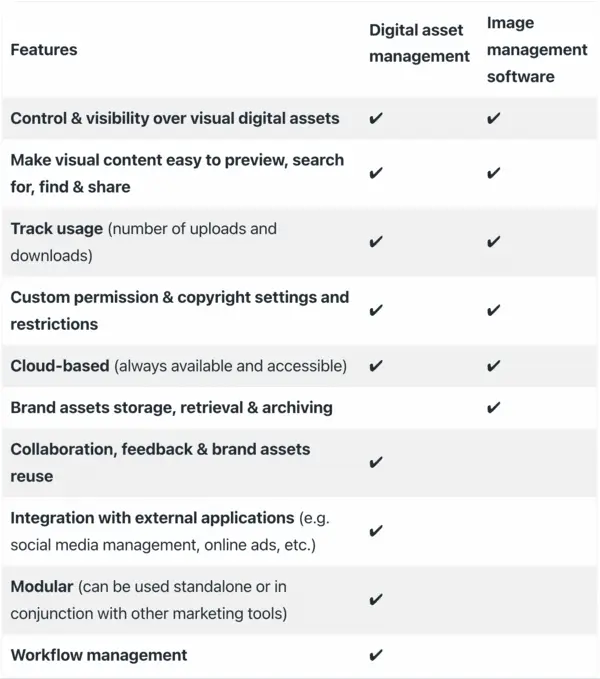
While digital asset management software can handle most file formats your company works with, image management solutions may be a little less flexible.
DAMs usually support a variety of file types, from JPG to AI, DOCX, EPS, FLV, GIF, INDD, M4A, RAW, WMA, ZIP, TIFF and many more.
For security reasons, both DAMs and IMSs restrict uploading executable files (such as EXE, MSI or DLL).
Close the gap in your visual assets’ life cycle
As you can see, there is some overlap between image management software solutions and digital asset management ones, with the latter providing a richer set of features.
However, you should know that your choices aren’t limited to these two types of platforms.
In fact, if you find their core functions falling short of your needs, you can use a brand templating platform to close the gaps in their offering.
Say the design team has just wrapped up a set of illustrations for a guide your company created for customer onboarding. You might want to make those illustrations available for the content team that writes articles for the company blog.
You can upload them to your DAM or IMS, tag them, add a quick note for context and share them with the appropriate team.
However, you need to ensure they’re used on-brand and at the highest possible quality. (No one likes blurry visuals in blog posts in this day and age.)
Your team can use Lucidpress to create graphics that integrate the illustrations while respecting brand guidelines. In Lucidpress, you can store approved colors, fonts, logos, and templates and other elements content creators need to work with.
What’s more, you can lock individual elements or specific attributes in a template so that brand consistency is always on point. The elements you can lock include shapes, images, text boxes, and more.
Once your digital assets are ready, you can easily export them from Lucidpress to your DAM or image management software of choice in a variety of formats such as PNG, JPG, SVG, PDF, INDD, IDML and more.
Key takeaways
If you find yourself looking for solutions to improve your productivity, streamline processes in your team, and keep your brand consistent across channels and assets, know that you have plenty of options to choose from.
Moreover, you can set select them so that they integrate with each other, saving you even more time and energy spent on moving visual elements from one platform to another.
Hopefully, this kick starts a new era for your marketing team, defined by increased productivity and a stronger brand coherence every time you show up for your customers.
Learn more about digital asset management in our comprehensive buyer’s guide.
According to Bain and Company, the luxury goods market is set to double in size from 2020 to 2030, reaching over $617 billion by 2030.
From watches to condos, business is booming. Even discount retailers like Target partner with designers like RHODE to attract customers shopping for high fashion at affordable prices.
But what does it take to build a luxury brand? What makes good luxury branding stand out? Here you’ll find everything you need to know about building a luxury brand from the ground up.
Let’s get started, shall we?
What is a luxury brand?
The definition of a luxury brand can change depending on the type of brand you’re describing.
In consumer goods, it’s Louis Vuitton and expensive couture fashion. In hospitality, bespoke travel experiences in exclusive or boutique locations would be considered luxury.

[Some of today’s most recognizeable luxury brands]
According to THAT Agency, five factors clearly define a luxury brand:
- Price
- Quality
- Design
- Meaning
- Rarity
- Service
Ultimately, consumer perception plays a huge role in elevating luxury brands above others. People associate luxury brands with higher prices, higher quality, rarity, and a sense of exclusivity.
Take Louis Vuitton, for example. Since 1854, the French brand has consistently worked to perfect their luxury brand. Today, they stand out for several reasons:

- The company invests in collaborations with a variety of artists, influencers, and celebrities without diluting the brand – like the above collab with Japanese artist Yayoi Kusama.
- Regardless of the artist collaboration or Creative Director at the helm, LV maintains a consistent brand identity.
- The parent company of Louis Vuitton, LVMH, also owns a slew of other luxury brands, giving them a ton of experience in the art of luxury branding.
How to build a luxury brand
Ready to learn how to build a luxury brand from scratch? We’ve got you covered.
The brand leadership experts at Martin Roll suggest a five-step framework to build a strong luxury brand:
Get specific about who you’re targeting.
There’s a niche audience out there that cares about your brand/product/mission. Figure out exactly who they are, and focus on one audience persona when you’re getting started. After your brand is well-established, broaden your definition of an ideal customer.
Do things differently.
Differentiation is a key focus for emerging brands. Narrow down what makes your luxury brand unique? Do you specialize in custom made, bespoke products or services? Are your items handmade? Highlighting what makes you unique is essential to standing out.
Become a status symbol.
Focus on how influencers in a specific niche are using your product or service. By creating the perception that only the most discerning buy into your brand, everyone in your target market will too.
Create exclusivity.
New luxury brands can tap into exclusivity by offering special perks to existing customers. High price tags and scarcity are other ways to employ this strategy. For example, Aston Martin combined a high price tag with scarcity when it created the Aston Martin One-77. The British car maker made a whopping total of 77 cars and sold them at $1.8M dollars each.
Consistently delivery on your brand promises
The bar for luxury brands is high. You’ll need to raise your game and keep your brand promises in every single customer interaction. Never compromise on your mission, purpose, and commitment to quality.
How to market your luxury brand
Once your luxury brand is established, it’s important to maintain a consistent brand identity through marketing.
Create a consistent brand from day one.
Start with a company style guide that gives your marketing team technical details about your brand’s look, including appropriate colors, fonts and styles. Keep in mind this is a living document that will evolve with your brand.
Make branded templates to protect brand identity.
Avoid a brand identity crisis by using brand management software like Marq. Create locked templates that keep logos from getting stretched and colors from being changed, no matter who’s working on your materials.
Engage in cause marketing and brand activism.
Cause marketing (aka brand activism) is a great way to get customers to connect to you on an emotional level. Consider your brand’s purpose and what it stands for. Are there any nonprofits or groups you can collaborate with or donate to to raise awareness?
Go all-in on SEO.
No matter how luxurious your brand is, no one will know about it if they can’t find it on Google. Invest in SEO strategies to increase visibility for your brand in the long-term.
Key takeaway
Building a strong luxury brand isn’t for the faint-hearted. With a detailed strategy and proper brand building techniques, you’re well on your way to becoming the next big thing on the luxury scene.
Need help keeping your luxury brand identity consistent? Marq has a template for that. Browse our brand template library here.
Do you remember the dark days before cloud storage and internet searches? I know I do.
Today, if you have a question or need to know something right now, I’ll bet you do the same thing we all do… Google it. Gone are the days of the Dewey Decimal system and library searches that limit you to the knowledge in books they have onsite. Gone (thank goodness) are the days of inserting floppy disk after floppy disk (despite your best labeling efforts), madly trying to find that one photo you need for an ad or that flyer your team created last year that you to repurpose for a last-minute client meeting.
Related: Image management—What it is & why it matters
If you’re a young millennial or younger, you’re likely shaking your head no. You’ve grown up with the internet and all of its magical powers of information filing and seeking. But before Google became synonymous with finding things on the ‘net — and storing them for you via Google Drive (or Dropbox or Microsoft OneDrive) — finding your files and sharing them sometimes felt like the hero’s quest for the grail.
Of course, this didn’t solve every file management problem. It’s one thing to have a system for storing your own collection of files and media — but what happens when you add more people to the equation? Predictably, it becomes much more complex. That’s the situation many companies and marketing teams find themselves in as they start to grow and build up their multimedia assets.
What is media asset management?
Details, please. A media asset management (or MAM) system provides a single warehouse for storing and managing video and multimedia files.
Think of it like your own private ‘Google’ that you can adopt for your media storage, brand integrity, usage analytics and team collaboration needs, helping you and your team easily find, edit, share and centrally store all of your media assets and projects so that the most recent versions are accessible to anyone (to whom you grant access), anytime, anywhere.
Yes, content is king. But asset management is most definitely queen.
The right media asset management software empowers you to build a strong, consistent brand and maintain its consistency across all types of marketing collateral. Most users are impressed by how intuitive, flexible, logical, and easy the software is to use. It’s a cost-effective approach that has proven very successful for the world’s most powerful brands in managing their digital assets.
Why it’s so important
So why is media asset management so important? If your organization is still depending on internal folder structures and email to manage content, it’s likely costing the company money.
This is money in lost time, inefficiencies, recreating the wheel over and over, emails back-and-forth between team members, and reduced production or ability to take on new work. It may also be causing the company less tangible side-effects like employee stress, breakdowns in brand compliance, loss of version control, and loose file security.
So much media, too little management. Much like the saying “With great power comes great responsibility,” today most of us have more media than we know how to (properly) manage. And it’s costing us big time. According to PR Newswire, inefficient knowledge sharing costs large businesses $47 million per year.
According to the Panopto Workplace Knowledge and Productivity Report, “U.S. knowledge workers waste 5.3 hours every week either waiting for vital information from their colleagues or working to recreate existing institutional knowledge. That wasted time translates into delayed projects, missed opportunities, frustration among employees, and significant impact on the bottom line.”
Talk money to me. That’s one solid reason to switch your content management to a MAM system or brand templating platform. But what is the full ROI of media asset management?
Based on impact to the bottom line alone, it’s crucial for every brand to manage their assets properly, using media asset management software (or digital asset management software – but we’ll get to that later).
Have you ever had to find a flyer your team made sometime last year right now to impress a new client with samples of your work, with little regard for the 40,000 files in your internal folder structure? Or put a few grey hairs on your head trying to work with multiple players across your organization to storyboard, produce, animate, and record voiceover for a video highlighting a new product?
If so, I’ll bet this took hours or weeks. With a MAM system, you can reduce this to minutes and days. Imagine the time (and sanity) saved by gaining hours of your life back for other tasks — not to mention the money…
MAM: What marketing managers, CMOs, and digital asset managers need to know. The leadership and tools you provide your team, and the instructions they follow, produce the future you create.
Next-generation media requires new ways to manage it. Lucidpress is revolutionizing modern media asset management that keeps companies in control of their content, regardless of industry, size, or the number of people on your team. Learn more >>>
Use cases for media asset management
A MAM system gives you and your team greater control with your media, digital assets, and content over how you:
- Share: Produce content without inevitable delays typical of folder structures or lack of capacity or any technological blockers that you’ve experienced in your non-MAM system before. Quick to deploy, a MAM system will simplify your workflow significantly.
- Edit: Efficiency is the name of the game. Whether you’re working with a team of two or 20, they can update content, video, and digital assets from anywhere they have an internet connection.
- Distribute: Imagine this: your team is facing a big project that requires input from eight team members in four different offices. Overhaul the way they search and find content and collaborate so they can focus on creating more content with fewer resources (and hours).
- Manage: Revolutionize the way you team manages things like video creation, editing, and distribution, making the process much more seamless and efficient. Your team can store digital assets, including templates, and you can even lock them or decide what parts of an asset members can access or edit. You’re in charge every step of the way.
- Archive: Knowledge transfer and loss is a real thing that’s hindering too many businesses. Manage the ongoing preservation of your company’s most important legacies with a system that automates the storage and retrieval of your brand assets.
- Process: Allows your team to not only create a searchable catalog of your historical digital assets, but also to implement automated workflow for distribution and archive. After giving up an internal-folder-structure-and-email process, you’ll never understand how you lived without a MAM system.
- Security: Ensure that the material stored is secure and available to the wider community. With media asset management software, no matter how much content you generate, you stay in control of what gets stored, who sees it, and how.
The difference between MAM and DAM
I’m listening. So, what is the difference between media asset management (MAM) and digital asset management (DAM), you ask? The answer isn’t always clear.
First, the similarities: Both MAM and DAM relate to content management and are used to store, organize, and retrieve digital assets that must instantly accessible. You can think of them much like Pinterest and many other social networks and consumer sites, including Instagram, Canva, and Flickr that people use to store digital files. The goals are the same, while some of the features differ.
And the differences? In the past, DAMs wouldn’t typically manage rich media assets like audio and video (you needed a MAM for that), but that is quickly changing. With these changes, often the terms MAM and DAM are used interchangeably. The systems share similar features and there is a lot of crossover.
However, there is still a fine line between the two. DAM software takes the control, flexibility, portability, and access also found in MAM systems, and adds reporting to it – the ability to track and measure digital asset engagement across an organization and its potential reach.
In general, a DAM asset is defined as the media content and its metadata. The metadata can simply include the name, author, or creation date of a file, or track more complex information like extracted speech converted to text from a stored video, or the rights and fees around image use. Here is a page that explains the benefits of DAM nicely.
Which is better (DAM or MAM)? It depends. If you’re looking for audio or video storage and close integration with editing applications, MAM may be the way to go. Conversely, if you’re managing thousands or more assets of different types for many different users within your organization and want to allow different permissions for many of them and need to use analytics from metadata to tailor your content and reach your target audience, a DAM is a better bet.
Features to look for:
You want a straightforward solution to easily manage all of your content, videos, assets and graphics. You’ll also want to make sure the system is expandable later, as your company and your team grows, and provides enterprise-level functionality.
It goes without saying that you want a platform that allows easy migration from your current system while preserving your existing content archives without downtime or the need to restore media during migration.
Here are some must-have features to look for in a MAM or DAM platform:
- User-friendly interface
- Content rights management
- Asset organization
- User permissions and personal portals
- Search functionality
- Workflow management and integrations
- Analytics
The best asset management platforms have even more features to help your team manage your brand assets properly. With the Lucidpress brand templating platform, you can:
- Allow version control
- Enforce brand guidelines
- Lock templates so that only certain users can alter content
- Embed video files directly into your documents
Who benefits from media asset management?
The short answer: everyone. The longer answer: every member of your team, from management to marketing to design to sales.
The proof is in the profit, and I don’t mean only the cash-money bottom line (though, as we’ve learned above, it definitely helps that, too). I’m talking about the importance of building a strong, consistent brand through employee and team efficiencies, stress reduction, data security, knowledge capture and preservation, and brand asset management.
The tools you use are just as important as the work you put into creating the content. Better outcomes. (Less swearing.) Sometimes the hardest work of all is figuring out how to make it easy.
A brand templating platform like Lucidpress is a great way to help marketing teams stay on brand and generate all the marketing content you need. In fact, Lucidpress can be an excellent partner or replacement for DAM software.
Key takeaway
If you’re doing it right, your brand assets are audience-ready. You have instant access to the most up-to-date files to deliver the right content and target your customer in the most effective way. And that should make any content marketer’s job easier.
No matter which MAM option you choose or currently use, by integrating Lucidpress with your stack, you can easily and quickly design on-brand content, then store and share those assets with your employees.
As secure technology becomes more important in many businesses & organizations, there is a growing need for new positions & roles so that there are plenty of people to manage all this new IT. One such role is that of the digital asset manager.
Related: What is a digital asset?
This position is now very important within any company that obtains & stores any kind of digital assets. These might be things like photos, videos, website content, and much more. If these aren’t stored, managed and used correctly, then it could potentially cause some really big headaches for the company.
Since digital asset managers are still a relatively new position, some companies are still unclear why they might need one. Here’s our complete guide to what a digital asset manager is and does.
What does a digital asset manager do?
First, let’s take a look at what a digital asset manager does. One of the first things to note is that you shouldn’t confuse this with digital asset management (DAM), as this refers to the software that helps with the job. The digital asset manager is the person who is responsible for all digital assets. Here’s an overview of their general responsibilities.
- Put secure storage practices in place. Each digital asset needs to be correctly and securely stored so there’s little chance of it being lost or compromised in a security breach.
- Monitoring employee access to digital assets. The digital asset manager should review which employees should have access to certain assets — and ensure that this access isn’t being misused or exploited.
- Using & monitoring digital asset management platforms. Most likely, the manager will use a DAM platform to help them correctly manage all of the assets. Digital assets of every type will need to be cataloged on this platform. It’s the digital asset manager’s decision which DAM software is used, and they will need to ensure that any employee who requires access to it is well-trained in its use.
- Train other staff. There’s a good chance that a few employees will need to rely on the DAM platform, and it is the manager’s responsibility to train everyone who requires access to it. This training should be done continually on a cycle so that all colleagues are aware of any updates and changes to the DAM.
What skills should a digital asset manager have?
There are a lot of transferable skills that a successful digital asset manager will possess, as well as a few that are very job-specific. Not sure if you have what it takes to tackle this role? You might be surprised.
If you check out some of the digital asset manager roles advertised on sites like Glassdoor, you will see what companies expect from their applicants. Here’s a rundown of some of the main skills that are required in most digital asset management positions.
- Project management. Having good project management skills is now key in a wide range of roles, but it will be especially important for all digital asset managers. As part of the role, you will have to collaborate with various departments within the company. That means there might be a few different projects that these managers will be working on at once, so they need to be able to juggle different work and deadlines with ease.
- Leadership & people management. As mentioned in an earlier point, it is often the digital asset manager’s responsibility to train other employees in the correct ways to use and manage various digital assets. You will also need to train them in how to use the DAM software responsibly. This will require some expert people skills. A strong leadership background is valuable as well, since you might be the head of a whole digital asset team.
- Data entry. It might not be the most exciting task in the world, but part of being a good digital asset manager is carrying out impeccable data entry. Whenever you gain any new digital assets, you will need to import them into the DAM and, more often than not, the only way to do this is manually. If your data entry skills are rusty, it pays to practice and perfect them before applying to this sort of role.
- Good attention to detail. It’s important for you to pay good attention to the details, no matter how small they are. For instance, there may be finer details and metadata that you need to catalog regarding a certain asset and it will be important that you don’t miss any.
- Patience. There might be some on your team who take a lot longer to understand the DAM software that you use. They might require more training from you. Make sure that you are patient with them and have plenty of empathy. After all, not everyone is great at adopting new technologies or understanding the importance of strong digital security. It’s your job to show them these things.
- Flexibility. When you are managing people & technology, you never quite know what kind of problems you might be asked to solve. It’s also fair to say that no two days will be the same. You need to be flexible with your work so that you’re always able to accommodate whatever obstacle your team might need to overcome together.
- Strong communication skills. Any manager will have to have some very strong communication skills, but this is especially the case for digital asset managers as they will be carrying out training & compliance quite regularly.
There are plenty of skills that a digital asset manager requires, but thankfully, most of them are ones that can be quickly picked up and learned on the job. You can give yourself a head start over the competition by searching for opportunities to practice these skills in your current work situation.
Key takeaway
As you can see, this relatively new role of digital asset manager is becoming more important to a range of companies, industries and sectors. If you run a company or manage a brand, then you should definitely consider hiring a suitable candidate as soon as possible. In the mean time, you can purchase DAM software to help protect your company’s brand and its digital assets.
Learn more about digital asset management software in our comprehensive buyer’s guide.
_
Originally published in 2018 and 2019 and updated in 2021 to reflect updated data.
_
Brand consistency is the key to earning customer trust and elevating your ROI. And alternatively, inconsistent branding dampens brand status and creates confusion in the marketplace.
In an effort to better understand how exactly brand consistency drives revenue and growth, Lucidpress surveyed over 400 brand management experts to ascertain the analytical impact of brand consistency.
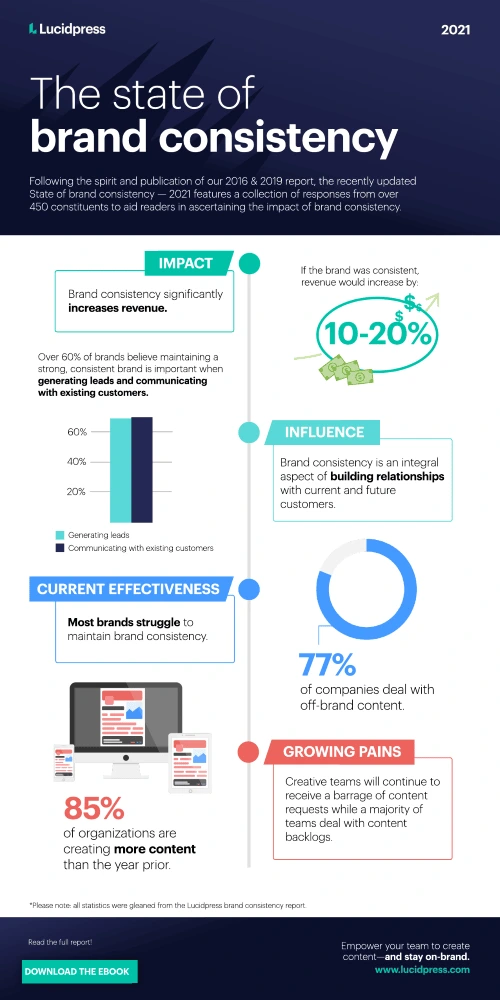
Branding is crucial to every business, but it’s so much more than a few colors, nice fonts and a fancy logo. It tells people that you care about what you deliver, that you live up to what you promise, and it shows off a glimmer of your personality — after all, it’s the make-up for your public image; an identity that people can relate to.
Managed well, branding can meet customers’ expectations and drive your authority through the roof. You’ll see a surge in new customers, leads, and conversions if you do one thing to your entire brand: make it consistent.
Here’s why brand consistency is important, and four ways you can put your business in the hall of fame for excellent brands.
What is brand consistency?
To be consistent is to be reliable — and when you’re reliable, you’re also recognizable and more likely to earn new customers or repeat ones because you’re front and center.
Brand consistency is the act of delivering the same brand messaging, voice and visual elements in every graphic, and piece of content. This ensures visibility and recognition within your target audience groups, so you stay top of mind, especially when they need you most.
Why is brand consistency important?
Think about one of the world’s largest sportswear brands. You see a check and instantly think of Nike, right?
You associate Nike and their logo because they’ve been consistent with it. After all, you’ve seen their signature tick on every piece of clothing they produce.
A brand is what people will remember most about your company, so it needs to be representative, strong, consistent and instantly memorable if you want to make a lasting impression.
You want to be their go-to company: customers should feel as though they could recommend you to friends and family, or call on you when they need additional products or services. Plus, your customers expect great design and consistent branding. For today’s customers, consistent branding and good design are key components when evaluating whether or not they do business with you.
Overall, constituents from our survey estimated that if their brand was consistently maintained, they would expect to have a 10-20% increase in overall growth, which in turn offers companies the additional revenue required to hire much-needed staff members or access to technology or software they otherwise might not have.
Ultimately, brand consistency has an extensive trickle-down effect that, when implemented correctly, can boost your bottom line, brand status, and employee morale. But unfortunately, inconsistent branding jeopardizes all that.
Impact of inconsistent brand usage
When you’re building a brand, the last thing you want to do is confuse the market. Those people could be your perfect customers: ones that drive your business’s bottom line and deliver great ROI on your branding efforts.
However, not using a consistent approach to your brand could limit your chances to generate leads or sales. That’s because people buy from brands they connect with, and brands which feel authentic. It’s hard to connect with a brand that doesn’t have a consistent appearance.
Advice from brand managers on maintaining brand consistency
How to maintain brand consistency
So, you’re looking to keep your branding consistent at every stage in your customer’s journey. But how do you do that, and which elements should you focus on?
1. Set branding guidelines for your company
Branding guidelines include details about your tone of voice, preferred professional terms and general code of conduct. Every business should have one, no matter their stage in the journey to perfect branding.
But once you’ve created them, don’t let them slip.
While 85% of organizations have brand guidelines, only30% are consistently enforced… hence why these companies aren’t seeing results. [] Not only does this mean time creating them is wasted, but staff might not understand your true brand, which will make it hard to stick to.
Treat these guidelines like the core of your entire branding activity. It’s a central document that all members of staff should use when creating marketing materials or representing your company.
2. Give staff a branding masterclass
We can all relate to the feeling of sitting in an hour-long meeting which could’ve been a 15-minute email conversation. That’s the beauty of office life, right?
However, as soon as you’ve created your branding guidelines, you’ll need all members of staff to be onboard. You can do this by giving them a brand masterclass meeting, detailing everything they need to know about the business’ history, core values and tone of voice.
Once this masterclass is over, everyone will be on the same page. Store your brand guidelines centrally and remind staff to check back on this document if they’re unsure about how to represent your brand.
Say goodbye to a mismatch of marketing messages that confuse potential customers, and hello to consistent branding. Whether staff are speaking with a customer or crafting a blog post, each stage in a customer’s journey will be perfectly branded when staff understand what you’re trying to achieve.
3. Provide staff with branding resources
All staff have been given a branding masterclass and understand what your brand is about… but how can they maintain consistency if they need to create things for external use?
The answer: provide them with branding resources.
Think about the marketing material that your customers will see. Whether it’s social media graphics or whitepapers, branding resources can keep these consistent and avoid confusing potential customers.
In the same folder as your branding guidelines, provide staff with:
- Font names
- Logo variations
- Graphics
- Color palettes
You can also create branded templates to save time and keep a high level of consistency. Lucidpress offers a large assortment of free brochure templates, social media templates and more.
4. Think wider than your website
Did you know that the average revenue increase attributed to always presenting the brand consistently is 10-20%? You could see a huge uplift in revenue if you’re always referring back to brand guidelines—not just for your website.
Many businesses assume that a logo and a website are enough to put the cherry on the branding cake. They think a simple website theme is enough to give a great customer experience, but that couldn’t be further than the truth.
That’s because every stage in your customer experience should be branded in order to maintain consistency. So, think about the typical journey that your customer has. That might be:
- Found your site on social media
- Visited your website
- Subscribed to your email list
- Purchased from you
…But if your branding isn’t consistent across the first three platforms, a purchase is unlikely to happen. Remember how we said people buy from brands they feel connected with?
On social media, it’s easy to just rattle off a series of posts to make it look like you’ve been doing it for years. But remember: all communications need to be consistent. Consumers are savvy—if there’s an out-of-place tweet that doesn’t fit your brand, it’ll stand out like a sore thumb.
People will wonder what is going on if you don’t have a consistent voice. They won’t know the team behind your company (or trust them), leading to asked questions and cash spent elsewhere.
Key takeaway
Once you’ve implemented these five steps into your branding efforts, you’ll soon see a surge of results. From paying customers to feedback like, “I love everything about your brand!”, remember that consistency is key.
Stop changing your message repeatedly and losing your customers’ interest. You want them to remember your brand—not forget it.
For a real-life example of a company mastering their brand consistency, read about Club Pilates and their experience using brand templates here.
Want to know more about the power of brand consistency and the impact it has on your creative teams, brand reputation, and more? Download our 2021 state of brand consistency report and gain insight into helpful analytics and key takeaways to ensure your brand stays consistent and visible.
*Please note that while we provide insights and tangible takeaways, this survey and corresponding ebook are designed to shed light on the intricacies, theory, and data science behind brand consistency rather than provide hard-and-fast facts. Each company, and therefore branding, is bound to encounter unique obstacles relative to consistency.
The digital customer experience is the quality and sum of all digital interactions a consumer encounters with a company. This includes the company’s brand, products and services.
Unfortunately, some companies are still struggling to achieve a productive digital experience. Good digital experiences can lead to more sales, more loyalty and even more customers. On the other hand, poor digital customer experiences can cause a loss of sales by frustrating customers and ultimately driving them to competitors.
With a good plan of action centered around digital customer experience and the aid of digital experience management, businesses will be better equipped to achieve growth.
What is digital experience management?
Digital experience management is the software, product or service that helps you track, monitor and analyze your customers’ experiences.
Digital experience management helps you connect the dots between the digital experience and customer expectations, and in turn provide customers with the experience and content they need.
Digital experience management platforms
The more insight you can gain from your audience, the more informed and strategic your content and digital experience can be.
So, in order to create an effective online customer experience management strategy (and therefore nurture a memorable digital customer experience), there are a few digital management platforms worth leveraging:
- Liferay DXP
- IBM Experience Manager
- Adobe Experience Manager
- Core DNA
- Lucidpress
Why digital experience management matters
Brands are struggling to differentiate themselves in today’s crowded marketplace. Consumers encounter multiple brands across multiple countries all offering the same goods or services.
Because of this, you need to give consumers a good reason to choose you over all the other players. In fact, many experts believe that successful customer experience will become more important than product quality or price when differentiating one brand from another. Keeping this expert prediction in mind, it’s clear that digital experience management matters more than ever.
Elements of a great digital customer experience
When crafting a digital experience, include the following elements in your strategy.
Consistency
When your customers open up your website, Instagram, Facebook or Twitter page, they expect to see consistency. The same message, layout, logo, etc. Customers expect this consistency no matter the location, device or channel they are using. This consistency is especially important if you are delivering rich media. Today, brands have defined “best practices” across all channels to ensure consistency in the online customer experience. These best practices can include responsive design and well-known concepts among others.
Usability and accessibility
According to Forrester, 61% of U.S. online adults state that they are less likely to return to a website if it doesn’t provide a satisfactory experience. Based on this alone, the digital experience you want to create can be your greatest competitive differentiator. Improving the usability and accessibility of your channels can maximize functionality while also positively affecting lifetime customer value. And don’t forget that no matter how sleek and shiny your design looks, if customers are stumbling along the way your pretty design won’t help provide a good user experience.
Convenience
In the digital world, consumers prefer to find their own answers rather than call someone for support — a large majority of people now expect companies to offer self-service options. Because of this, a great digital customer experience gives consumers the option to interact with your brand with little human interaction. Overall, the brands that rate the highest in terms of customer satisfaction do so because they offer self-service options along with a seamless experience when moving across channels.
With customers using mobile apps and smartphones to make payments, purchase products, schedule appointments, access information, book travel and more, self-service is more important now than ever. Consider restaurant apps like Chick-fil-A or Starbucks, customers can place an order ahead of time and also manage their loyalty points all through the app. Nearly 16% of Starbucks purchases are made through the app alone.
Personalization
Studies have shown that having a large number of options can make it harder for customers to make a decision. Accenture collected data that indicated an increase in frustration from customers’ online experiences. Their data showed that 48% of consumers have left a website only to purchase a similar product elsewhere simply due to a poor digital customer experience. Alternatively, 91% of consumers were more likely to shop with a brand that remembered, recognized and provided them with relevant recommendations and offers.
Your business can harness machine learning to better gain insights into consumers’ needs and wants in real-time. The growth of artificial intelligence (AI) in recent years has provided us with exceptional technology to better help us create digital experiences that focus on individual customers. This alone can help differentiate your brand from your competitors by providing accurate insights into your customers in order to give them a personalized and meaningful interaction. In addition to this, machine learning and big data can help ensure that your message reaches the right customer on the right channel and in the right format. It can also help you utilize insights and recommendations on consumer behavior and industry trends.
Deliverability
Another element of great online digital experiences is deliverability, better understood as the amount of effort a user experiences when navigating through your channels. The ultimate goal of deliverability is for you to empower your customers to accomplish their goals and feel good about it. Every turning point in their customer journey should be designed to deliver exceptional digital experiences centered around your brand’s promise. One survey provided statistics showing that only 11% of customers who experienced a complex transaction were likely to continue with purchasing the product. On the other hand, 68% were more likely to purchase when experiencing a low-effort transaction.
Related: 9 ways to improve the customer experience
Steps to develop a digital experience program
Along with the elements above, follow these steps to develop digital transformation through an excellent digital experience program.
Objectives then solutions
As you develop a digital experience program, begin by focusing on your business objectives first, then worry about solutions. Common objectives for many companies include:
- Deliver a better digital experience
- Understand the customer experience
- Differentiate on the customer experience
- Listen to your customers
As you look more into differentiating the customer experience, you may want to consider accessing outside help from customer experience consultants.
Omnichannel
An omnichannel approach to your program can help you succeed in providing a consistent and cohesive experience for customers across all channels. Make sure that you design your program in line with all other channels that your brand utilizes, from brick-and-mortar shops to mobile apps. By delivering a consistent omnichannel user experience you can improve your reputation and build trust among consumers.
Customer Journey
Mapping the customer journey is paramount when developing a digital experience program. In order to do this effectively, you will need to identify key turning points between the consumer and your brand that ultimately shape brand loyalty and perception.
Use the customer’s journey to localize where customers are getting stuck or where they are enjoying the experience. And don’t just do this at the end of the journey or when you’re starting to see your revenue tank. You should be mapping the customer journey often and always. Just as ecommerce continues to evolve, your own brand will need to evolve to better meet customers’ needs and wants.
Diagnose
As you map your customers’ journeys, take the time to also track and diagnose problems, existing and potential. You need to find which journeys are common and diagnose the most common problems within them. Additionally, you will need to find what resonates with your customers. Through diagnosis, you will want to capture high-level metrics such as the goal of your website or app visitors, along with the likelihood of them returning to your site.
Customer experience — the summation of every interaction a customer has with your brand — is critical. A great customer experience translates into satisfied customers, therefore boosting customer retention, improving the reputation of your business and elevating your bottom line.
Today’s brands have to develop a trusting relationship with their customers to continue to grow, and the majority of CMOs recognize the importance of customer experience (CX). But implementing an effective customer experience strategy that flows seamlessly from touchpoint to touchpoint and department to department is easier said than done.
How to improve the customer experience
Naturally, creating a memorable and good customer experience can feel challenging. But like any large project, you just have to break it down into smaller bits and pieces. To help you navigate it, we’ve compiled eight tips you can undertake to enhance the customer experience within your company.
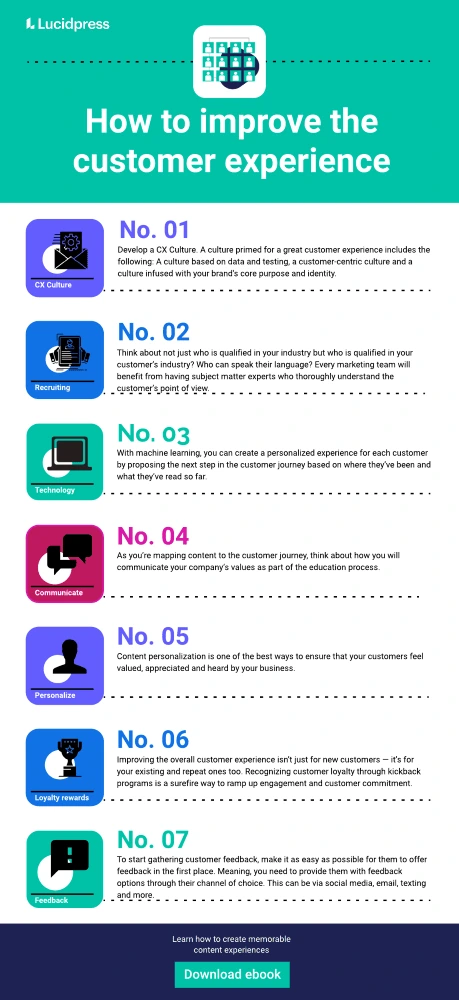
Develop a CX culture
Since every employee is a potential touchpoint for failure in a customer experience program, customer experience has to be infused into the very DNA of your brand. Successful companies develop a culture where customer experience can flourish.
A culture primed for a great customer experience includes the following:
A culture based on data and testing
Gone are the days when a persona based on intuition and sweeping generalities is enough to produce a relevant experience. Instead, every team must learn to collect and use data to understand the customer as people. Then use that data to create experiments to see what experiences best resonate with customers and which ones fall flat.
Creating a culture that embraces diversity and inclusivity for many different perspectives opens your organization up to be more empathetic and understanding of your customers’ point of view. Not only does it give your employees the language and tool kit to know how to understand your customers but it also creates an environment where employees feel heard and cared for opening them up to extend that same feeling to the customer through great customer service.
A customer-centric culture
Creating a customer-centric culture sounds like a given for any company prioritizing CX, but according to the CMO Council, “Only 14% of marketers say that customer-centricity is a hallmark of their companies.” One reason for this is the majority of metrics and compensation plans still focus on sales or the product rather than customer service and success. Developing trackable metrics for every team that ties directly to the customer experience will put the customer front and center in the minds of every manager and employee.
A culture infused with your brand’s core purpose and identity
A great customer experience strategy should be intentional, which means your brand’s core purpose should be easily identifiable and should influence every decision made by every department. Adoption of a brand’s purpose starts at the top and must be an ongoing conversation to ensure it becomes a part of the company culture rather than a nice saying on the wall.
Shift Your Recruiting Mindset
You also need the right people on your team. These folks are an essential part of making sure that your customer experience is the best that it can possibly be. Because, at the end of the day, if your employees aren’t paying attention to the needs of your customers, you’re never going to be able to create the kind of customer experience you want.
Think about not just who is qualified in your industry but who is qualified in your customer’s industry? Who can speak their language? Every marketing team will benefit from having subject matter experts who thoroughly understand the customer’s point of view.
Find people who are right-brained and left-brained– people who can understand the CX data points. A marketing team that’s both creative and analytical will be better able to understand and apply customer data.
Beyond the marketing team, every addition to the company should be hired for customer orientation. Make it a mandatory part of the interviewing process for every hiring manager. This not only ensures you’re getting the right talent in place but also re-enforces a customer-centric culture.
Use CX technology
CX technology plays a critical role in understanding where people are at in their customer journey. Start by developing a centralized command center to unify global data. Data silos limit your ability to see the entire picture and can create disjointed experiences.
With machine learning, you can create a personalized experience for each customer by proposing the next step in the customer journey based on where they’ve been and what they’ve read so far.
Many organizations have experimented with customer-facing bots to provide instant one-to-one interaction. However, agent-facing bots can also be a great tool to help coach customer service agents to answer questions faster and improve customer service.
A brand templating platform democratizes the content personalization process, so anyone on your team can quickly create professional, personalized content.
Communicate values
Creating content that is relevant and insightful is an important part of the customer journey, but today’s buyer often prioritize working with companies that share their values over the product’s value proposition or price. As you’re mapping content to the customer journey, think about how you will communicate your company’s values as part of the education process.
Hubspot, for example, communicates openly about their culture code and how they’ve actively worked to create a place where their employees love to work.
Personalize content to the customer
You know your customers, or at least you think you do, right?
For the most part, yes. Most successful businesses will already have a strong idea of their customer base, but it’s not enough to think about this in terms of broad strokes.
Your customers offer unique insights and highly informative data sources — from conversion driver and motivating factors to content funnels and more. You must pay attention to your customers’ habits and preferences.
You’ll want to create a detailed profile of your average customer. Use reference points like:
- Demographics
- Occupation
- Income
- Behaviors and preferences
- Goals
- Pain points and motivations
- Objections to sale or purchase
- Channels of choice
Once you’ve done that, you’re in a much better position to personalize the content based on how you can meet your customer’s needs. Content personalization is one of the best ways to ensure that your customers feel valued, appreciated and heard by your business.
Unsure how to personalize your content? Try customizing:
- A call-to-action
- Geolocation pages
- Industry-specific content
- FAQ or help center content
- Personalized email or direct mail campaigns
At the end of the day, this kind of targeted experience makes everything feel much smoother and more effortless for your customers.
Related: How to create a great digital customer experience
Customer loyalty rewards
Improving the overall customer experience isn’t just for new customers — it’s for your existing and repeat ones too. Recognizing customer loyalty through kickback programs is a surefire way to ramp up engagement and customer commitment.
That said, loyalty isn’t just about giving out discount codes: there are other ways you can gather customer loyalty by highlighting that you appreciate and value their opinion, as well as their purchase. For example:
- Offers or discounts
- Members-only promotions
- Customer preferences (based on membership tier)
- Early access (based on membership tier)
- Customized services (based on membership tier)
- Promotional updates to products
- Referrals
- Surveys
- Reviews
- Feedback quizzes
- Satisfaction quizzes
Loyalty rewards are a wonderfully simple way to make sure that everyone — from a brand new customer to someone who has been connected to your business for years — feels as though they get something in return when they choose to do business with you.
Pay attention to customer feedback
Understanding your customers isn’t terribly difficult. But unfortunately, a lot of marketing leaders find themselves wondering what customers do and don’t want from them — and how they can acquire that information.
The solution is pretty dang simple: your customers will tell you. But they’ll only tell you if you give them that opportunity.
To start gathering customer feedback, make it as easy as possible for them to offer feedback in the first place. Meaning, you need to provide them with feedback options through their channel of choice. This can be via social media, email, texting and more. Find out what makes the most sense for a majority of your customers and customize it from there.
Ultimately you want to ascertain customer opinions — what do they think is going well, what went wrong, and what could be improved. Doing so will give you a solid grasp on the direction your business is moving, and it allows your customers to feel as though they have a great deal more agency in the direction of your business, too.
Pre-empt solutions
Of course, if you want to be sure that your customers are always having the best possible experience with your business, you need to be able to predict and preemptively deal with any and all problems. This means carefully testing your various user experience touchpoints to make sure that they always function properly and dealing with any potential problems as quickly as possible.
A final note on how to improve the customer experience
This might seem like a great deal of effort in a lot of different directions just to focus on one specific element of your business. But the truth is, the experience your customers have with your business is simply too important for you to ignore.
If you’re not able to nurture an improved customer experience, then it won’t matter how great the other elements of your business are. You could be running the most efficient business in the world with the most incredible product, but that doesn’t matter if the experience of interacting with your business isn’t a pleasant one for your customers. Without this essential ingredient, your business simply won’t be able to reach the kinds of heights that you know it to be truly capable of.
Elevate your content experience with Lucidpress.
Few things are more stressful than trying to navigate the healthcare system, and if patients have a bad experience on top of that, it adds to their stress and can even slow the healing process. While providers are primarily focused on health outcomes, a focus on improving patient experience is equally important.
Why patient experience is so important in healthcare
Research shows that high rates of patient satisfaction correlate directly with good patient outcomes. The bottom line is that patient experience is inextricable from the quality of care.
Aside from quality of care, patient experience is a huge factor in your reputation as a healthcare provider, and it influences whether your organization is recommended and well-reviewed (or not) by patients. If a patient has a bad experience with a physician and goes on to leave a bad review online, this could dissuade a lot of future potential patients from visiting your clinic. To put it another way, patient experience has a direct effect on your financial success — and in the highly competitive world of healthcare, that really matters.
How does patient experience influence patient outcomes?
A patient’s experience will have a great effect on how they’re feeling emotionally, and a person’s mental and emotional health affects their physical health. Simply put, if someone is stressed out and unhappy with the care they’re receiving, they’re less likely to get better quickly.
Imagine yourself in a less-than-ideal patient experience scenario: You don’t feel well and you’re waiting for test results while you lie in a hospital bed under a scratchy blanket. The doctor mispronounced your name, didn’t go into much detail about possible diagnoses and didn’t have time to answer your questions. You can hear another patient moaning out in the hallway, unattended. You’re scared, uncomfortable and unsure if you’re getting quality care. What you need to do is get some rest, but sleep feels impossible.
Good patient experience is about giving people the support they need to improve health outcomes — whether that support is attentive staff or a quiet, comfortable space.
We’ve pulled together five tips to get you thinking about how to improve patient experience at your organization.
5 ways to improve patient experience
1. Take a holistic healthcare approach
Borrowing a page from holistic healthcare’s book can create immediate, positive changes in patient satisfaction. Holistic health considers mental, spiritual and emotional health, as well as a patient’s physical health. Offering resources that support a person’s whole health can create the groundwork for healing.
Provide patients access to counselors and mental healthcare professionals if needed. Working with a therapist through a difficult time like a cancer diagnosis can be essential in helping patients cope and follow a treatment plan. Encourage regular visits from friends, family and church leaders to boost patients’ spirits. Put resources toward maintaining calm and inviting prayer and meditation spaces.
Keeping patients connected and engaged in other aspects of their health will help them deal with their illness and make them feel that they’re receiving good care.
2. Make the most of patient experience surveys
Getting feedback straight from the horse’s mouth, so to speak, is the easiest way to learn how your organization can improve patient experience. Gathering data can show you your organization’s weakest areas and potentially give you insight into creative ways to increase patient satisfaction. Consider customizing the standard HCAHPS survey to include questions about areas you’re particularly interested in.
If you’re seeing multiple responses about one department always running behind schedule or a certain physician with a cold bedside manner, you’ll have a pretty clear idea of where to focus your improvement efforts.
Don’t discount the true experts on patient experience — the patients themselves. Regularly surveying patients will let you evaluate individual staff, as well as teams, departments and facilities as a whole.
3. Create personalized patient experiences
Uncertainty causes stress. The uncertainty of what’s going to happen at the hospital and what a diagnosis means for your health is a big factor in the stress associated with health problems. Do what you can to eliminate uncertainty by making sure your organization offers consistent, personalized communication for patients every step of the way.
Here are a few ways you can use personalized communication to improve patient experience:
- Simple, printed handouts that are personalized with a diagnosis and contact information for their doctor can make patients feel at ease.
- Provide patient education brochures that include information about a patient’s specific condition, next steps in their treatment plan, future appointment times and locations, medication instructions, tips to alleviate symptoms, etc.
- Even things like doctors’ emails, notices on research studies, and flyers for hospital events and education programs can all be customized to give a cohesive look and feel to every department in your hospital.
Providing customized patient communication across your entire organization will let patients and their families know they’re in good, organized hands. They’ll be properly informed and know what to expect while receiving care at your hospital.
4. Foster employee engagement
A surefire way to increase patient satisfaction is to make sure patients are cared for by focused, committed employees. Staff who feel engaged at work are much more likely to be happy with their job and pass that on to the patient.
Employee engagement surveys are right up there with patient experience surveys in indicating the health of your organization. Soliciting employee feedback, and then listening and responding to it, is an important step in making your staff feel heard and valued. Take steps to offer regular, clear views into how employees contribute to your hospital’s mission. Give managers the training they need to create open, trusting relationships with their staff.
Focusing on employee engagement will pay off double in that you’ll end up with happier employees and happier patients.
5. Emphasize emotional intelligence
Feeling dismissed by staff or a physician is a common complaint among patients. Teaching your staff to provide kind, calm, compassionate care is one of the best ways to improve the patient experience.
Healthcare providers experience more than their fair share of stress, being subject to long shifts, unexpected events and life-and-death situations. Learning to manage their own stress and emotions can help your staff be better in tune with patients’ nonphysical needs. That way doctors and nurses will be able to accommodate and support patients as they deal with health problems.
Company-wide training for emotional intelligence can benefit every single person at your organization and make for an all-around more compassionate environment.
Improving the patient experience will take a comprehensive effort. Thomas H. Lee, MD, a primary care provider at Boston’s Brigham and Women’s Hospital, put it well when he said, “The real goal has to be cultural change.”
When it comes to marketing, every team has its challenges. Amongst non-profit organizations, however, those challenges can be vast.
Bound to a tight budget, small teams and few resources to draw from, it may seem near impossible to create a successful marketing strategy to help your organization grow. For some, it may not be clear why a marketing strategy is necessary — you’re not working for profit, so why market at all?
Marketing is more than just getting sales and boosting the bottom line; marketing creates valuable, memorable experiences that positively impact people for the long-term and, therefore, impact your business.
You may not be looking to use your marketing goals to pull in revenue, but the right strategies will still work to bring in traffic (think new supporters or donors), funds and awareness to your mission.
We’ve created a quick how-to for creating a non-profit marketing strategy. By following these steps, you can grow your organization’s impact, and they won’t break the bank.
6 steps to creating a non-profit marketing strategy
1. Set marketing goals
Before you can do anything else, you need to set your marketing goals. These goals should focus on transforming your organization’s mission and objectives into actionable items.
For example, if one of your objectives is to bring clean water to rural areas of a particular country, you should brainstorm three to five marketing ideas for advancing that objective.
One way you could use marketing to advance that objective is to post on social media about your organization and the people you are helping or by sending a weekly newsletter highlighting specific families or individuals impacted by your work.
Once you’ve brainstormed, you should turn these ideas into goals. These goals should be measurable, with specific steps to help accomplish your overall objective.
To provide another example, you could state that one of your goals will be to see a 20% boost in traffic to your social media channels by posting X amount of times a week or month and by interacting with X amount of people on those platforms.
2. Create personas
A big part of marketing is understanding your audience, and one of the best ways to do this is to create personas of your donors, volunteers and recipients.
It’s essential to define and understand each of these audiences because your marketing goals and strategies will differ based on which group you are addressing. For example, an email to a donor will have a different message than an email asking for volunteers.
3. Complete research on fundraising psychology
Being successful as a marketer includes having a basic understanding of human sociology and general psychology — when you know why people behave the way they do, you can start to create content they will identify with and respond to positively.
It will do wonders for you to complete research on fundraising psychology, just like researching consumer psychology aids for-profit businesses. This research can help you understand why more people donate when a campaign is closer to reaching its goal or why some people are more inclined to helping an individual than a larger group.
4. Craft messaging
The next step for creating a non-profit marketing strategy is to craft your messaging. This step is similar to creating a jingle or slogan for any business.
You need to craft a key message that includes all the information your audiences need to hear, remember and hopefully share about your organization. You need to do this ahead of time, as it will help you keep your organization aligned. It will also simplify your marketing while keeping your different audiences organized.
5. Identify strategies and tactics
Although you may want to head straight for this step, setting up your personas and identifying actionable goals will make this step far easier and more successful. At this point, you’ve answered the who, what and how of your key messages and audiences.
Now, you will identify which channels you are going to use. These can include social media, email marketing, events, blogs, etc. Once you decide which channels you plan to use, you will work up the strategies and tactics you plan to use on these channels (we’ll dive more into strategy specifics in the next section).
6. Measure results
It would be silly to implement any marketing strategy without a plan of measuring its success or failure. Doing this step will help you iron out any kinks and further solidify your non-profit marketing strategy. Regular analysis will help you figure out what is working and what isn’t.
Non-profit marketing strategies
The following are the best non-profit marketing strategies that will help you grow your organization’s impact.
Focus on relationships
According to Emily Logan, a longtime activist — as well as a non-profit growth and advocacy strategist — focusing on relationships is one of the most important things a non-profit can do long before asking for anything.
The emotional connection you make between your cause and potential donors can have a more significant impact on your organization than anything else.
It’s not easy for people to part with their hard-earned money and according to VaynerMedia CEO Gary Vaynerchuk, “you can’t just expect someone to donate to your cause without bringing value to them first . . . it’s an open, transparent conversation and dialogue. You need to respect your target audience.”
Capitalize on current events and social trends
One great non-profit marketing strategy is to capitalize on current events and social trends.
Do you know what ALS is? You probably at least recognize the disease simply because of the ice bucket challenge that went viral years ago to help raise awareness of the illness and the search for a cure. The ice bucket challenge became a huge social media trend that everyone was participating in, from grandparents to celebrities. Current events and social trends can be one of the most accessible strategies to utilize when coming up with content marketing ideas.
Work with social media influencers
In tandem with social trends, you should start working with social media influencers.
“Influencer” is in their title for a reason, some of the biggest names have millions of followers, and you better believe that if Jane from Carlsbad tells all the middle-aged moms to go buy this nifty kitchen gadget now, they’re going to do it. People trust individual influencers, and if you can win over a couple who will be able to spread your message, you can make a significant impact.
But, you don’t have to take our word for it. Per studies conducted by TapInfluence, “influencer marketing content delivers 11X higher ROI than traditional forms of digital marketing,” and “influencer content on social media earns more than 8X the engagement rate of brand-direct content.”
Not sure where or how to engage with influencers? Start by looking for micro-influencers in your local community or within your network and then go for the big dogs.
Incorporate video in content marketing
Videos are a huge part of content marketing today, and it would be a massive loss if you didn’t utilize it in your non-profit marketing strategy.
In 2017, HubSpot research found that most people will skim written or audio content, but (more noteworthy) these people were “more likely to pay attention to video content.” You’ve probably already seen other non-profits using this tactic. One great example is Charity: Water’s video — This is Pipeline.
Be sure to follow best practices with video — they don’t need to be lengthy segments to be successful. Also, video also can be produced quite easily without breaking the bank. Apps like Adobe Creative Cloud are affordable ways for a non-profit to create and edit great video content.
Find ways to automate email and text marketing
Email and text marketing can be powerful tools to have in your toolbox. When people join your email or text lists, it’s an indication of their investment — as in they care about your cause and want to support you.
So, this likely means they’re receptive to seeing messages from you in their inboxes. To help you save time, start automating these messages. According to HubSpot research, Boomers and Gen-Xers prefer email or video content, so if they’re in one of your audience groups, you need to use email as a tactic.
Follow up after donations
It may feel small, but having someone follow up after donations can take your message a step further with donors.
It shows you care about them — remember you’re trying to build relationships — more than just their donation. According to research from Software Advice, 60% of donors want information about impact stories, and 46% of donors prefer a personalized letter.
Build trust with consistent branding
Consistent branding is a smart practice for any organization, profit, or not.
In a case study between Lucidpress and MHA, MHA’s Community Marketing Specialist knew they needed a solution to help unify independent messaging. MHA provides care, accommodation and support services for more than 16,000 seniors throughout Britain.
By using Lucidpress’s branding templates, they were able to streamline their messages and work seamlessly with their local homes, getting more done in less time. Having consistent, easy-to-use branding templates can save you a lot of time in the long run. Templates are easy to use for everyone within your organization and can be completely customizable.
Build your non-profit and your brand
By following these content marketing strategies of building relationships, capitalizing on social trends, working with influencers, incorporating video content, automating email, following up after donations and building trust through consistent brand, you will be able to grow your organization’s impact and start to see real results.
Just as MHA found help with Lucidpress’s customizable templates, other non-profits are also finding help with Lucidpress. To learn more, check out how YMCA was able to keep their brand consistent across every location with Lucidpress’s lockable templates.
Channel partners are a critical source of revenue for tech companies — but if businesses took a hard look at the experience potential customers have when working with a channel sales partner compared to an internal sales rep, those two experiences would be anything but consistent.
In fact, more than half of SE leaders aren’t confident in the delivery of brand consistency across channels during the sales process. This inconsistency comes from gaps between resources across content, technology, and training between businesses and their channel sales partners. Because of this, companies and organizations are beginning to invest more in their partner enablement plans, which has proven to provide 40% annual revenue growth for businesses.
What is partner enablement?
What exactly does this mean for your business and just what is partner enablement? Partner enablement (also referred to as channel enablement) is the practice of ensuring your partners can independently initiate and complete the sales process while also effectively implementing and supporting the customer solution. With so many different channel partners, it’s important to provide resources, templates, training and technology so there’s consistency for your brand.
Challenges of partner sales
As mentioned above, one challenge businesses experience with their partners and sales is that most enterprises provide more resources to direct sellers than channel partner companies. This can be detrimental to your partnerships, especially if your partners feel like you’re wasting their time or resources.
Another big challenge of partner sales is that indirect sellers find it 1.3x to 1.6x harder than direct sellers to get prospects to make a next meeting. Most partners tend to find they have a harder time advancing the sales cycle than a direct seller. This challenge can stem from those gaps in resources mentioned before. These gaps can also stem from the fact that most sales employees are more thoroughly trained than partner reps — companies tend to provide sales employees with the necessary software, templates and devices needed to grow and succeed.
Strategies of partner enablement program
To create a successful channel partner program, you need to have some solid strategies in place. Check out the best strategies below:
Get feedback from your current channel partners
Because you most likely work with partners of all different shapes and sizes, it will be difficult to appeal to them all. Talking to your partners will help you create better services and products, while also finding out how you can help them succeed. Do they need training videos? Would they benefit from incentives or award programs to up sales? Don’t guess.
Provide training
Training will help increase the skill of your partners, helping them become more productive and expanding. You can provide training in several different ways including sessions during office hours where partners can ask technical questions, or a more formal training session like webinars, certifications, or traditional seminars. If you do provide online training, note that research shows you’ll be most successful with videos of 6 minutes or less.
Another way to provide training is to try gamification. If you’ve ever had to do online or technical certification training, you know that it can be boring. Turning training into a game with a ladder of certifications can make training more appealing.
Give recognition
Our need for recognition is universal. A great example of the success of this concept is Microsoft’s Partner of the Year Awards. You can start with a simple MVP award and promote in webinars, training videos or even on your website. Offering recognition like this is an easy way to engage partners and help them connect with your brand.
Sales enablement content
Providing sales enablement content has been proven to boost conversion rates. Companies that deploy sales enablement platforms to their partners are up to 2.3x more effective at achieving their sales goals. By offering sales enablement content you are guaranteeing that all of your channels provide a cohesive brand experience. And as we mentioned earlier, sales enablement content can lead to 40% higher revenue growth. With this content, be sure to provide branded templates that channel partners can quickly find and customize.
Brand templates can help your teams maintain brand consistency along with easy asset storage and access. Our channel management software can help you build a library of content that not only your employees can access but also your partners. With lockable templates you can guarantee that your content and brand will appear consistent throughout all channels while enabling channel partners to customize content for their prospects. A lack of cohesiveness is detrimental to brands today, and Lucidpress makes it easier to keep teams, partners and vendors all on the same page.
As you start to create a channel partner enablement plan, don’t forget to focus on consistency, which will ultimately help your brand expand. For more insight on brand consistency, check out our guide on how to achieve consistent storytelling across sales.
The long tentacles of coronavirus have touched every aspect of our lives, and especially so for the mortgage industry. It’s not clear where the housing market is going to end up, but right now things are busy.
For consumers, there’s the allure of rock-bottom interest rates, while many people are also facing new, stricter standards for loans. And others are apprehensive about making any moves, literally and figuratively, when the economy is so volatile.
It’s predicted that mortgage lending will reach a 14-year high in 2020. With the surge in refinances, you may find yourself busier than ever. So this is good news… right? We’ll take our silver linings where we can get them.
Amidst the hustle and all the uncertainty, you may be looking for ways to reassure clients, build business, set yourself apart, and work efficiently so you can handle what lies ahead. We’ve thrown together our best tips and ideas for mortgage marketing to help you navigate that new normal.
Behind every loan officer, there is a strategy
Keep these four things in mind as you polish your mortgage marketing strategies.
Be human
Buying a house is enough to make anyone anxious… combined with the stress and unknowns of the current world climate, you’ve got a recipe for, well… even more stress. Doing your best to be as real as possible (aka “human”) can make your clients feel a little better about navigating the mortgage market during what feels like the apocalypse.
Research shows that over 75% of people expect a business to understand their needs and situation. Show potential clients that you can empathize with their worries by simplifying the mortgage process as much as possible. Review your marketing materials and see where you can decode or simplify the language.
But what does being human mean in the context of marketing? You may be wondering, “Aren’t I already human?” Good question. Being human simply means, speaking plainly and communicating with clients in the same way they communicate with you. It means not sounding like a marketer or loan officer. For example, instead of focusing solely on numbers and low interest rates, translate that to what it means for the client. Maybe “Save X% on your monthly payment,” becomes, “Now you can put $X more in your savings account or toward a new car.”
Ideally, all of your communication —everything from the way your company messages itself to how loan officers speak with clients — should be presented in a way that’s accessible, compassionate and personable.
Leverage your visual content experience
Make sure you’re paying attention to your appearance, so to speak. Unfortunately, people do notice the inconsistencies that pop up across your website, social media and printed materials. A study from Salesforce noted that 75% of consumers have come to expect consistency from businesses and brands “with 73% likely to switch brands if they don’t get it. Customer loyalty — and attrition — is determined by every experience. Predictive, anticipatory service is increasingly the norm.”
With large brokerages like Rocket Mortgage becoming more familiar to consumers (and making the market all the more competitive), smaller operations need to throw some resources into branding and customer experience. Maintaining a consistent brand, in both design and voice, can reassure clients of your quality and trustworthiness, which helps your organization stand out in a crowd.
Evaluate where brand inconsistencies are stemming from. Do you need to update your brand style guide? Are brand assets easily available to everyone? Are brokers creating off-brand content? Consider solutions like design templates for brokers that have branded elements already in place. Empowering everyone at your organization to make their own, on-brand content can cut down on the noise and inconsistencies you’re seeing across marketing channels.
Get cozy with digital marketing
Putting together a solid digital marketing plan is key for generating new leads. And social media will offer the most bang for your buck.
We recommend building a solid content plan for LinkedIn — this is where you’ll find real estate agents, brokerages and builders that you can connect with to grow your business. Facebook can also be a great platform for reaching homebuyers — but LinkedIn is the best place to expand your circle and show other people in the industry what your business is about.
Social media is designed for building community, and it’s an ideal place to connect with new people. Taking small steps like reposting listings from agents you’d like in your network and commenting on content that’s interesting to you can help your business grow a healthy following.
Have you helped anyone land their dream home lately? Posting about client success stories makes for feel-good content that people like to see in their feed. Keep the content you post diverse and engaging with a smattering of home-buying tips, mortgage knowledge, property listings, industry news, and anything else that piques your interest.
Automate where you can
Staying on top of digital marketing is no small task — especially if you haven’t got a team to help. Automation could be your best friend, and luckily, there’s not much you can’t automate these days.
- Email — Emails can be easily automated, and it would be a great time to do, say, an email drip campaign about refinancing. Over the course of a few emails you could talk about the benefits of refinancing right now and what the process entails from start to finish. Look into a tool like Mailchimp, which is designed to help smaller businesses automate email campaigns and reach customers without doing much heavy lifting.
- Social media — You can also set up your social media posts to be automated by a tool like Buffer. Automation platforms like this will post content for you based on a schedule you set, and they even have tools that analyze how your content is performing. Good analytics can be helpful if you feel like you’re not getting enough engagement or want to tweak your social strategy.
- Content creation — Certain design platforms (like Lucidpress ?) also offer data automation, which can be invaluable for customized marketing campaigns. Data automation lets you connect to spreadsheets or even your MLS — then you can quickly upload a bunch of information to marketing materials as needed. This is an easy way to create custom collateral for your clients that won’t cost you any extra time or energy.
Take a look at your current marketing campaigns and see what you can automate. Automation will free up your time so you can focus on more pressing things or even brainstorming your next big marketing venture.
However you decide to implement mortgage marketing ideas for the new normal, be sure that your strategies support any long-term goals you might have for your company. Conduct an audit of your existing business continuity plan to see where any of these ideas fit in. Alternatively, it couldn’t hurt to create a new business continuity plan if yours might be a bit outdated. And, if you want to do a deeper dive on how you can strengthen your brand, check out our free ebook on brand consistency and how it impacts your ROI.
We love a good yarn — and it turns out, consumers do too. The popularity of brands telling their stories continues to grow and grow. It’s a win-win marketing strategy when you can give your audience engaging content and tell the story of your brand’s history, vision, values and goals.
The bar for good content marketing is certainly high these days, with some brands, like Mailchimp, expanding into podcasts and even streaming video series. But you don’t have to be a huge brand with a big budget to tell your story. We talked to brands large and small to see what they’re doing to connect with customers.
Read on to see how brands including Zendesk, Buffy, and Chanty are finding success in their approach to brand storytelling.
Be authentic
For content to really connect with customers, it needs to be authentic and true to what your brand is all about. We interviewed Suzanne Barnecut, Group Manager of Content Marketing at Zendesk to find out how her team takes on brand storytelling.
Suzanne is the editor of Zendesk’s multifaceted content venture, Relate, and spoke to us about creating content that’s people-focused, sales-free, research-based and, above all, authentic.
How do you strike a balance between being personable, maintaining brand voice and inspiring your target audience?
“Relate is focused on where technology meets the human experience. It’s our space to focus less on the tools and more on the people using technology to build better customer experiences and relationships. Our audience may be business leaders, but at the root of it, we’re all just people trying to be effective and more empathic with our teams and customers. So, in a way, our mission as a publication makes it easy to hew to our brand voice — which is that we’re trying to write toward human experiences in an honest, straightforward and personable way.”
Relate incorporates content, a podcast and an annual event. How do the three work together and relate to one another?
“The Relate subbrand has undergone a pretty significant transformation as we’ve grown as a company over the past 4-5 years. What began as a small, intimate event series and storytelling podcast grew into our annual flagship user conference and a customer experience podcast called Repeat Customer. The relationships are dynamic (as relationships naturally are), but the publication and event overlap to provide thought leadership and insight from our leaders and other experts in our space, to examine the wider trends that impact our customers, and to share content that reflects our brand values and point of view. And in all cases, we love to tell stories about the cool things our customers are doing, both with their customers and in the world.”
How does Relate complement the Zendesk product and website?
“The Relate publication is more focused on brand journalism and storytelling, so it’s a relatively sales-free zone. In that way, it functions as a nice complement to the product site and our more traditional corporate blog, which we call the Zendesk Library, where we publish more product- or operations-focused content and customer use cases.”
What research influences your content strategy? Is one source of data prioritized over another?
“We do always try and leverage our own data whenever possible. Our customers can opt-in to anonymously share data so that we can, in turn, share back industry benchmarks and trends with our customers. For example, we have been analyzing data from the Zendesk Benchmark to understand the impact of COVID-19 on customer experience and engagement.
Our content strategy is built around trying to provide useful content that addresses the questions or pain points that people actually have, and we believe that all our content should be informed by research — both our own and that of vetted experts and industry analysts — and by interviewing subject matter experts first-hand.”
How does your team measure success?
“We’re a data-driven marketing org, so we track our analytics pretty closely. Brand awareness efforts, like Relate, always have that hard-to-put-your-finger-on anecdotal value, but that can lead to tangible things like someone deciding to apply to your company over going somewhere else, for example. At large, though, we’re looking at some traditional consumption metrics — average monthly unique users, page views, organic growth — as well as some business metrics to understand our contribution to the pipeline (we have a multi-attribution model) and the opportunities we impact. This also helps us to know which content is resonating with our audience.”
What advice would you give to marketers trying to tell their brand story?
“Brand storytelling has to be authentic, so it’s never going to work to tell someone else’s story. Think about what your company is trying to do at its highest, most aspirational level. How and why did that journey begin — and where did it lead to next? Under that umbrella — whatever it is — there’s a wealth of stories waiting to be uncovered and brought to life.”
Start with a mission
Brand storytelling can make a brand bigger than just any one product. Buffy — a company that sells earth-friendly bedding and is on a mission to build sustainable business practices — benefited from starting with its mission first and its product development second.
We talked to Matt Breuer, Buffy’s VP of Marketing, and Blair Pfander, Buffy’s Creative Director, to see how doubling down on your mission can result in serious customer engagement.
Matt explained the company’s values-centered philosophy: “Buffy has been a mission-driven company from the start. We set out to create an earth-friendly, cruelty-free comforter and our product assortment has expanded pretty organically from that cornerstone idea. Our mission is to help our customers live comfortably without making the planet uncomfortable. The tough reality is that any company manufacturing new things today is by definition unsustainable; closing the loop on our supply chain by 2030 (an undertaking we’ve dubbed Closed Loop Comfort) is really the only way to show up for our values and take seriously our commitment to the planet.”
The brand shares its plan to achieve its mission openly — complete with a timeline and commitment to how the company will make itself even more earth-friendly.
Blair talked more about the impact of the brand’s environmental commitment: “We were thrilled by the level of engagement and excitement around our Closed Loop Comfort supply chain commitment back in April. It was the first time — at least in my memory — that we sent emails without any products on them — and customers were still opening, asking follow up questions, and reflecting deeply on the content. The world is a pretty scary place right now, and people have a lot of options when it comes to home goods and bedding, so the fact that they’re coming to us not only for marshmallow-soft comforters and sheets but for important conversations is meaningful to me.”
Buffy’s creative team turned to Instagram to develop a community around their focus on comfy, earth-friendly products with a notion they call “comfy content.” We were curious — how does the team come up with a steady stream of ideas?
According to Blair, “We find a lot of inspiration just from deep Googling and feed scrolling — artists we’re excited about, memes that make us laugh. The occasional 1970s gardening book scavenged on Etsy.”
The team meets once a month to chart a storytelling course both for product stories and culture stories. Blair continued, “It’s important to us that our community has a reason to return to the feed other than learning about what we make. Making sustainable education accessible and fun is something we’re dialing into more and more.”
We asked how the Buffy marketing team approaches keeping a consistent brand identity. Blair’s advice was to use your brand system as a starting point but then deliberately break the rules every once in a while. “We have a saying on the creative team: ‘Keep Buffy Weird.’ So just as often as we dial into our systems — scannable type hierarchy, saturated color, playful information design — we break it by adding an element that feels a little off, or even slightly surreal. The surreal factor is a critical differentiator for Buffy.”
Blair pointed to the brand’s “squishies” — videos showing hands mashing soft materials, like jello or brioche buns — as one example of Buffy’s weird, surreal and fun style.

Embrace (and review) the competition
Making your story stand out from the competition in a saturated market is one of the hardest parts of brand storytelling. Chanty, a team communication and collaboration software and Slack alternative, knows this all too well.
But the brand decided to embrace the confusion (and search volume) that comes with many products, multiple solutions and no clear answer on which to choose. Chanty built out comprehensive comparisons of other apps in their niche in the “Team Chat Wars” section of its blog.
We spoke to Jane Kovalkova, Chanty’s CMO, who told us the brand’s Team Chat Wars has built up their brand as the number-one resource for app comparison in their product category.
“This way, visitors come to our website not only to find out more about what we do, but to get an objective comparison of different team chat apps and how they help meet their needs. For example, we’re currently covering an article on Skype alternatives since we know that the topic gets quite a few searches, so we’re reviewing all of Skype’s competitors now. By reviewing, I mean actually testing them and writing down our experience.”
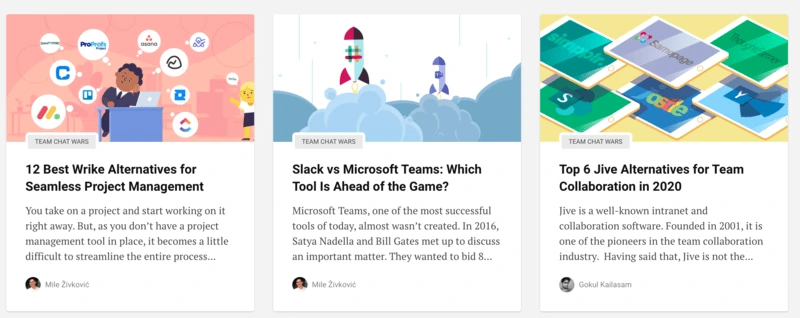
If you’re interested in doing product comparisons, Jane recommends preparing to put time and some money into it. “There are lots of ‘reviews’ out there by affiliate marketers that never even tried the products they review. Make sure to get some hands-on experience with the products you cover and do your best to give your personal impression. Of course, no opinion is objective (that’s why it’s an opinion), but people don’t want to read facts — they want actual experiences with a product, from a real live human being.”
SEO is (still) king
For businesses with fewer resources and a smaller budget, going beyond your product keywords and embracing your industry to produce educational content around search terms can build your brand in an affordable and sustainable way.
Online Degree — a company that offers free introductory college courses — has built out huge research libraries providing information on careers in multiple industries, types of college degrees and universities in every state in the U.S.
The founder and CEO of Online Degree, Grant Aldrich, told us “Brand journalism goes beyond a corporate blog. It provides the latest news updates and informational trends in your industry. It’s also a way to reinforce your mission and values to attract your target audience. In our case, we try to make higher education more accessible and affordable. Our goal is to help people find the best, most affordable educational resources with this kind of content. Not necessarily to drive people to use our services.“
Build community relationships
Natalya Bucuy, Content Marketing Writer at HelpSquad (a U.S.-based live chat service), takes an approach similar to Online Degree with her company’s B2B brand. “We believe that brand journalism that delivers useful content not only to current customers but to the small business community in general is an effective marketing strategy. Even if a piece of content doesn’t immediately bring measurable results, such as converted leads and new customers, it helps build meaningful relationships with the community. That, in turn, builds a strong brand presence that contributes to a company’s success in the long run.”
She pointed to an example of a recent post on Reddit her team created to drive discussion around behaviour psychology and the reasons behind procrastination that linked to a HelpSquad blog post that discussed the topic further. Reddit is notorious for being very picky about content quality and will sniff out any sales pitch, but this post hit mark with 99% upvotes and 73 comments.
Expert content can work in a variety of venues and help your brand increase its reach. It’s worth brainstorming where you can go outside of your own site and social media platforms to tell your brand’s story.
These inspiring strategies and brand story examples are proof that useful content with some outside-the-box thinking can lead to success. Your brand story, told consistently and creatively, could be just what your marketing plan needs. We’ve got some tips on how to get your whole organization on board for consistent storytelling: Check out our ebook The rise of the design democracy: How to maintain a consistent brand story.
When you think about Coca-Cola, what pops into your head — is it the taste? The fizziness? The dark caramel color? Maybe you think of a classic ad. If you’re like me, it’s the vivid red-and-white logo adorning the label.
Related: Is your brand outdated? When to do a brand refresh
When you think of all of these things, you’re thinking of Coca-Cola’s brand as a whole. If lots of different Coke-related images popped into your head just now, then Coca-Cola’s marketing team has done its job.

Too many people think branding begins with choosing a name and ends with picking a logo — but it’s much more than that. It affects everything.
So, when a company wants to rebrand, it’s not about just changing the logo. It’s also about changing goals, messaging, tone, voice, style and anything else that contributes to your image. It can be a tricky thing to get right, because ultimately, you can’t control what people think. But a well thought-out and defined brand is the backbone of many successful companies.
If there’s so much to it, why would anyone dream of rebranding? When is rebranding the best option?
Well, you could have gotten it wrong the first time. Many businesses overlook branding when they’re starting out and later find they need to rethink it. For some, they need to appeal to a broader audience. Others need to change tack when they decide to expand into other markets.
Long-established companies aren’t immune to the need to rebrand, either. It might be necessary after an acquisition or merger. Changing industries, attitudes and new competitors can also ignite the need for a fresh image. When a company needs to reposition or rejuvenate itself, rebranding makes sense.
Deeper issues, like an antiquated image or a negative reputation, can spur a rebrand. Sometimes, it can even come down to involvement in a damaging public scandal.
When you face challenges like these, you have two options. You can cling to the old branding that you had, or you can put together a rebranding strategy and work towards a new image.
Whatever the reason, make sure you have a strong case for the rebrand. Though there’s a lot to it, rebranding is part of the life cycle for many growing companies. Very few of us wear the same clothes now as we did in high school — so why wouldn’t a brand evolve as well?
Reasons to do a rebrand:
- You need to completely reposition your brand
- You merged with another company
- You significantly changed your product offerings
- You have a negative reputation
Reasons to do a brand refresh instead:
- You want to attract a new audience
- Your messaging is inconsistent
- Your company has evolved
- You don’t stand out from competitors
Considering the points above, it may be that you don’t need to go through an entire rebrand: Your current brand may just need some polish, also known as a brand refresh. A refresh is a much lighter version of a rebrand, and though they both entail a lot of the same work, a refresh simply updates your current brand instead of making the sweeping changes that a rebrand does.
If you’re still not sure if rebranding is right for your company, check out our rebranding questionnaire.
Rebranding strategy
Rebranding a company doesn’t happen overnight. You need a solid rebranding strategy, testing and approval, and then you need to roll it out internally before your big debut with your customers.
Here’s our advice on the five steps to follow to get rebranding strategies right.
1. Research before you rebrand
Before making any changes, you’ve got to do research to find out how your brand can improve. What do people like about your brand? How can it connect with modern consumers? There are endless questions to ask when building a new identity. The more knowledge you have, the more effective your rebranding strategy will be.
During this process, find out what attracted customers to your brand initially … or why they went to a competitor instead. Figure out the problems you need to address with the rebrand.
Coca-Cola once decided to rebrand, but its New Coke campaign flopped. Coca-Cola didn’t have any issues with its product’s taste or image, but it decided to change both. The result wasn’t an energized image but confused loyal customers. So, make sure to do your research.
Burberry’s rebranding strategy is a great example of how to strike this balance. After a century-and-a-half of success, Burberry’s image started to suffer when — through no efforts of its own — the brand became associated with gang wear and fashion for older generations. Thanks to this double punch, clubs in the U.K. wouldn’t allow entry to anyone wearing the brand’s iconic plaid.

Faced with this unsavory situation, Burberry decided to rebrand, but it did its research first. The company hired an anthropologist to rediscover its roots so that Burberry could highlight its heritage in a way that would appeal to younger audiences (while also disassociating its name from gang wear).
2. Set out clear goals
From your research, you’ll know what’s wrong, and this should help you figure out what you want to achieve. Burberry needed to disassociate its brand from gangs and build a modern youthful image.
Knowing it needed to appeal to younger audiences, the label added more modern styles to its line and recruited well-known celebrities like Emma Watson to promote them. This led to a boost in sales and an image readjustment for the brand, which once again became a luxury name.
There’s no point rebranding a business if all you change is the name. When it became The Shack, RadioShack did exactly this. The business wanted to stem the flow of losses, but a name change just didn’t cut it. Maybe if it had gotten to the root of the problem and set out more strategic goals, the brand wouldn’t continue to close its doors.
With thorough research and clear goals, your rebranding strategy will be well-informed and should make an impact.
3. Get all company stakeholders on-board
To get customers on-board with a rebrand, you’ll need to get all stakeholders involved first. Your employees are the main touchpoint between your brand and the outside world, so they need to understand the importance of your new brand. You want to make sure what they say and do is in keeping with your new image.
The CEO who led Burberry’s turnaround, Angela Ahrendts, knew there was a problem when she saw that none of the company’s managers wore the brand. How can expect your customers to love your brand when your own staff doesn’t?
If your rebranding strategy aims to address a bad rep for customer care, you’ll have to invest in training and resources to deliver better customer experiences. In situations like these, it can be a good idea to rebrand internally first.
When setting out a rebranding strategy for a client in the financial sector, consultants Spyglass Creative decided to do just this. To convince the board of management of the importance of stellar customer service, waiters with silver platters served lunch to the members and introduced the idea of “sterling service.” With a clear view of the vision for the rebrand, they supported the new approach.
4. Have a process planned out
Once you’ve got stakeholders on your side and know exactly what needs to be achieved, you can put together a plan of action. In the case of Burberry, the company was active on many fronts. It introduced new designs and bought back licenses for its classic plaid pattern, so it could protect the brand’s image and make it exclusive once again. The company also created a brand story, which it told through videos and in-store displays.
Your rebranding strategy might require you to take up social media. Or, it could impact the networks you already advertise on.
Prior to 2010, Old Spice was seen as a retro brand for older men. While its reputation was sound, it simply didn’t appeal to younger audiences. It decided to change this.
The brand set up a YouTube channel and posted dozens of fun, humorous videos featuring actor and former athlete Isaiah Mustafa.
The rebrand was a massive success, opening up the traditional product to a new demographic by making the most of new trends. Old Spice did its research, rebranded for sensible reasons and set out clear goals.
5. Build trust for your new brand
Once you’ve rebranded, don’t slip backwards. Familiarize your audience with your new brand personality by staying consistent and building trust around it.
If you have a new name or logo, don’t leave a trace of the old one around. Create new brand guidelines and make it easy for staff to implement them. A brand templating platform like Lucidpress can help by making brand assets easily accessible during the content creation process. When any files are updated, everyone will automatically have access to them, too.
Use your new brand in all your communications to build awareness of it. Use a link shortener like Rebrandly to create branded links for your emails and social media posts. This will build brand visibility and trust. Content marketing and native advertising can also build familiarity and trust in your new image. Be consistent with your new tone, and don’t flip-flop between your old brand and the new one.
Branding is an important company asset, and it can leave a lasting image in consumers’ minds. Make sure your rebranding strategy sticks, because it can rejuvenate a business and even turn it around when the chips are down.
How to rebrand a company
Follow these steps and plan how to successfully rebrand your business.
1. Define your audience
If your audience is 70-year-old retirees, you probably don’t want to alienate them with something that feels so modern it’s out of their reach. The same goes for a millennial audience. If you’re rebranding, it might be because you’re redefining your niche and ideal customer. Make sure your branding speaks as much to that ideal audience as your sales copy does.
2. Stay true to your mission
A rebrand should be a makeover, not a botched surgery. Before you begin, go over your mission and value statements. Come up with an idea of where you are now and where you want to go — without losing sight of who you are and what your customers have come to love. Project your mission and personality in your new branding so you feel like a refreshed company, not an unrecognizable one. If you’re having trouble finding your brand’s voice, try this tool.
3. Rethink your name
Name is the first and most recognizable brand element. Rebranding doesn’t always involve a name change, but it can be a powerful strategy — especially if the company is looking for a fresh start. Did you know that the infamous Philip Morris company changed its name to Altria to disassociate itself from bad press and controversy? Considering how a number of journalists reported on the obvious change, it’s hard to say whether it was successful, but only time will tell.
One more thing to consider is the possibility of alienating or losing older clients with a name change. A fresh start is a double-edged sword, so make sure you’re ready to give up your established legacy in favor of a new brand identity.
4. Revamp your tagline
Slogans and taglines often go hand-in-hand with a brand’s name. Usually, a tagline is a catchy sentence that summarizes your business and is easy to remember. If you decide to change your name, you should do the same with your tagline — especially if the business has changed. Over the years, FedEx has had several long and unmemorable taglines, so it changed to “Relax, It’s FedEx” in 2004 and “The World on Time” in 2009, both of which are simple and effective.
Rebuild your brand identity
Your brand identity is how you present your company to the world. It’s everything that customers recognize your brand for, from visual style to voice and personality. Be sure to include these key elements of brand identity in your rebranding strategy.
Logo
Since people are visual thinkers, updating your logo is the easiest way to demonstrate change to your audience. As for the logo design, you have to follow (and subvert) trends if you want to appear fresh. But, be careful with it. You don’t want to drift too far away from the original logo unless you’re trying to conceal your past. You want people to acknowledge the change but also recognize the company’s continuity.
Color palette
Color psychology is real — and different colors make people feel different things, so consider how you want your brand to make people feel. Blue is a calming color, pink is soft and romantic, black is bold and sophisticated, etc.
It’s best to go for a simple color palette with no more than 3 primary colors. You can also choose secondary colors to create your brand palette. You’ll be experimenting with tint, shade and saturation to get the look and feel of your brand just right.
Typography
Typography is truly an art, and choosing the right fonts for your brand can help you stand out and be easily recognizable. Just like colors, font styles can make people feel a certain way. You want to find a pair of complementary fonts that reflect your brand’s personality, whether that’s modern and youthful, bold and innovative, or however else you’d describe your brand. You’ll need to consider things like font size, kerning and line height, readability and licensing requirements.
Shapes and imagery
Along with colors and fonts, your other visual assets communicate who you are to your customers. Again, think about what visuals will communicate your brand’s identity, personality and feeling. Is your brand angular, rounded, flat, soft, natural, futuristic? Are you using animations, photographs, GIFs, videos? All design elements come into play here and there’s a lot to explore.
Brand guidelines
Once you have your new brand identity outlined, the best thing you can do for your rebranding efforts is create a clear and easy-to-access set of brand guidelines. This will ensure that your team can reference the new guidelines and keep your rebrand looking consistent. Without full compliance from your internal teams, it can be hard to have a successful rebrand.
Tips and tricks for a successful rebrand launch
1. Know your limit — err, budget
Creating content, running tests and paying for ads all costs money. Around 10-20% of your annual marketing budget can be spent just on rebranding efforts. Developing a well-designed content calendar will help identify where most of your money will be spent and give you an idea of when you’ll need to be prepared for these expenses.
2. Testing: 1, 2, 3
Taking the time to run tests on your content will help to solidify your marketing strategy. It’s not always a guarantee that a rebranding effort is going to be successful. The best way to prevent a failed rebranding is to test your assets before releasing them to the public. Study groups and A/B testing can uncover and strengthen any weak points in your rebranding strategy.
3. Demand consistency
Branding should be synonymous with “consistent messaging.” When you rebrand, you need to go back through every webpage, design element and evergreen brochure to update it with your fresh look, tone and feel. Don’t dilute your new branding by confusing it with the old. Get everything polished in one fell swoop. Brand consistency was important before the rebrand, and it’s even more important now. Consistency establishes company-client trust, which leads to higher revenues.
A platform like Lucidpress can be a huge help in your rebranding and consistency efforts. It gives a central place to put all your brand assets and files, providing easy access for anyone who needs them. You can put all your new colors and logos in the brand assets hub, so when people are creating content, there’s no chance of them using an old logo or font, etc.
You can create a template library with all of your rebranded and updated materials, so spanking-new content is right at everyone’s fingertips. Plus, when you decide to refresh your brand again down the road, all the content will be in one easy-to-update location. A centralized platform for branded content creation will make it easier to roll out your rebrand to internal teams, so can ensure that everyone’s up to speed before your public debut.
Is it time to rebrand your business or organization? Learn more in our free ebook: How and why to rebrand your company
We all know the importance of branding.
Your brand experience, and thus your branding, is the sum of all impressions and interactions customers have with your brand.
Everything, from the moment a potential customer sees an unboxing video of your product on YouTube to how you communicate your return and refund policy, impacts the brand experience.
Many managers get preoccupied with equating brand management to aesthetically-pleasing pictures on social media, brand ambassadors and influencers, or the number of followers a brand has. These are relevant aspects of the brand experience, but ultimately, branding is so much more than these things.
For example, take a moment to consider the role that branding plays for the first physical touchpoint that an e-commerce brand has with its customer: i.e, packaging.
A critical component to ensuring your brand’s packaging is memorable lay within the impact of brand consistency. You want your brand’s content to be consistent across all touchpoints — so no matter where your customers encounter your brand, be it in-person,
But what does good, memorable and consistent packaging design look like? How do you imbue your unique brand experience onto physical packaging?
Well, take note from these inspiring brands!
11 brands with consistent brand experiences and packaging design
It’s easy to look at brands like Nike and Apple, or unicorns like Dollar Shave Club and Warby Parker and think to yourself, “that’s just what they do!”\

But it’s not just what companies, like the ones listed above, do. It’s because their teams know the importance behind consistent brand experiences and how packaging design is a direct reflection of that.
It’s worth noting that most of these large companies and organizations likely have an entire team dedicated to packaging design, or in the very least the work is outsourced. So, if you’re a small business owner, what are you supposed to do? How do you create consistent brand experiences through your packaging design…without running yourself ragged?
In this article, I’ll — your fearless writer Phil — showcase some smaller and medium-sized e-commerce brands, D2C brands and retail brands that have nailed their packaging design. Regardless of whether or not you’ve heard of any of these brands, it’s time to grab a pen and paper and dive into what makes these brands memorable.
Concrete Jungle
Concrete Jungle is a direct-to-consumer, German brand that sells women’s jewelry. As the name suggests, Concrete Jungle uses concrete as the main ingredient. Now, the thought of a rough, cold and lifeless material such as concrete being used in a product that’s delicate and subtle fine jewelry surely couldn’t work, could it?
Well, with the right branding, Concrete Jungle has managed to make it work perfectly.
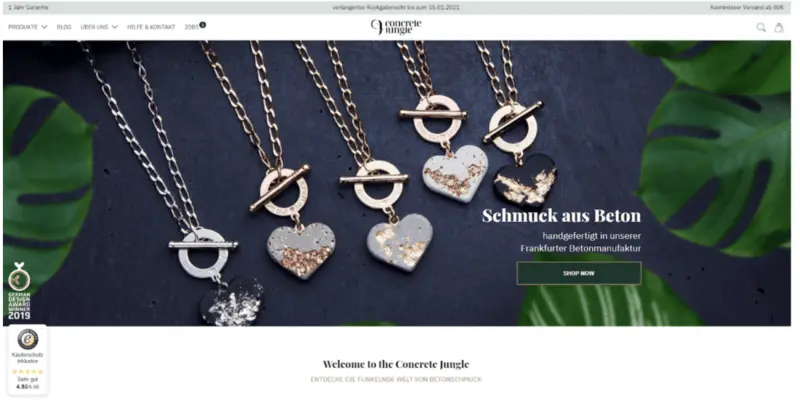
Design choices and brand consistencies worth noting:
- The black background complements the grey color and cold texture of concrete.
- The leafy green plants provide a more natural “jungle” element for contrast.
- The result is a grey, black and dark green color palette that makes the rose gold, yellow gold and silver of the jewelry stand out.
What’s to love about the packaging?
Concrete Jungle’s brand experience is consistent across all packaging and digital touchpoints.

Much of the color palette remains the same but thoughtfully reimagined into new textures. For instance:
- Rough surface of the deep black wood shavings
- Smooth green on the box’s internal print
- Subtle indentations of the gold hot stamping on the product boxes
Concrete Jungle is a mix of textures — rough, cold concrete used in delicate women’s jewelry – and their custom box design complements that eclectic mix of textures.

Malimo
Malimo is a German brand that upcycles intricate and stunning fabrics, transforming them into clothing that looks and feels like a work of art.

Malimo’s patterns are anything but subtle. They’re loud, eye-catching and maximalist in every sense of the world.
Conversely, their packaging is extremely simple.

What’s to love about the packaging?
It’s this subtle and understated packaging that we love because upon opening the box, those loud and incredibly detailed patterns spill out of the box and into your eyeballs.

The hangtags feature the brand’s font, ensuring the content experience remains consistent and memorable. Furthermore, the copy itself echoes the brand’s tone of voice and vivacity — it’s somewhat human, honest, funky and down-to-earth.
Malimo’s product packaging fights traditional branding but still complements the overall brand experience.
Hemp Juice
This Polish manufacturer of CBD oil puts a bright, happy and positive spin on a product usually associated with cliche imagery and unfounded stereotypes.

Hemp Juice leverages color to break up the product range, ensuring that customers can quickly identify which product is best for them — without going off-brand.

All collateral produced supports Hemp Juice’s core values: to educate consumers while giving them the product they need to live a happy, healthy life. So, whether customers are looking for educational information regarding CBD oil, best practices or shopping for a new product, they’re able to experience consistency across Hemp Juice’s branding.
And, as a result of the consistent and comprehensive branding experience, consumers invest more in the brand as they’re getting the support they need to get the most out of the product.
What’s to love about the packaging?
Hemp Juice’s CBD packaging is a fantastic example of packaging design that echoes the brand’s values.

The visual experience is bright, cheery, and happy without being in your face about the product’s medicinal constitution. Say you were to look at Hemp Juice’s product amid a rough day, you don’t think about the rough day, but rather that moment you get home, unwind and take care of yourself.

On the other hand, by not having the typical “green leaf” imagery as a staple of their branding, Hemp Juice winds up being more appealing to consumers on the fence about using CBD oil for the first time or those worried about the connotations of using CBD oil.
Monokel
Monokel is a boutique supplier of custom-made men’s clothing. Based in Berlin, the luxury brand prides itself on crafting high-quality garments tailor-fit to the individual.

A luxury-inspired brand like Monokel doesn’t require loud branding or lengthy copy to explain or justify itself. Hence why Monokel’s logo leverages a simple typeface and elegant execution.
What’s to love about the packaging?
Monokel’s packaging reflects a sort of “take-home” elegance.

Monokel uses a classic, two-piece product box, with the logo printed smackdab in the middle. Not only does this consumer experience reflect the brand experience, but it ensures a consistent, memorable feel from store to home.

If you’ve had the chance to visit the Berlin store, you’ll see that the shop also reflects the packaging design’s clean minimalism.
Anthem
Anthem, an Italian-based brand, sells organic clothing inspired by casual, California “hippie” vibes. Anthem blends the quintessential surfer’s attitude (i.e., relaxed and laid-back) with the tactile nature and feels of organic, sustainable and eco-friendly apparel. Anthem’s key color is a sort of retro orange and the round logo is somewhat reminiscent of a VW van from the 1960s, both of which tie back to the “chill vibes” inspiration that grounds the company.

What’s to love about the packaging?
Anthem’s target consumers demand packaging that reflects the organization’s sustainable mission. Meaning, Anthem can’t just walk the walk; they need to talk the talk too.

That’s why Anthem uses biodegradable and compostable mailing bags as their go-to packaging solution. These plant-based mailing bags are slightly off-white, lending a sort of natural look and feel while appealing to the environmental concerns their target consumer likely has.
Again, Anthem offers a unique take on the consistent brand experience, catering to customer expectations while staying on-brand.

Oase
Oase is a Dutch manufacturer of vegan hair supplements. The company’s branding is very minimalist and is done so deliberately to ensure the customer focuses on the ingredients and what the supplement can do for you — not the branding.

Minimalism is a trend echoed by many high-end companies, as it reflects confidence and elegance without being gaudy or ostentatious.
What’s to love about the packaging?
Oase based their design on the actual product — i.e., a red, strawberry-flavored gummy. The soft red and pink hues offer a sort of non-threatening look and feel and ultimately suggests that the product is gentle yet dependable.
Notice how the primary color of soft pink is a fainter hue of the product itself. The subtle hints of black text and the small gold logos (at the rear of the product) connect the supplement to the rest of the branding experience.
Polu
Polu is an Australian-based company that sells reusable coffee cups made out of bamboo. Australia’s coffee culture means it’s responsible for a lot of waste in the form of single-use paper cups — a problem that Polu wanted to solve.

Polu developed a unique, durable and sustainably-sourced, bamboo-based product that allows consumers to reuse the coffee cup over and over. Plus, the coffee cups are available in a wide range of color options, thus creating a need for packaging that complemented all colors — without going off-brand.
What’s to love about the packaging?
The brand gleaned inspiration from the Hawaiian ‘Ū’ character and used that horizontal line to break the packaging’s design literally in half. The use of negative space and attractive blend of white ink on natural kraft makes the packaging pop without watering down from the cup’s unique look and feel. And again, the packaging and brand experience all tie back to the mission statement of the company.

Stay Cold
Stay Cold is a clothing brand that definitively knows its target market: i.e., tattoo culture. Stay Cold’s apparel and branding pays homage to the thick lines, bold colors and definitive look and feel of traditional flash, so subtle branding was never an option.
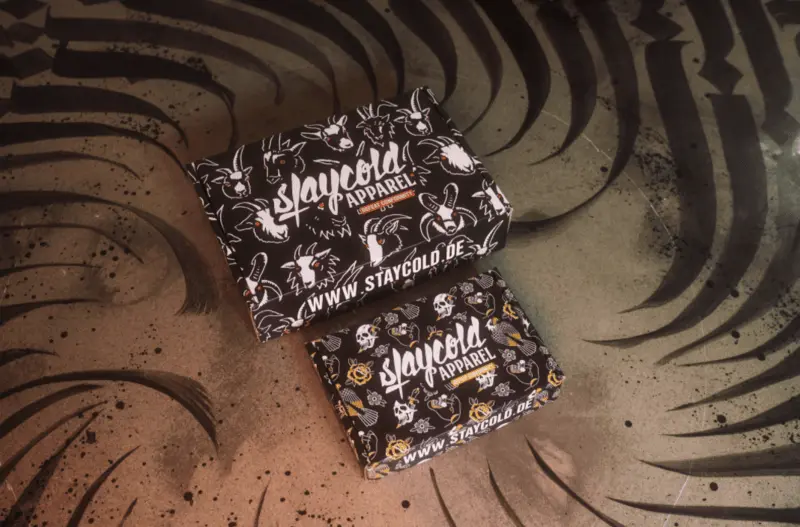
What’s to love about the packaging?
The striking use of the color black harkens back to tattoo culture and makes a bold statement on the packaging. And all imagery, from goats to skulls and roses, tie back to the various thematic range of clothing designs.

For Stay Cold, user-generated content plays a significant role in their organic marketing, hence why the inside of their box has an Ikea-like instruction manual for customers to create and share content around their new Stay Cold purchase.
Raylo
Raylo has a unique business model. Rather than telling folks to buy a brand new phone, users buy a SIM-free phone from Raylo for 12 or 24 months. At the end of the term, users send the phone back for a free upgrade, and the old phone is given to families or individuals in low-income communities so that they can still be digitally connected.
So, environmental good is done by keeping phones out of the landfill, and social good is done by helping out those that can’t always afford simple conveniences.
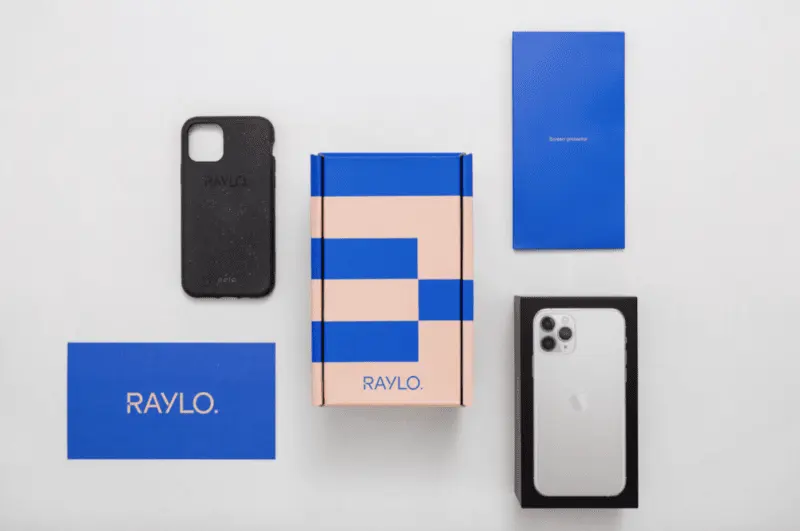
Due to the unique business model, Raylo also had a unique hurdle to overcome: the organization sells Apple and Samsung products, meaning customers are bound to associate Apple or Samsung’s branding with Raylo. To ensure customers would remember Raylo (as opposed to Apple or Samsung) and associate Raylo with the cause, they needed a unique and memorable brand experience.
What’s to love about the packaging?
- Raylo is founded on the notion of simplicity. For example:
- Raylo offers a simple way to get a new phone and all the necessary accessories.
- Simple branding — yes, Raylo features contrasting colors and sharp lines, but that’s complemented by simple packaging.
- Everything is sent in the same singular box.
Raylo initially used a standard-sized mailer box to deliver all products but soon found it used too many materials that contradicted its environmental mission. Raylo then worked with a packaging engineer and designed packaging from scratch, specifically for their set of items that are sent together.
So in turn, the packaging provides a unique brand experience and reflects the company mission.

The result is stunning and visually very captivating. Furthermore, by using value-engineered packaging, Raylo decreased packaging costs by 11% and lowered packaging weight by an impressive 20%.
Monday’s Child
Monday’s Child is a London brand that specializes in creating beautiful, heirloom-quality pieces for young girls. Monday’s Child pride itself on crafting timeless dresses that feel special and are made to last.

To that end, Monday’s Child wanted to connect the dress’s special memory with that of children’s playfulness through its packaging.
What’s to love about the packaging?
Monday’s Child has used innovative packaging design to turn their mailer boxes into a doll house for their customers — well, rather, the children of customers.

Monday’s Child brand knows the importance of imagination and bridges the gap between the feeling of wearing a “special dress” and creativity.
Brahmaki
Brahmaki is a Swedish brand that sells exclusive, handmade kaftans. A quick look at the homepage and you can get a feel of what the brand stands for: i.e., simplicity and serenity.
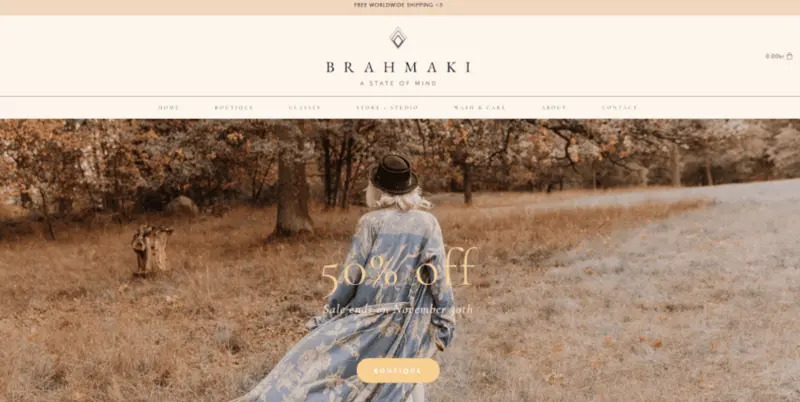
Looking at the brand’s lifestyle shots and it’s easy to extrapolate colors, moods and overall experiential brand goals.

What’s to love about the packaging?
While the kaftans themselves are breezy and unique, yet ethereal and simple, the mailer box is equally as symbolic and carries the brand experience over onto the in-person experience.
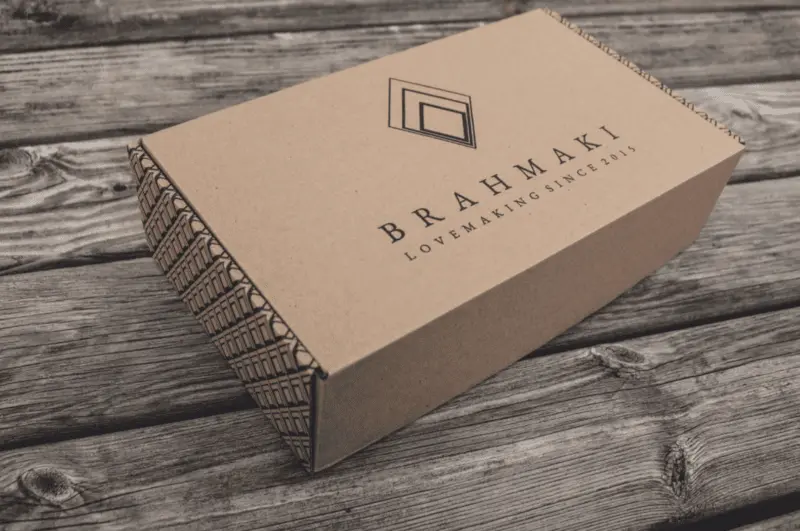
You’ll notice that at the front and center of the box is the logo, name and slogan of the company, whereas the side panels (with the vibrant and bold pattern) push your focus back to the logo and the kaftan presentation. Again, there’s no lack of continuity between the branding and the product itself, providing a consistent experience regardless of whether the customer is opening a box or shopping online.
The pinnacle of brand experience
Connecting the brand experience with the creative process and packaging design can be tough! The ideation process either flows like water or feels like getting blood from a stone. Regardless of which of those euphemisms you regularly experience, one thing is crucial — creating a consistent and unique packaging design experience empowers your brand to create more memorable customer experiences, therefore adding value to your brand overall.
We tell stories every day. Whether it’s a quick ditty to a friend or a long anecdote to your grandchildren, storytelling is ingrained in us. In our professional lives, we also tell stories. We tell stories to persuade someone to support a project, inspire a team, or explain a complex problem.
Storytelling is an essential skill in the professional world, but you may not be using it to its full advantage. Successful business storytelling can set you apart from your competitors and bring in loyal customers, which is why it’s essential to know how to craft a great story. We’ve created this quick guide to break down the business story writing process so you can fine-tune your storytelling skills and reap the benefits.
What is storytelling in business?
Business storytelling takes abstract concepts and complex messages and solidifies them into simple and attainable terms. It can help your customers take a non-tangible concept and relate it to concrete ideas and emotions. Storytelling in business is also the heart of inbound marketing. It’s not facts and figures that stick in our minds — it’s the stories and emotions they invoke that leave us wanting more (or have us running out to buy the new iPhone).
How many Super Bowl commercials can you remember that left you in tears? Or, ask someone and chances are they can tell you the reason why they donated to a cause or bought something. It may surprise you how often those reasons link back to a story the company told. So without further ado, let’s break down business storytelling so you can get writing.
Steps to creating a story
1. Know your audience
We’ll stress this until we’re blue in the face: Know your audience. This important piece of work will determine your message, your medium, your distribution … it may already determine your product or service. The extra time you take to dive into your audience’s demographics will pay off greatly in the long run. Without specific information on their wants and needs, you could end up with a real disaster. For example, if you are set on sending out flyers or a brochure when your audience is largely a Gen-Z crowd, you’re going to fail. Younger audiences expect that useful information is most likely going to come in digital form.
As you start research on your target market, it can help to define your buyer personas. A buyer persona can also help provide direction for the first few steps as you build out the foundation of your story. Make sure to move past age, gender and other obvious sections of their demographics. Find out what their triggers and stressors are. Even better, find out what pushed them into the content-consumption phase of their customer experience.
2. Determine your message
This, of course, is coming as number two because it doesn’t matter how long or short or where you are publishing it — your story needs to have a core message. It will be the foundation of your story moving forward. Eke out whether your story is to raise funds, advocate for an issue, explain a service or something else.
To help determine the point of your story, try summarizing your story in one simple sentence. Or give it the old elevator pitch (30 seconds or less!). If you’re unable to, you don’t have a core message, so go back to the drawing board.
3. Include a story arc with conflict and resolution
The best storytellers know that all good stories have an arc that involves a wonderful conflict apex with a tapering resolution. The conflict will be the lesson of how your character overcame a challenge. Your conflict is what will connect you to your audience through relatable experiences. Without that conflict, your story is going to be a bit boring or fall flat with your audience.
And don’t forget that every good story has a closing. Use your resolution to wrap up the story, provide context around the conflict and leave your audience with a call to action.
4. Select your medium and layout
Stories come in all shapes and forms. Some are watched, some are listened to, and others are read. There are several different ways you can distribute your story: in a video, in copy on your website, through in-person or virtual presentations, via social media, etc.
Picking the right medium for your story will probably depend on your resources and budget. Just remember that no matter which medium you choose, you want to make your message relatable to your audience.
5. Produce it
Once you’ve chosen your medium, it’s time to produce your story. The production phase will probably include a larger team than you imagine. You’ll want writers to help with a script and other creatives to aid in backdrops for a visual story or layouts for a written story. Involve your social media team to make sure what you produce will translate well on social platforms.
6. Distribute it
You’ll almost always want to share your story on social media and via email. If you’ve chosen a written story, don’t forget to publish it beyond your blog; get it guest-posted or shared on other publications. Digital stories are great on your own social media platforms, but also be sure to include them on Vimeo and YouTube. The more places you share your story, the more engagement you’ll get.
Do’s and don’ts of business storytelling
- Make the customer the hero of the story.The focus of your story should be on your audience or customer. Hone in on events you’ve witnessed or lessons you’ve learned, but try to keep yourself out of it. Your story shouldn’t be about how great you are; it will alienate your audience and could pull them away from you.
- Keep it simple: stick to one storyline and one message.Don’t let unnecessary details detract from your message. Some of the most memorable stories are straightforward and rely on the “less is more” principle. Certain details are important to include, such as emotions, the expression on a face, etc. These kinds of details help immerse your audience without distracting from your core message.
- Include a call to action.Don’t forget to include your call to action! Outline specifically what you want your audience to do after reading/watching/listening. It can be as simple as a colorful share button at the bottom of a screen or a quick callout at the end of a video.
- Don’t make it a sales pitch or an advertisement.Your audience is already overwhelmed with ads day in and day out. The purpose of storytelling is to further a brand or foster community outreach. Don’t use a really good story to simply sell a specific product or service you provide. Instead, use it to grow brand awareness or reach out to donors and investors.
- Include a hook and make it engaging.If you ever took a writing course in school, you’ll remember how important that first paragraph is. How often your teachers stressed having a good hook to draw the reader in. It’s no different with your content. You need a good hook that will draw your audience in, and then you need to continue that momentum throughout to keep them engaged.
Some great brand storytelling examples
A recent example of effective business storytelling has been Best Buy’s commercials in recent years. The company’s most recent campaign, “Dear Best Buy,” is an homage to the letters children write to Santa Claus, only these letters are specific to the strange times we’re currently living in. The ad starts out with a customer asking for holiday gift-giving advice and ends with a Best Buy employee providing recommendations.
Another great brand story comes from TOMS. The shoe company shares stories of not only its customers but also the people it serves through each purchase. By doing so, TOMS created a movement that increased sales and built a community.
We’d be remiss if we didn’t include Apple in our brand storytelling examples. Apple uses real-life stories to describe exactly how its products benefit users, and oftentimes a script isn’t even needed. The company’s latest commercials for AirPods show customers using the extensive features of the earphones throughout everyday experiences like catching the metro or walking home. Apple leaves the technical jargon at home, letting the music do the talking.
As you pull out that computer or lay out your pen and paper to write your story, remember that in the end, storytelling is always about your audience. What do they need and what do you have that can help them? If you’re stuck, go out and talk to people. The best storytellers know that they don’t have the only stories to tell. Chat with a colleague, a friend or a peer. Inspiration could strike from anywhere, and just remember that storytelling is a trial-and-error process. Your first run at it may not be astounding, but as they say, practice makes perfect!
We’ve got some tips on how to get your whole organization on board for consistent storytelling: Check out our ebook The rise of the design democracy: How to maintain a consistent brand story.
For most designers, their work is based on their ability to move quickly and get things done in a hurry, which leaves little room for creativity and ultimately leads to subpar projects, products and designs.
But this doesn’t have to be the case anymore. With design operations, also known asDesignOps, your organization can start to streamline the design process without jeopardizing the quality of your designers’ work.
Defining DesignOps — what is DesignOps?
Dave Malouf of IxDA, Design Ops Summit, first described DesignOps as “everything that supports high-quality crafts, methods and processes.” In more specific terms, it’s the person — or department — that plans, defines and manages the design process. DesignOps ensures that the creative process is not only running efficiently but that your designers have the space needed for trial and error in the task or product design and development.
According to Pabini Gabriel-Petit, Principal Consultant at Strategic UX and Founding Director of Interaction Design Association, most organizations that have implemented a DesignOps approach are able to “evolve and improve product and service designs at a faster pace than organizations using traditional UX design and research processes [and can] better serve their customers, and compete more effectively in the market.”
DesignOps as a proactive solution
DesignOps is a proactive solution to the obstacles designers encounter on a daily basis. Do any of these instances sound familiar to you or your designers?
- Designers are treated as a stepping stone or a means to an end, rather than a strategic role or part of the core team. Designers who experience this will frequently feel taken for granted.
- Designers aren’t communicated with, pulled into important conversations or asked to help problem-solve. Oftentimes, designers will feel as though the team is missing out on new opportunities.
- Designers are typically inundated with small design requests, causing the designer to feel as though it’s impossible to focus on big projects and create content that they’re proud of and would showcase in their portfolio.
- Teammates view a designer’s success based on the speed of their delivery, instead of the quality. In other words, burnout is real.
- Designers simply aren’t equipped with the right tools or design solutions to ensure they can do their job effectively and efficiently, which slows down production time, content effectiveness and hamper overall morale.
However, DesignOps is meant to help solve these very problems by building a more efficient design process within your organization. By establishing a role or department specific to managing DesignOps, teams inevitably create stronger content and products, therefore benefiting everyone involved in the design process.
Components of DesignOps
A DesignOps team’s main goal is to streamline a designer’s workflows without jeopardizing the integrity of the creative process. To do so, the DesignOps team should focus on these four components: design process, team coordination, design tools and design culture.
So, what do these four components look like in practice?
Design process
First, you want to rework your design process. To do so:
- Start by identifying weaknesses in your existing process. Weaknesses might look like — a lack of communication between teams, off-brand content being created, an absence of brand guidelines or templated content collateral for others to work off of.
- Institute a process that optimizes designers’ everyday workflow. To be effective is to be efficient, which means you want to eliminate processes, tools and solutions that are getting in the way of your team fulfilling their role and showboating your brand.
- Establish clear metrics of success. Giving your team a sense of direction and measurable success ultimately provides them with a sense of belonging and understanding of how their role contributes to the business. Without clear metrics and goals, well, that’s a whole other issue.
- Implement good meeting etiquette by reducing unnecessary meetings and ensuring remaining meetings are more productive. No one likes being a part of meetings that feel more like they’re A.) A therapy session B.) A waste of time C.) As though they should know what’s going on when they don’t and D.) An opportunity to socialize instead of work.
- Determine clear design delivery by deciding who sees the work and when. Providing clear guardrails with stakeholder reviews and various other important touchpoints empowers your design team to make changes on the fly and adapt to important feedback instead of having to start from the ground up again should the collateral not be what the requesting party needed.
As you evaluate the design team’s process, be sure to get input from the various stakeholders who work with the design team. For instance, find out what’s working or not working for these key stakeholders and get additional context as to why they interact with the design team or make the requests. Any process changes you make will only be impactful if the final product meets the needs of everyone on your team.
Team coordination
A DesignOps role will give designers the space to concentrate on design work. Therefore, DesignOps will be more involved in the following aspects:
- Budget — how much running the teams will cost and why.
- Human resources — headcount and recruitment.
Design tools
Another component of DesignOps is to choose what tools the design teams will need to work efficiently. They will monitor, delegate and regulate the tools and systems in place as well as ensuring designers adopt any new tools. Under this component, DesignOps will also set the standard for building components in code so designers can work in closer collaboration in design with developers.
Design culture
Establishing a design culture goes beyond the culture on the immediate design team. Educating stakeholders across the company about the importance of good design and branding is a critical step toward leveraging what’s called design thinking — as in when an org moves away from treating design as though it’s a cog in the wheel, to using it as an important component of the business strategy.
Holding branding workshops and creating a brand style guide are a great place to start. However, you’ll also want to identify ways that empower every employee to understand and use great design as it will have the greatest impact on employees remembering and embracing the impact of great design.
Which leads us to the final component of DesignOps — design culture. Culture may seem trivial compared to the other three components but don’t take it for granted — it’s what ensures your design team is happy. This can include:
- Knowledge sharing — Lunch and learn opportunities or creative office hours
- Education — Podcasts, digital events and more
- Accountability — Your system of checks and balances
- Retention — Employee, brand, template usage and more
How to incorporate DesignOps
There are a couple of ways you can incorporate DesignOps into your organization, either through a DesignOps role or through DesignOps thinking.
Not sure if you could stand to benefit from hiring a DesignOps role or implementing DesignOps thinking? Well, there’s a few things to help you evaluate:
- Do you expect your business to experience any amount of growth in the coming months that will impact your design team’s ability to scale production?
- Do you expect that other roles at your organization will require assistance from your design team in the coming months, thus increasing the design team’s workload?
- Does your organization require a good deal of cross-functional collaboration?
Either approach you take will require you to scale production and ensure that your design team is set up for success.
DesignOps role
Hiring for a DesignOps role will require someone to rework your entire design process. An ideal candidate would have a background in creative thinking (or design experience themself), project management and have excellent communication and organization skills. You want to keep your eyes peeled for other less trainable, soft skills that someone would have such as empathy, affability and an ability to compromise, say no or see both sides of an argument.
To rework the design process, start small. Don’t try to completely overthrow the entire system in one day. You’ll have anarchy. Instead, have your DesignOps individual be responsible for understanding the needs and challenges for this one project and then introduce required changes. Starting with one project will give them the chance to test out the new design process.
DesignOps thinking
If your organization is needing a bigger cultural shift, it may be necessary to completely change your organization’s design thinking. Start by evaluating your current design process. Be sure to get feedback from your design team, engineers, product teams and marketing teams to determine what problems they’re facing. Discuss how DesignOps can help solve these issues.
Next, create a shared vision around how DesignOps will work within your organization. Establishing this will help your design team understand the need for this change.
How DesignOps is applied in real life — at Lucidpress
At Lucidpress, we develop a culture of design thinking via a process we call brand templating. Brand templating not only eliminates small design requests that eat up the creative team’s time but also helps empower all employees to embrace good design as mentioned in the section above. Brand templating follows these steps.
- Templatize your most frequently used content
- Lock down brand elements, so they can’t be changed
- Give employees access to those templates, so they can quickly access and tweak the content that they need.
Since creating a library of templates, our events manager can quickly create graphics to promote an upcoming webinar by updating the copy on a premade template instead of submitting a design request. Our sales team can customize a proposal to a specific customer without having to request an edit or wait for the proposal to come back. And meanwhile, our creative team can focus on their most important work without worrying about how the brand is being represented.
Scale production with DesignOps and the right tools
Imagine the impact DesignOps could have on your organization as your teams begin to work closer together on this new vision for your design process. With just a couple of significant changes, you can start to see benefits from this more collaborative work like brand consistency and quicker delivery on projects. And if you need more than just DesignOps for brand consistency, check out our free ebook on how to maintain a consistent brand story.
A strong brand image is crucial to your success. If you’re asking yourself, “What is brand image?”, strap in. We’re going to help you understand what brand image is, why it’s important, and how you can get the best brand image for your organization.
What is brand image?
Brand image is what customers think about your brand or the feeling they have about it. It’s the overall perception or impression of your brand that’s created through your message, brand awareness and brand identity. But, your brand image develops over time as your customers experience and interact with it, and it can be enhanced through word of mouth, advertisements, sales promotions, etc.
Just remember your brand image and brand identity aren’t the same things. Brand image is how your brand or business is perceived, whereas brand identity is the visual aspect, i.e., the literal face of your brand. Brand identity includes logos, colors, typography, messaging and packaging. Brand identity also reinforces the existing reputation of your brand and requires complete consistency since it’s the first impression customers have of your business.
Why brand image matters
A strong brand can potentially equal a strong business. With a strong and consistent brand image, potential consumers are more likely to pick you over the competition because they see you as trustworthy and reliable. Plus, if you’re targeting your audience correctly, consumers will associate themselves with your brand image, attracting them to you from the get-go.
A strong brand identity + a strong brand image will let you introduce new products to the market more easily, since you won’t need to focus too much on marketing. If your consumers already love you, they’re more likely to buy other products from you, right? Think of it this way: My first Apple product was an iBook G4. Followed by an iPhone 1, iMac, iPad, iPhone 7, MacBook Air, another MacBook Air, and now an iPhone 11 Pro — all across a span of 15 years. I like Apple (maybe a little too much), and I trust that its products are going to do what I need them to do.
Now imagine that same domino effect in your organization. A strong brand image can help you get that.
Steps to develop a brand image
Thankfully, developing a brand image is a straightforward process. Just follow these steps and stick to the best practices of brand guidelines to get started.
1. Know your audience
Before you do anything, determine your target audience. Be as specific as possible, go beyond the basic demographic (age, gender, occupation), and determine their behaviors and lifestyles. The more specific you are, the more you ensure your brand message comes across loud and clear to your target customers.
2. Define your value proposition
Your value proposition will be a part of your overall marketing strategy and refers to the value you promise to deliver to your consumers if they choose you. It can be either a marketing or business statement that summarizes why your audience should buy from you, what you stand for and how you operate.
3. Establish your visual identity
Your visual identity, e.g., your logo, shouldn’t necessarily be the first thing you create. It’s easier to create a logo after you’ve built or started building a clear brand. Doing it this way can make things a lot easier — by starting with your audience and mission, you’ll create a springboard for designing your visual identity, which should complement and enhance your brand, not define it.
4. Create your brand archetype and personality
Make your brand personable by creating an archetype or personality. You can do this by using colors, type, imagery and tone of voice to represent who your brand is.
By knowing your brand archetype, you can create a pattern of ideas or way of thinking to help influence decisions around your brand. Brand archetypes are most often associated with characters in a story, such as the hero, magician or outlaw. For example, Nike embodies the hero archetype by using athletes in their advertising who inspire us to be the bravest, strongest versions of ourselves.
5. Cultivate brand consistency
As you continue to build out your brand image, remember to be consistent. A consistent brand can affect your ROI by earning trust with customers. And an inconsistent brand can create confusion and depreciate your brand status. Plus, brand consistency can lead to new customer leads and conversions.
Don’t be surprised if building your brand image takes a bit of trial and error. Some of the most recognizable brands out there have gone through a rebranding or two. For more in-depth tips on brand image, check out our free book on how to build your brand.
With most marketing conducted online, it shouldn’t surprise you the amount of content — also known as marketing collateral — your business is producing each week. Each of those pieces could be considered essential to your efforts in growing your business, but how do you know if you’re utilizing them in the best ways possible? Let’s start by defining marketing collateral.
What is marketing collateral?
Defining marketing collateral is pretty simple. Whether it’s print or digital, you can categorize anything you use to communicate your brand’s message as marketing collateral. And with most marketing happening online, the opportunities for you to promote your brand are endless. But knowing what marketing collateral to use when and who to send it to is half the battle — i.e., you shouldn’t be handing out white papers to someone who’s set eyes on your brand for the first time today.
How is marketing collateral used?
Knowing when to use your assets will depend on how marketing collateral is used overall. Generally, each piece tends to fall into one of the following areas of your business:
Brand awareness
Collateral used for brand awareness is meant to educate potential customers. Any brand awareness collateral created should focus on your customers’ needs and showing them that you understand their problems. This type of collateral is also used to introduce your brand.
Lead generation
Creating collateral for lead generation will help your prospects decide regarding what you have to offer. These types of content pieces should prove your success with past customers, get contact information or provide extra information.
Sales enablement
By now, any potential customers likely in need of additional info on the advantages your product or company offers over your competitors. To get them to click “buy” or move forward down the customer journey, you’ll want to create sales enablement content that provides additional details about your services.
Customer relationships
This type of collateral is used to build and strengthen relationships you have with existing customers. Whether it’s reminder emails or support articles, they tend to be valuable tools that keep you in contact with your customers.
Types of marketing collateral by use case
Now let’s go through a quick overview of the different types of marketing collateral you can use in each of those areas.
Brand awareness
Blogs
Blog post articles can be used to help solve a problem, present a solution or answer questions for customers — without feeling like a forced sales pitch.
Social media
Social media posts are most effective when used to inform viewers or promote a product or service your business provides.
Infographics
Infographics can be a standalone piece or included as part of an article or blog post. Infographics are great at getting you noticed because of the visual appeal.
Podcast
Podcasts are a unique way to communicate with your audience. This type of marketing collateral can help tell your brand story to listeners who are always on the go or audible learners.
Direct mail
Fondly known as junk mail, direct mail is a physical piece of collateral used to communicate with customers. Use direct mail service as an additional channel to conduct a marketing campaign.
Lead gen
eBooks
eBooks are longer than blog posts and go further in-depth on specific topics. Think of eBooks as slightly more detailed guides. Since eBooks can only be accessed in exchange for a prospect’s contact information, they’re an excellent conduit for lead generation.
White papers
White papers focus on more technical topics. They’re beneficial in attracting leads by delivering information at the point in the customer journey when prospects are considering your services.
Reports
Reports help stakeholders stay engaged as they access information like sales figures and company growth. They’re more effective when you use visual components.
Webinars
Webinars are a simple way to communicate with your audience, offer free, valuable information, and increase your customers’ expertise. They’re also great as a resource for other marketing collateral.
Landing pages
A landing page is the starting point for collecting information as they often require prospects to fill out a form in exchange for a piece of content or to get on your mailing list.
Need help creating your marketing collateral? Browse our collection of free templates.
Sales enablement
Proposals
With the recent shift toward a digital-first experience, business proposals are taking on more flair and personality companies are finding better, more interesting ways to convince clients to invest.
Product brochures
Product brochures can help increase sales by empowering you to showcase what you have to offer. They’re easier for audiences to get a quick overview of your products.
Case studies
Case studies are used to highlight how your services have impacted customers in real life. They’re often used in partnership with a satisfied customer so prospects can visually see people willing to vouch for you.
One-pagers
One-pagers highlight what your business is about, the problem you’re trying to solve and what your audience can do for you. One-pagers are typically used when pitching to investors or for distribution among clients and partners.
Explainer video
Complex product? An explainer video can simplify your product’s functionality easily and intuitively. Post it to your homepage or share it on your social media platforms.
Customer relationships
Newsletters
Newsletters are an easy way to stay in touch with your clients, keeping them up-to-date on new products or features while also driving traffic to your site.
Email is a great method of re-engaging customers to subscribe or complete a purchase.
Training videos
Providing training videos to customers helps build customer relationships. Videos like these can be used to take customer service that extra mile if you offer a complex product.
Support articles
Support articles are used to expand your customer service by providing explanations to issues other customers may have encountered or to answer frequently asked questions around certain features of your product or services.
Best practices for marketing collateral management
Organize
Start by taking inventory and organizing your marketing assets. Once you have a catalog of all your marketing collateral, you can begin eliminating unused pieces of content and then templatizing and customizing your most-used pieces.
Templatize
With a solid library in place of all your non-digital and digital collateral, you’ll want to make sure these pieces are easily accessible and editable to anyone in your organization who uses them. Templatizing your digital collateral is also a sure-fire way to guarantee that all content with your name on it follows your brand image and guidelines.
Customize
With templates in place, it’s now a thousand times easier for you to customize your marketing collateral. Your templates will allow your teams to repurpose just about any piece of collateral you have stored.
With this understanding of how to use your marketing collateral, you can create more effective content and better utilize your existing marketing collateral. Still need a little extra help? Check out our ebook on effective content.
If you’re in higher education, you’ve probably noticed things are getting tough out there for community colleges, public universities and private institutions alike. A recent decline in college enrollment has some experts concerned, but the reasoning behind the choices students are making about their enrollment in colleges is increasingly complicated.
While it’s tempting to blame the college enrollment decline on the faltering economy or the difficulties of the pandemic, over the past decade, enrollment in higher education has actually fallen by 11% nationwide. It’s clear something more pervasive has been driving the enrollment crisis for some time now. In 2020, the National Student Clearinghouse Research Center reported the percentage of students enrolled continued to trend down 4% for the fall semester.
Let’s take a closer look at some of the potential reasons behind the college enrollment decline and how to address these problems by building a better university brand.
5 factors behind the college enrollment decline
There doesn’t seem to be just one reason behind declining college enrollment numbers. However, taking a closer look at the combination of contributing factors, including falling national student graduation rates and college student retention rates, can help schools tackle challenges in recruiting and retaining students.
1. The recession reset could be responsible for some of the college enrollment decline
In short, what goes up must come down. A stronger economy typically boosts college enrollment. However, in 2011, the reverse happened as an unprecedented number of students pursued higher education when the economy was still emerging from a downturn. The current declining college enrollment rates may be, in part, simply a return to levels of normal recruitment and retention.
2. College enrollment is down in part because there are fewer students
At some point, simple math prevails. Fewer births mean fewer students, and fewer students mean fewer college students. Shifting demographics and dropping birth rates from twenty years ago means a smaller pool of high school graduates for colleges to recruit from. This forecast of dwindling student populations is complicated by the fact that fewer high school graduates are choosing to go to college.
3. The growing cost of tuition is a barrier to college enrollment
As you may have guessed, sharply rising tuition rates and less investment by states in higher education pushes more of the cost of college onto parents and students. In fact, rising tuition rates are outpacing inflation by a large margin. This creates barriers to pursuing college enrollment, especially among first-time college students and adults who already have significant financial commitments.
4. Students worry college degrees don’t hold value anymore
The burden of student loans has become a hotly debated topic nationally, and it’s fueled concern about whether college degrees still hold value in the modern economy. Public and community colleges seem to present a better return on investment up front, but research indicates private colleges still provide better long-term gains for those who can afford them.
5. The pandemic definitely isn’t helping the college enrollment decline
While the coronavirus crisis isn’t the sole cause of the current college enrollment decline, it’s certainly not helping. Colleges and universities reported up to 25% of potential students postponed college enrollment because of coronavirus. Many of these students cited difficult financial choices as a result of their family’s economic challenges. This is compounded by an already high college dropout rate that is currently hovering around 40%.
How to increase college enrollment at your school
Leveraging the following marketing tactics isn’t a silver bullet, but it can help your school overcome obstacles to recruitment, strengthen your college brand, and drive better student enrollment and retention numbers.
Know your audience
It’s possible your potential students aren’t who you think they are. While high school graduates are the most likely to enroll in college, increasingly diverse populations now crowd the halls and virtual classrooms at today’s colleges and universities.
Focus your college recruitment and create marketing personas shaped by non-traditional potential student populations. It may help you reach a broader audience, including adults going back to school, first-generation college students and international students.
Focus on your brand
Just as successful companies build brands that are easily recognizable to consumers, colleges and universities should invest in branding that means something to students. Brand building isn’t just about having a cool logo or a best-in-class website. It’s really about crafting a niche and making sure your branding reflects those institutional strengths. Whether it’s fantastic study abroad experiences or a thriving esports community, find what your school does well and incorporate it into how you market to potential students.
Get creative
College fairs and mail brochures aren’t going to cut it anymore. To boost enrollment, consider focusing on new marketing channels in social media such as YouTube or recruiting brand ambassadors on Instagram.
You need to reach potential students where they live, and increasingly that’s online. Take stock of your internet presence and consider how you can elevate your school profiles and expand your audience. Consider who your target demographic is and how best to communicate with those students given how they spend their day and what they care about.
Be consistent
It’s far easier and more cost-effective to keep the students you have than to recruit new ones. It’s also true that supporting your existing students and helping them thrive on campus can create the kind of alumni that’ll be brand ambassadors for life. Former students can go on to be vocal alumni who provide the kind of buzz for your college brand that money can’t buy.
Part of creating a dynamic brand is to get consistent with your university branding and create content your existing students will be proud to promote and share. Brand templating can help your team keep assets in one place, reduce the risk of off-brand content, and allow anyone to create and use branded content when and where they need it.
While the world faces unprecedented challenges and rapidly evolving technology, the future of higher education, in particular, appears to be headed for a precipice. The culmination of widespread online learning, significant enrollment decline, and increasing concerns about student loan debt have disrupted traditional models of learning and raised important questions about the future of education.
In the midst of this chaotic sea change, educators see an opportunity for colleges and universities to better evolve to embrace the needs of students, communities, and society at large. Understanding the changing landscape of education can help these institutions adapt and position themselves for a successful transition into the future of education.
What does the future of higher education look like?
Seismic shifts in the way learning is delivered have the potential to reshape the education industry. In the wake of the COVID-19 pandemic, a Barnes & Noble Education study indicated 70% of college students surveyed said they wanted “less rigid” learning experiences.
“The pandemic did not change the path for higher education, but it did change the speed at which we’re traveling on that path. Within the next 10 years, we will see a transformation of the student experience — from admissions through graduation — that will ultimately create a better, more inclusive and smarter world.”
Michael Huseby, CEO and Chairman of Barnes & Noble Education
Let’s take a closer look at what the future of higher education holds and what it will mean both for the student experience, the educators who support them, and the institutions that deliver learning.
College enrollment decline means changing student demographics
The education industry has been sounding the alarm about enrollment decline for a few years now, but disruption of attendance due to the pandemic has both amplified and accelerated the problem. After hitting a peak in 2011, college enrollment has been steadily falling for the past decade. In private colleges like Harvard, 20% of college students chose to defer enrollment last year due to the pandemic and unanticipated economic challenges.
Some enrollment decline is inevitable due to shifting demographics and a smaller pool of high school graduates. But this is a numbers problem that challenges colleges and universities to think outside the box and recruit nontraditional students. Adult learners, international students and other underserved populations could fill the future halls of higher education. However, educational institutions need to make significant changes to how they recruit and support students. And colleges and universities will have to retool how they deliver and fund learning to convince underserved and first-generation students to invest in a degree.
The role of technology and online learning in the future of education
Remote learning is here to stay, but conversations surrounding the role of technology in the future of higher education can become contentious. While most colleges and universities have some sort of online program, there is widespread debate about whether distance learning provides the same educational value as brick-and-mortar classes.
While most institutions will continue to embrace all things internet, the clamor and cry for better digital student experiences is clear. In the College 2030 Report from Barnes & Noble, 82% of faculty felt they understood how students learn, but less than half of students surveyed agreed with that statement. There is also a disconnect regarding the value of online learning, with 94% of students saying it should cost less than in-person classes, while 43% of faculty disagreed.
The future of higher education will be more affordable and accessible
Ongoing concern about the burden of student loan debt and the value of a college degree has pushed the issue of affordability and access to higher education front and center. Students and families are demanding college experiences provide a better value, but there are lots of questions about how to deliver on that expectation.
Nevertheless, college degrees are increasingly considered a necessary part of successful careers, and more employers are demanding them for entry-level jobs. This phenomenon, referred to as “degree inflation,” is likely to accelerate in the coming years as increasing automation means less manual labor and more positions requiring higher-level technology or communication skills.
What changing expectations mean for the future of education
It’s clear that expectations around what the student experience should look like are driving change in higher education. While forecasting the direction these forces will push colleges and universities is tricky, it’s worthwhile to consider how these trends might shape the future college experience.
Hybrid models of education will become the norm
For many decades, the formula for a college experience was a familiar one. Four-year residential colleges were the norm and catered to a young student population fresh out of high school. Part-time and adult students were the domain of community colleges and other low-cost public universities.
The college experience of the future won’t fit this paradigm, and that’s a good thing. A diversifying college student population means higher education will invest in blended models of learning that offer the best of both worlds. Hybrid educational experiences with both in-person and online options better meet the needs of the underserved students and ultimately offer everyone better access and value.
Expect a focus on return on investment (ROI)
Return on investment isn’t just a business buzzword anymore. Students and families are viewing the decision to attend college as an investment, and they want educational institutions to be transparent about affordability, student loan debt and future job prospects.
In short, when shopping for a college, students are increasingly savvy about ROI. As consumers of higher education, they are demanding more value from their college experience. Education institutions will find ways to build more bang for the buck into degree programs with options like corporate partnerships, subsidized internships, study abroad opportunities, and career and job placement assistance or networking communities for alumni.
A culture of accountability is on the horizon for colleges and universities
The consensus among employers is clear. A growing number of colleges and universities don’t confer degrees that translate into meaningful career or employability skills. On-the-job training in areas like communication and leadership often fills some gaps, but this skills divide is a source of growing frustration for both employers and employees.
Expect a culture of accountability to grow not only around the knowledge colleges deliver but also around the role they play in producing more competent, confident and well-rounded graduates. To deliver on this promise, higher education will need to find better ways to connect students with real-world opportunities for growth and advancement.
College degrees will increasingly deliver more than career skills
Whether virtual, commuter or residential, college campuses provide much more than housing and healthcare for students. They provide community and connection. Grappling with the impacts of societal issues such as racial equality and economic disenfranchisement is increasingly the domain of educational institutions.
In the future, colleges and universities will look beyond career readiness into the ways in which they encourage digital citizenship, foster emotional intelligence, and build community leadership.
The role of university branding in the future of education
University branding can play a role not only in addressing today’s college enrollment decline but also in preparing institutions to meet the future of higher education head-on. But building a stronger brand is about more than a recognizable logo. It’s about producing consistent, high-quality content across all your marketing channels.
Here are a few tips to help your school transform its higher education marketing and embrace a bigger, brighter and more inclusive future for both students and educators.
- Think about tone
Take a close look at your messaging on social media, blogs, brochures and emails. What do the visual aspects of that content say about your college? Think not just about what you’re saying but how you’re saying it. If the messaging isn’t consistent, it may be time to invest in a brand templating platform like Lucidpress.
- Put it all in one place
Consistent, high-quality branded assets are fantastic tools as long as your marketing teams know where to find them. Centralize your resources and make sure everyone who engages with prospective students and all your stakeholders have access to up-to-date marketing materials.
- Optimize campaigns
Launching successful marketing campaigns requires planning to ensure consistent messaging across all your channels. You should also evaluate past campaigns to glean insights about how to improve and hone your content to encourage engagement. Think carefully about your audience and how to reach them where they spend most of their time.
The future of higher education may seem like uncharted territory at the moment, but it’s an exciting time full of possibilities for students, educators and administrators alike. Embracing technology and finding ways to expand access and affordability to education will help guide institutions through these challenging times and help create opportunities for us all.
An effective communications strategy is crucial for any business, but it’s especially important for nonprofit organizations. There are a lot of worthy charities, advocacy groups, and community projects competing for attention and dollars.
In the U.S., there are approximately 1.5 million nonprofit organizations that include social advocacy groups, private charitable foundations, and even civic leagues and corporate giving programs. The nonprofit sector is also the third-largest employer in the United States, with healthcare-related nonprofits making up a clear majority of the organizations across the country.
These nonprofits all rely heavily on a donor or client base to fundraise and generate revenue to help their organization grow. Here are a few tips for developing a nonprofit communications plan that can help your organization stay mission-focused and thriving for decades to come.
Tips for developing a seamless nonprofit communication strategy
Clearly articulate a compelling brand story
Thriving nonprofits know that the secret sauce of success is that every stakeholder, donor, volunteer, and board member is a brand ambassador. The more people who are passionate about what you do, the more power you’ll have to raise awareness and fundraise.
And the key to creating vocal brand ambassadors is to have a compelling nonprofit brand story and to cultivate people who are good at telling it. Everyone involved in your organization should be able to clearly articulate your mission, how you work to achieve it, and what others can do to help. But it’s also worthwhile to boost your best brand storytellers into positions (and platforms) where they can connect with a wider audience.
Simplify your messaging
Volunteers and activists are often very knowledgeable and passionate about the issue they’re advocating for. In truth, you wouldn’t want it any other way! But all that enthusiasm means strategic communications for nonprofits can suffer from information overload and muddled messaging.
Take a close look at your nonprofit organization’s website and social media profiles and ask yourself one question: Could a stranger identify what you do and why it’s important in 60 seconds or less? If not, your nonprofit communications plan needs to focus on simplifying and streamlining your messaging across platforms, including email communications.
Develop a nonprofit communications plan playbook
Getting everyone within your organization on the same page can be challenging. That’s where creating a nonprofit communications plan playbook comes in. Think of this as your nonprofit brand style guide.
While it can identify logos and colors and fonts, it should also articulate your brand story and demonstrate how to produce consistent, clear messaging for potential donors, volunteers, and the general public. Lucidpress has branding templates that can help nonprofits produce this kind of personalized, scalable digital content.
Recruit social media brand ambassadors
Effective nonprofit communications strategy is all about relationships. In a way, nonprofits are in the business of recruiting advocates and activists, so every connection matters in terms of the impact your organization can make.
It’s especially important to recruit advocates among influencers with popular social media platforms who can amplify your mission and support fundraising efforts. Make sure you can clearly articulate to brand ambassadors the value you bring to their brand and how you can partner to create something meaningful. Depending on the realm in which your nonprofit works, you should also consider micro-influencers with niche followings that are better aligned with your goals.
Effective strategic communications for nonprofits is about engaging donors
At the end of the day, creating a thriving nonprofit means having engaged donors and volunteers who regularly support your mission with time, attention, and money. Nonprofit marketing that produces real-world engagement doesn’t happen accidentally.
It’s the product of an effective nonprofit communication strategy that understands who your audience is and what they want to hear. In the same way businesses create customer personas to drive conversion, developing several donor personas can be helpful to target your fundraising messaging. Consider including the following characteristics as part of your donor personas.
- Basic demographics like age and gender
- Location
- Financial status
- Technological skills
- Other causes they support
Last but not least, make donation history a component of donor personas. Nonprofits often rely on pools of repeat donors that can be counted on to provide financial resources consistently. Make sure you’ve got email and mailing lists that align with donor personas so you can fall back on those most likely to help in a pinch.
These tips for developing an effective nonprofit communications strategy should help your organization turn what you’re passionate about into high-quality, consistent messaging that converts donors into brand ambassadors.
Increasingly, social media platforms have become online communities that are central to the way users connect, spend, and socialize. Pew Research’s 2021 report on social media use indicates 72% of American adults use social media, with a majority of Facebook, Snapchat, and Instagram users logging in daily to check their feeds.
While it might be tempting to turn a blind eye to your employees’ social media use, the reality is most of your staff has an online presence. And without a social media policy for nonprofits in place, a small misstep online could do damage to your organization’s reputation and brand. That’s why it’s imperative to establish and implement a nonprofit social media policy.
What is a nonprofit social media policy?
A nonprofit social media policy is a set of guidelines about how a nonprofit organization and its staff and volunteers should interact online, specifically on social media accounts. Social media policy for nonprofits can cover both the organization’s brand channels as well as how employees use their own social media accounts either professionally or personally.
You can think of a social media policy for nonprofits as a code of conduct for online spaces instead of office spaces. It can span a wide range of issues, from responding to customer service complaints to security and password protocol. A nonprofit social media policy template also details the kinds of content that would be considered problematic and how employees can participate in brand advocacy.
Why do you need a social media policy for nonprofits?
The days of saying employees can’t be held responsible for what they post online have definitely passed. Today you ignore the need for a social media policy for nonprofits at your peril. Here are a few reasons drafting and implementing a social media policy is crucial to your nonprofit marketing strategy and can help mitigate risk for your organization’s brand.
Clarify expectations for employees and volunteers
Setting expectations for social media use can be tricky for nonprofits because they can be staffed by a large number of volunteers. But when people join your organization, your social media policy for nonprofits should detail how to engage in advocacy online and empower your mission with appropriate messaging. Otherwise, you risk an errant post on Instagram or Facebook compromising the reputation of your nonprofit and alienating potential donors.
Squash PR problems before they happen
Increasingly, online platforms have become clearinghouses for customer service complaints, and the nonprofit space is no different. Establishing a social media policy for nonprofits ensures that when staff stumble across someone with a negative experience, they know how to respond and who to contact. The Humane Society was an early adopter of social media, and its network of nonprofit organizations is a great example of how staying active and engaging in online communities can avert a PR crisis and build your brand.
Keep your brand consistent across channels
Because a social media policy for nonprofits also defines content and tone on brand channels, it can be a great tool to keep the voice of your organization consistent. Clarifying who is in charge of posting on social media is also essential because it helps employees and volunteers understand their online responsibilities and avoid potential security breaches. The fallout when a social media account has been compromised will garner your nonprofit attention, but for all the wrong reasons.
What your nonprofit social media policy should cover
While you might run out and start googling “nonprofit social media policy template” after skimming the section above, it’s worthwhile to consider exactly what a social media policy for nonprofits should include. Look for a nonprofit social media policy template that details the following:
- Designate which staff or volunteers are approved to post on social media accounts and brand channels.
- Specific guidelines for responding to social media comments.
- Definitions of what is considered plagiarism and how to avoid copyright issues.
- Protocols for secure passwords, installing software updates, and other basic online security concerns.
- Guidelines for social media managers and brand channel users about how to respond to conflict, manage crises, and address customer service issues.
- Guidelines for employee and volunteers’ personal media accounts that empower advocacy for your nonprofit but discourage problematic behavior.
And last but not least, provide plenty of easy-to-use social media templates that reflect your nonprofit branding. Lucidpress has customizable templates that are perfect for keeping your nonprofit social media posts consistent and professional.
Download our free ebook to learn more about social media policy for nonprofits and how to keep your nonprofit messaging mission-focused.